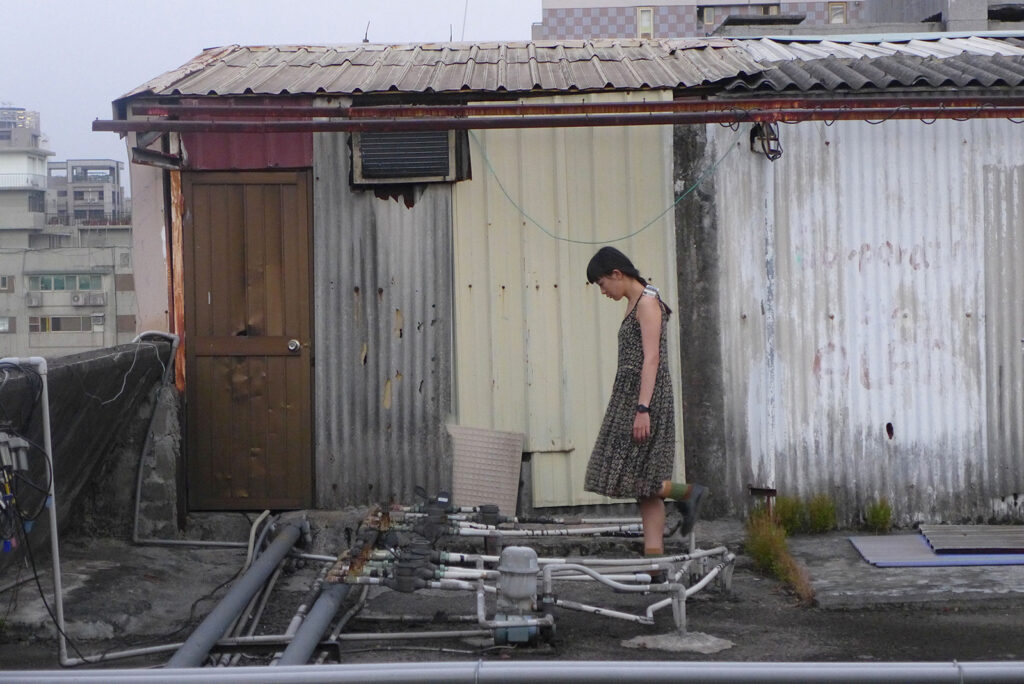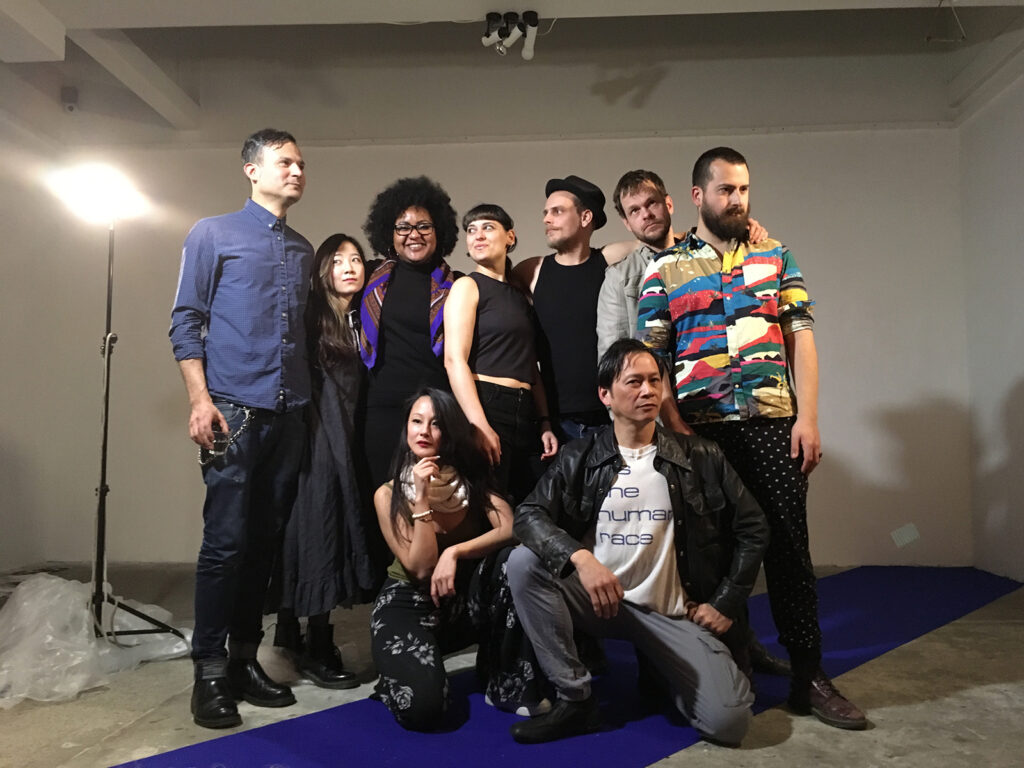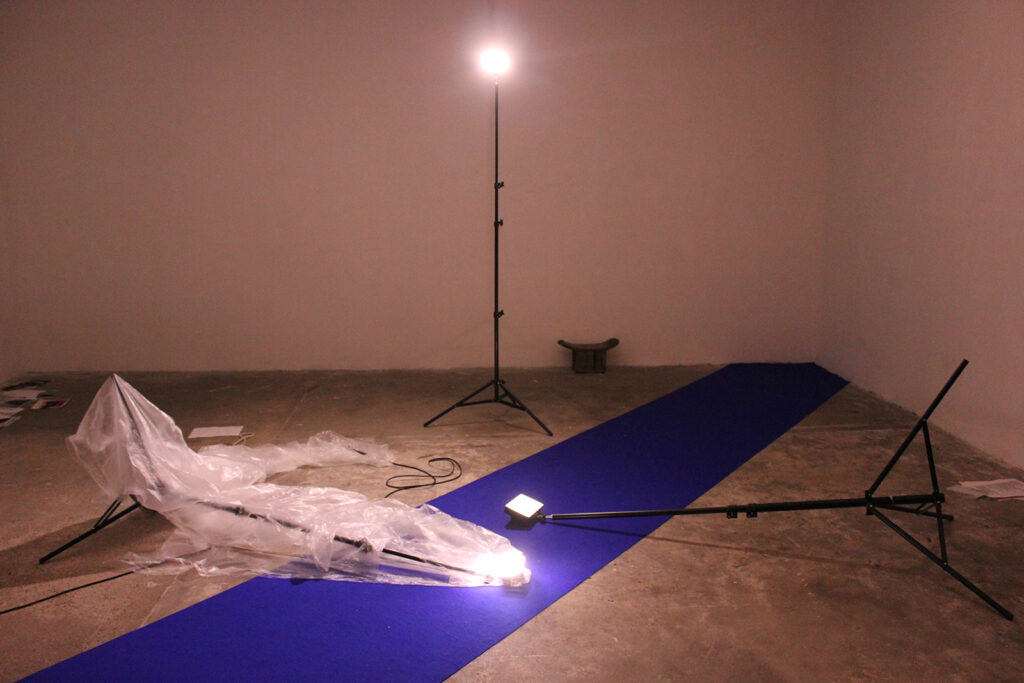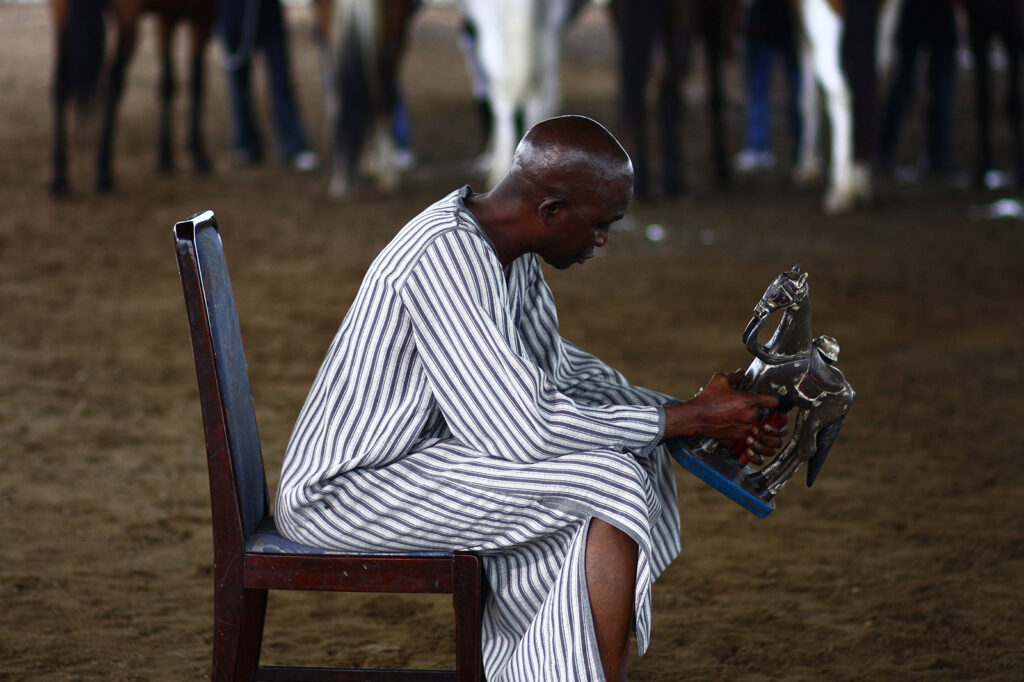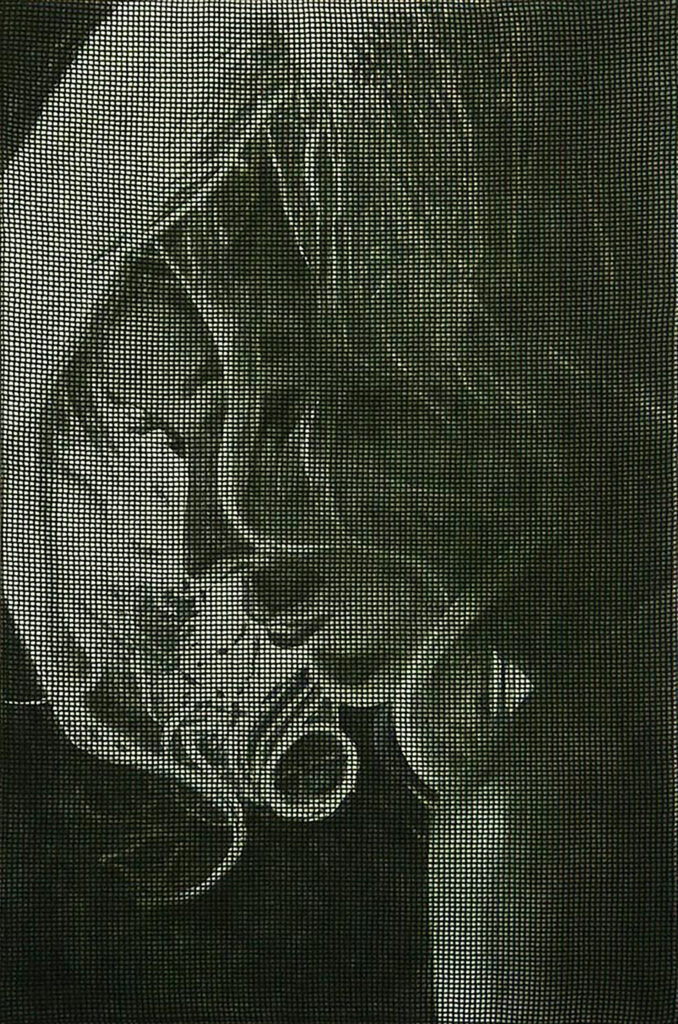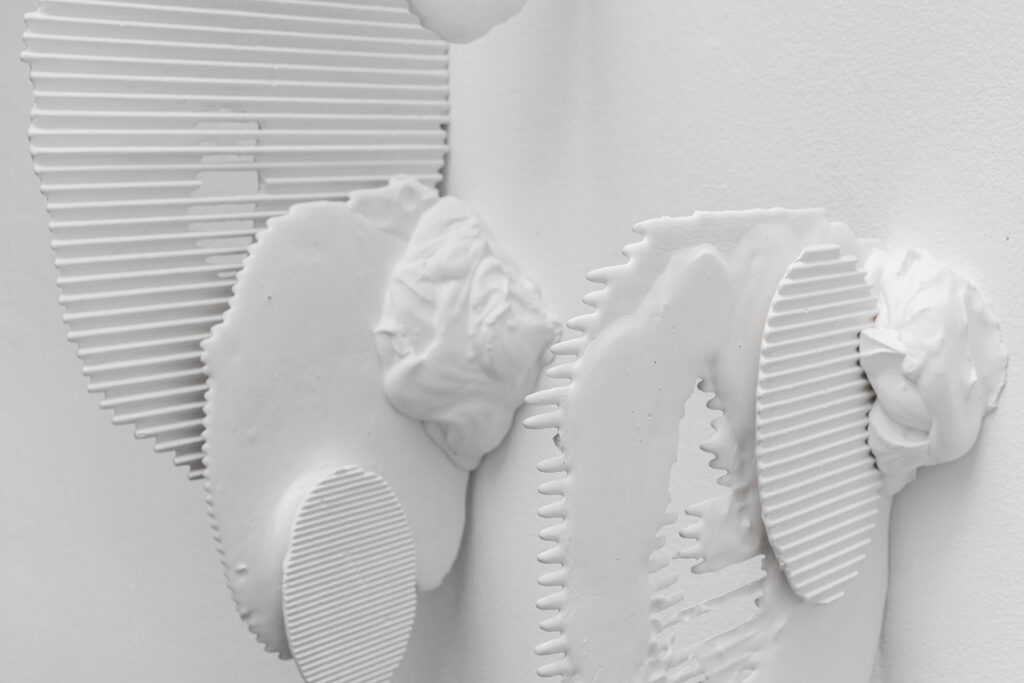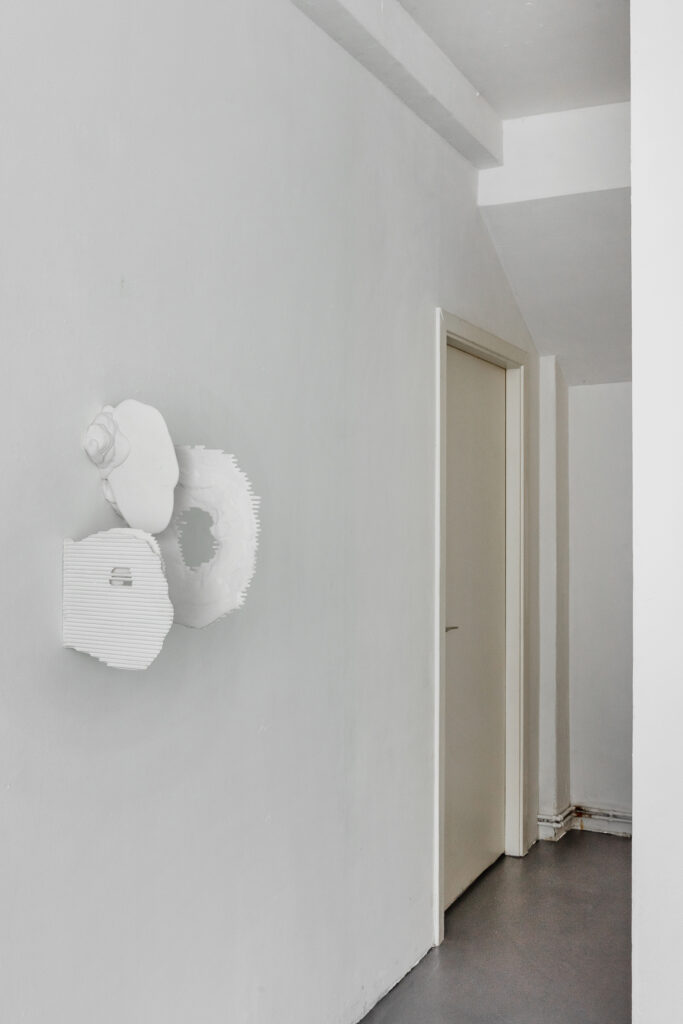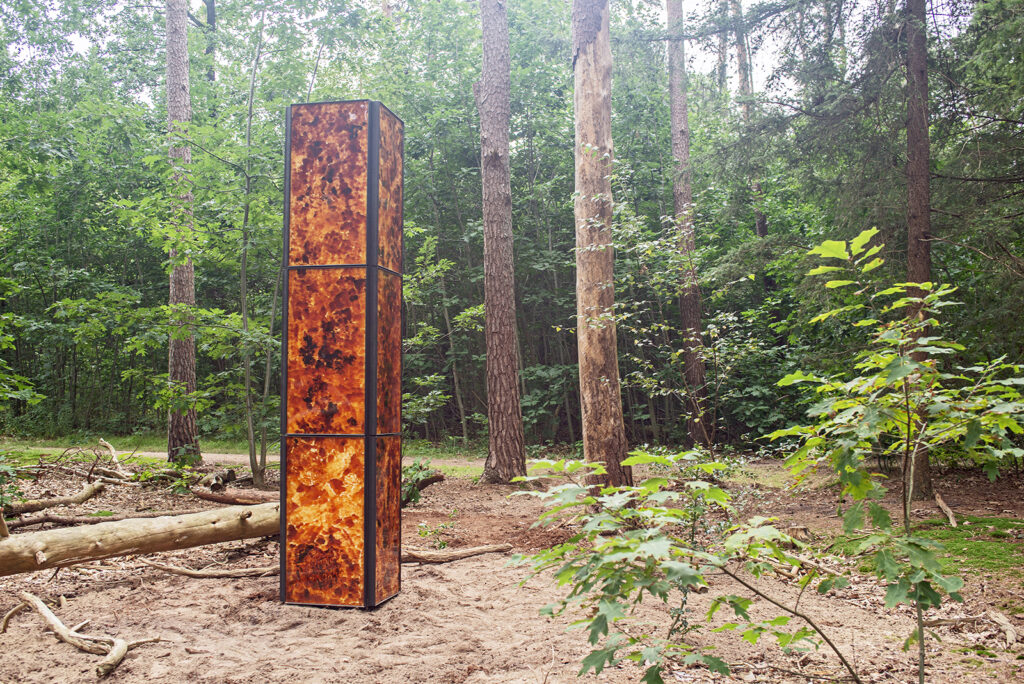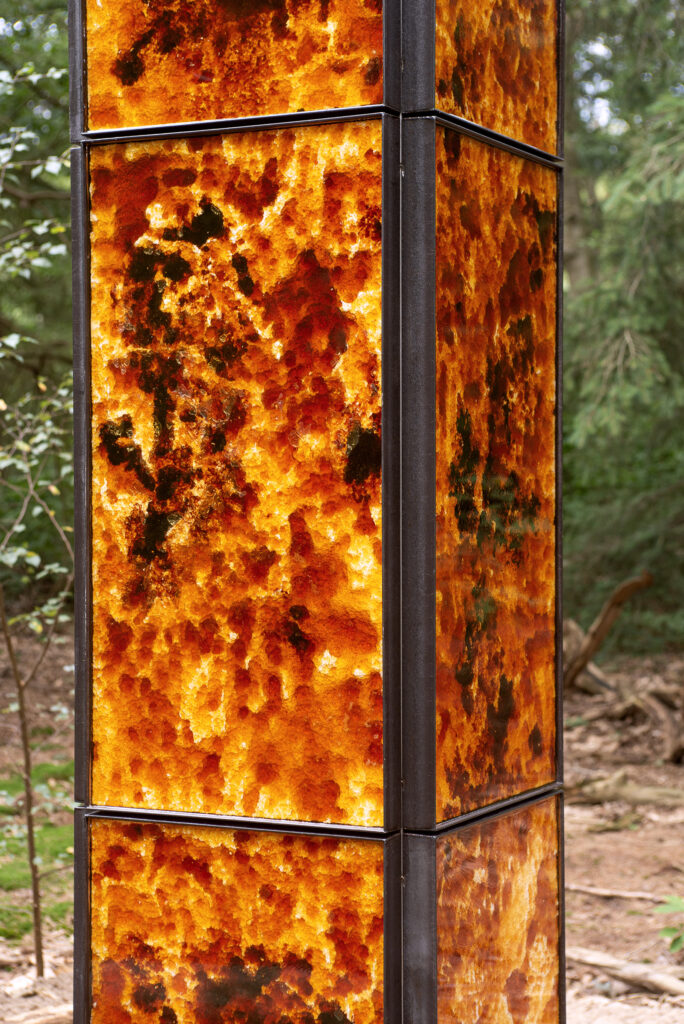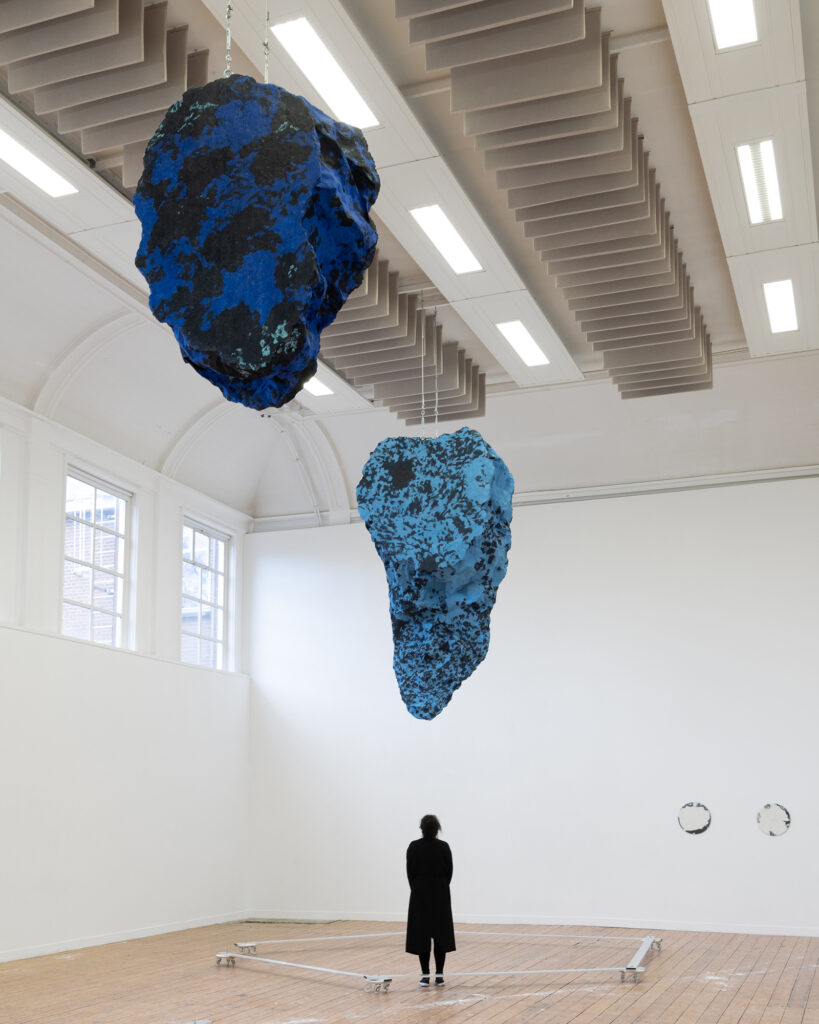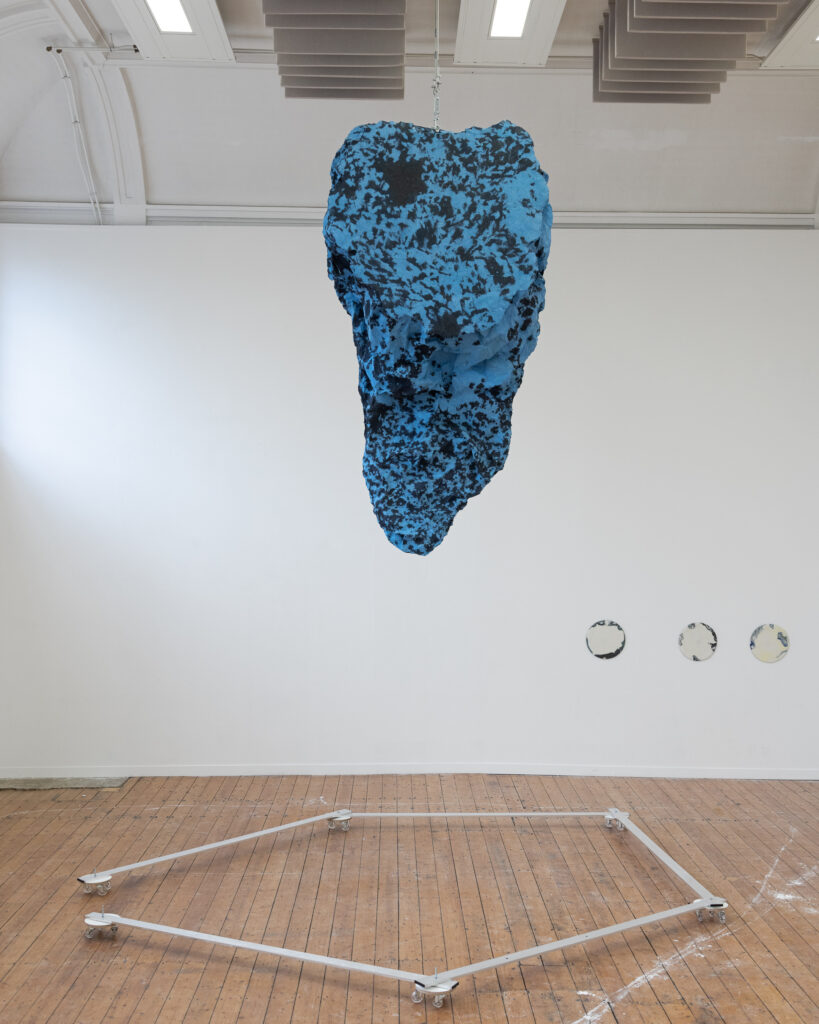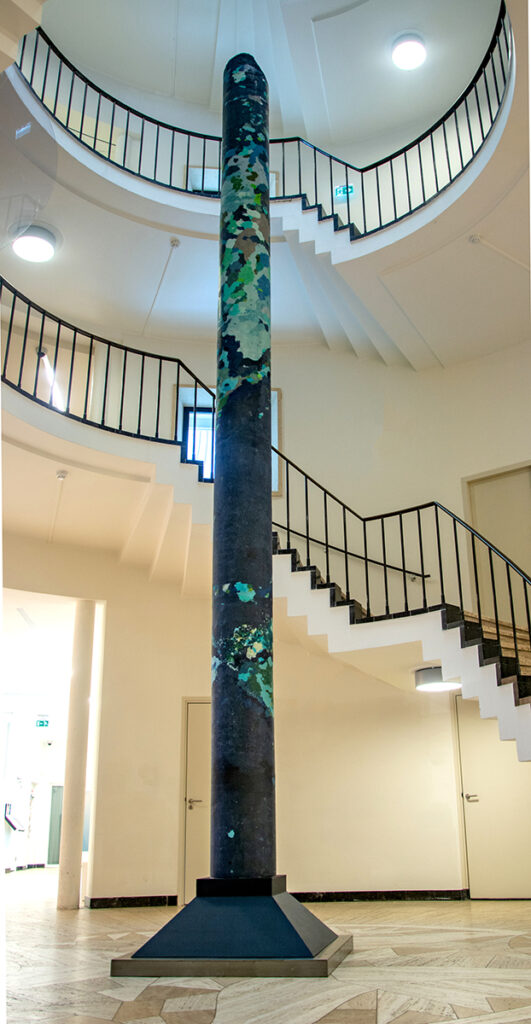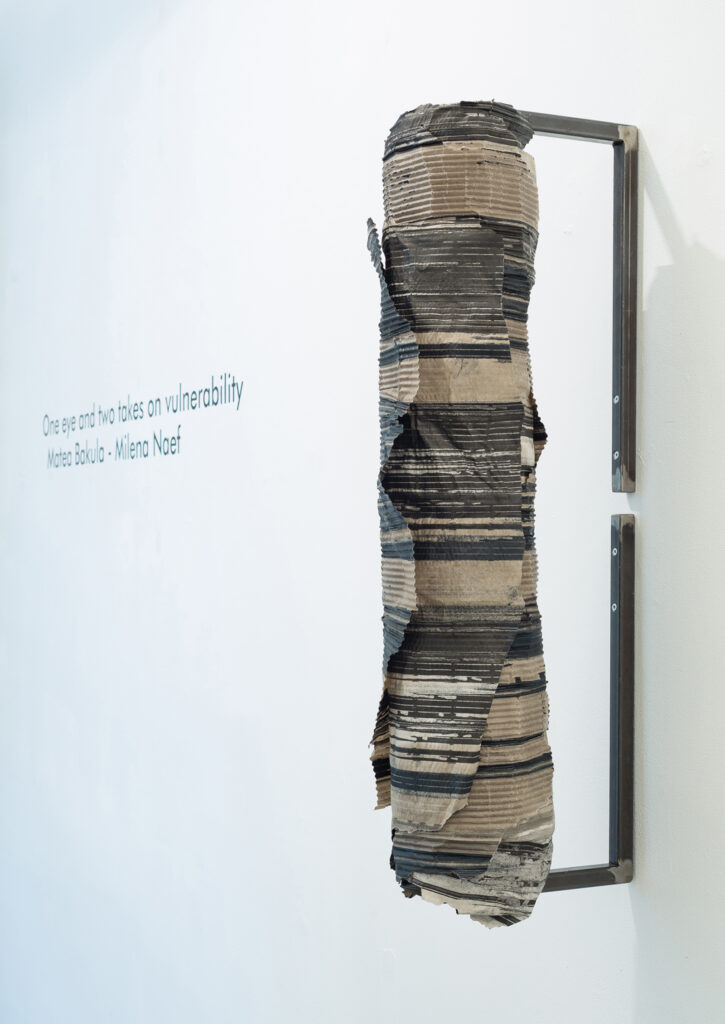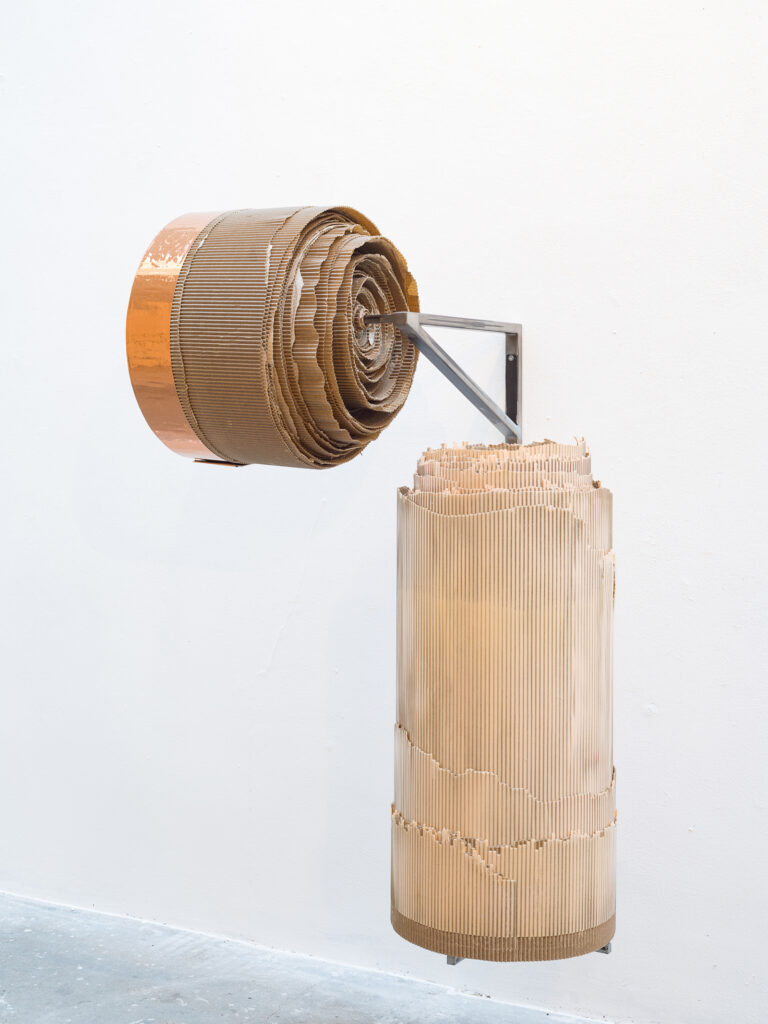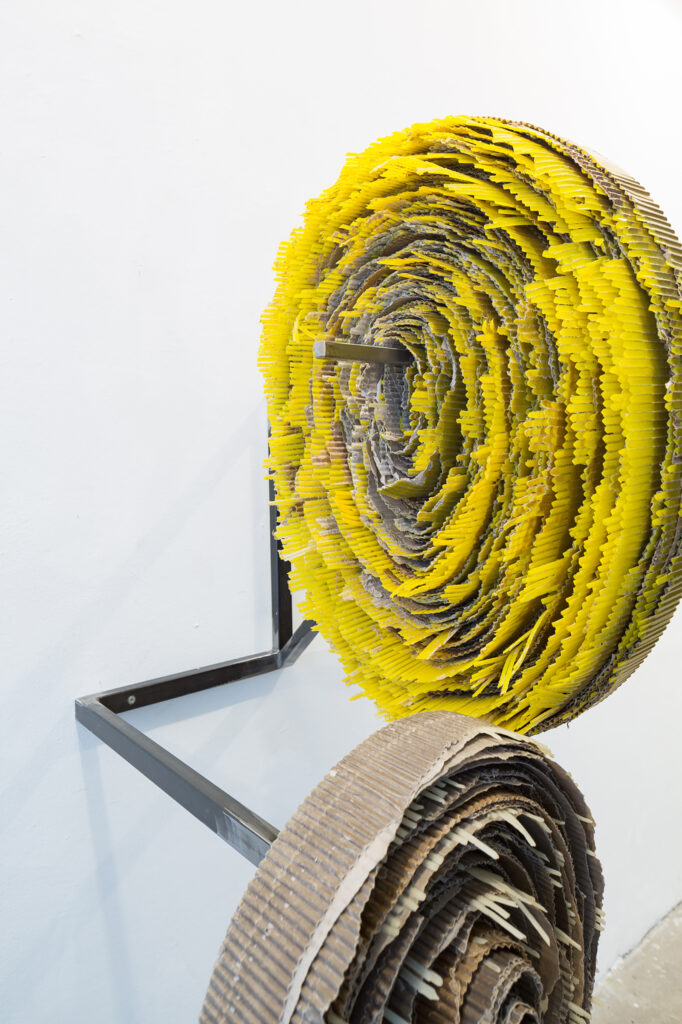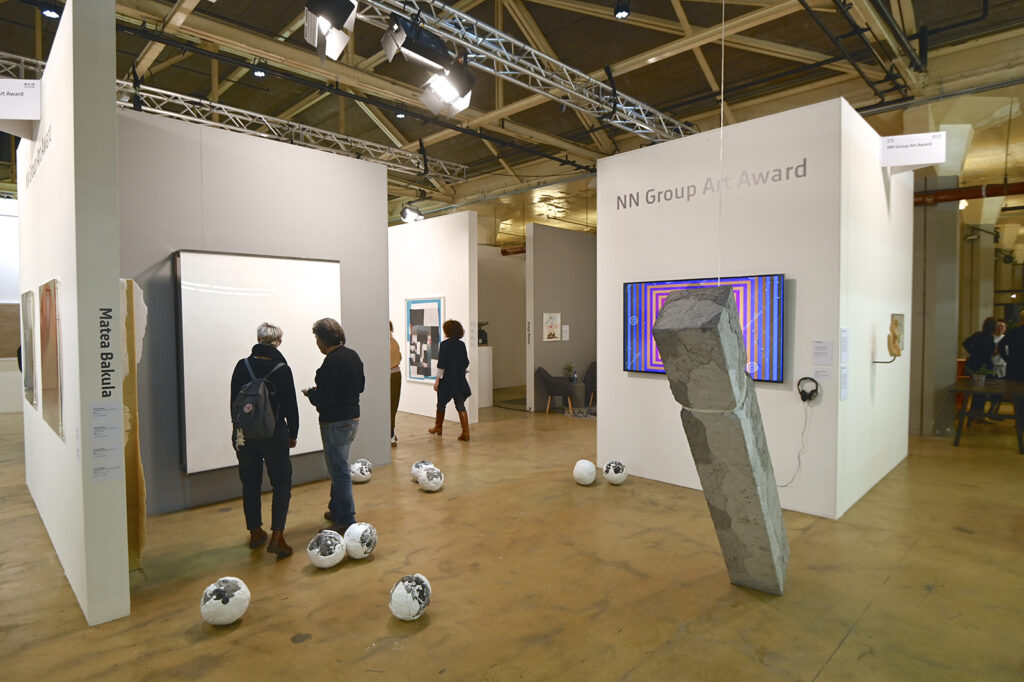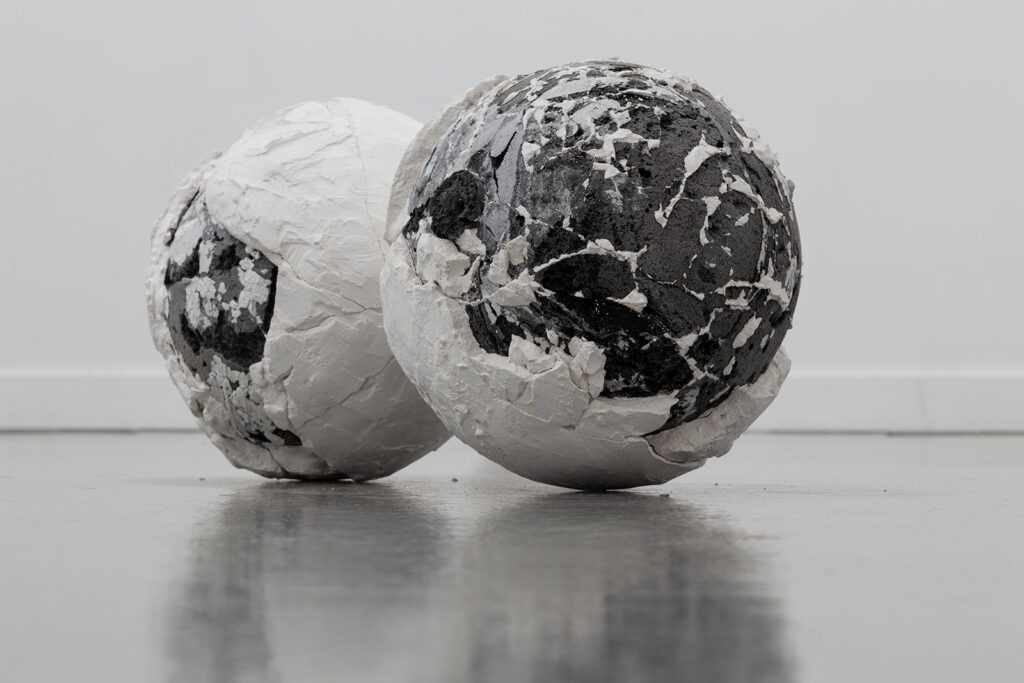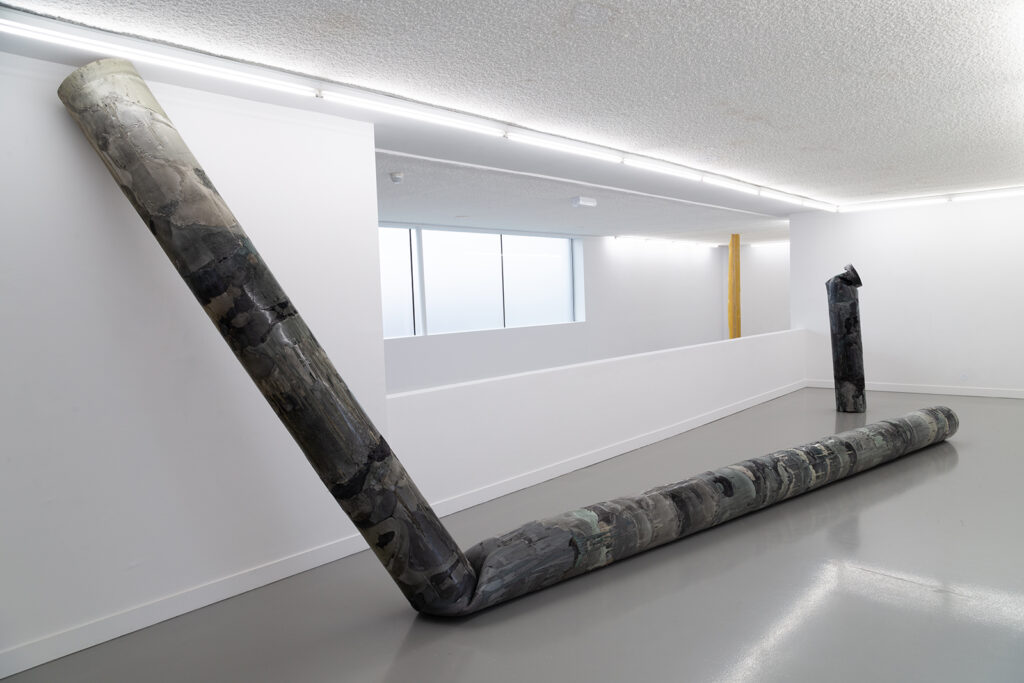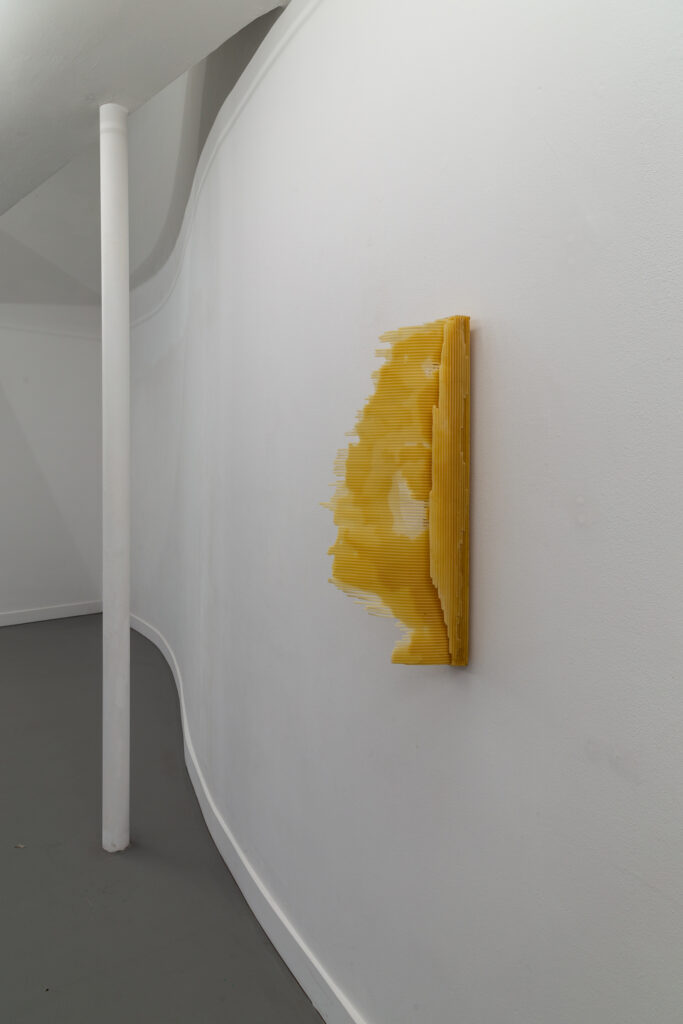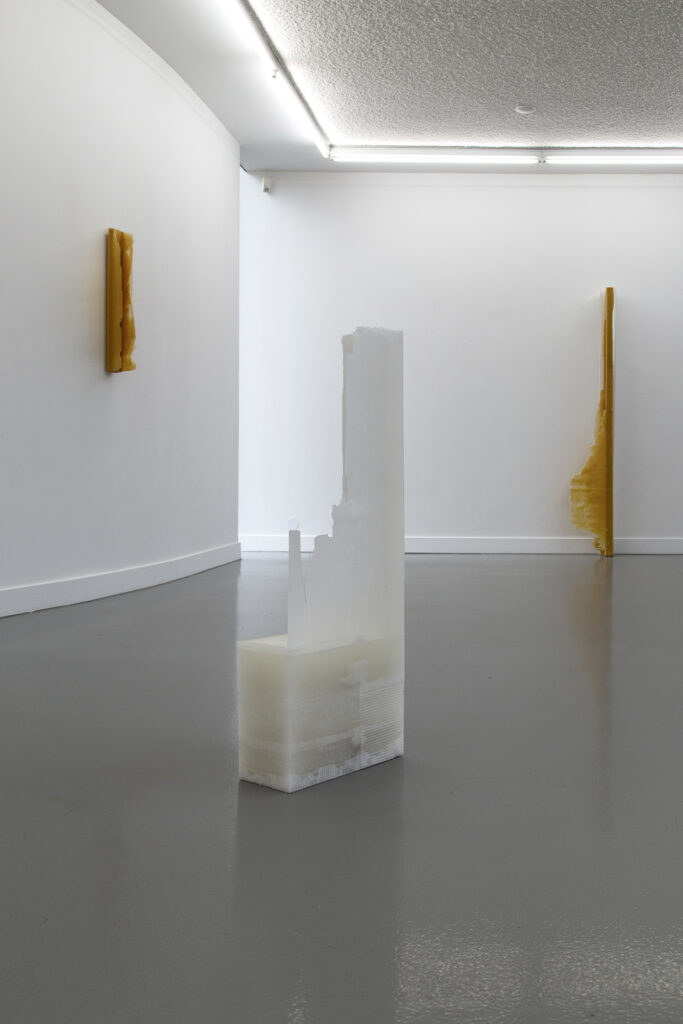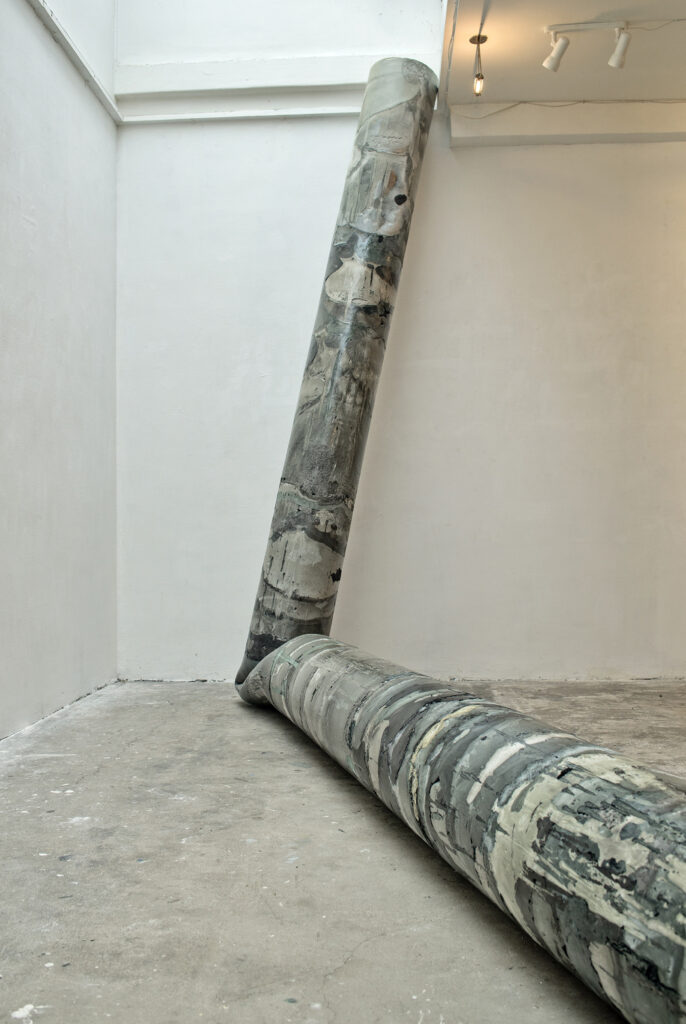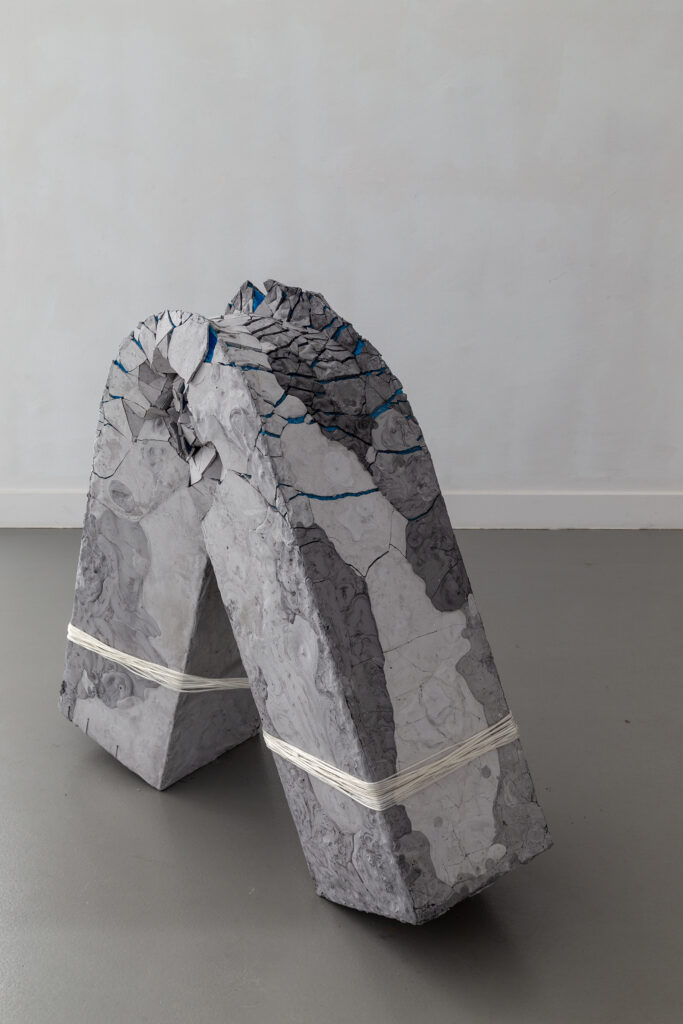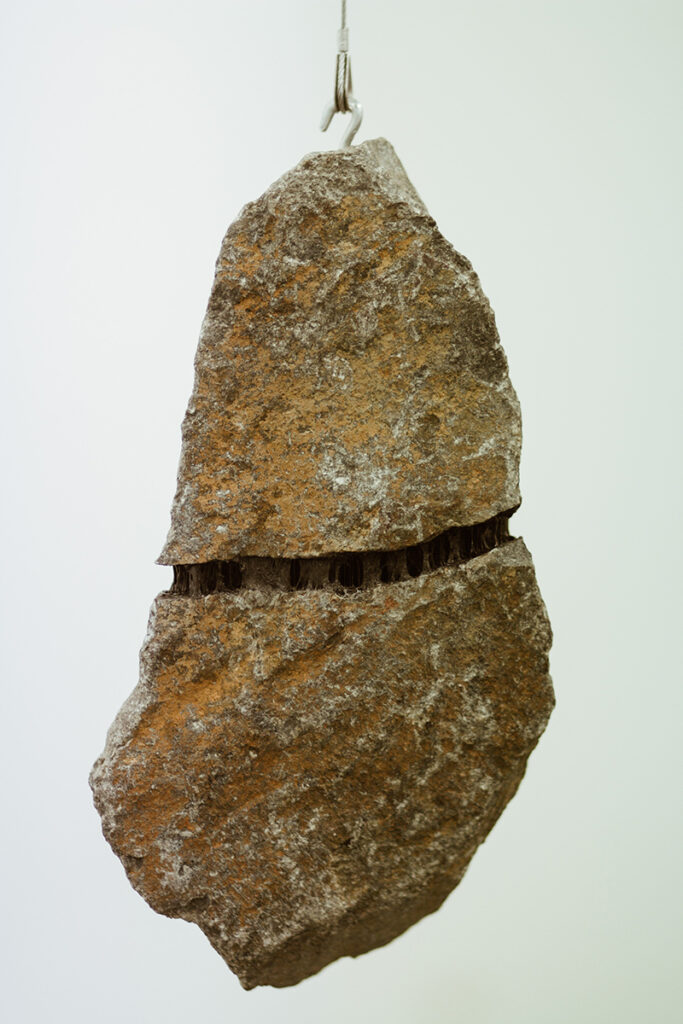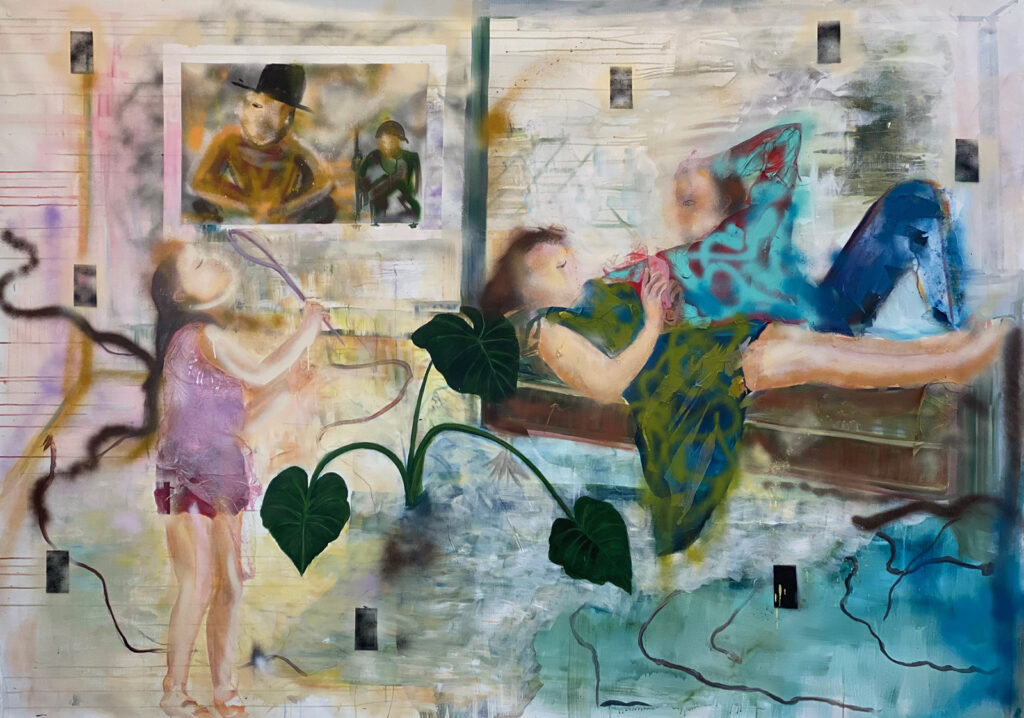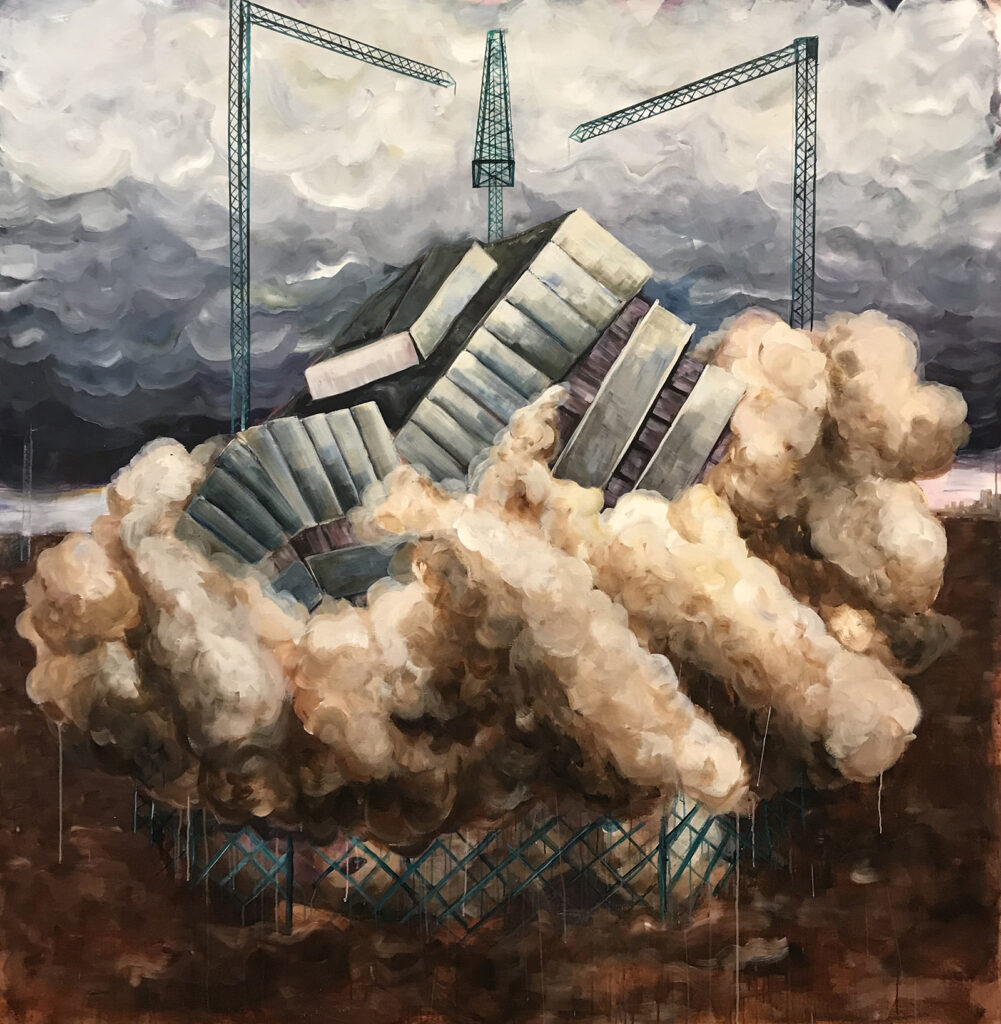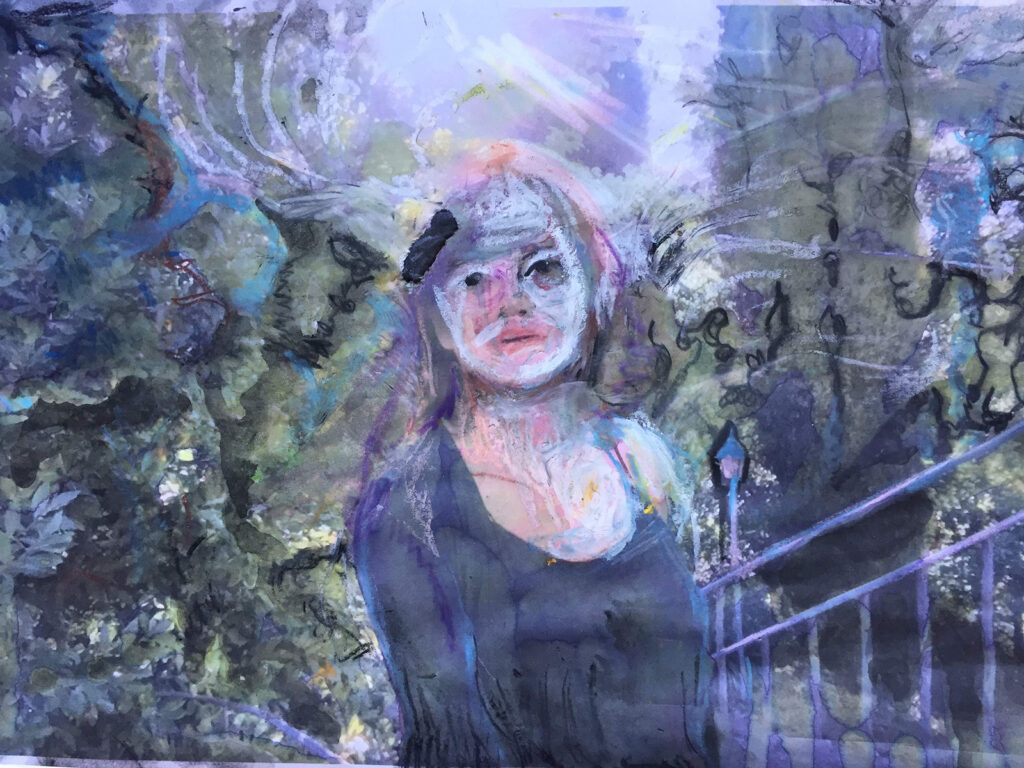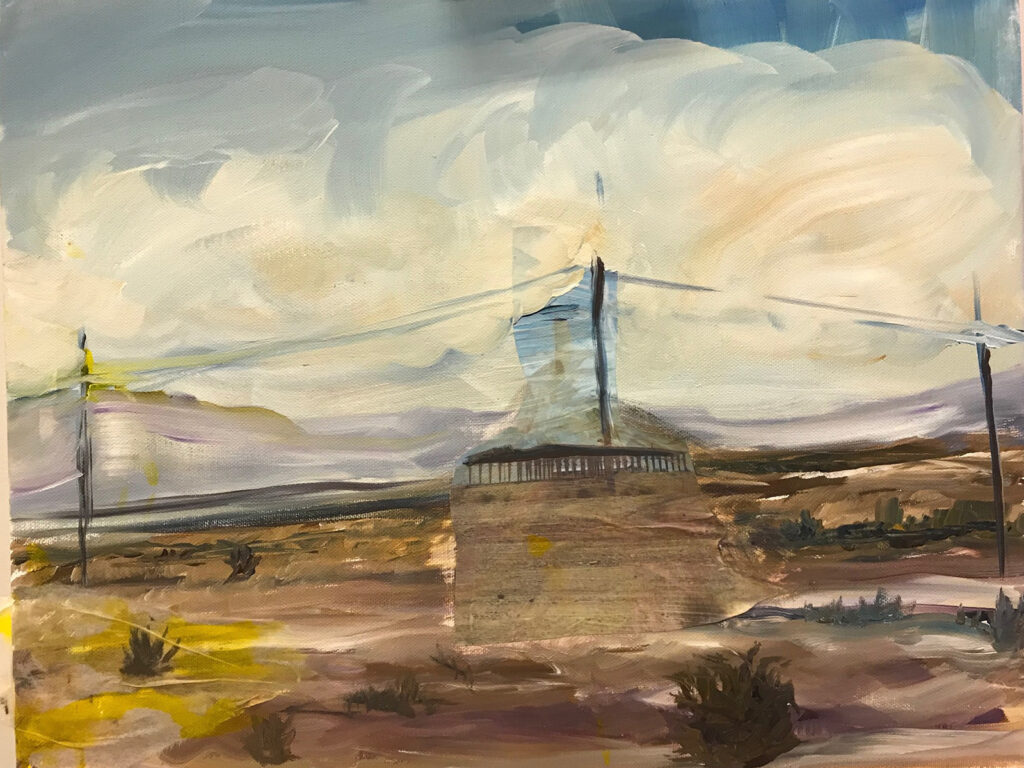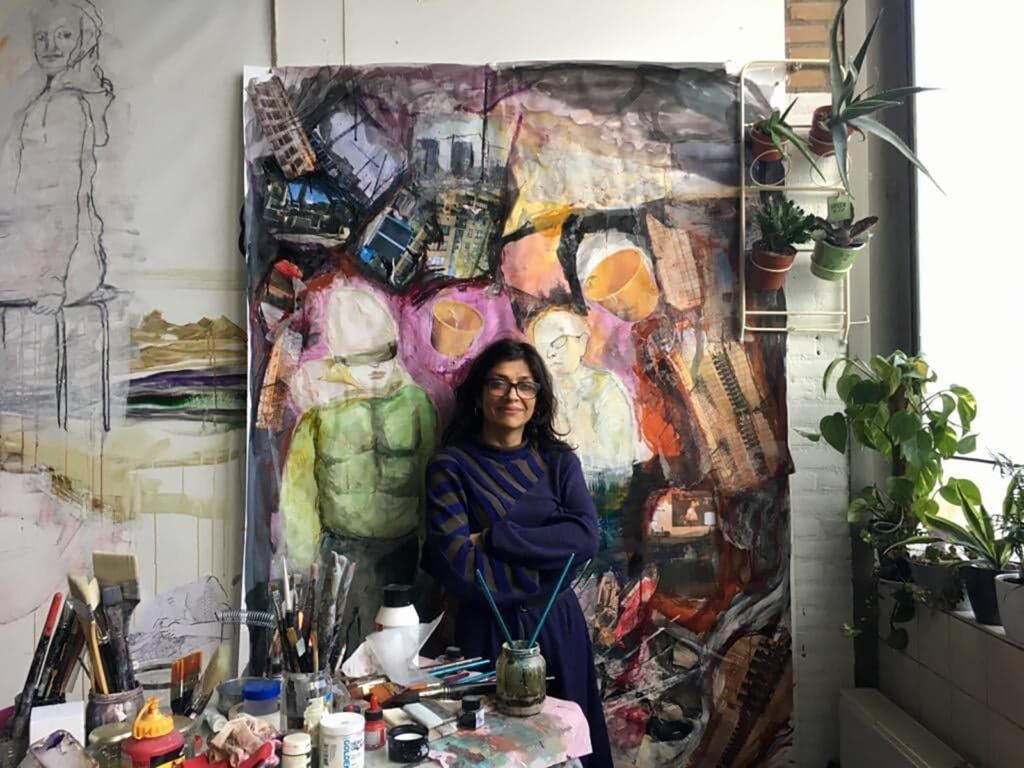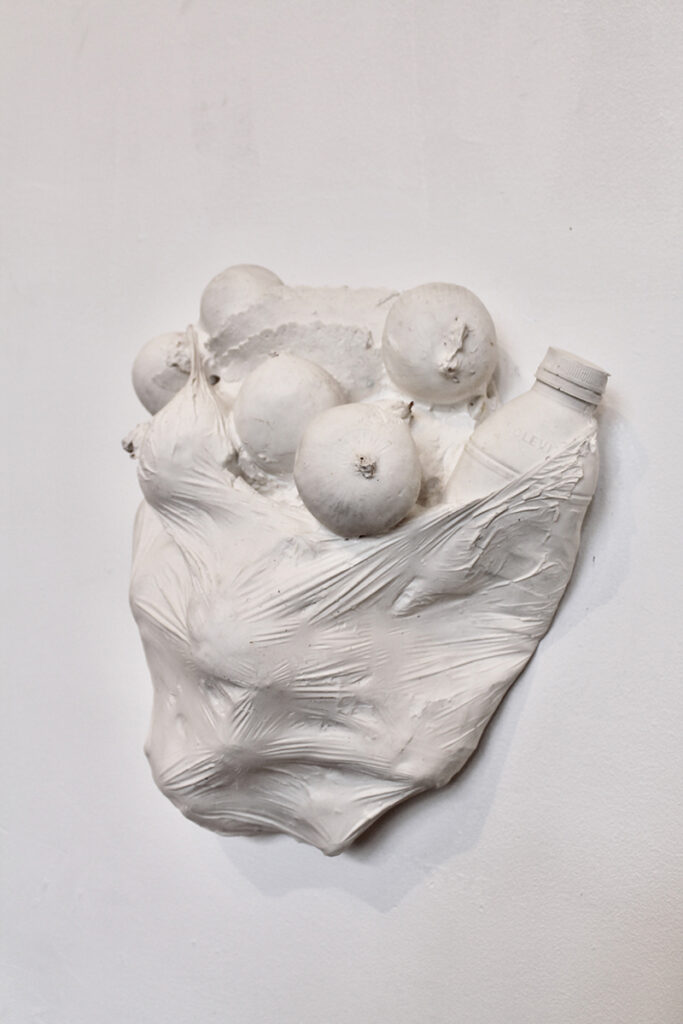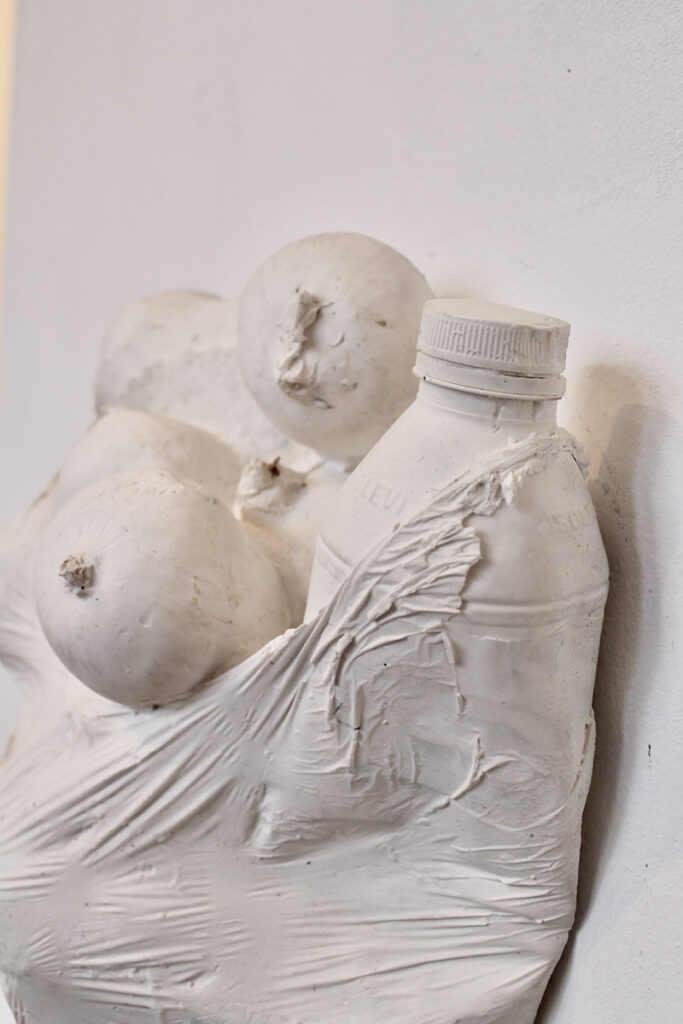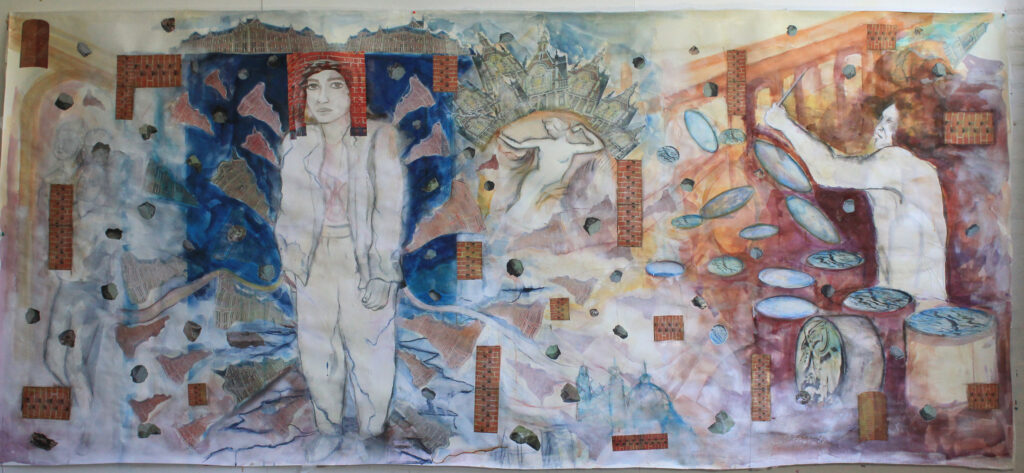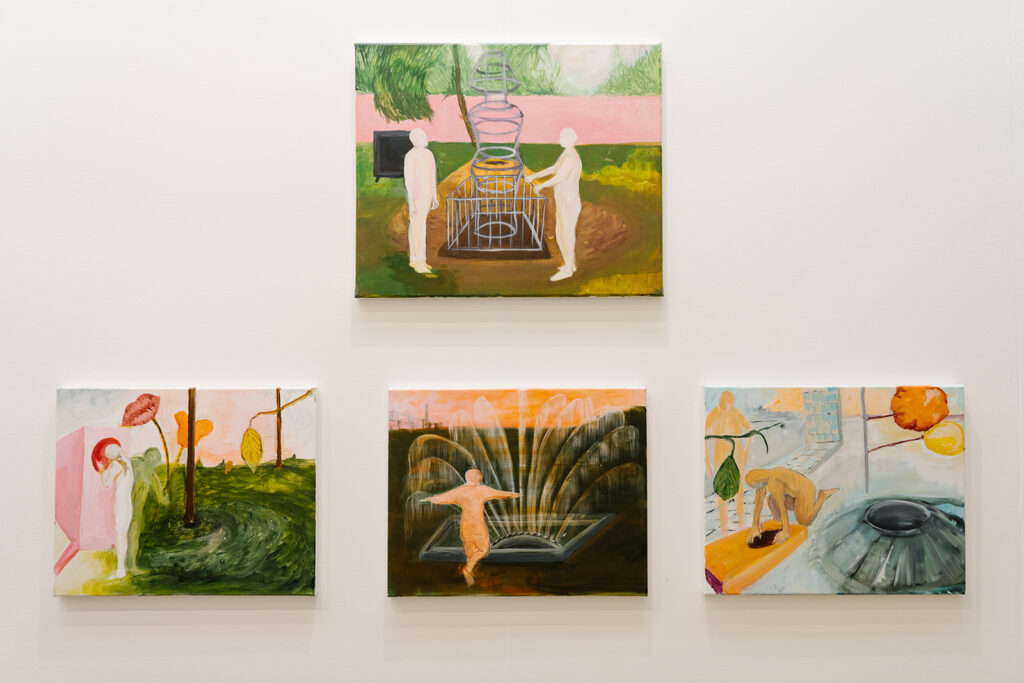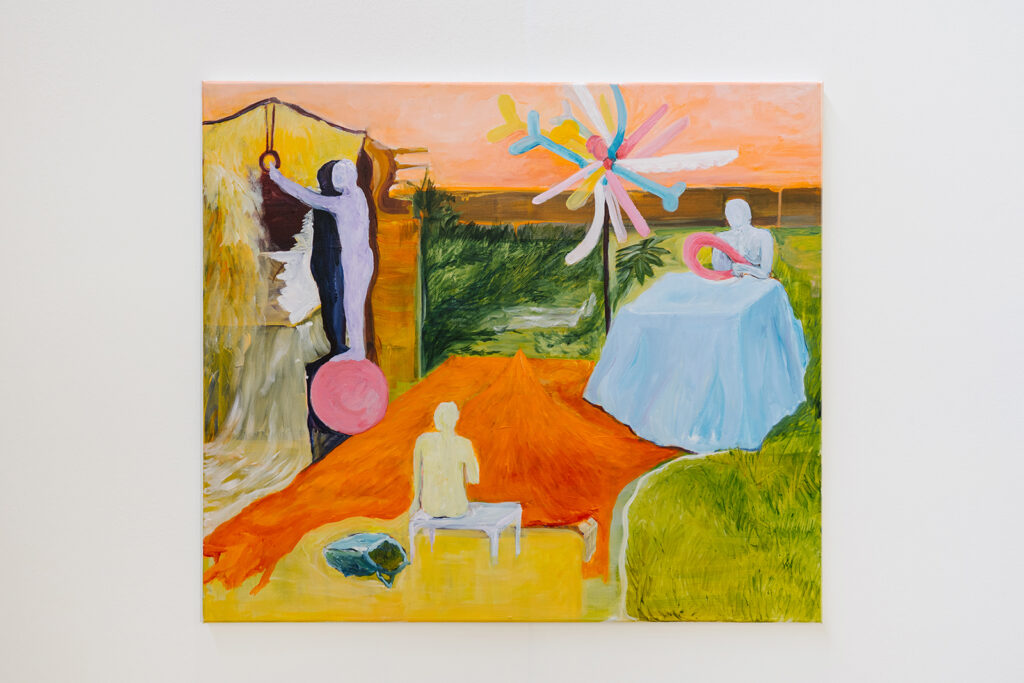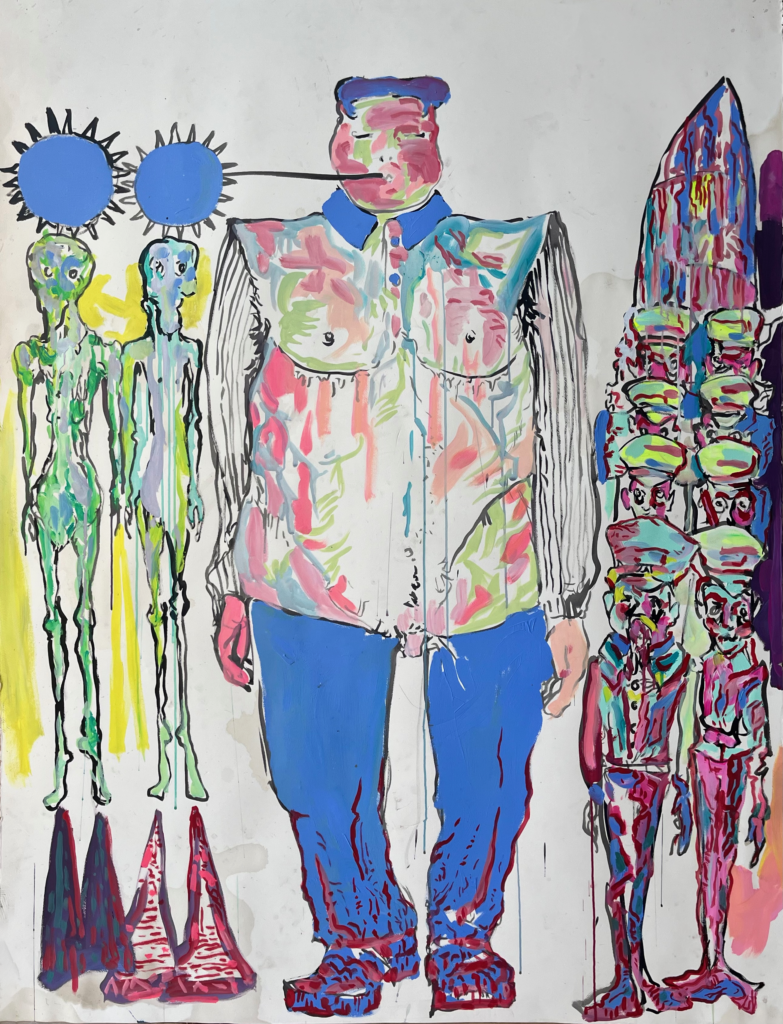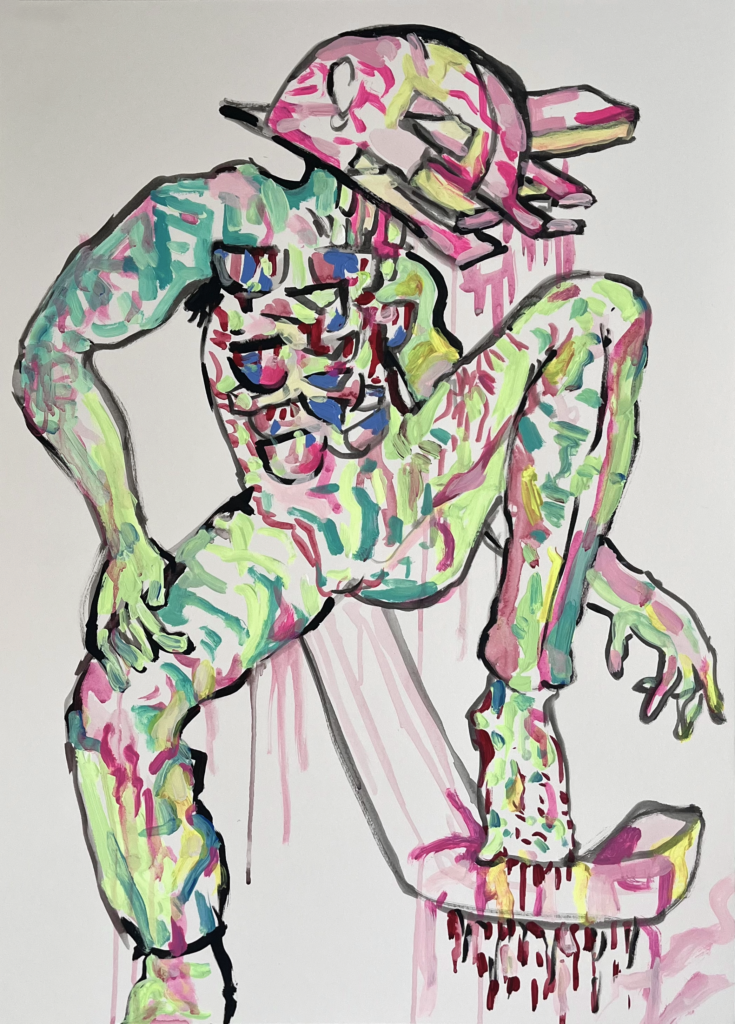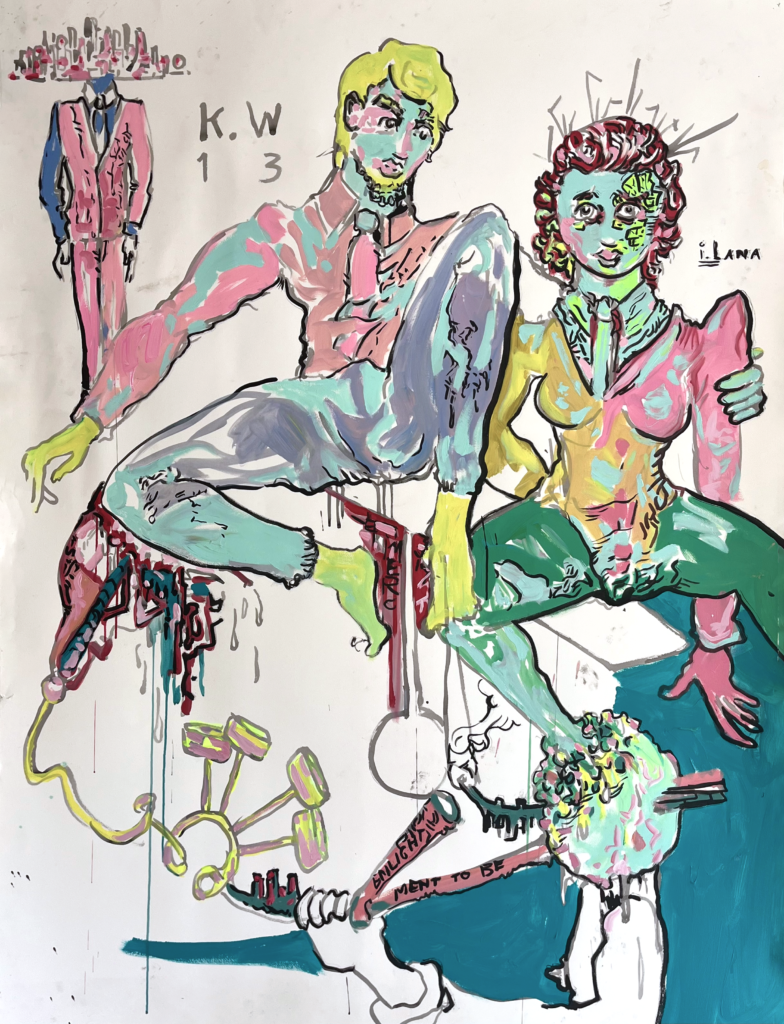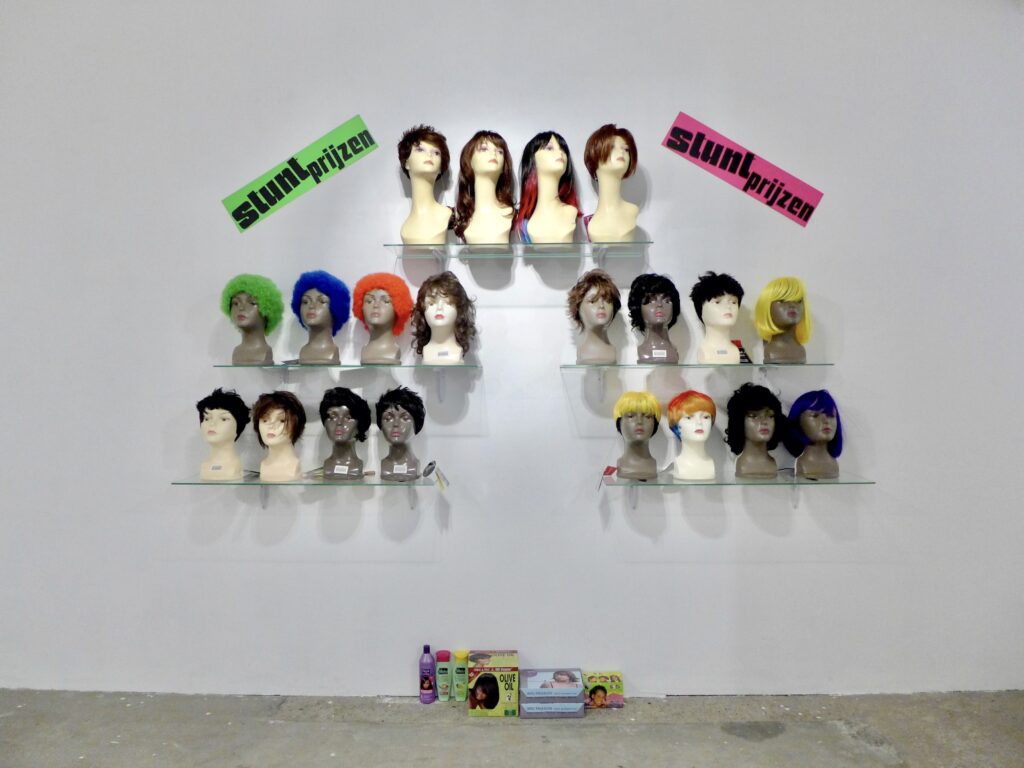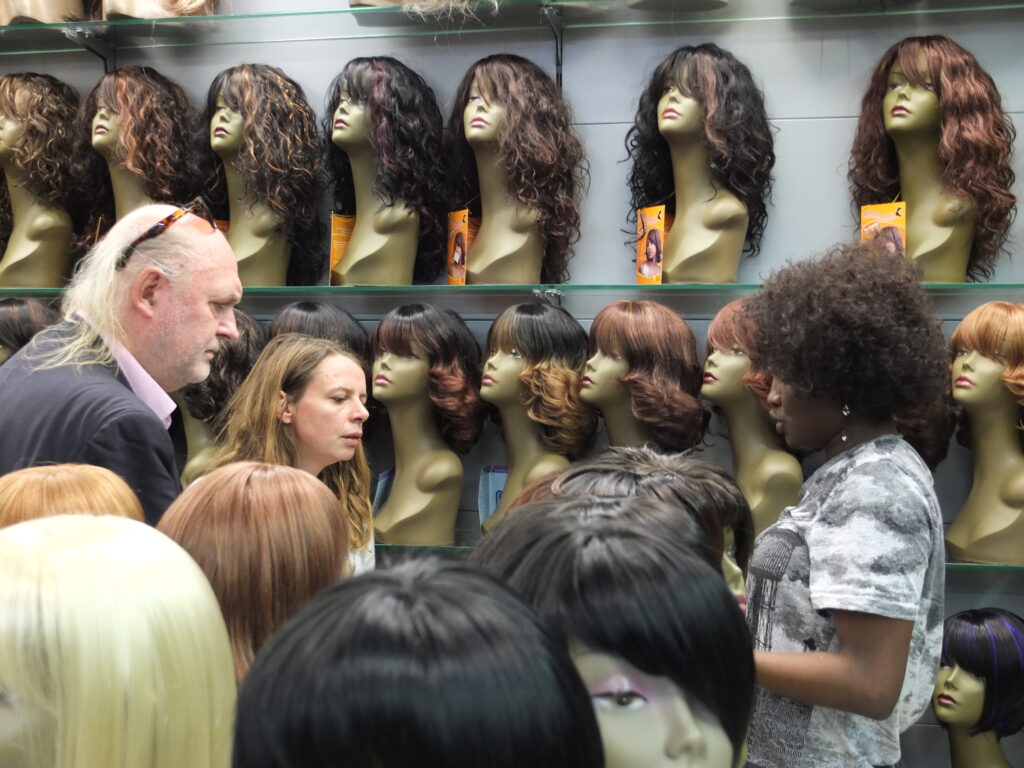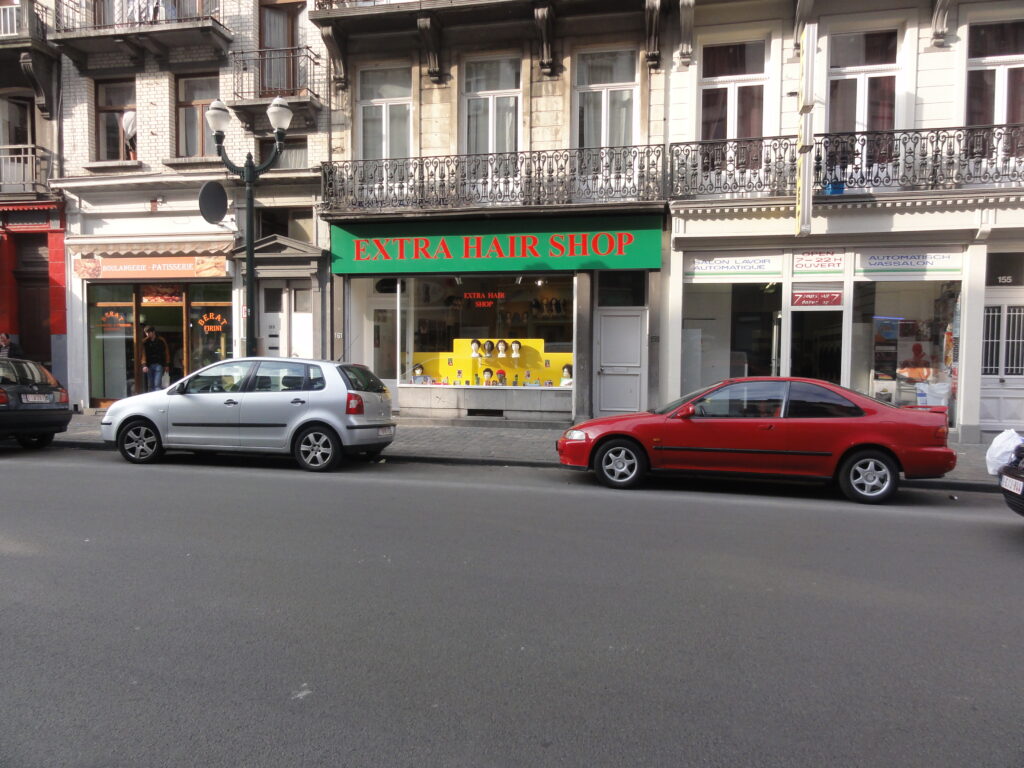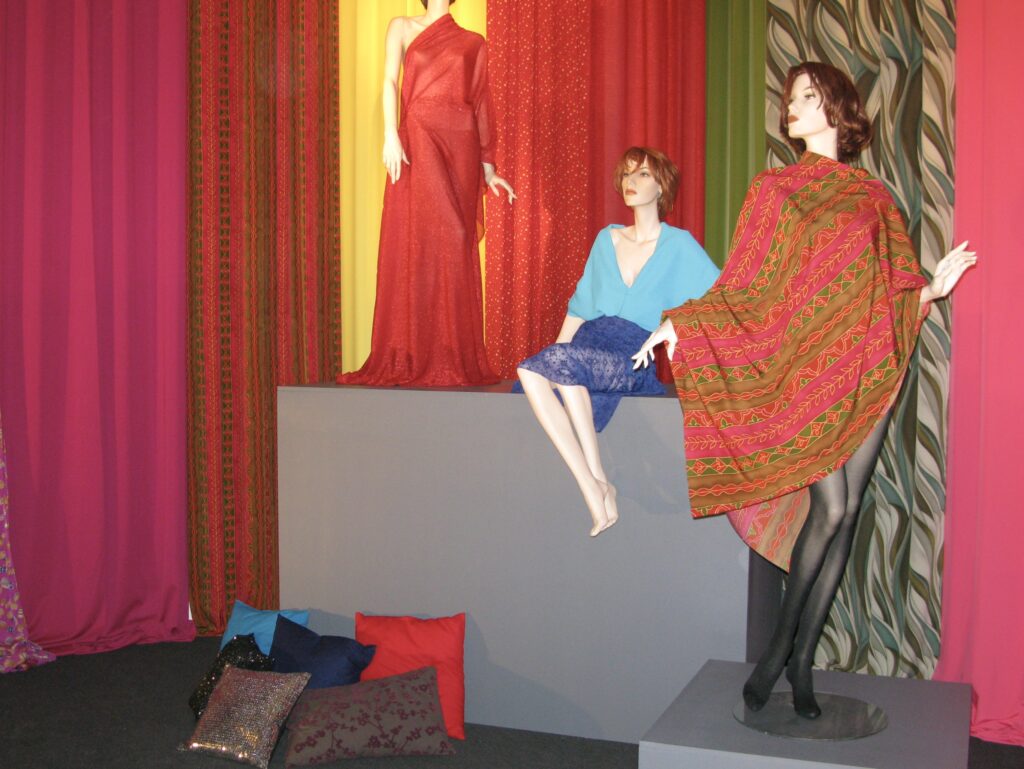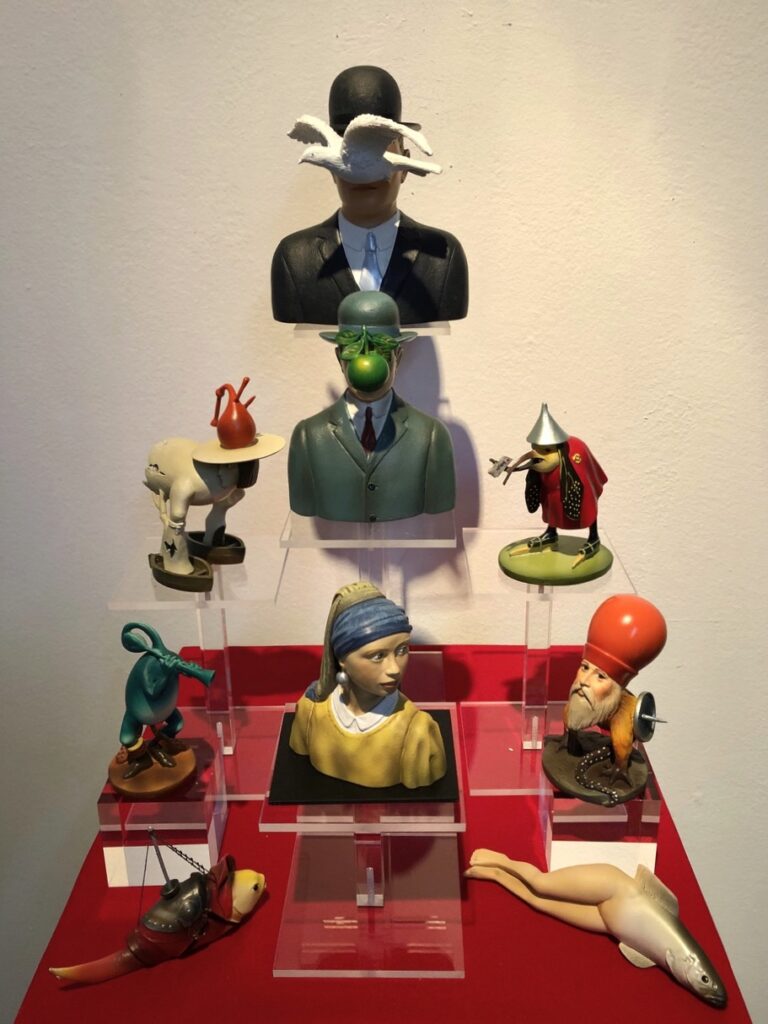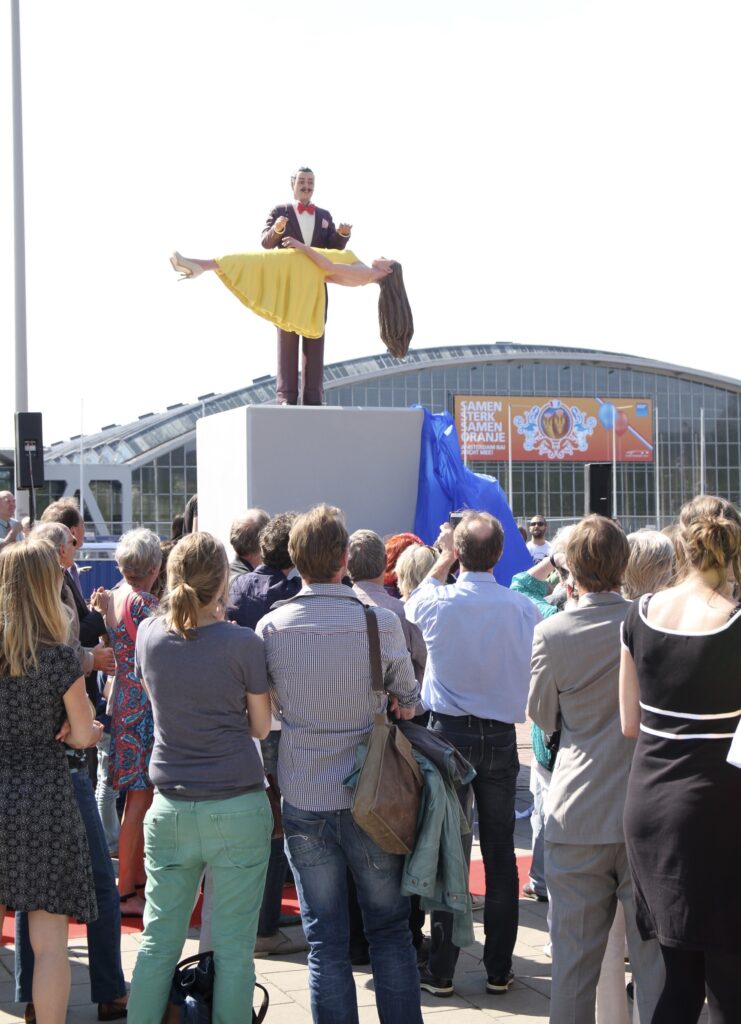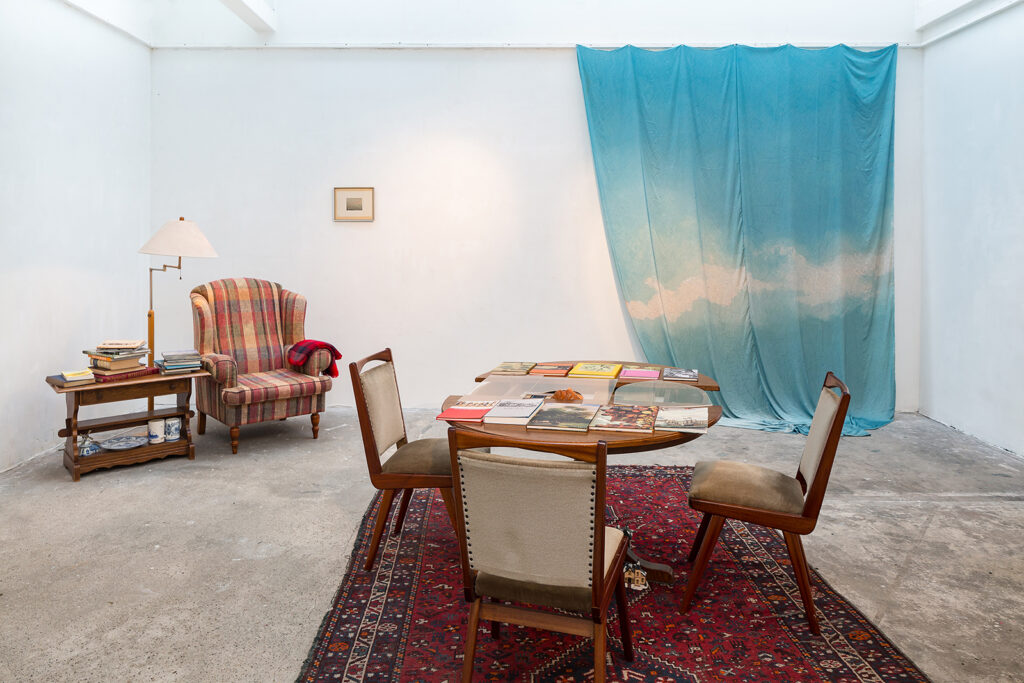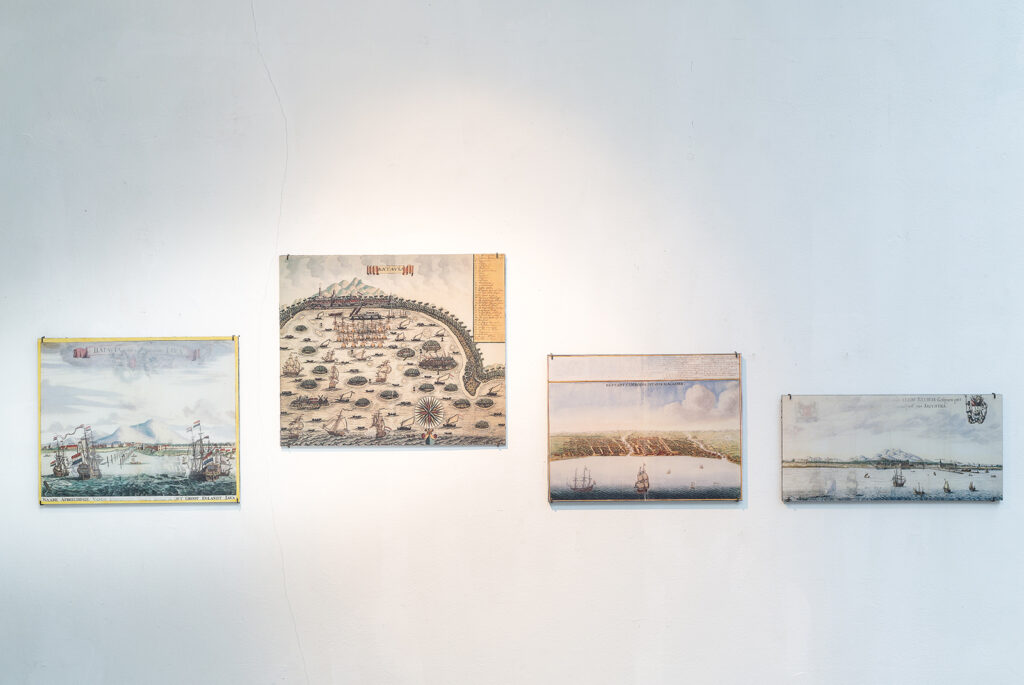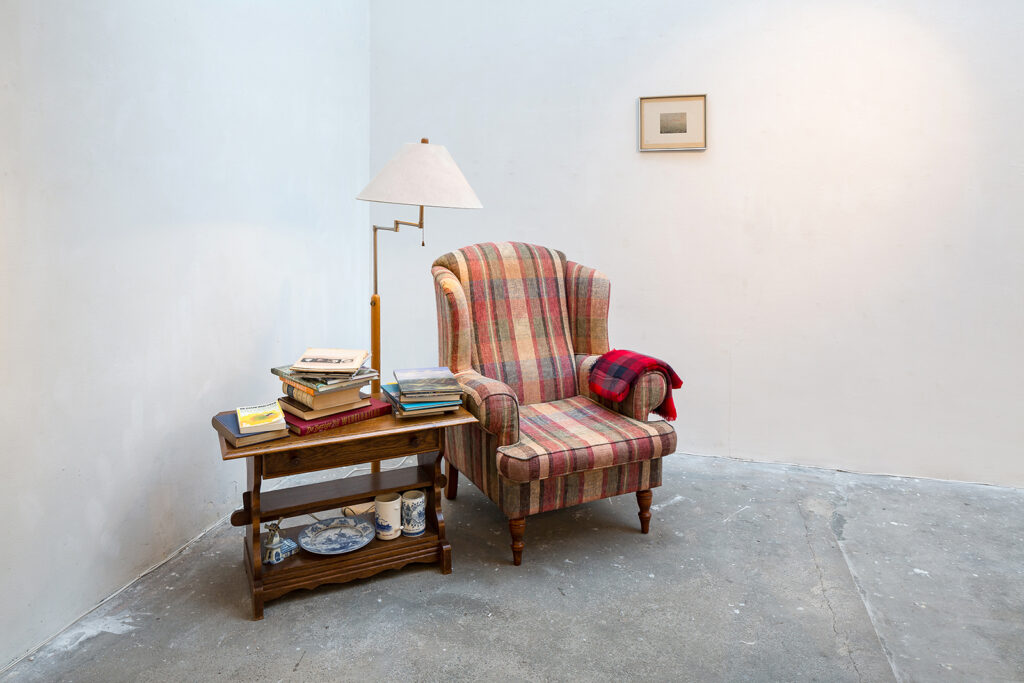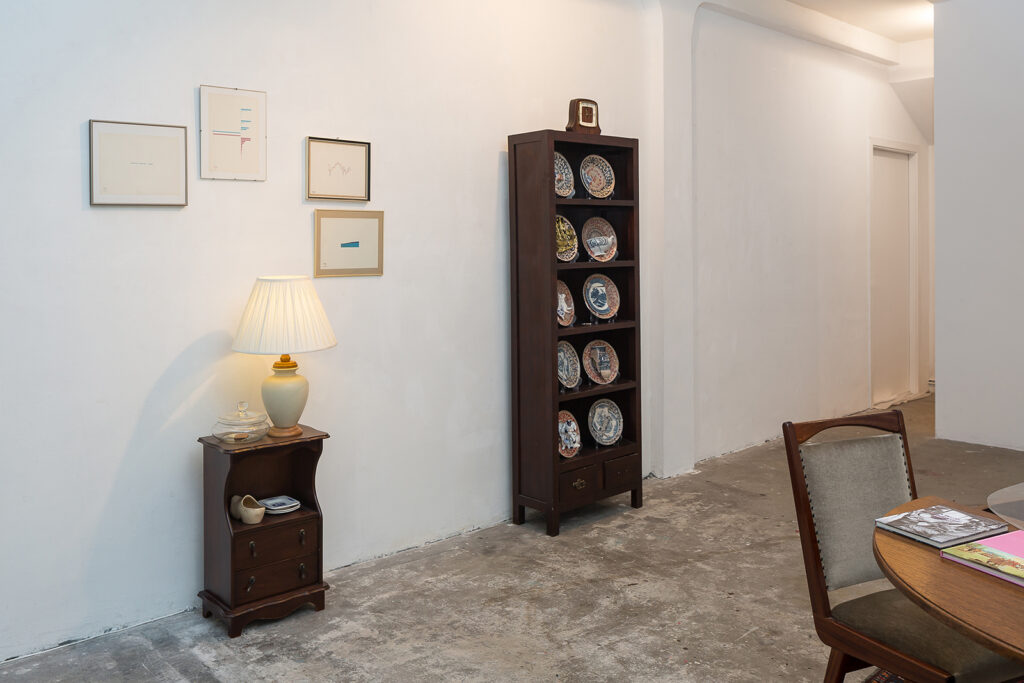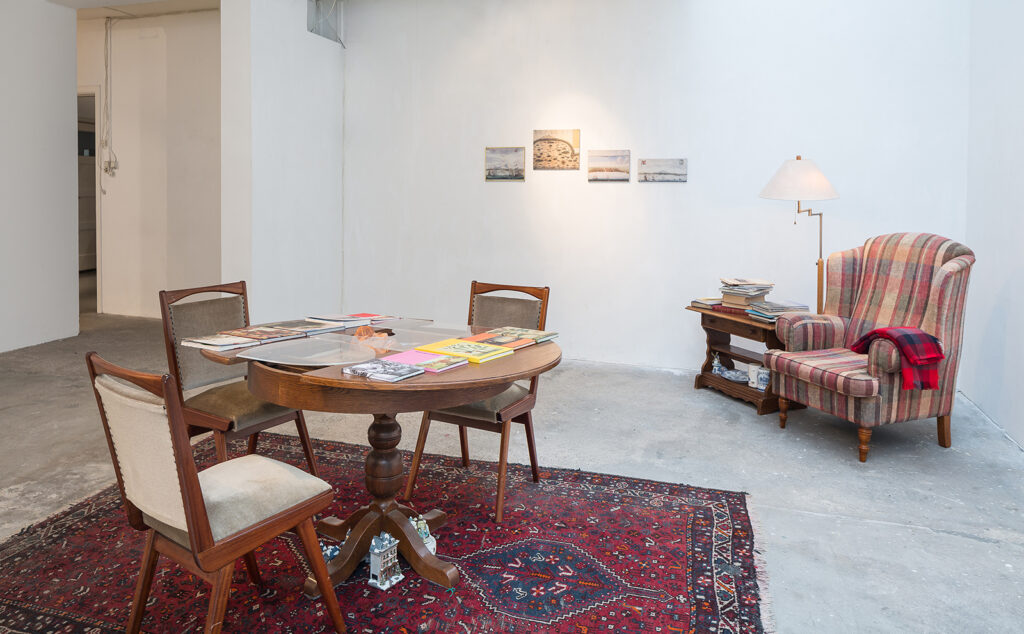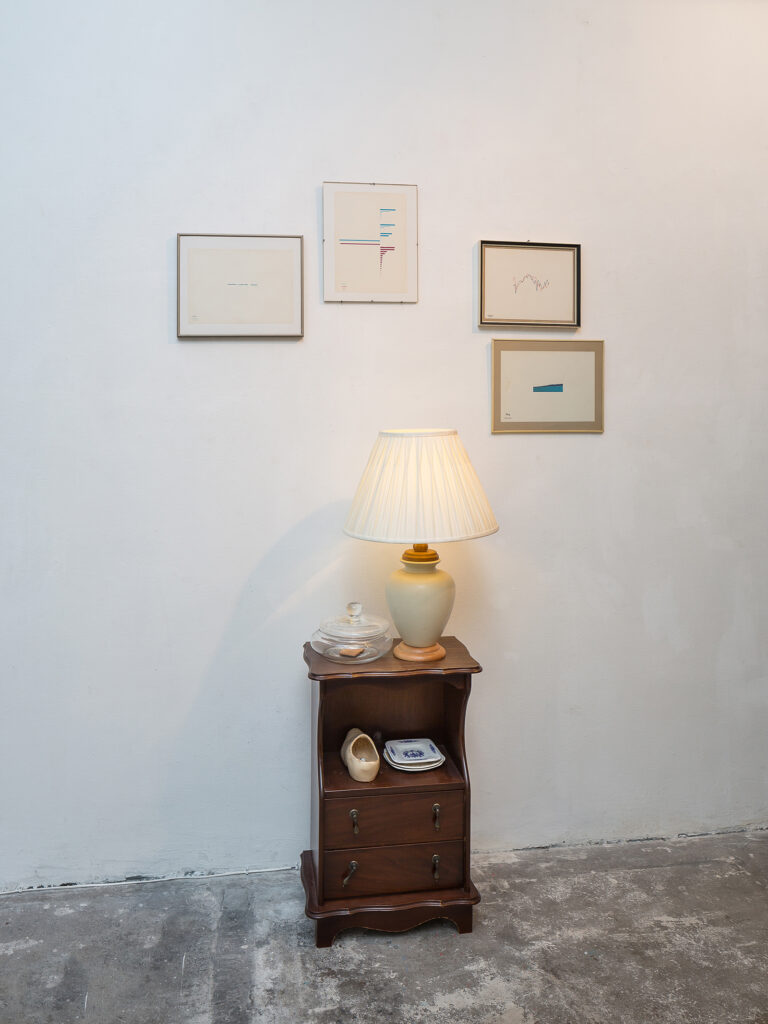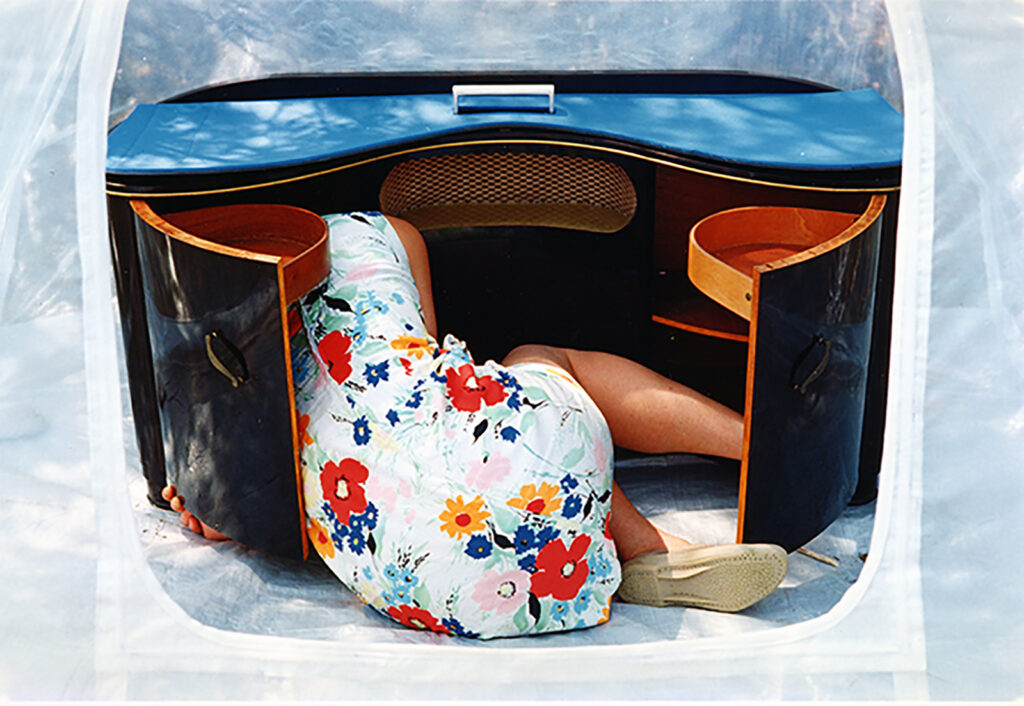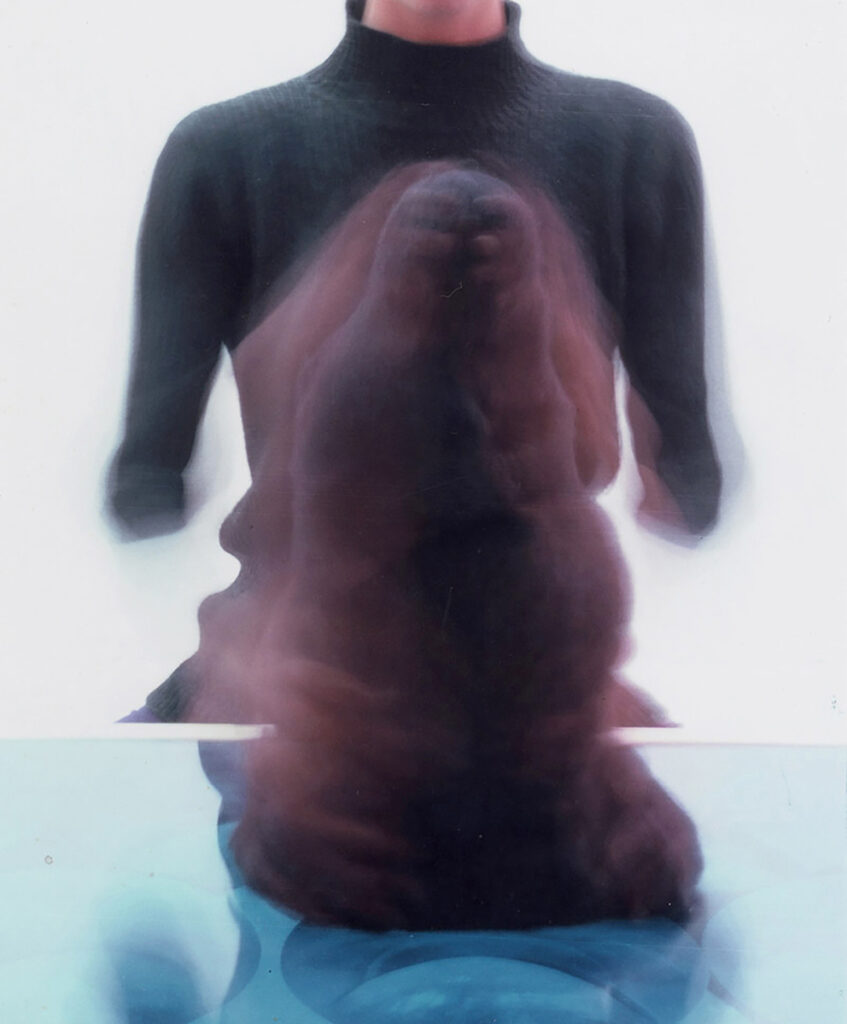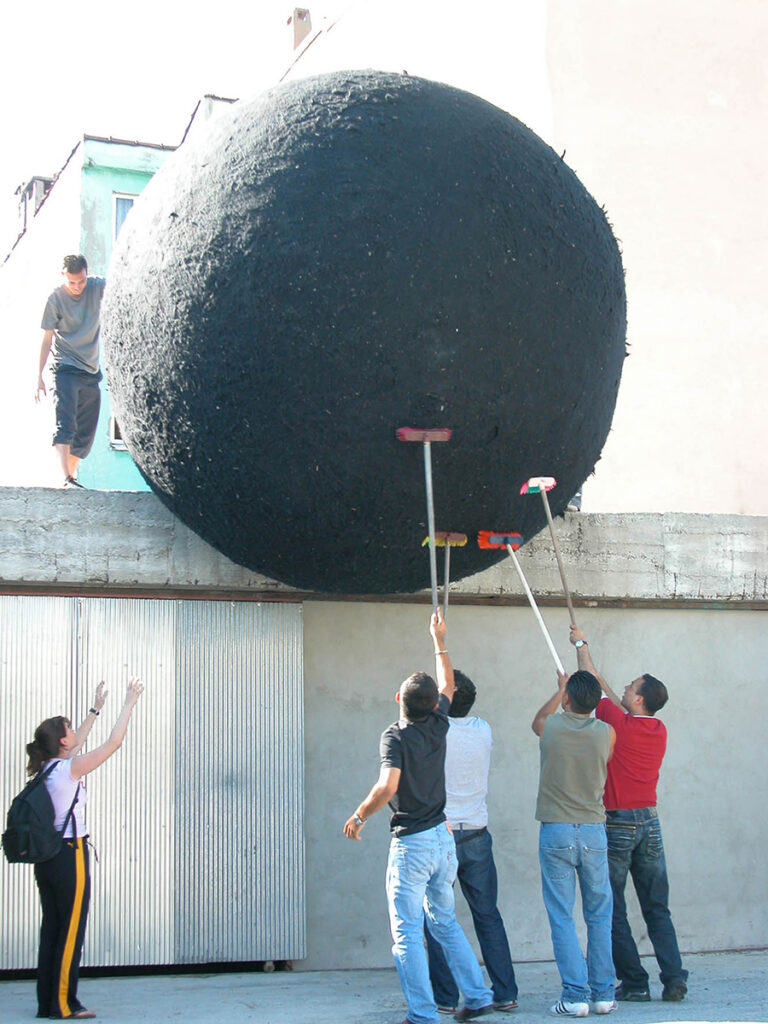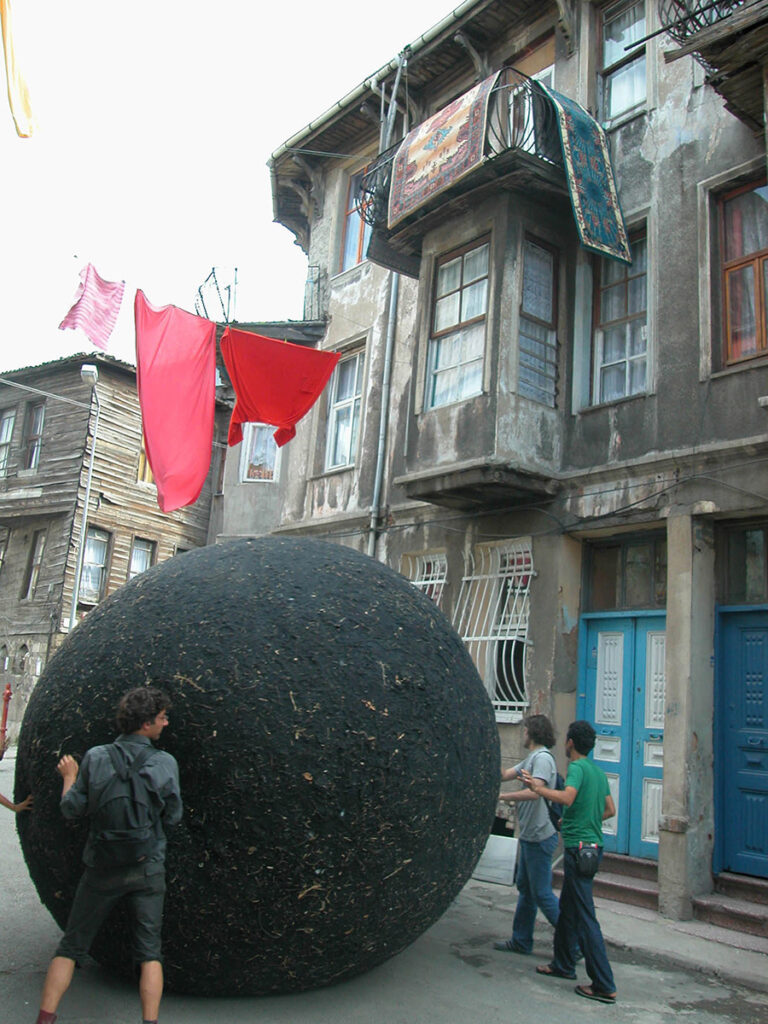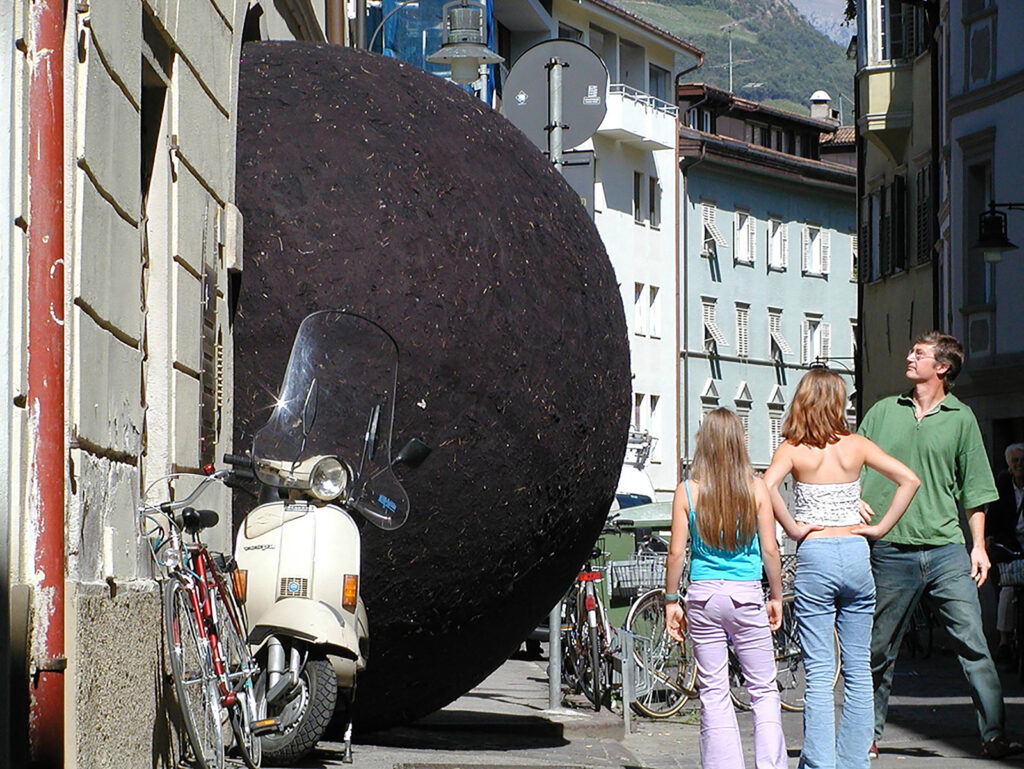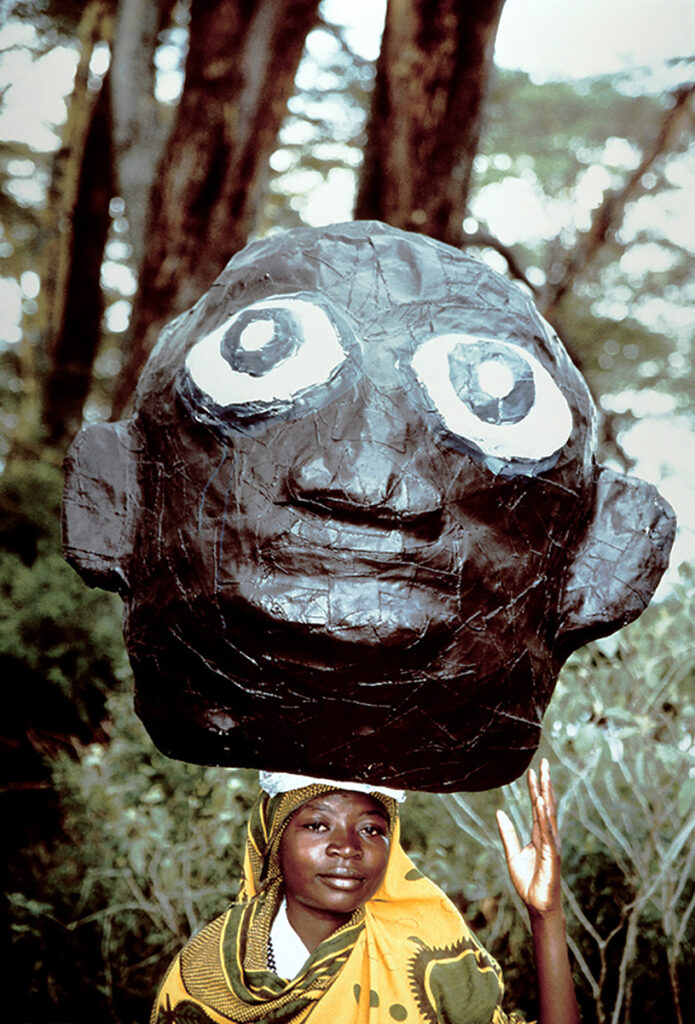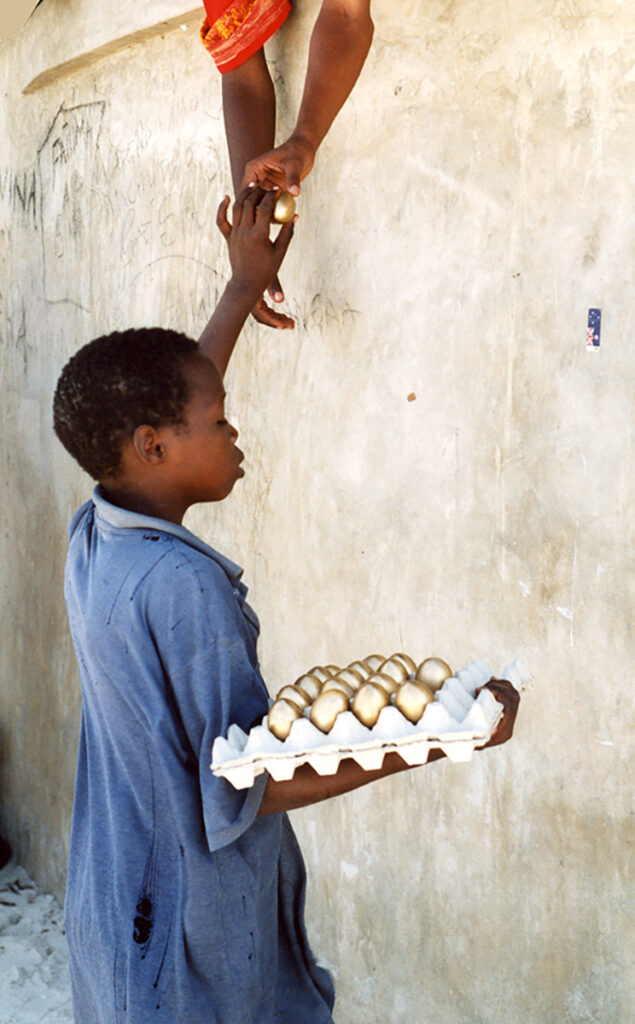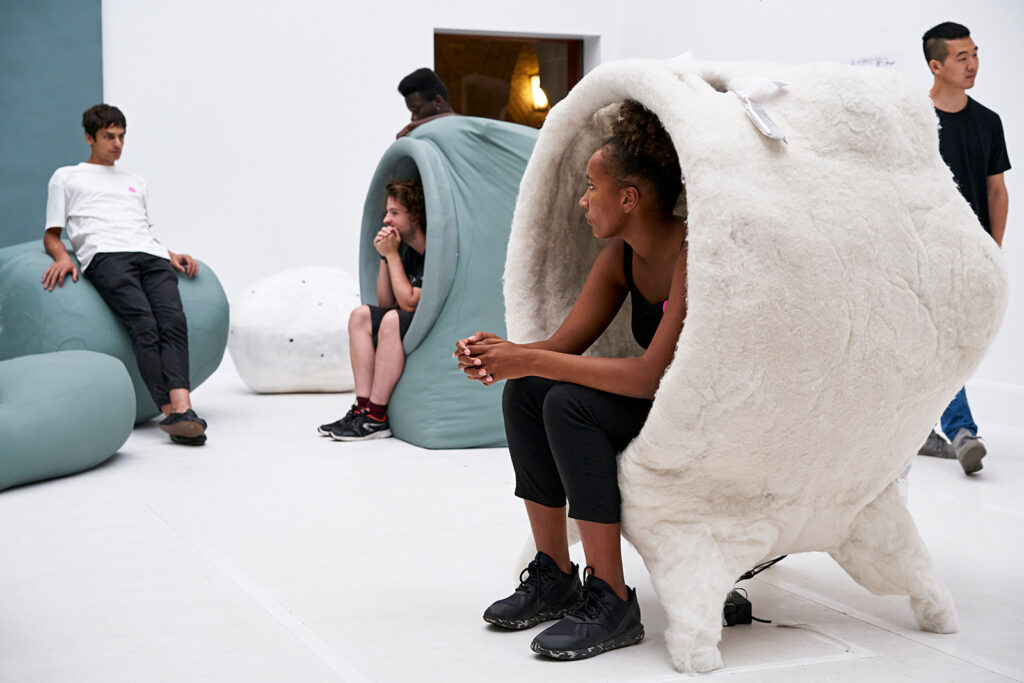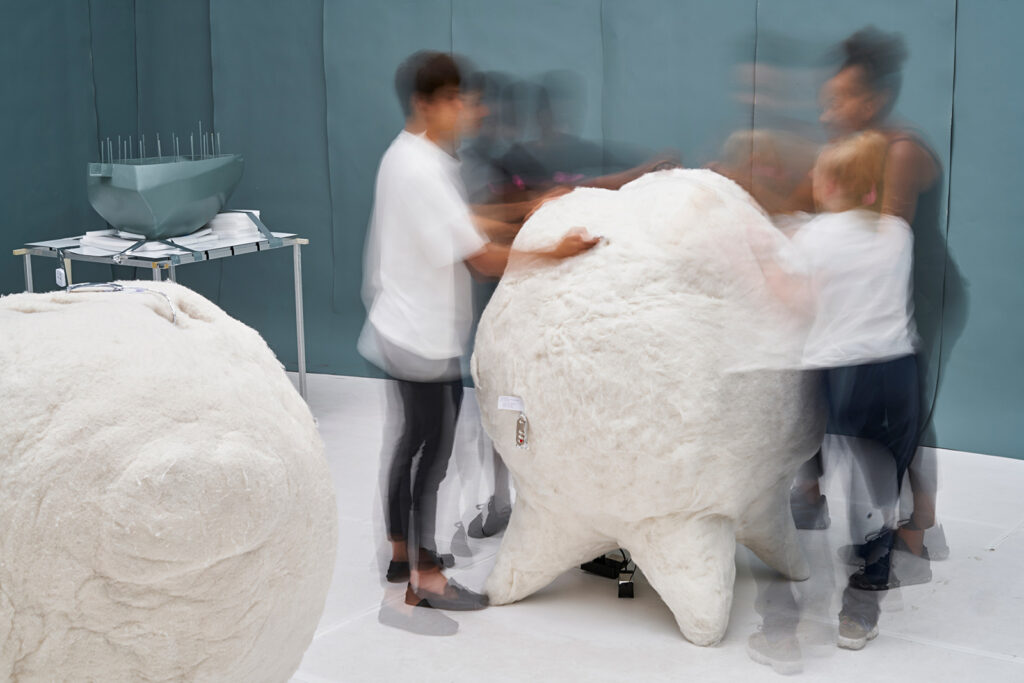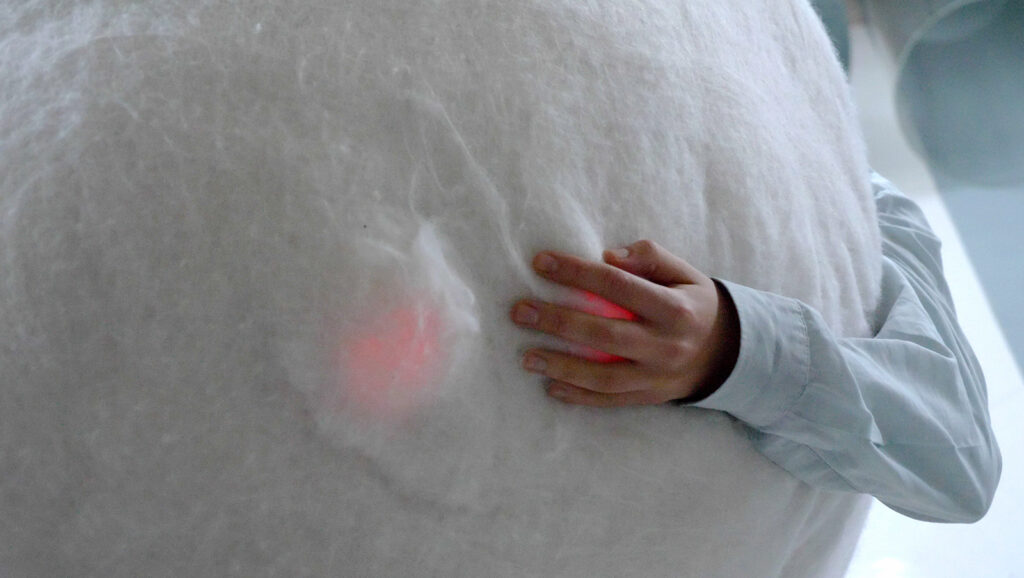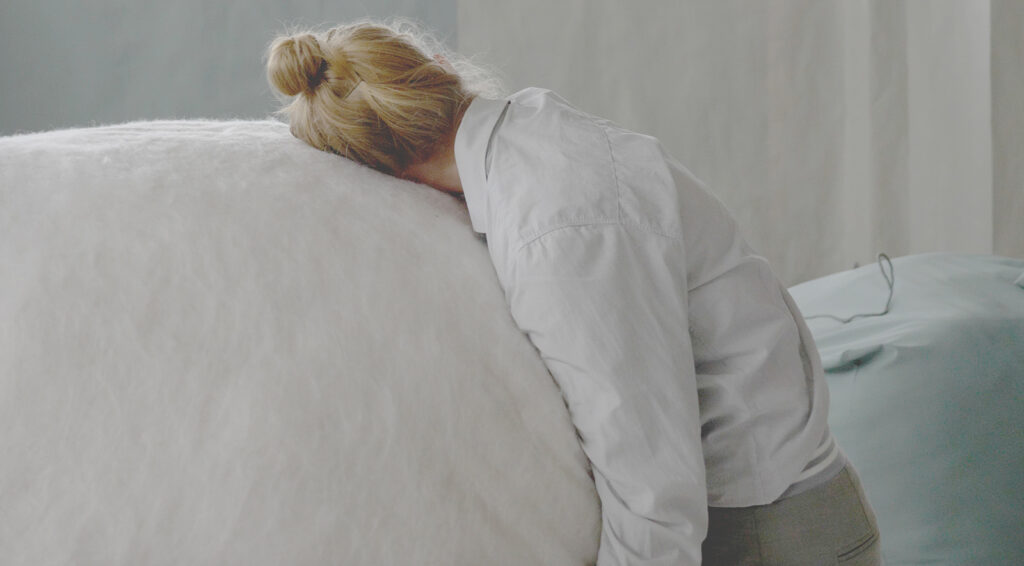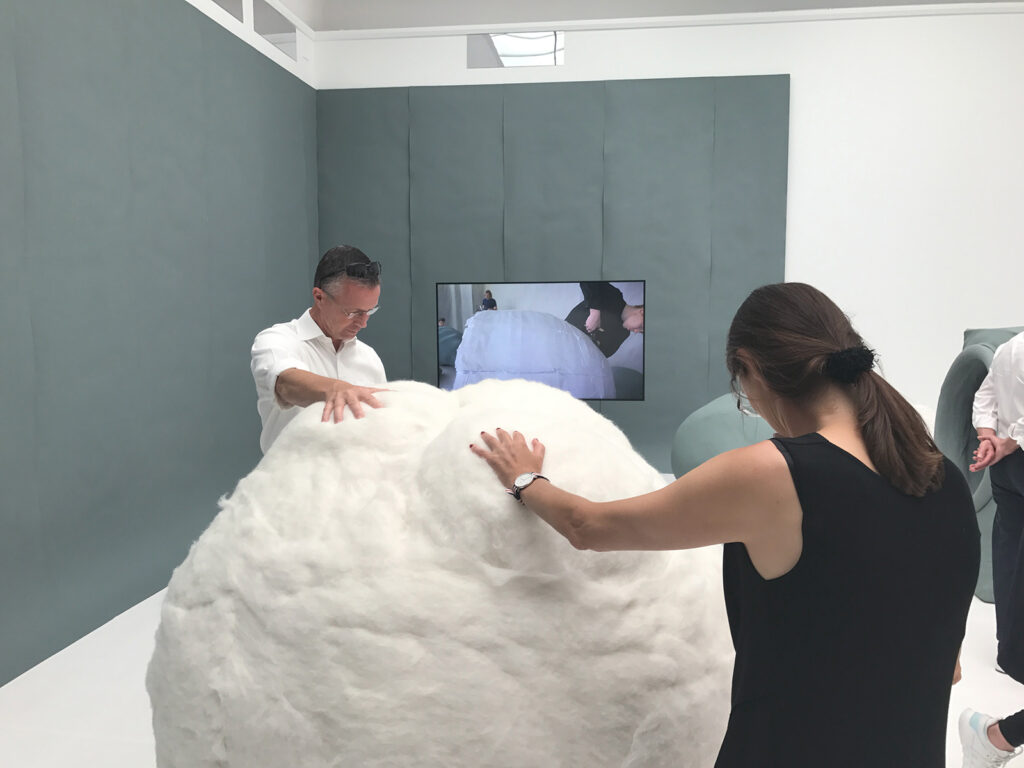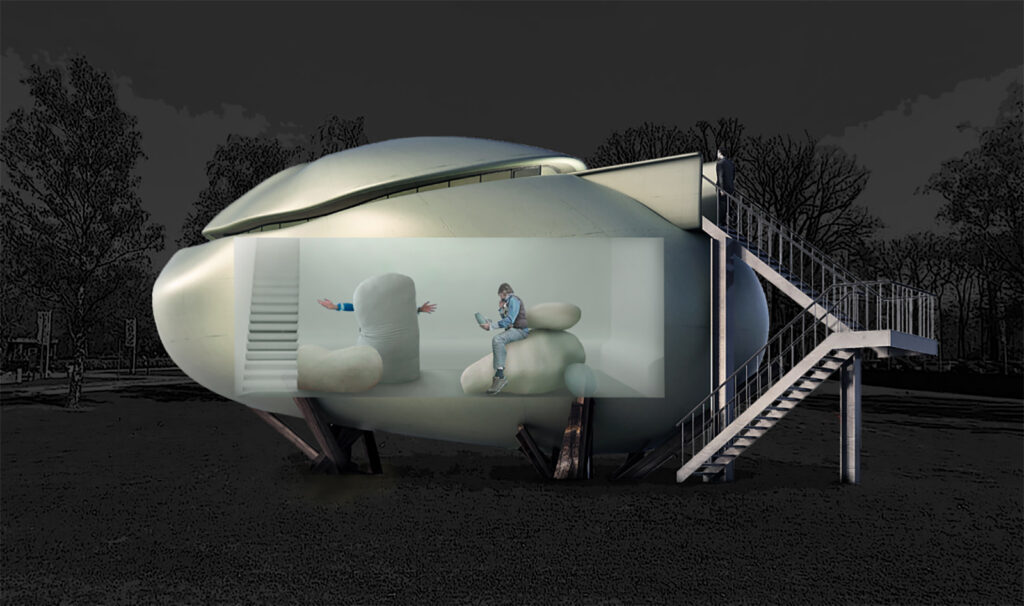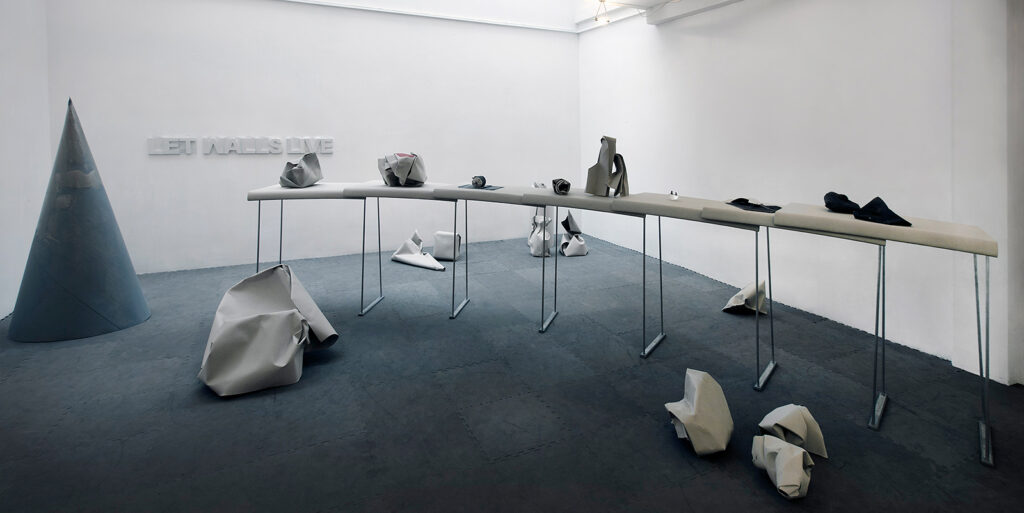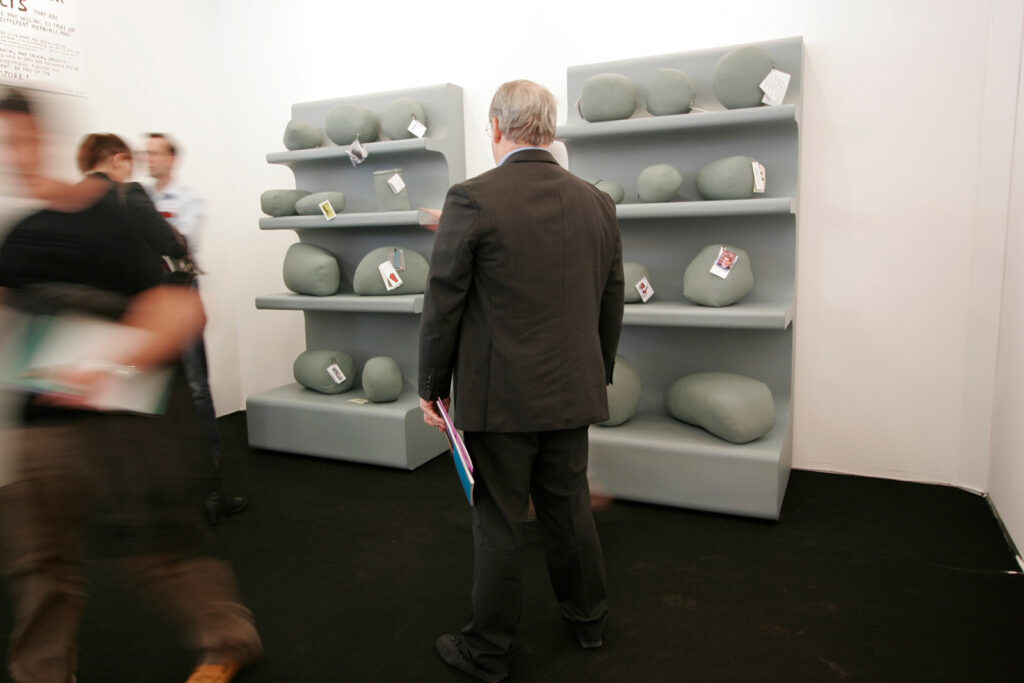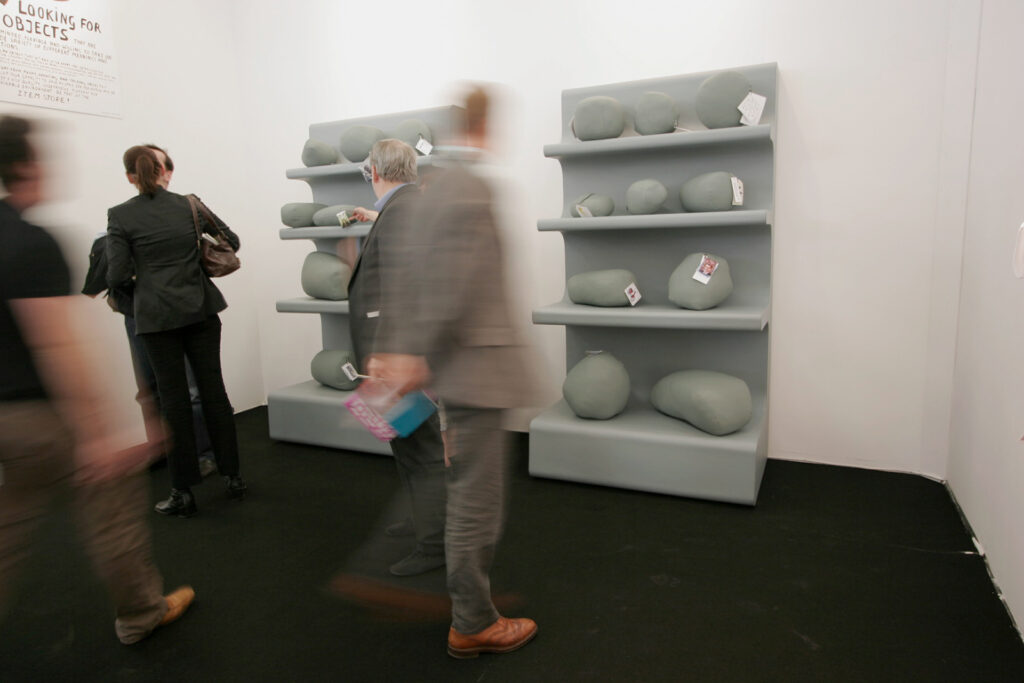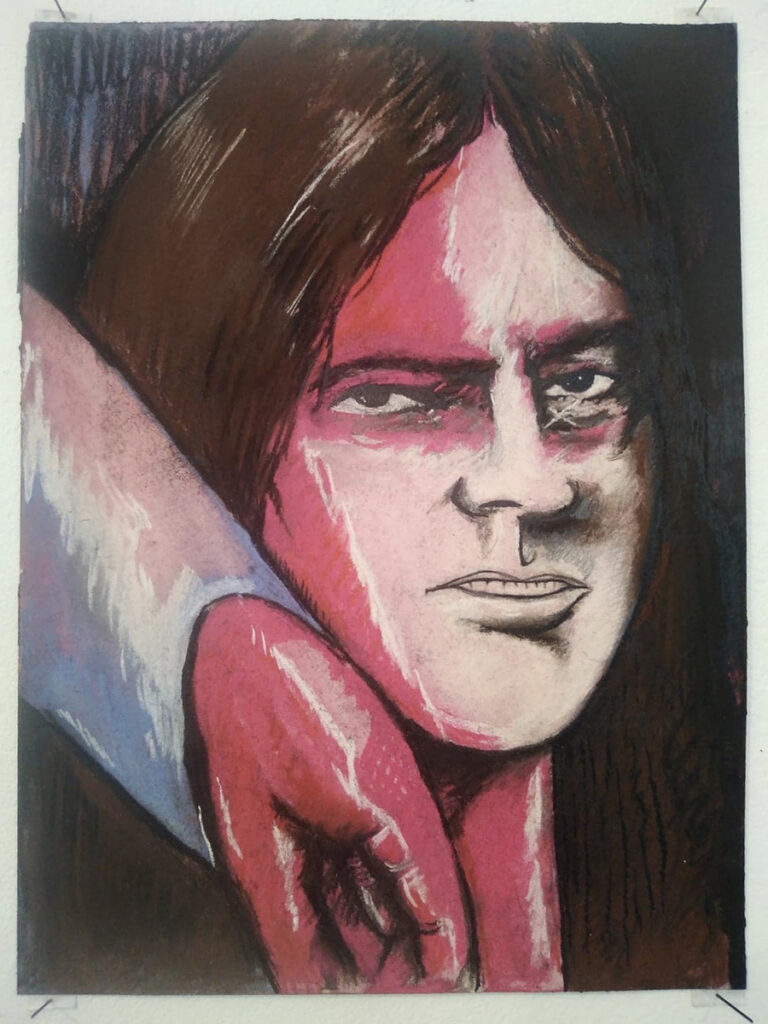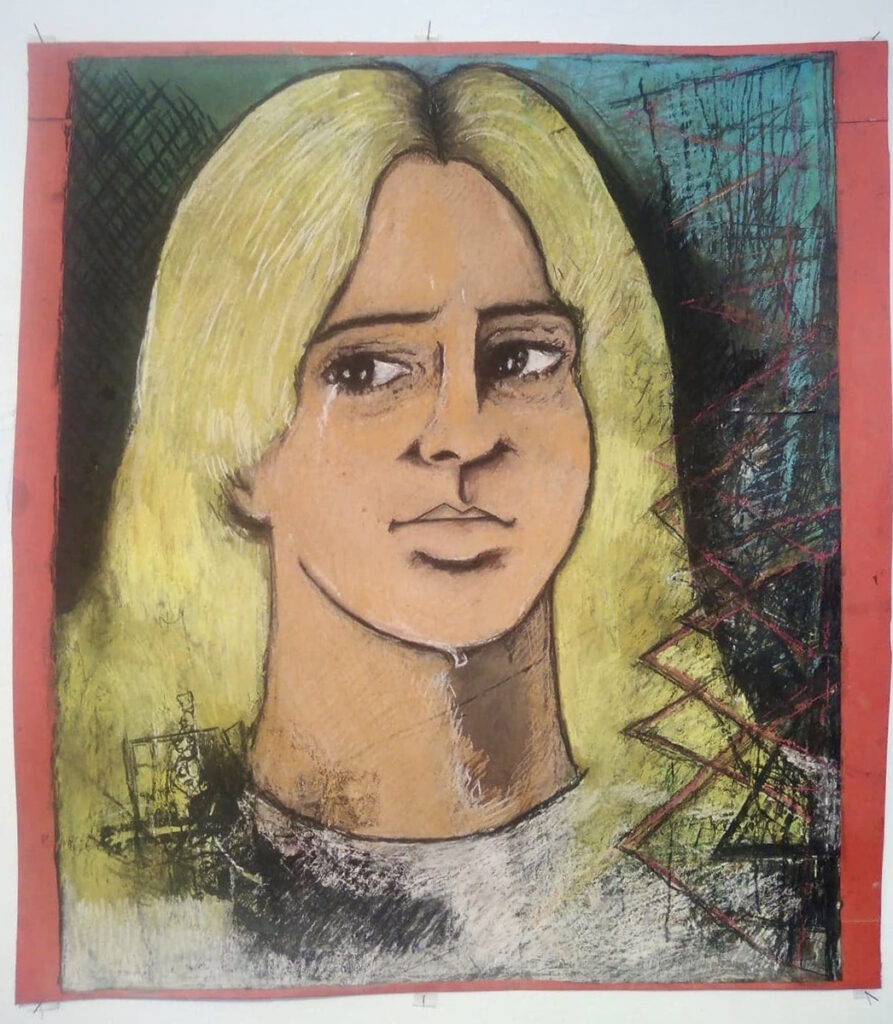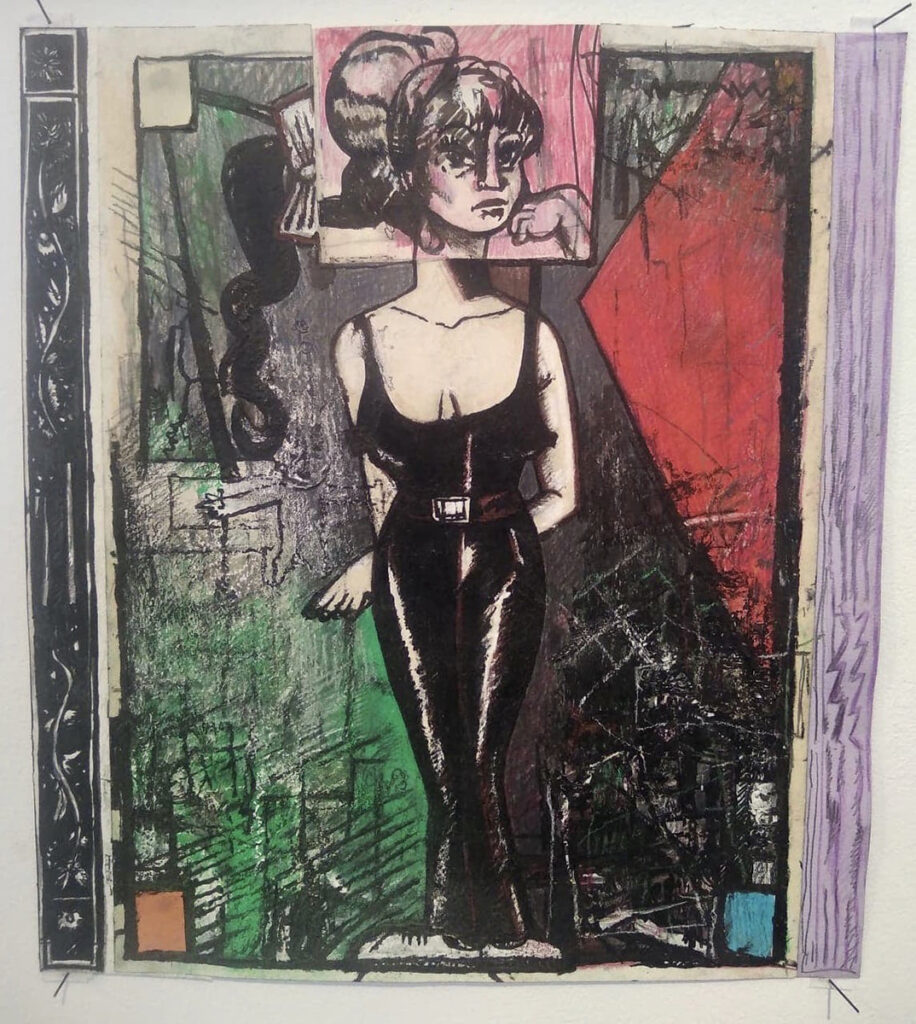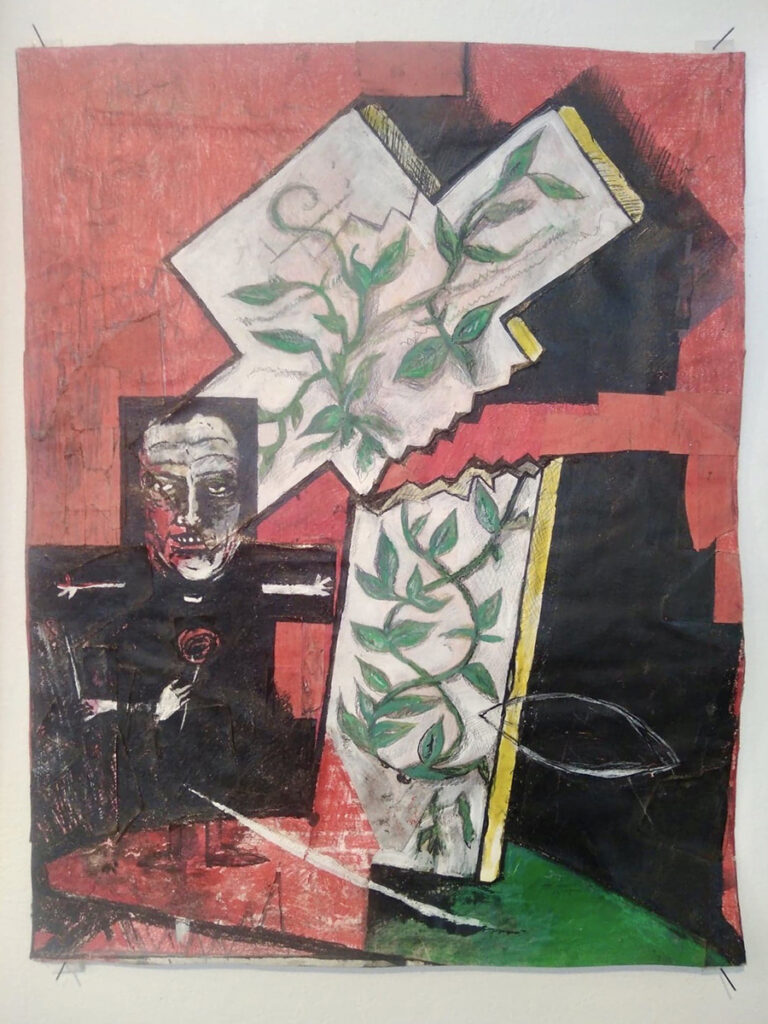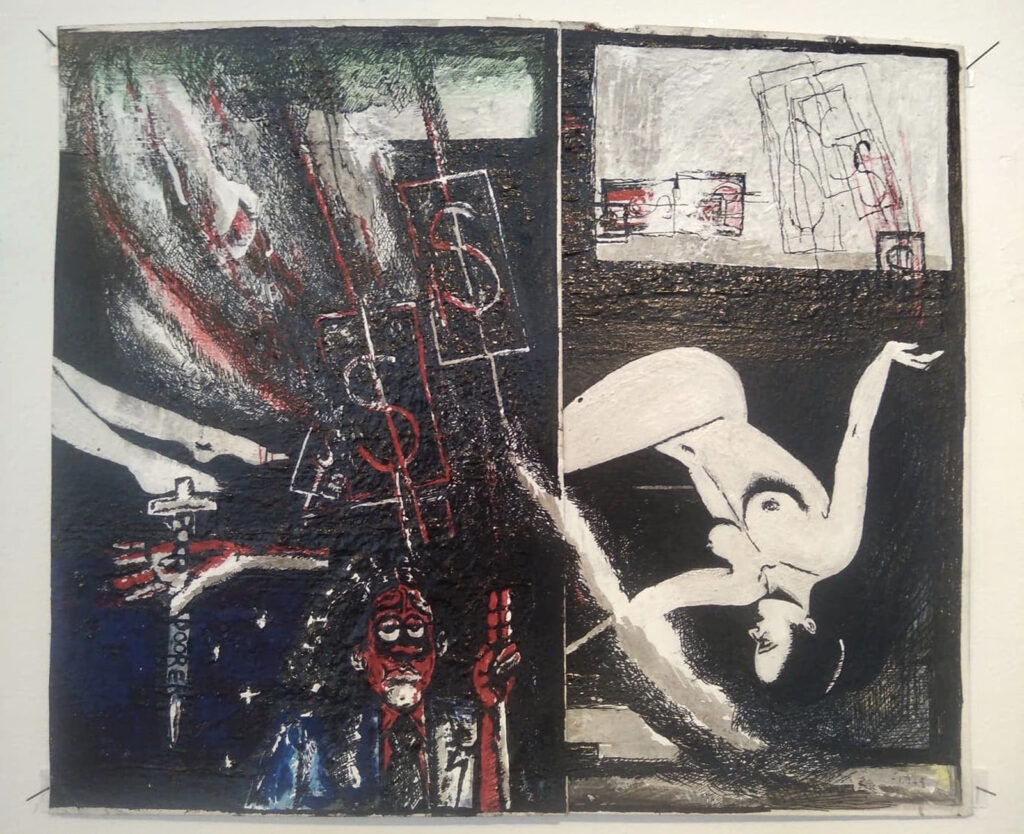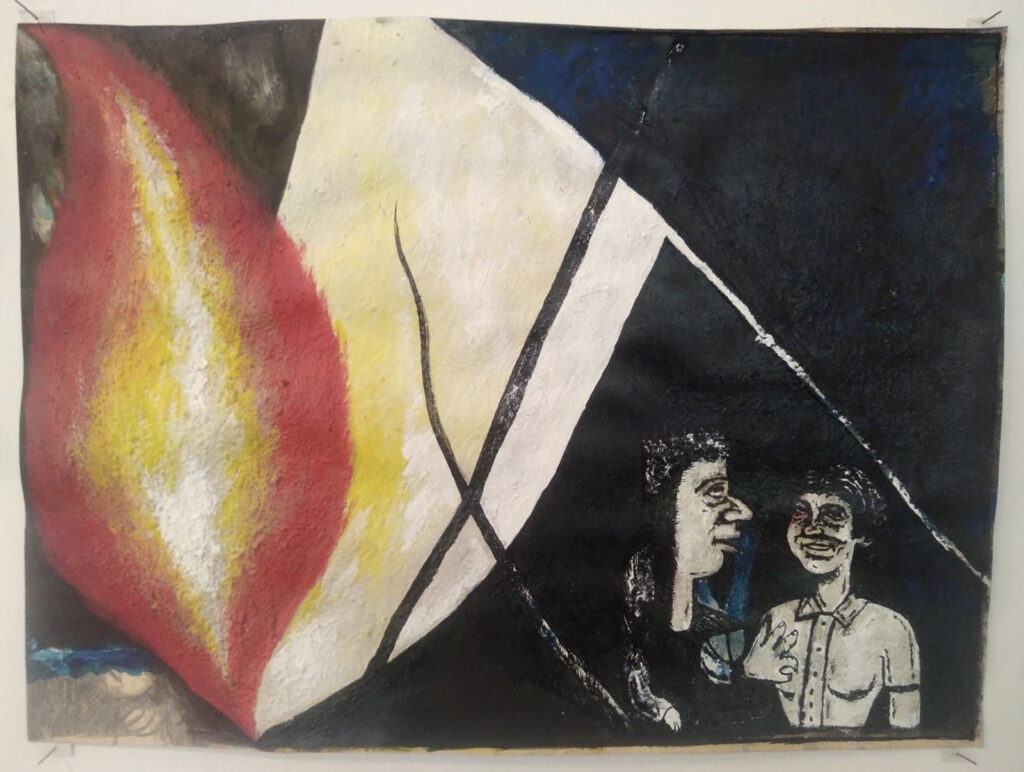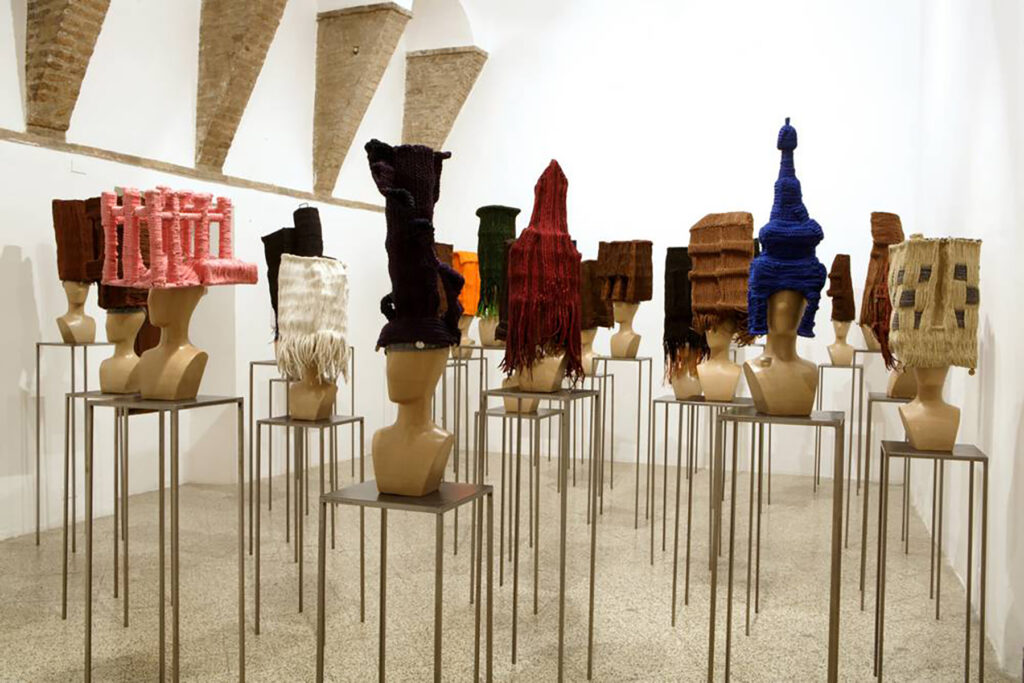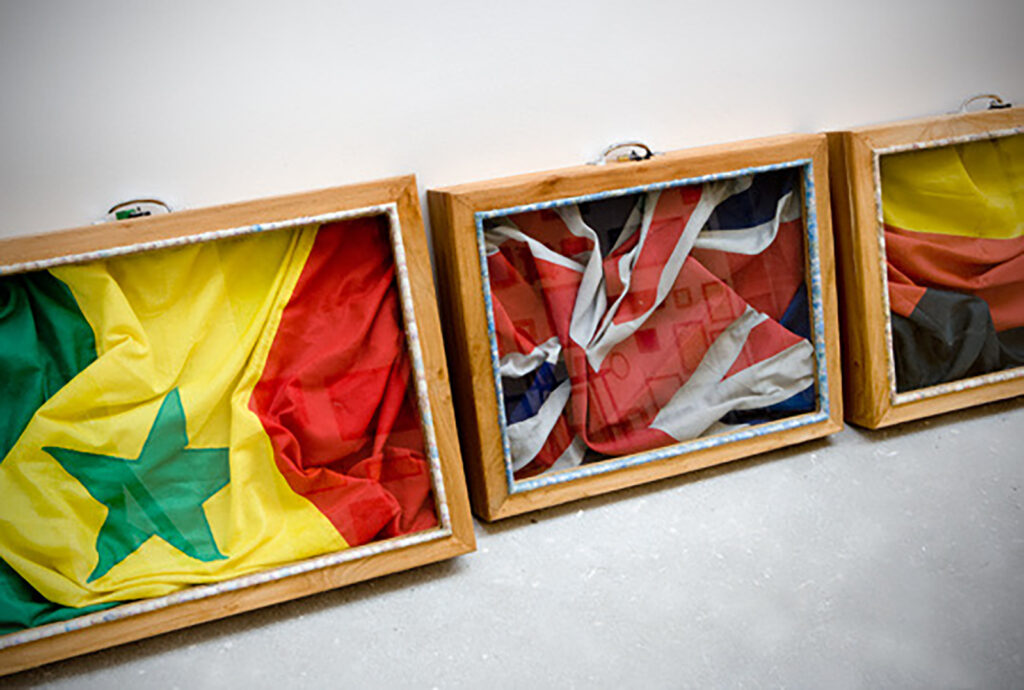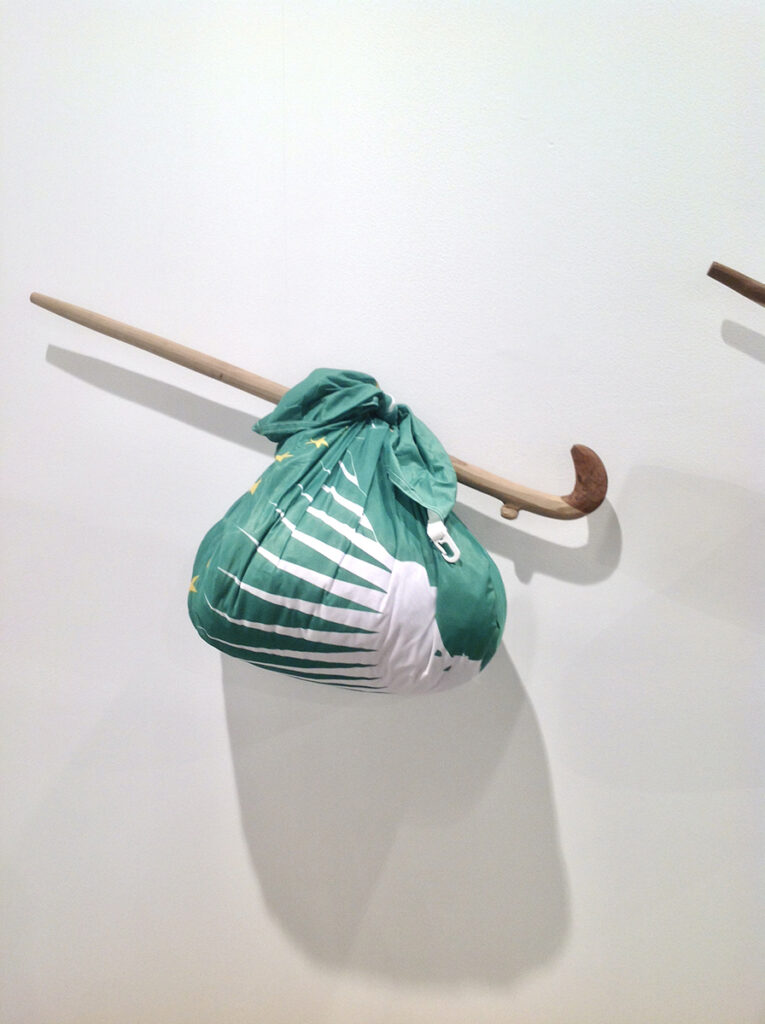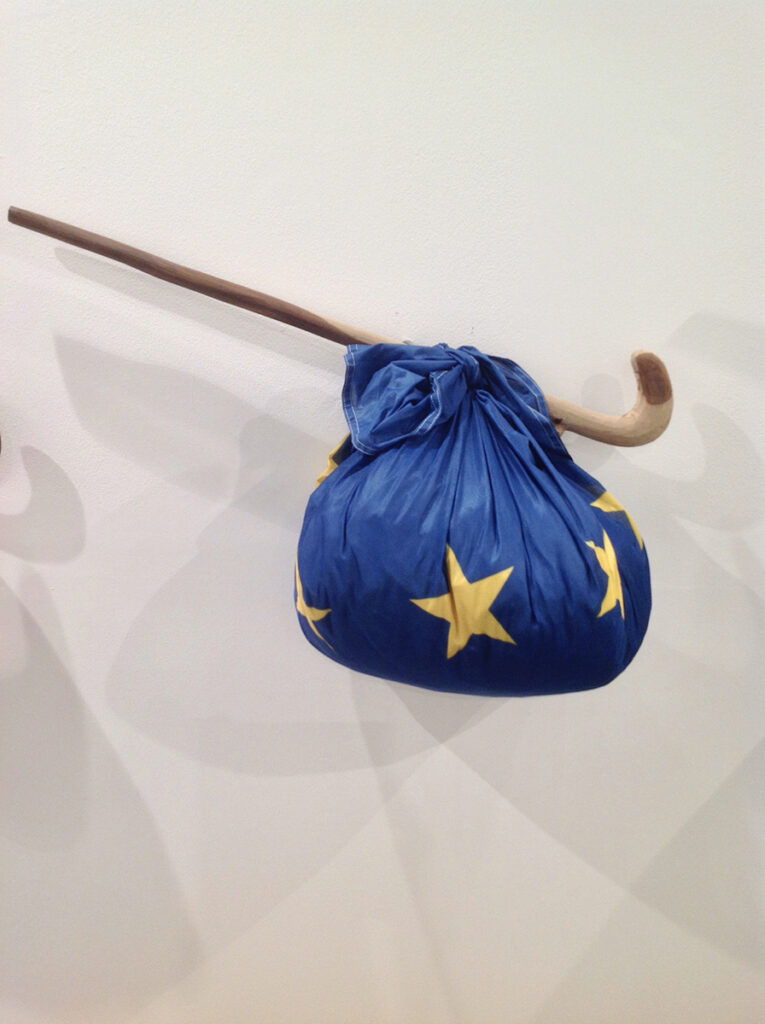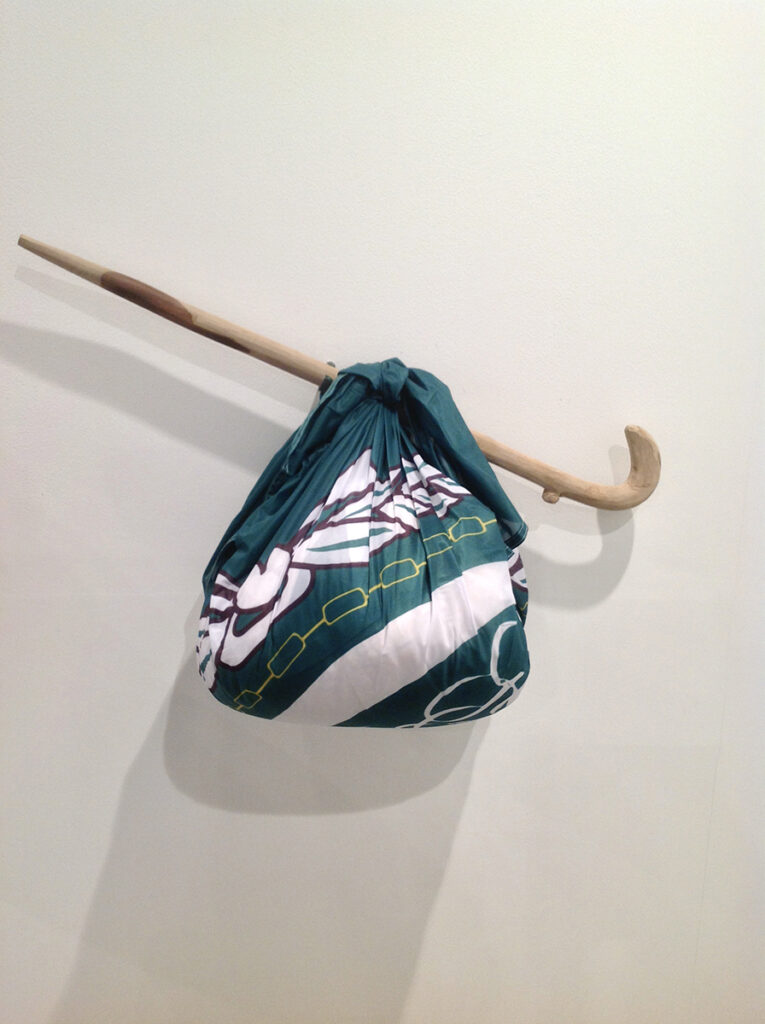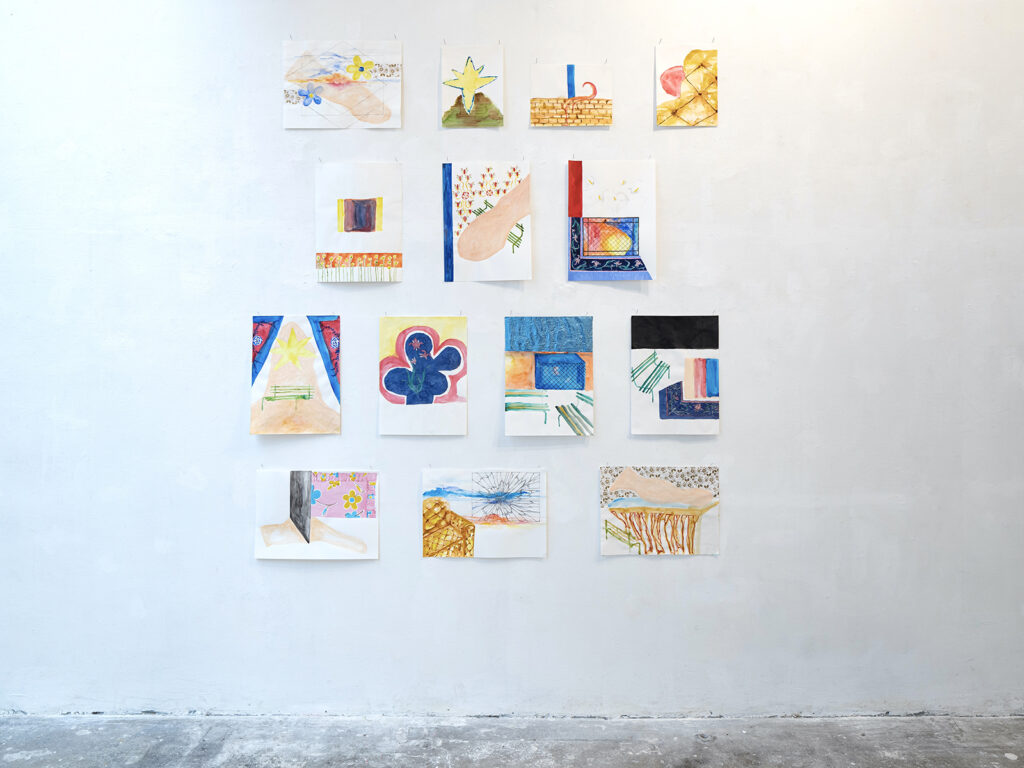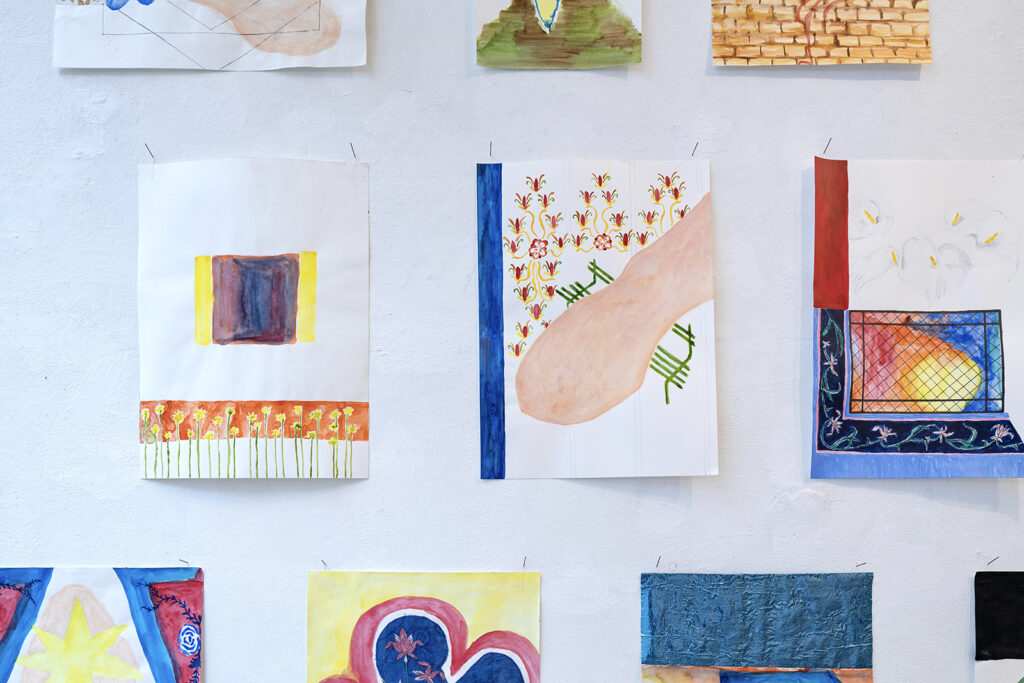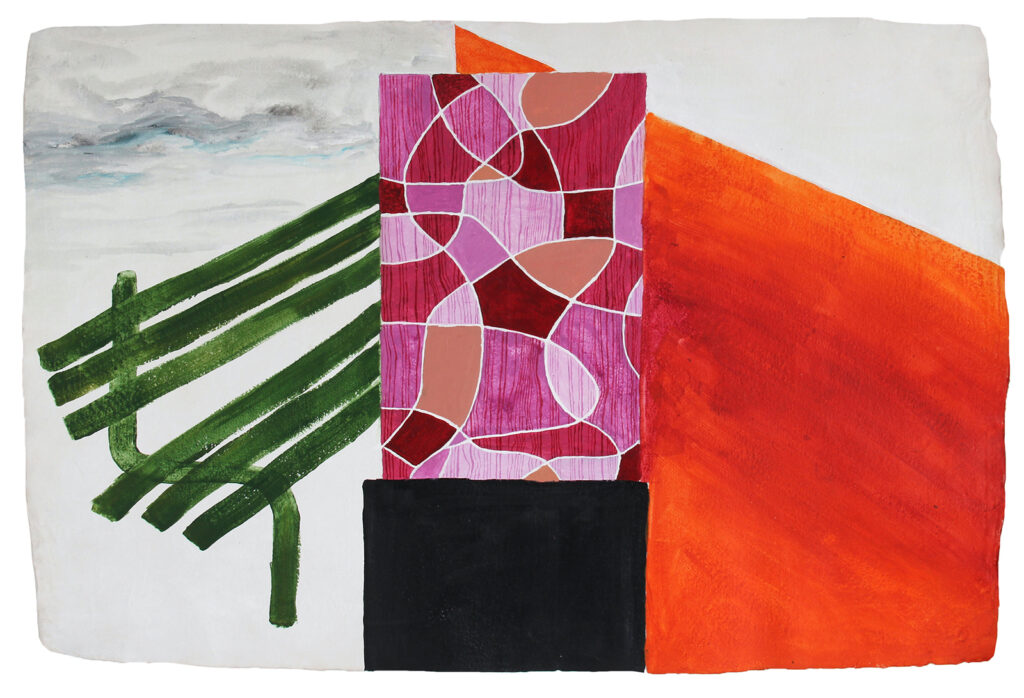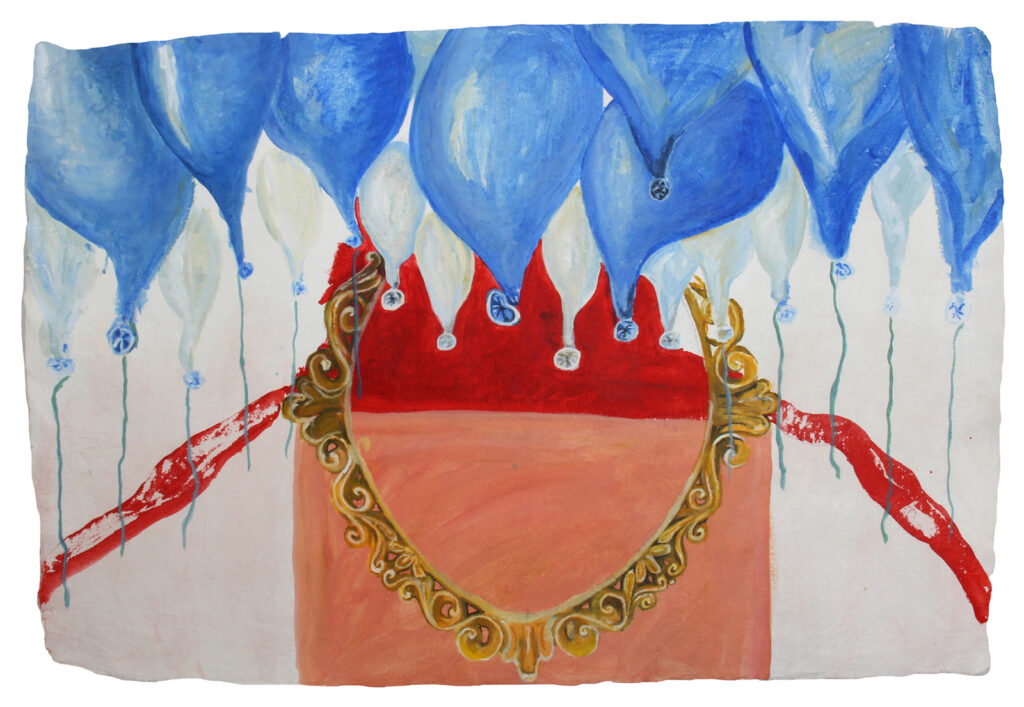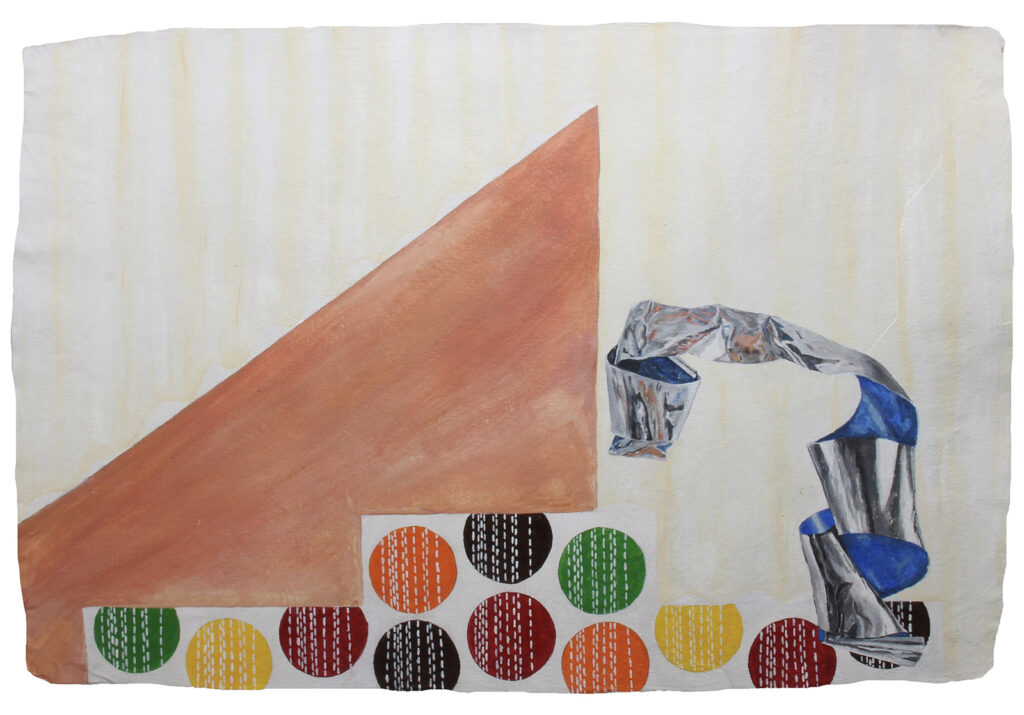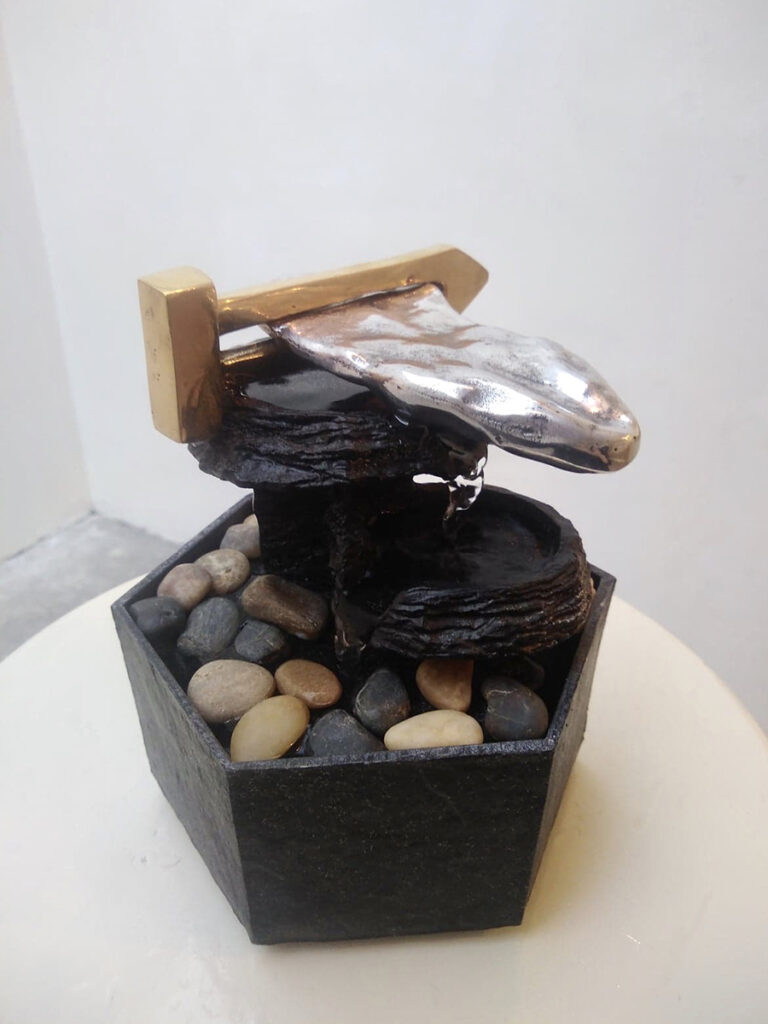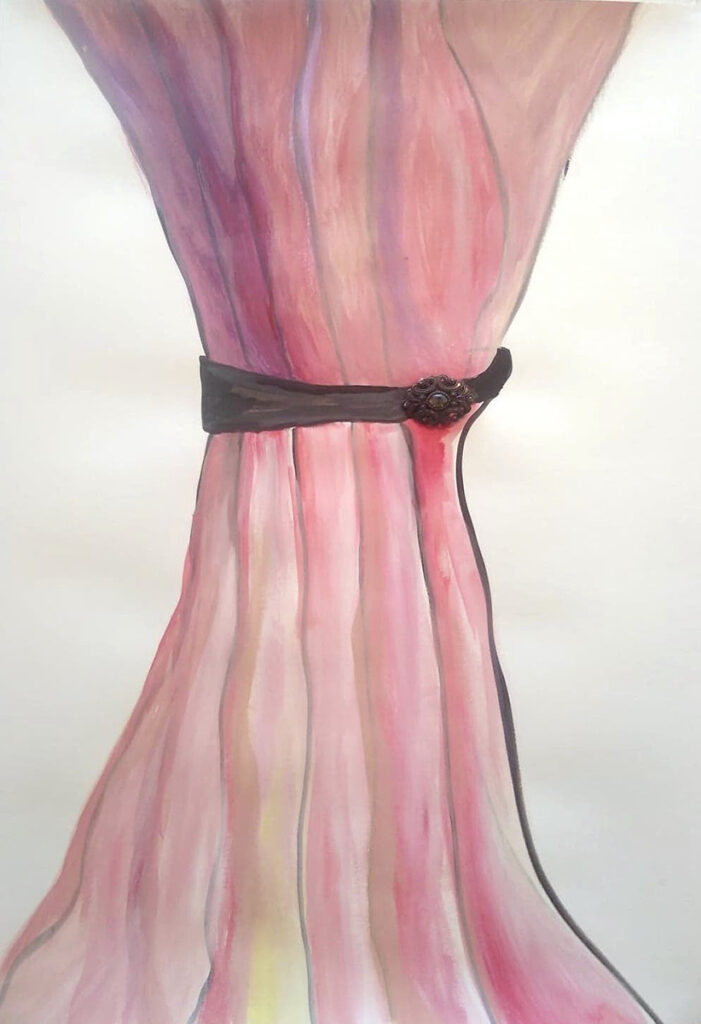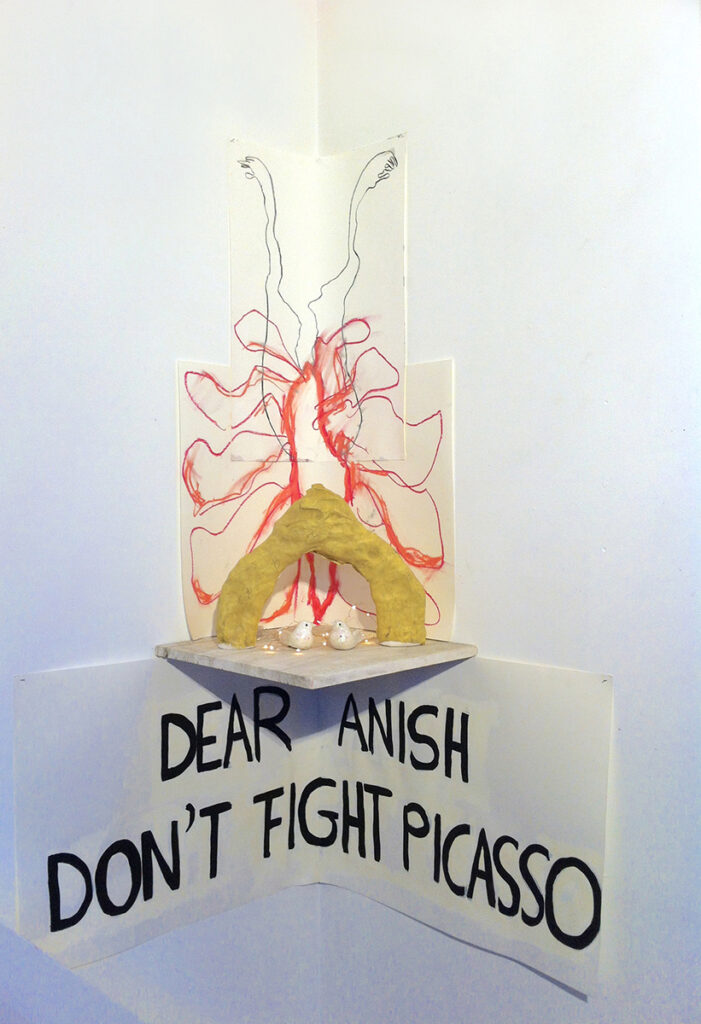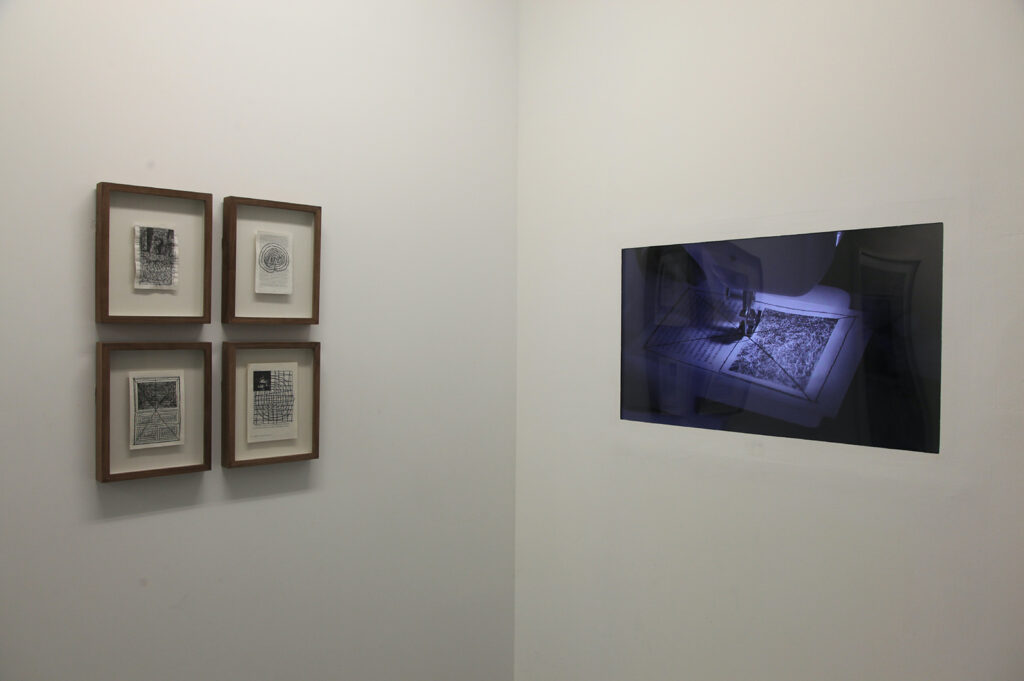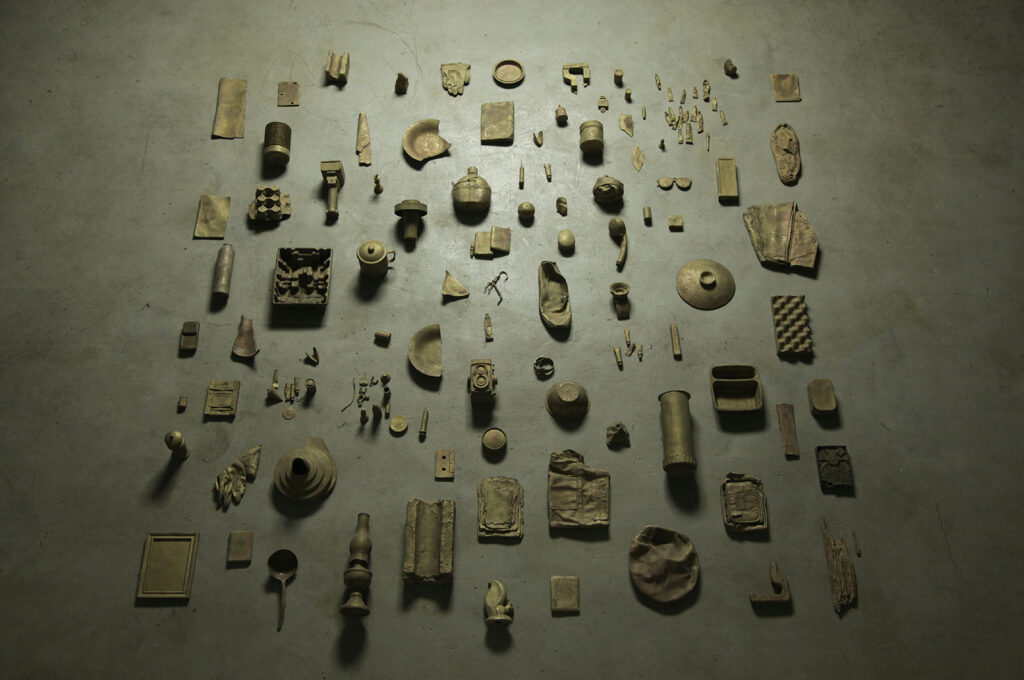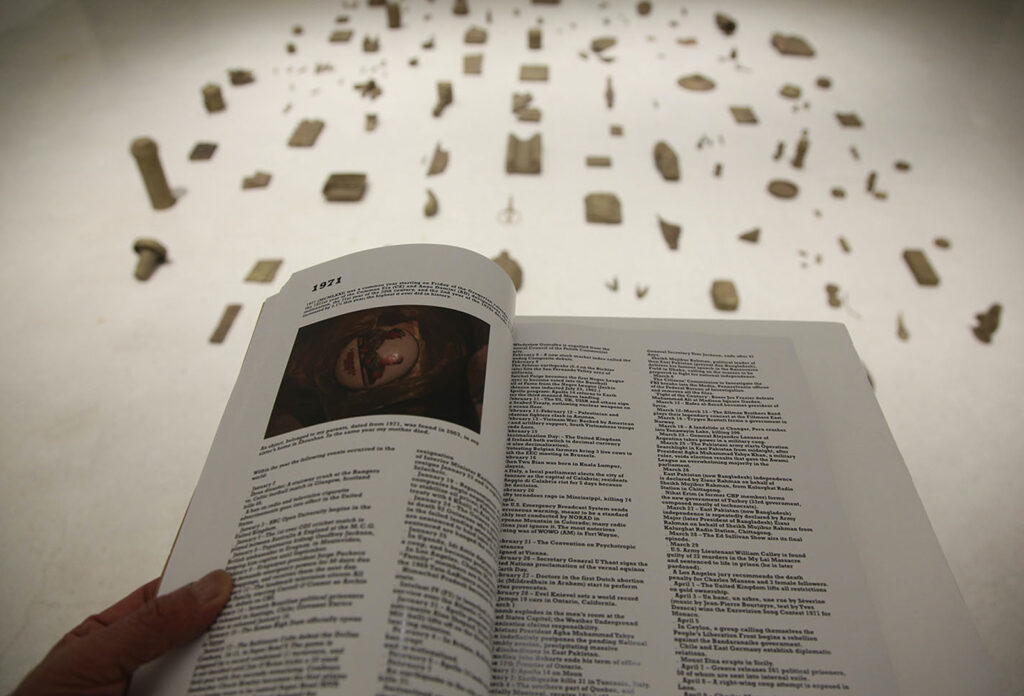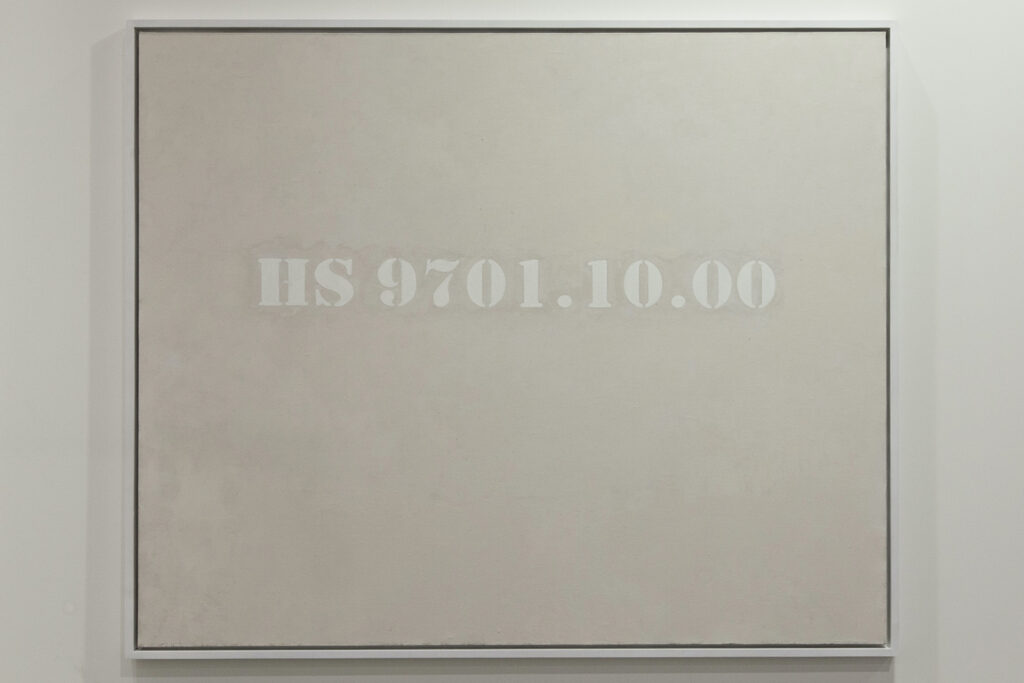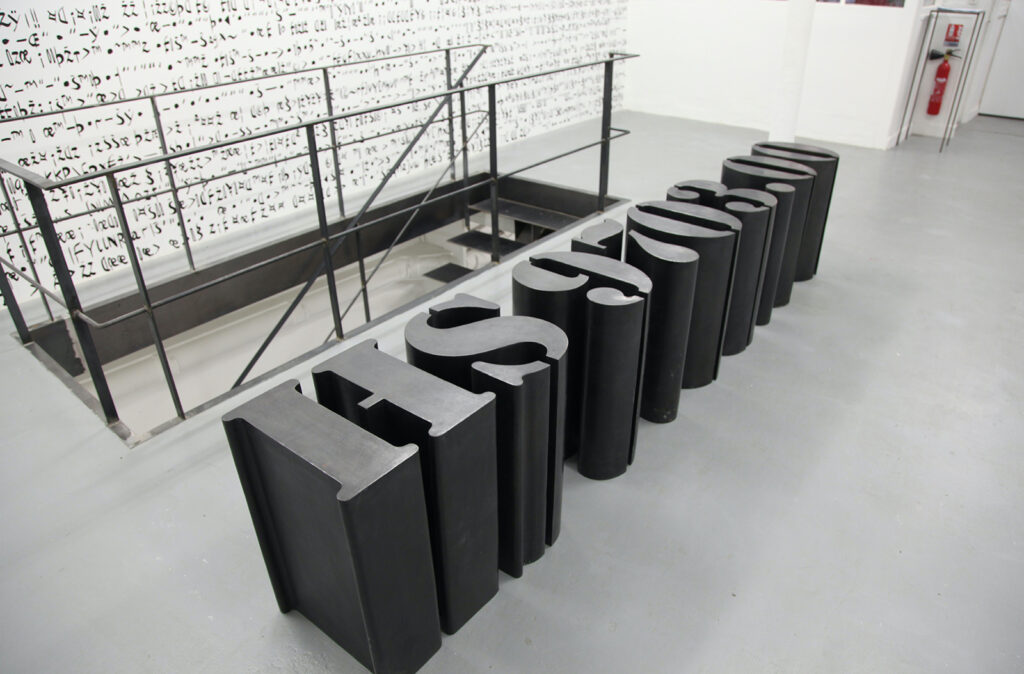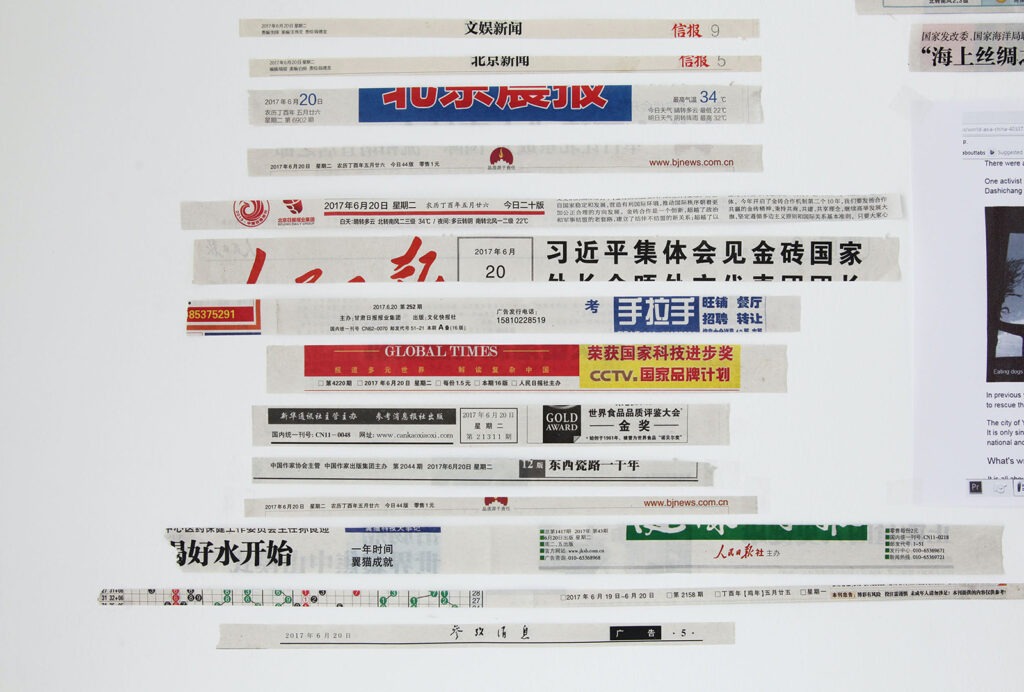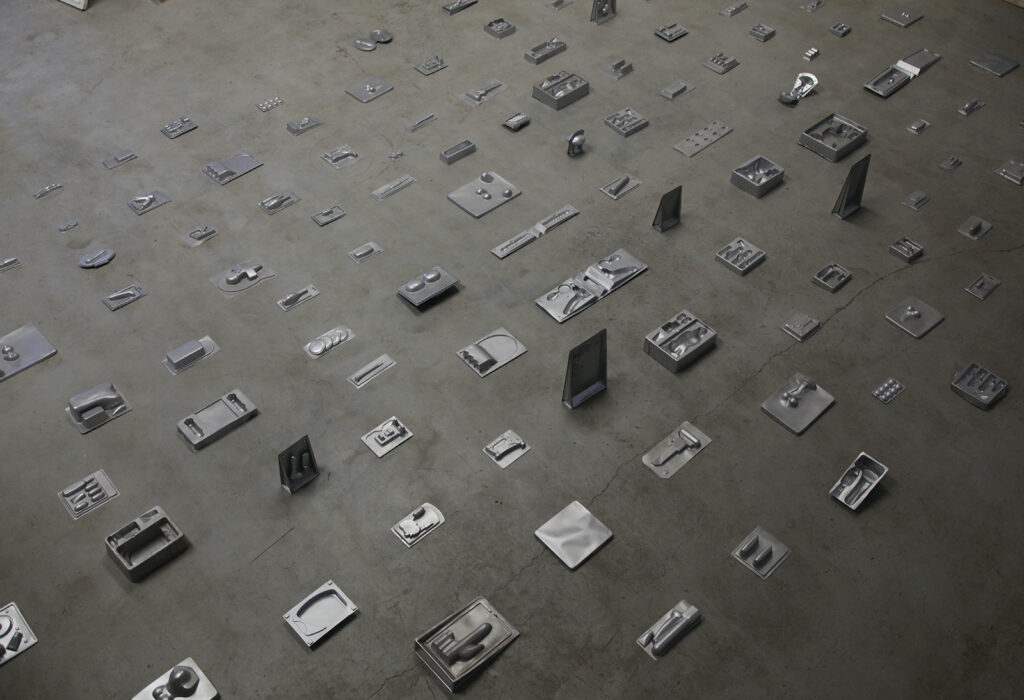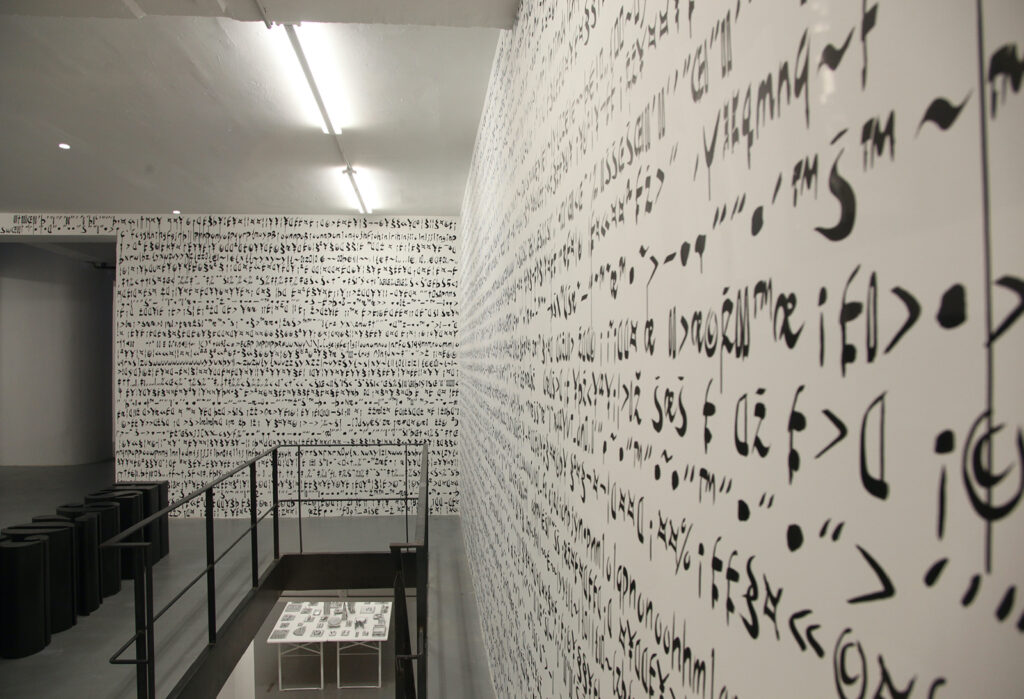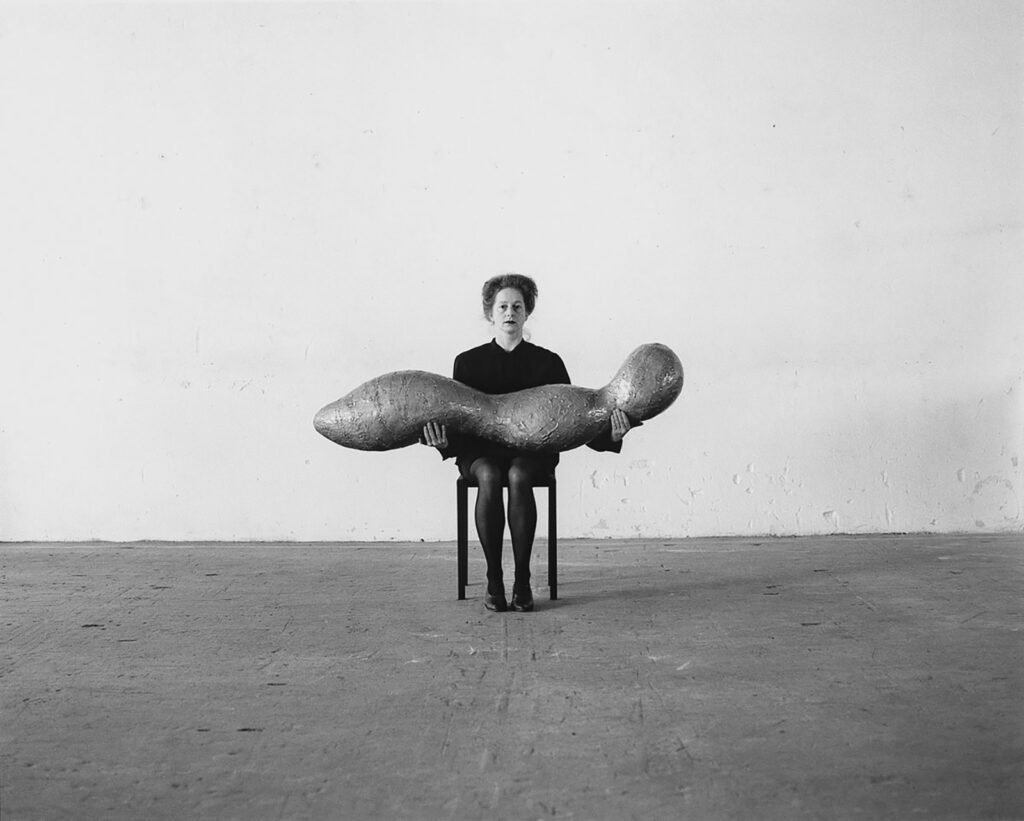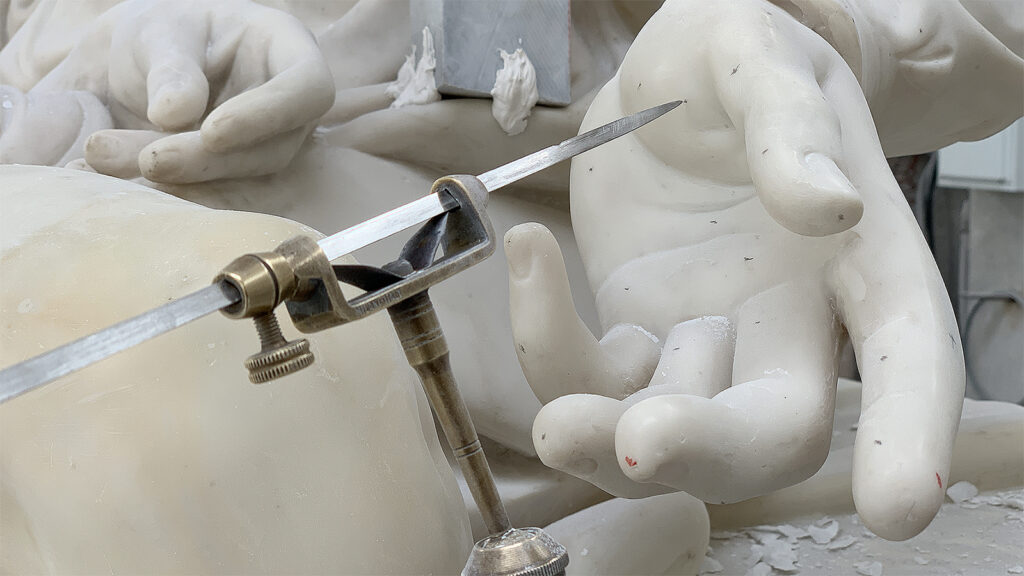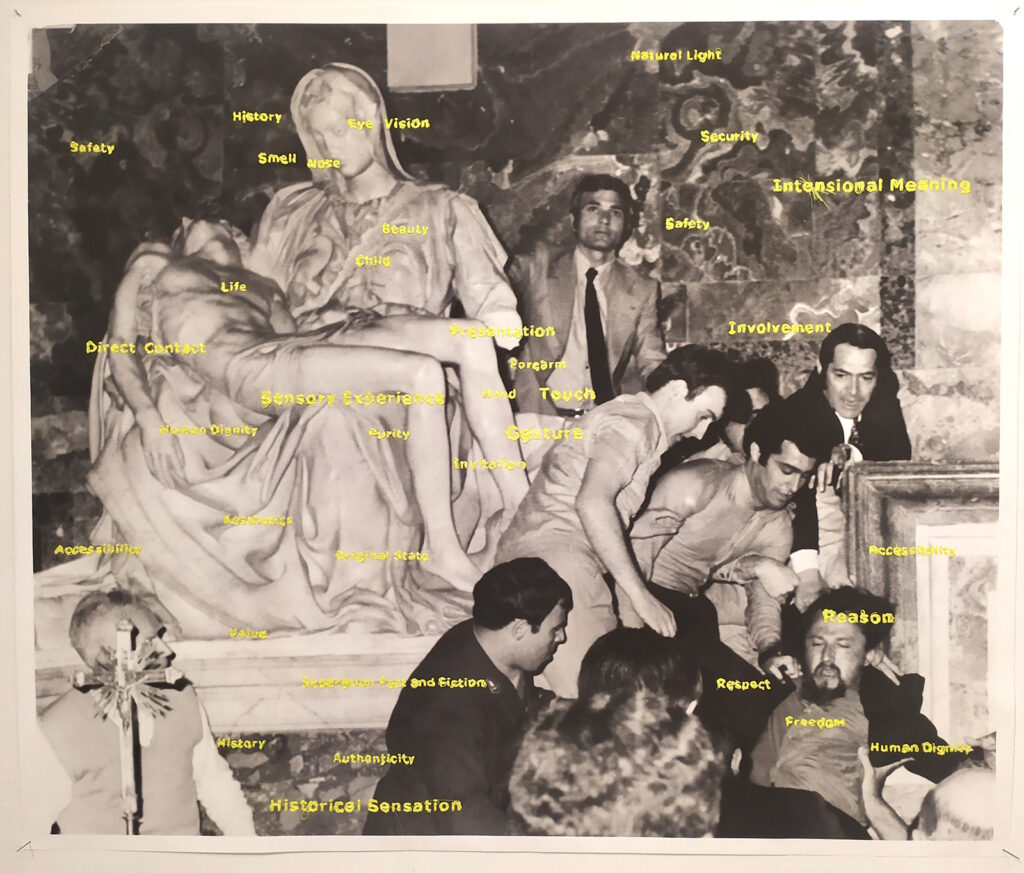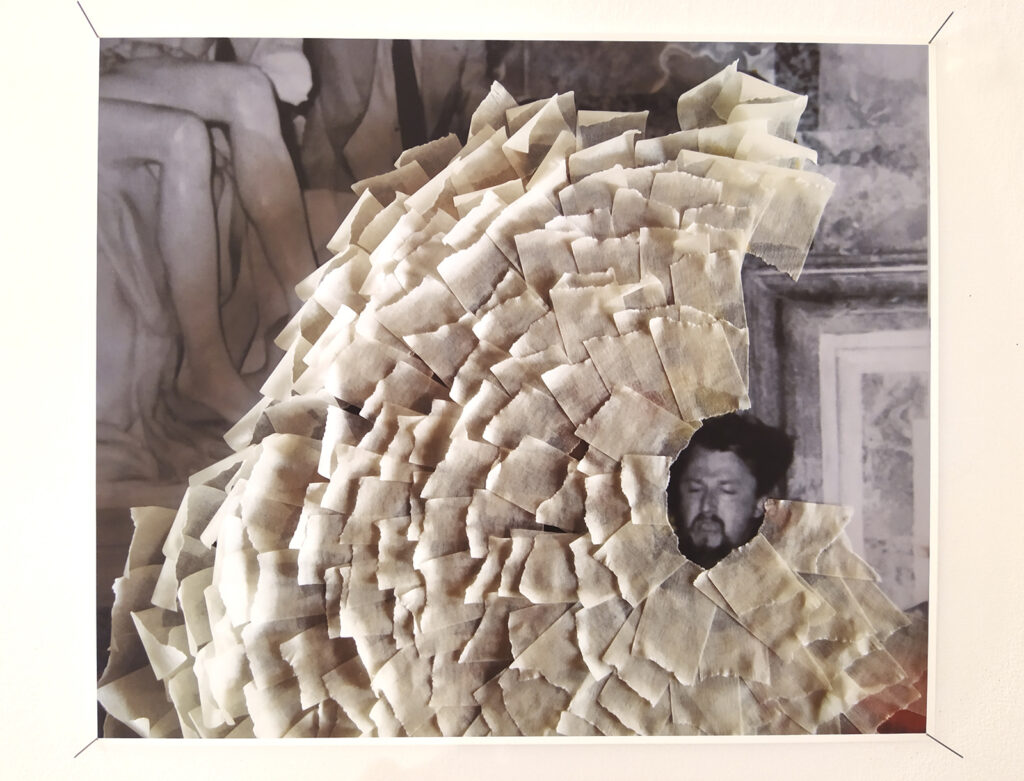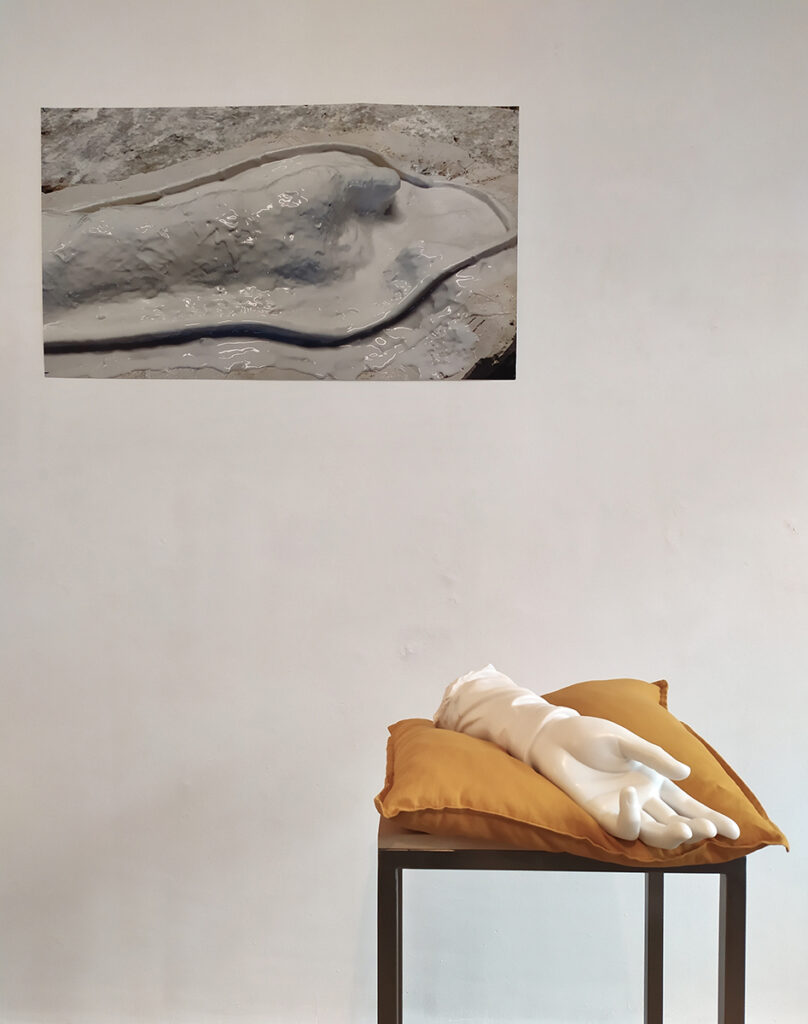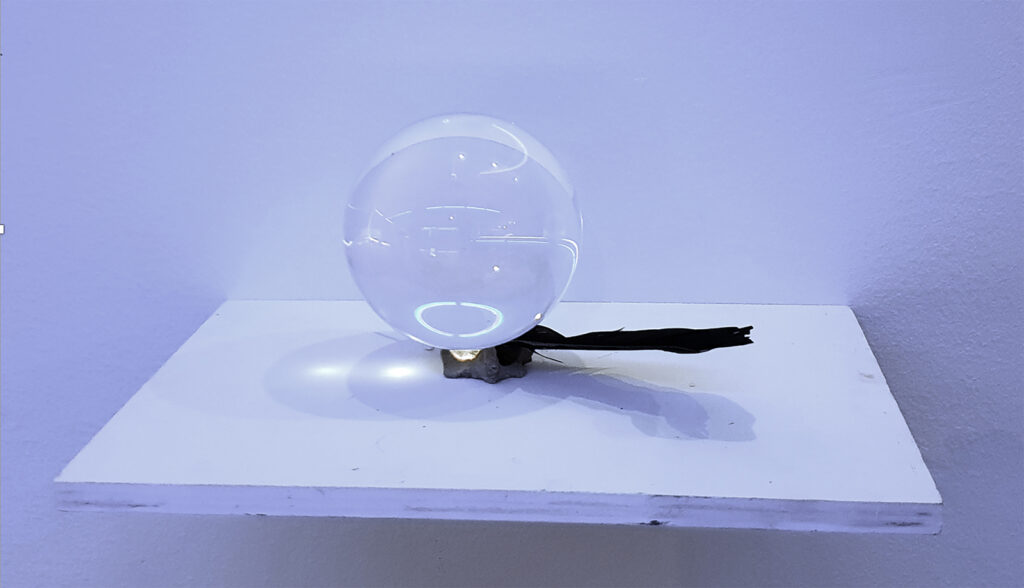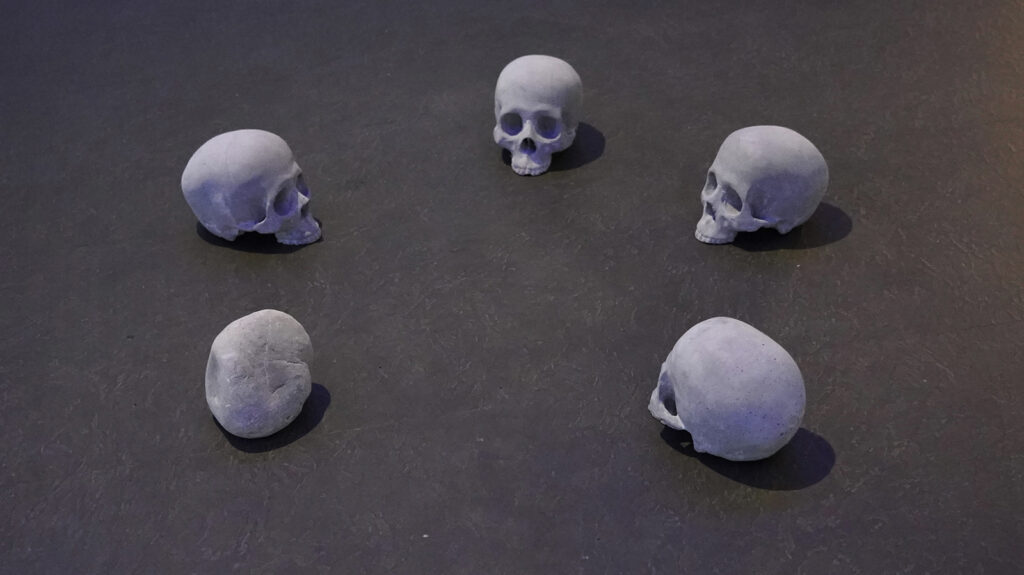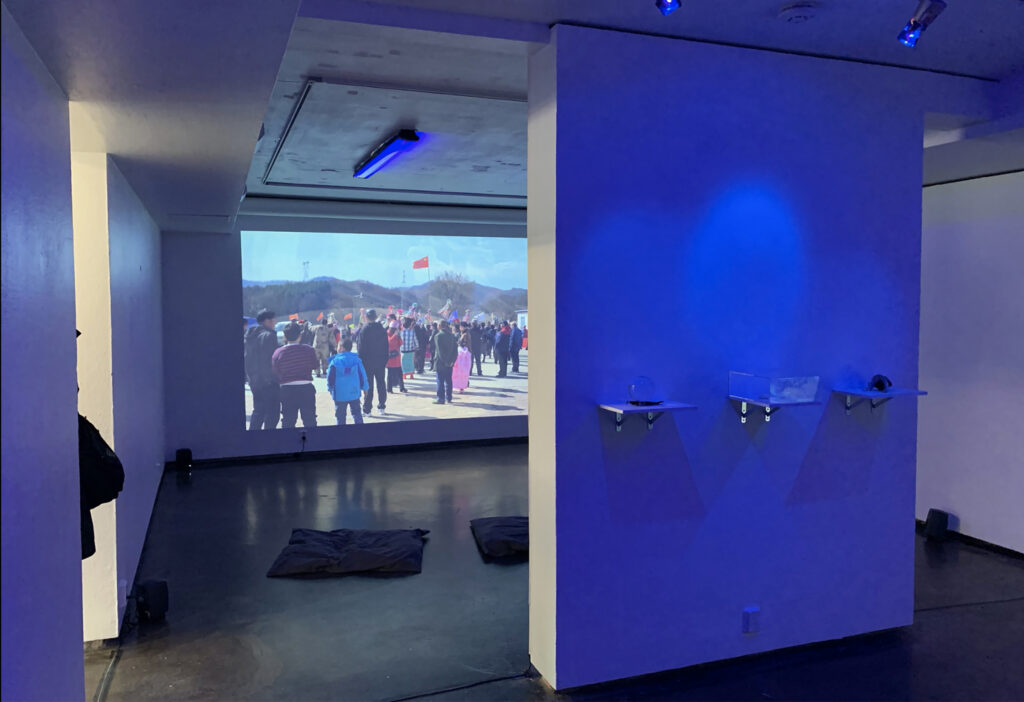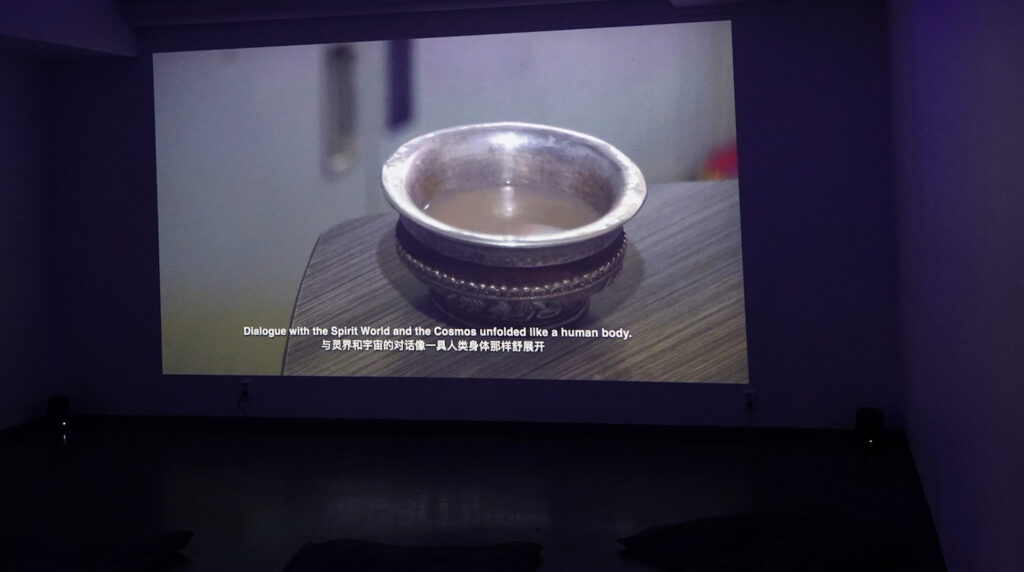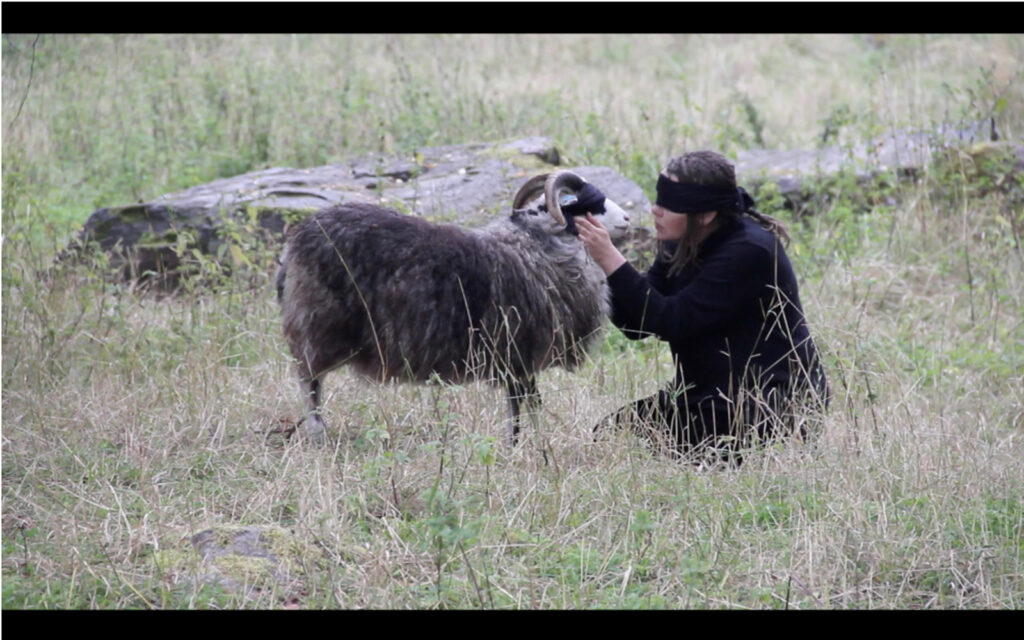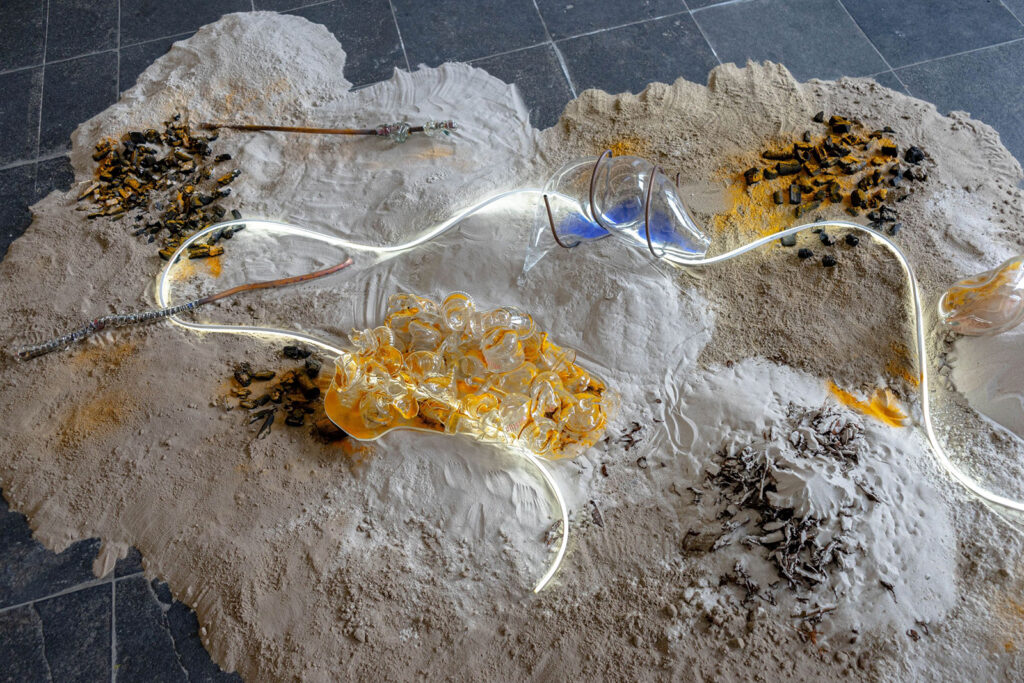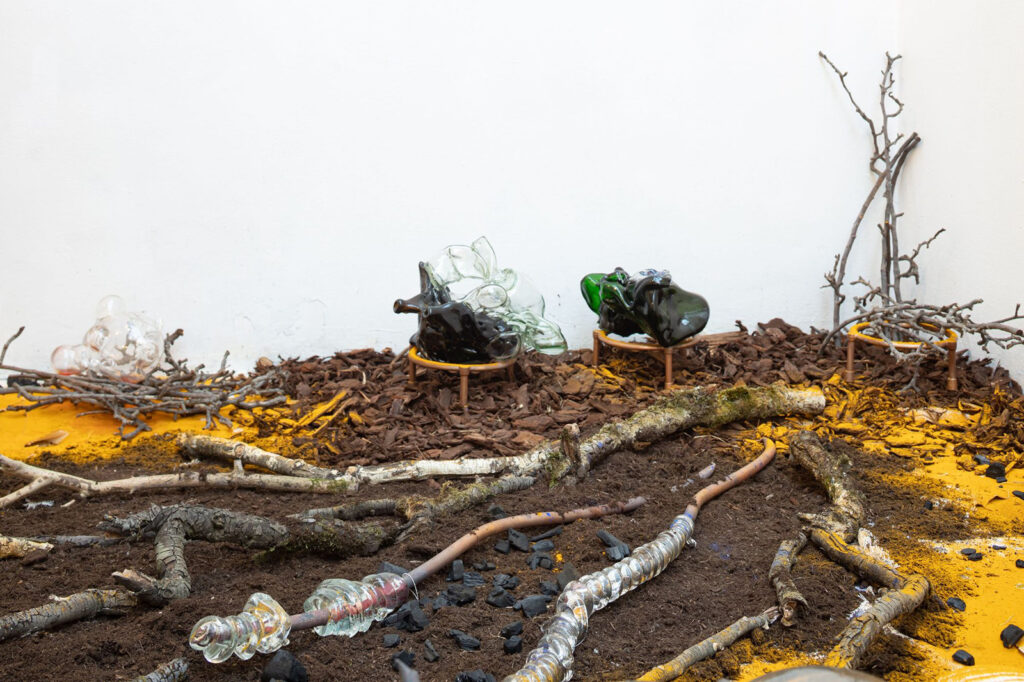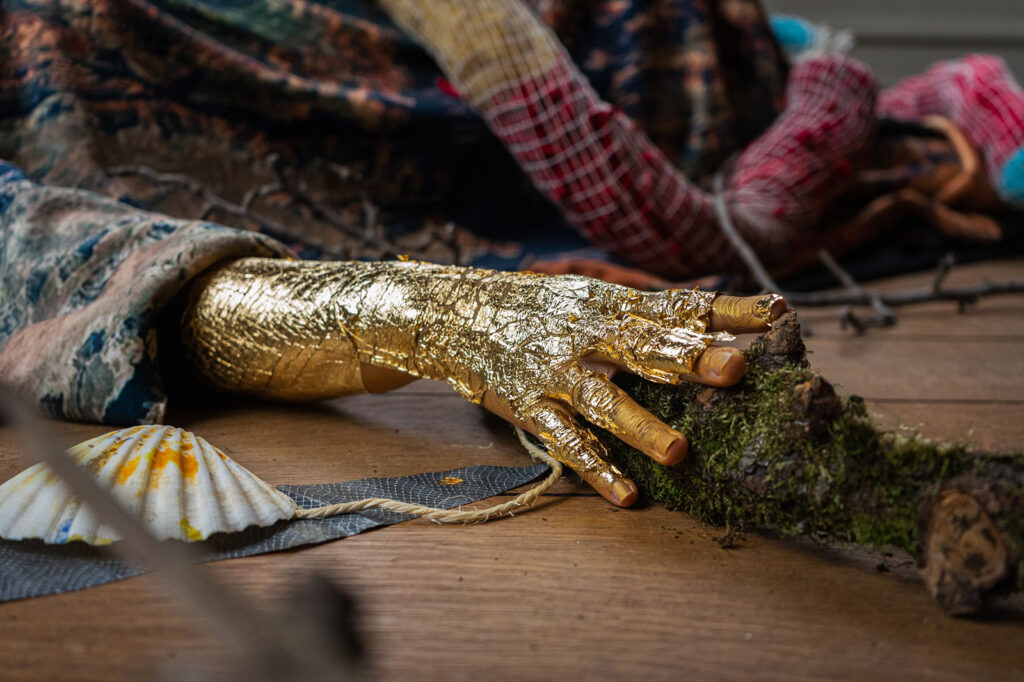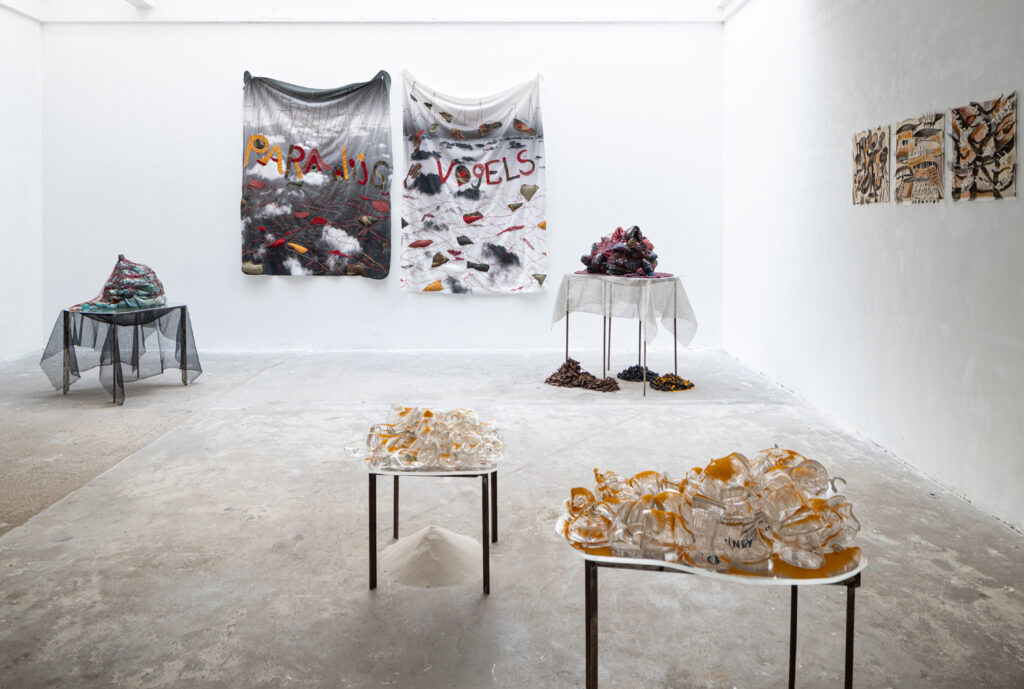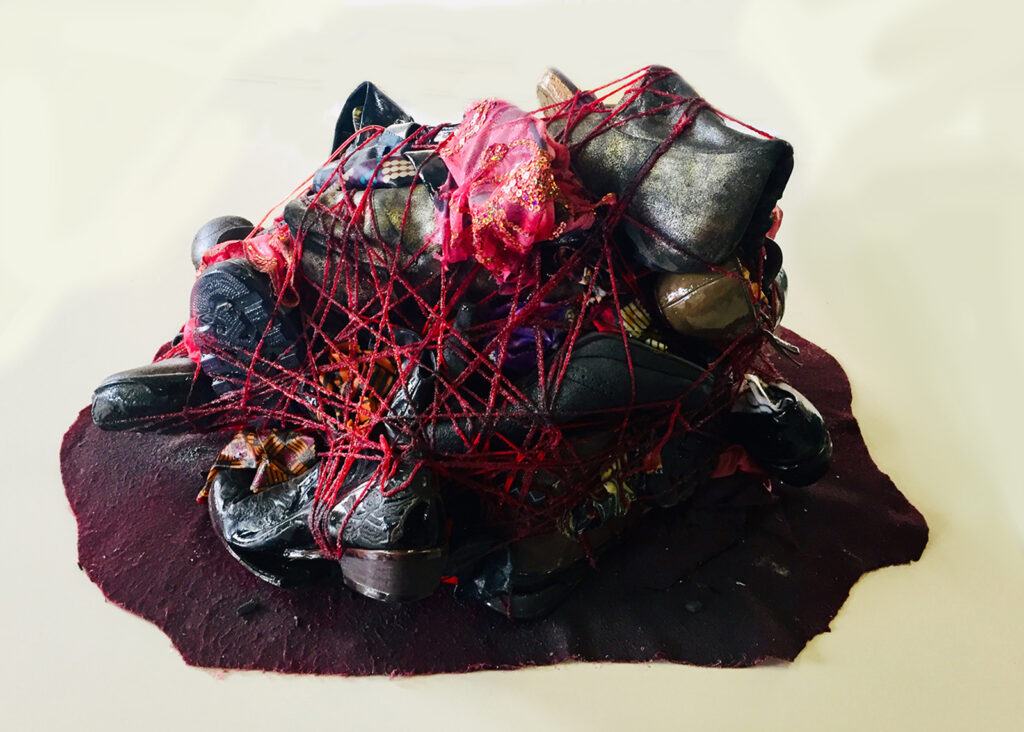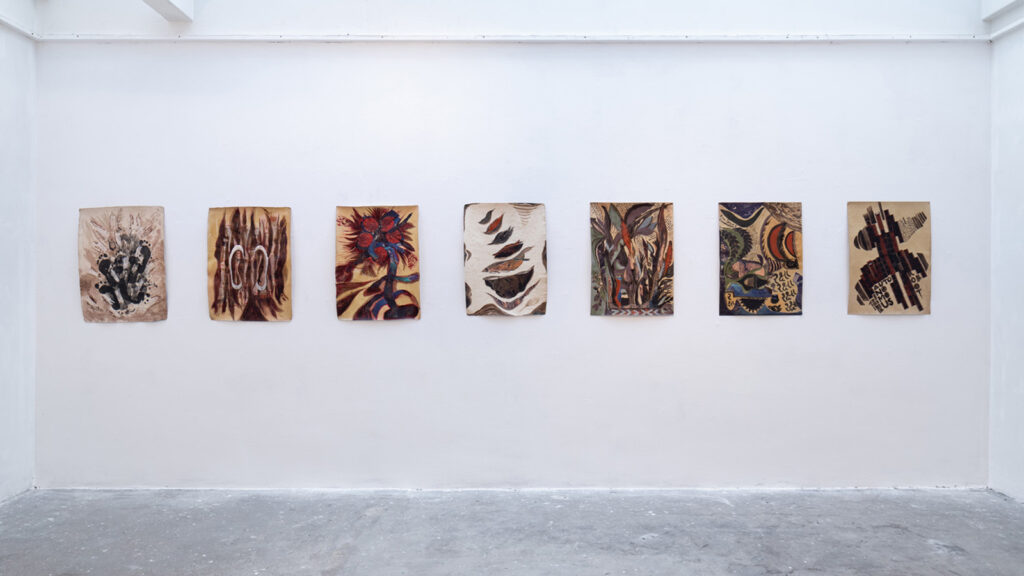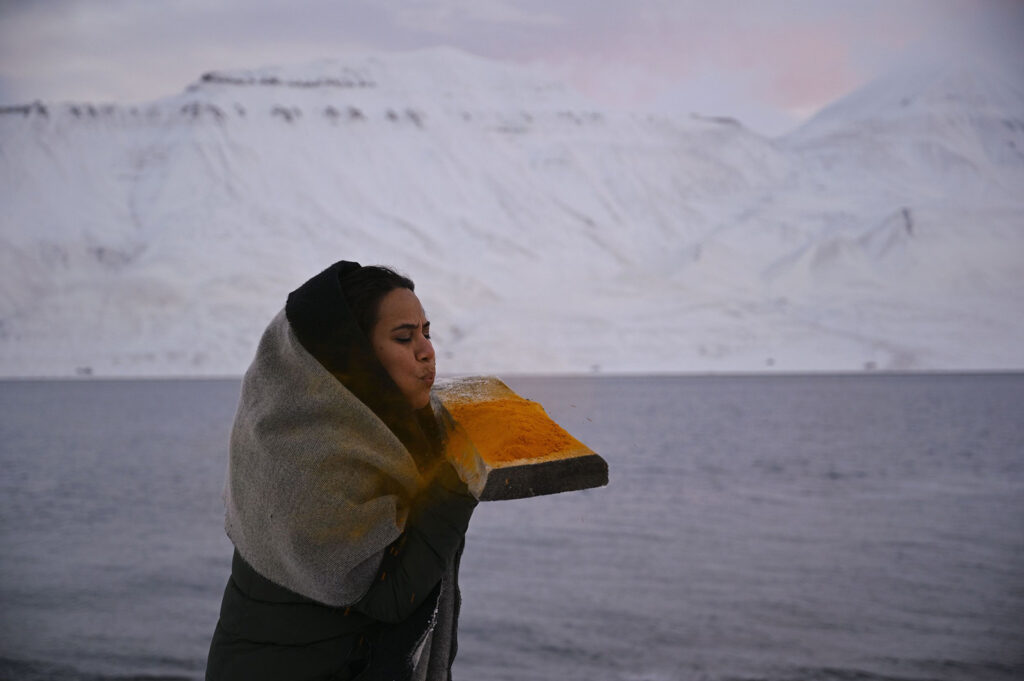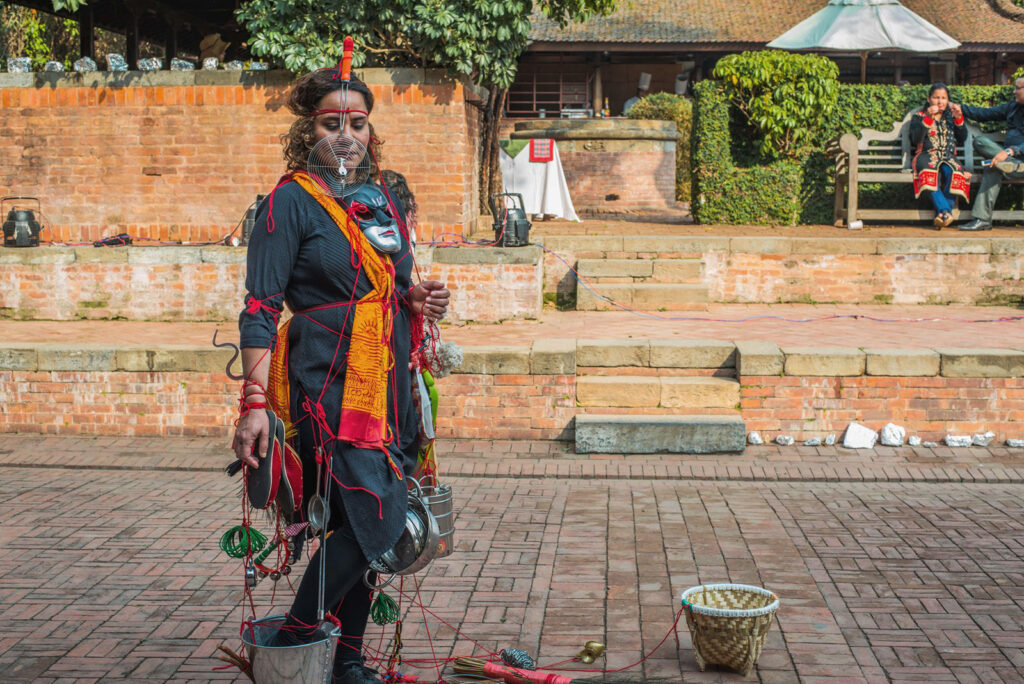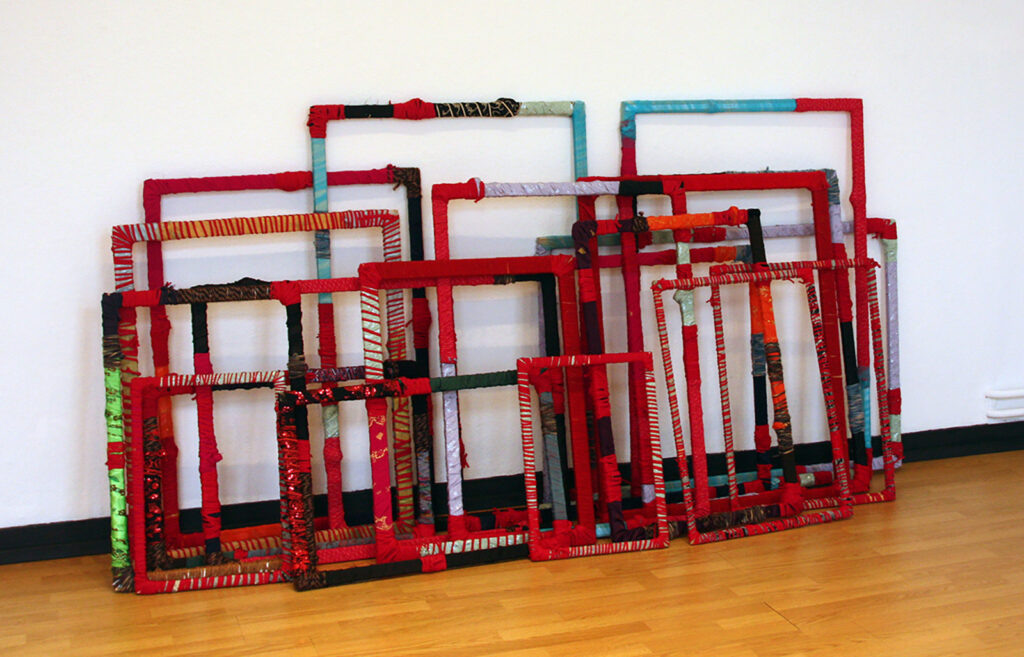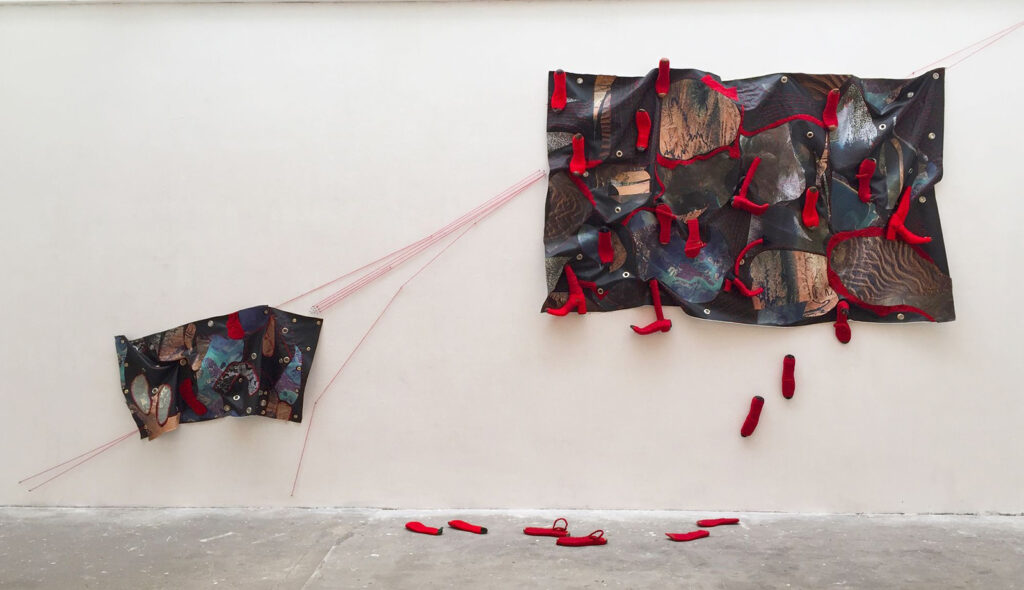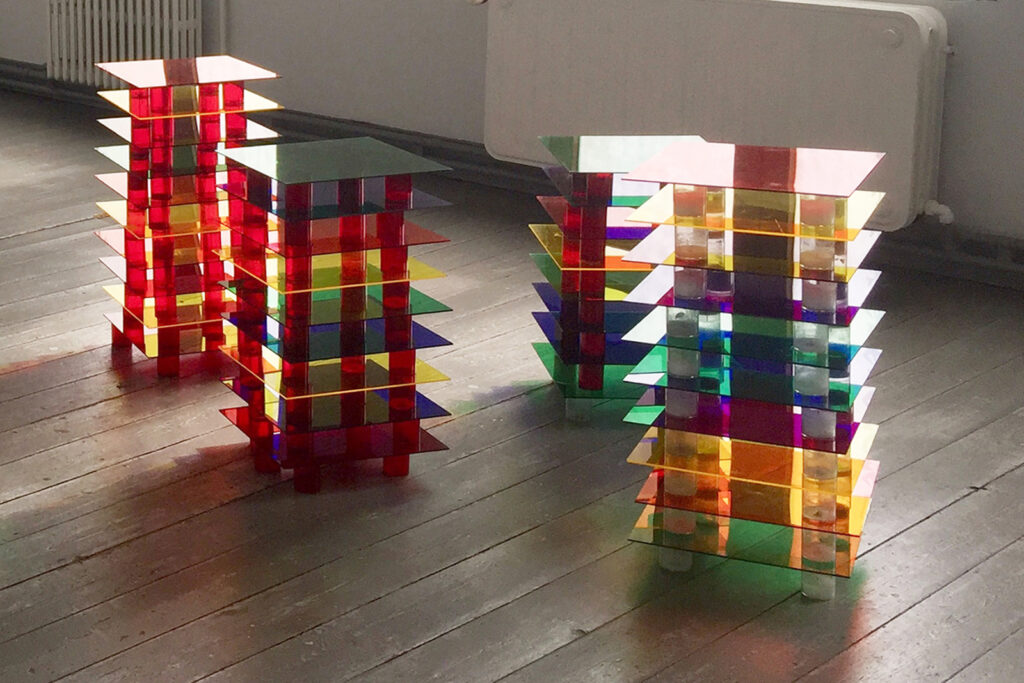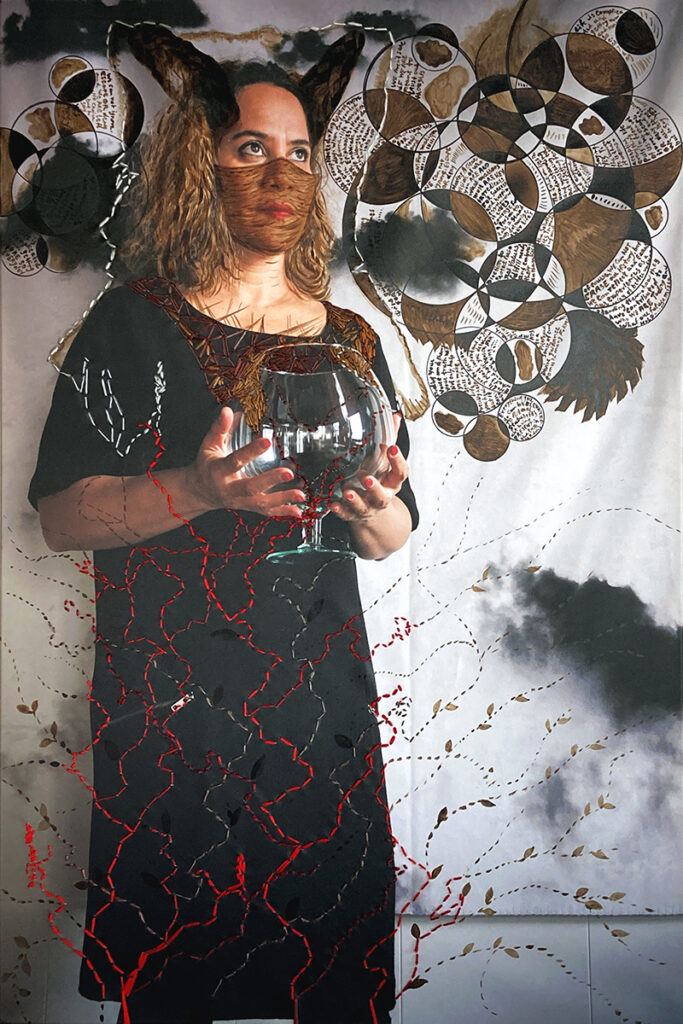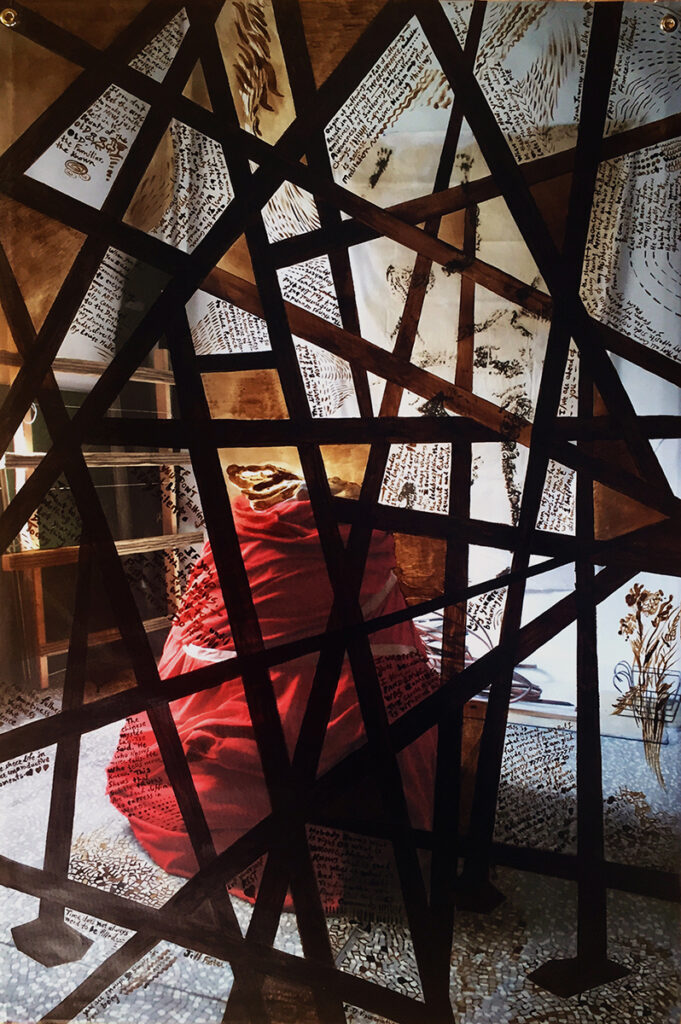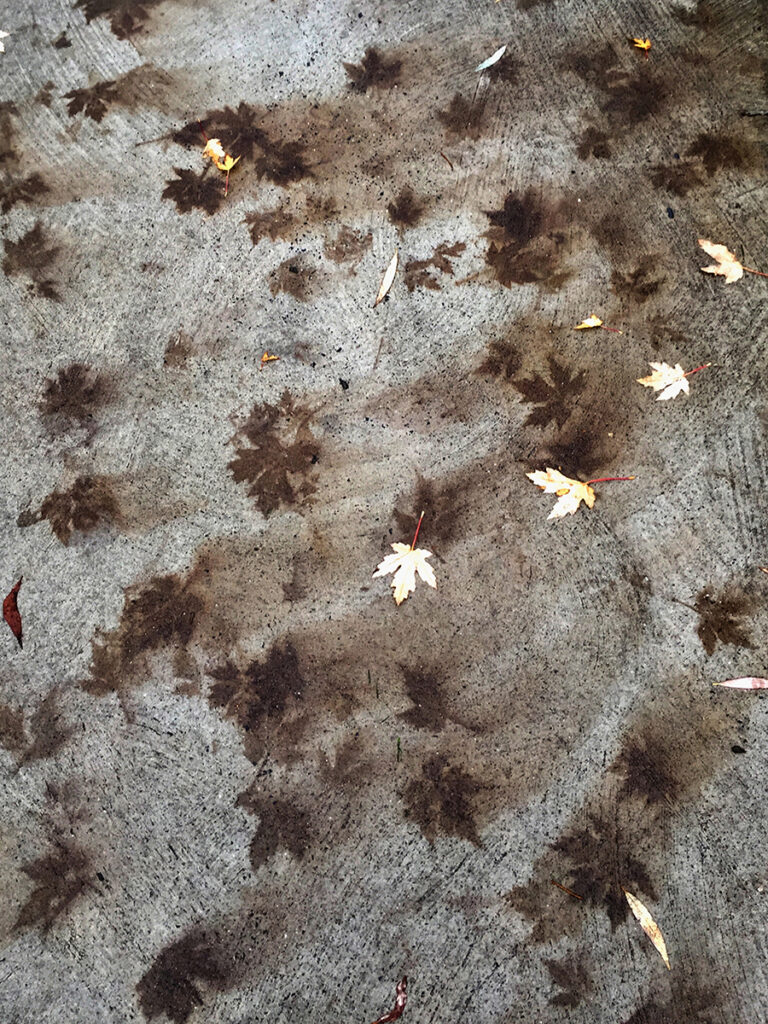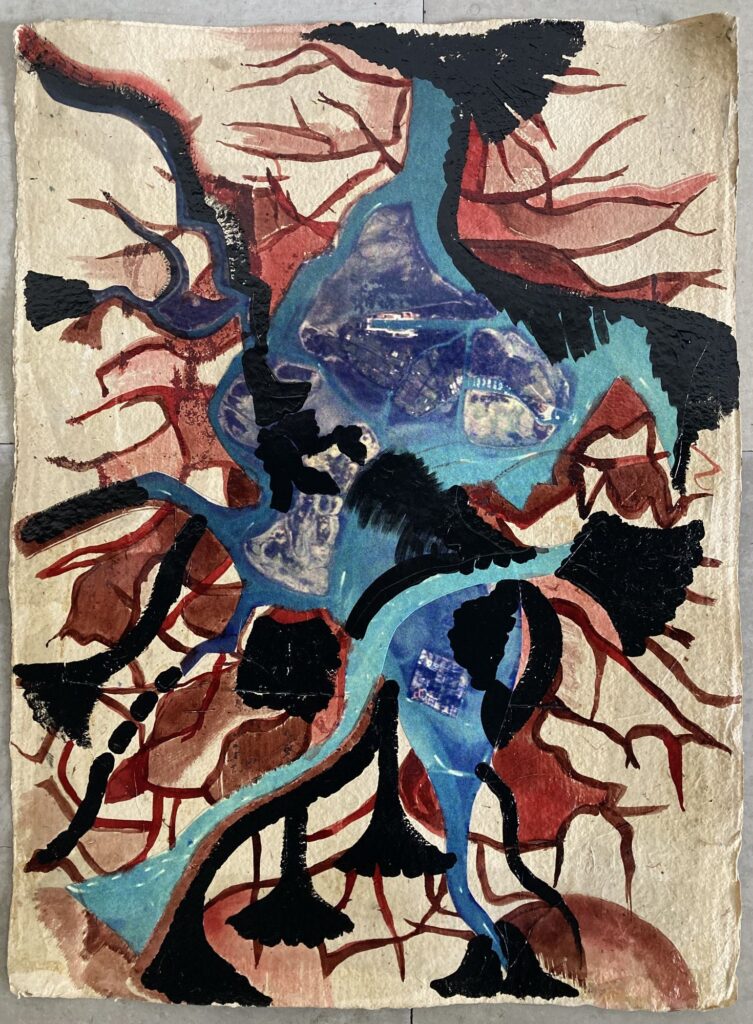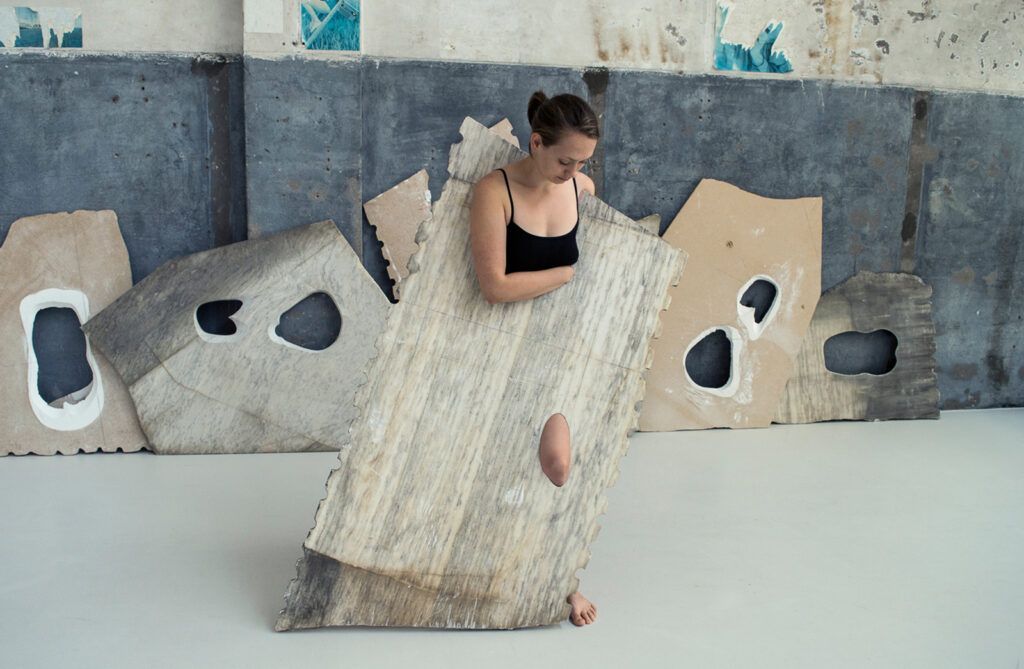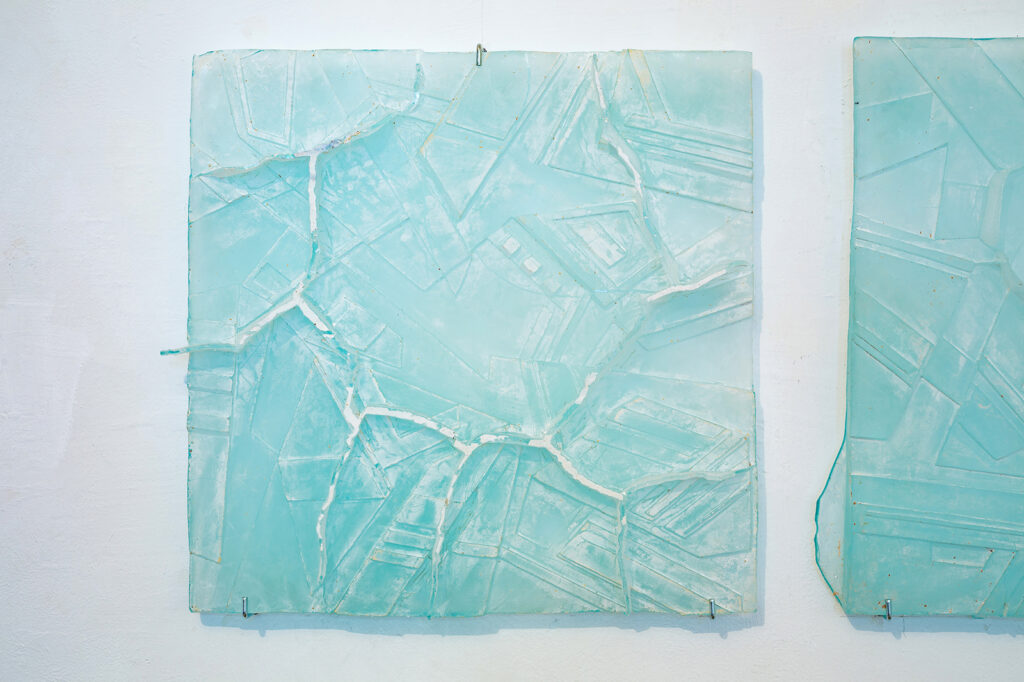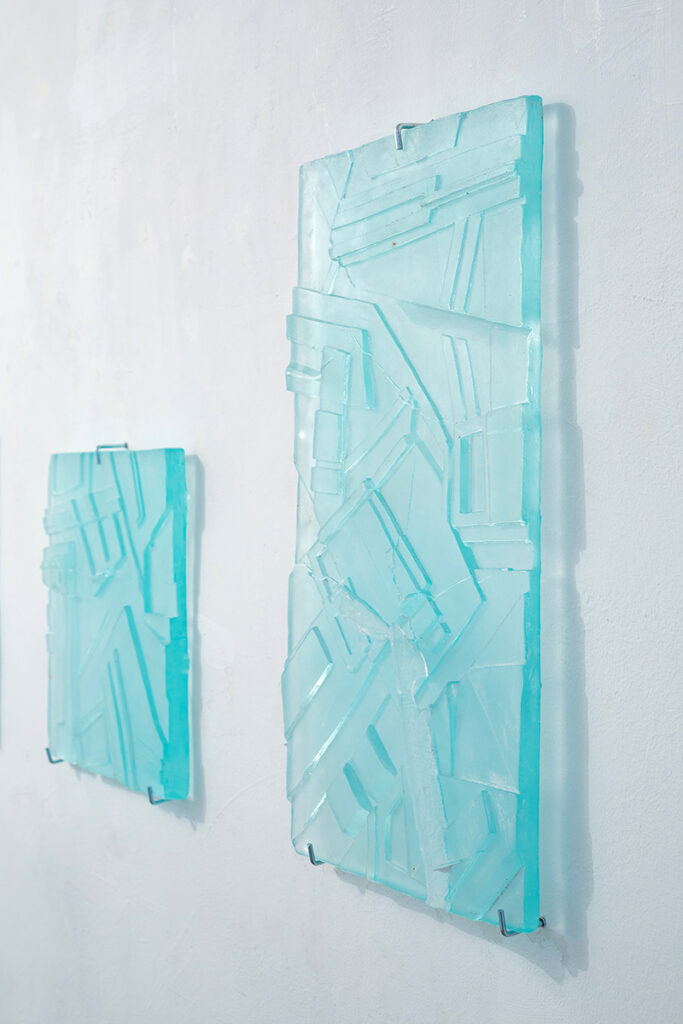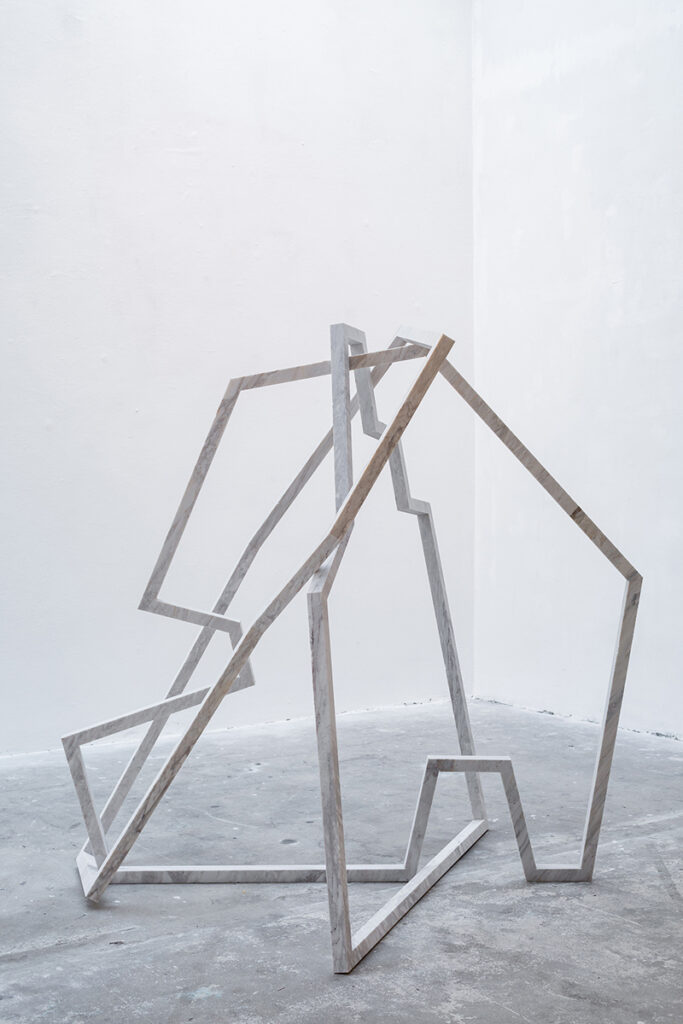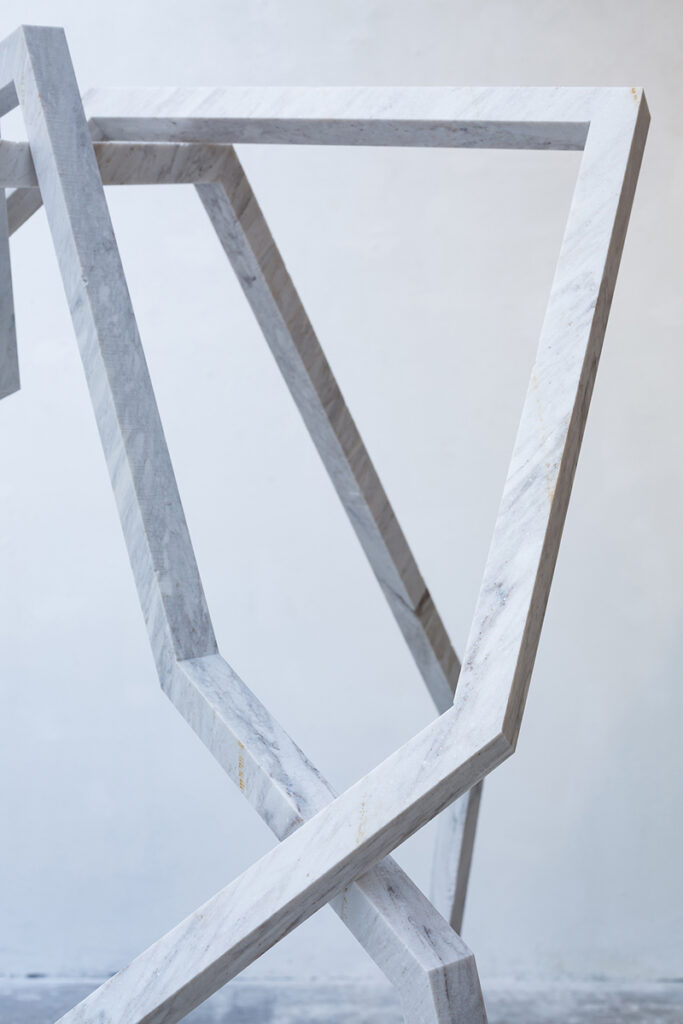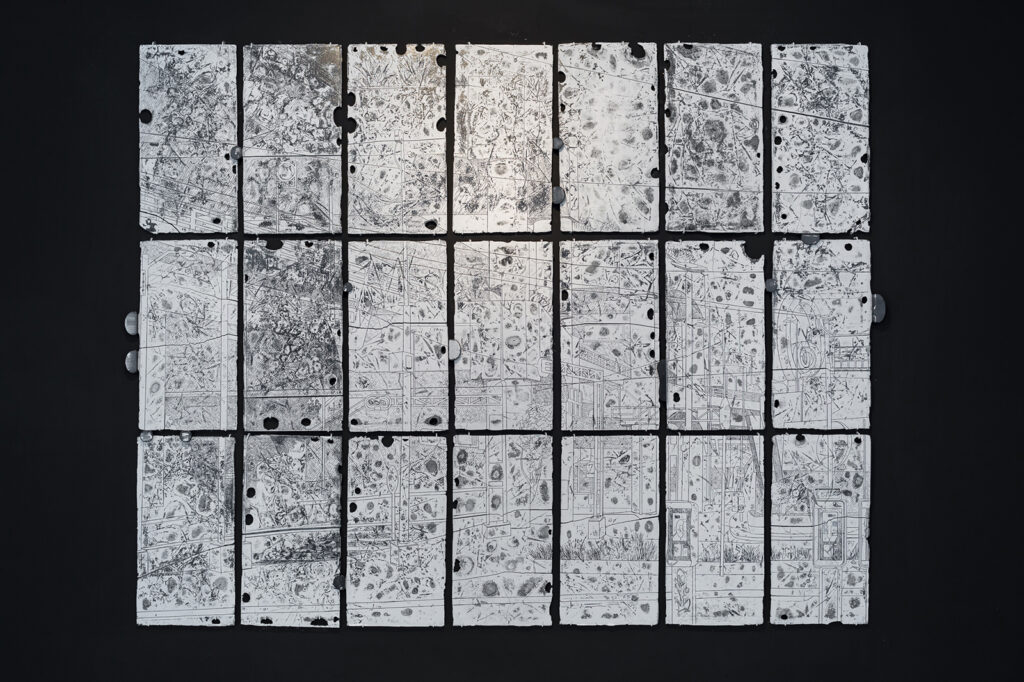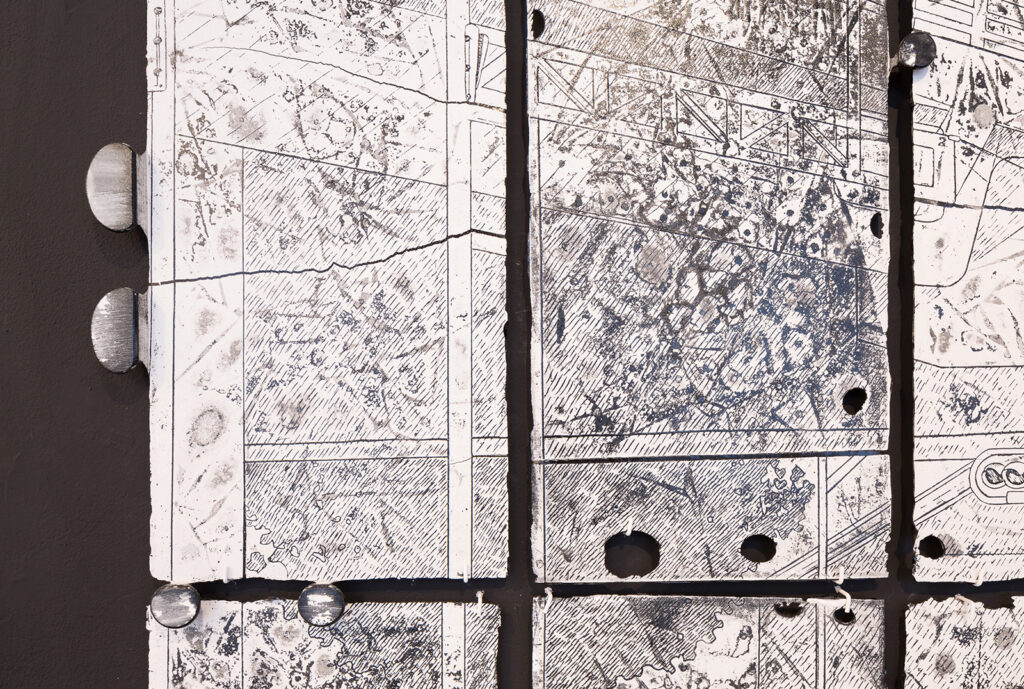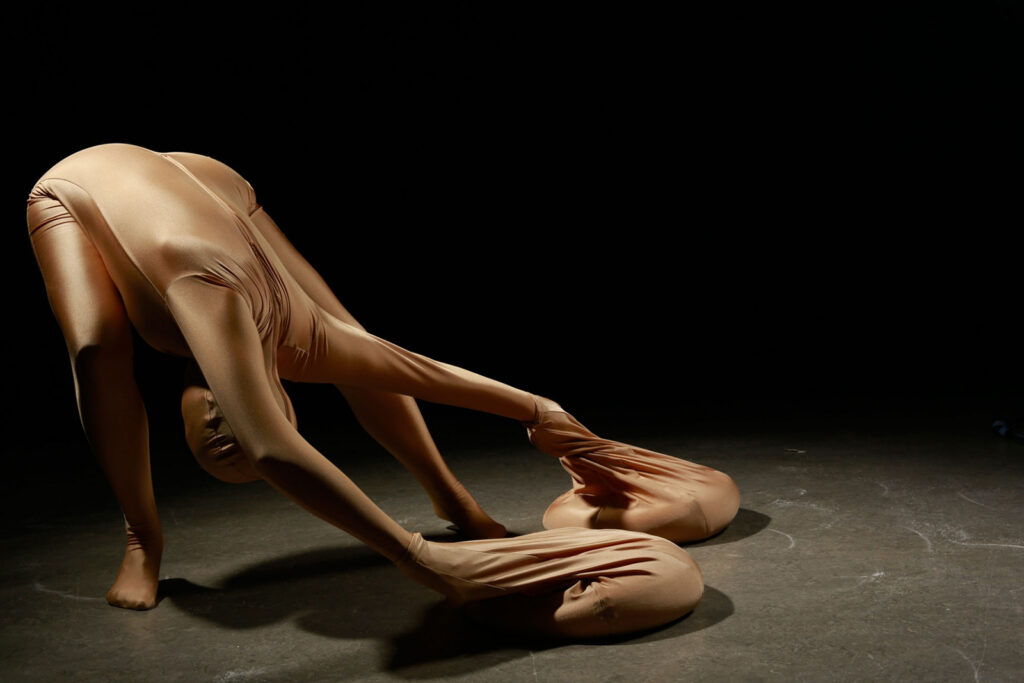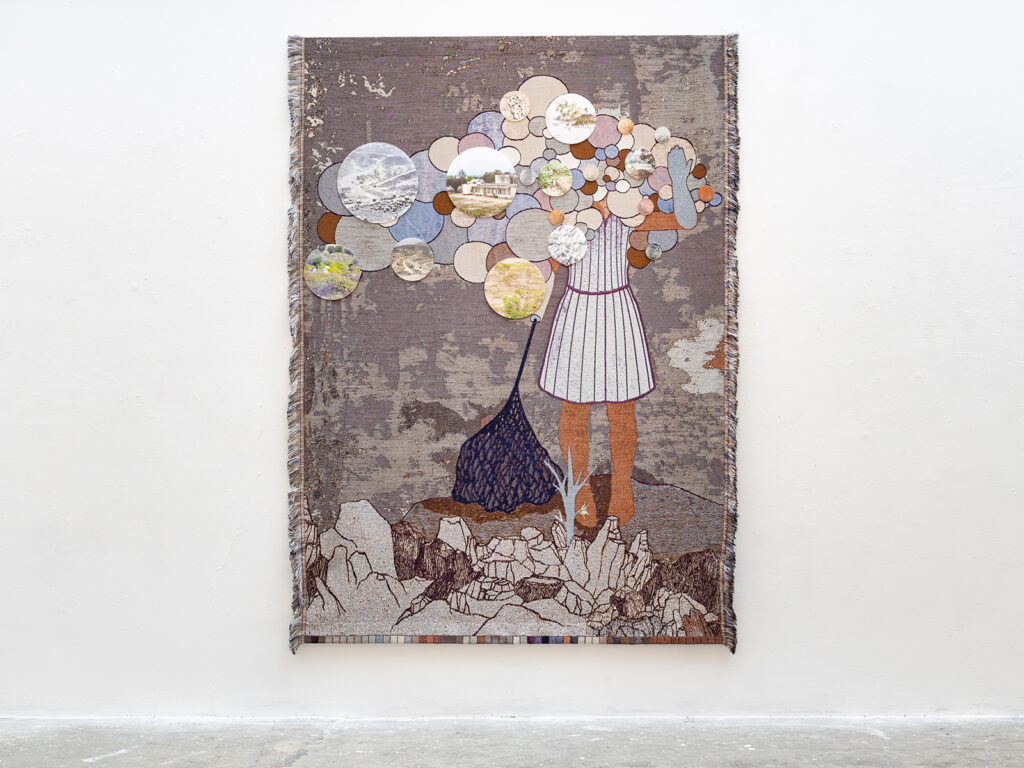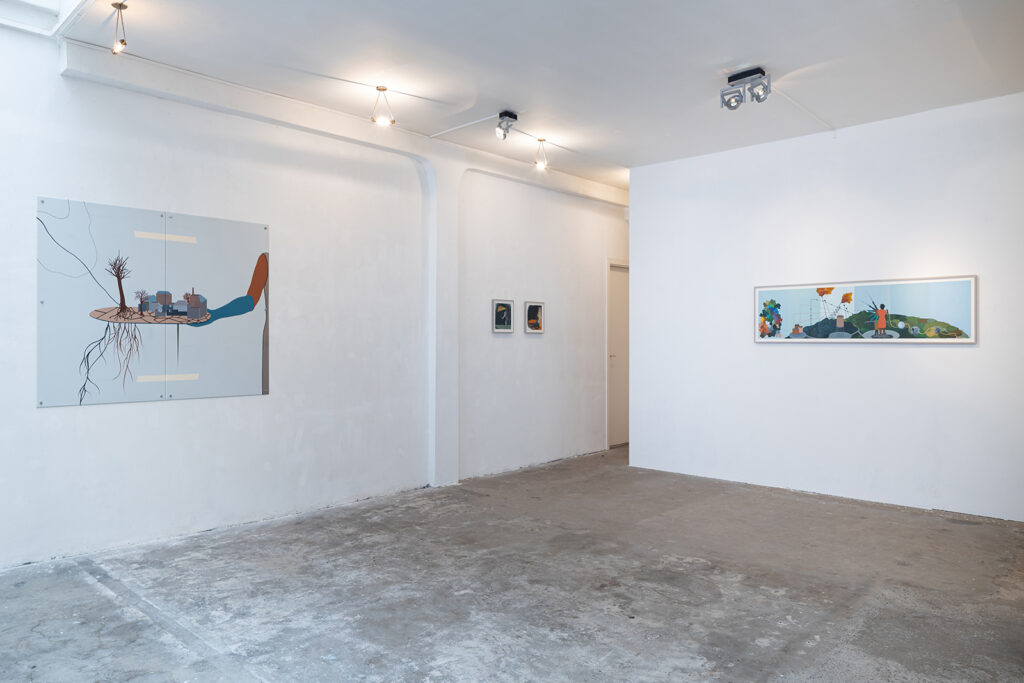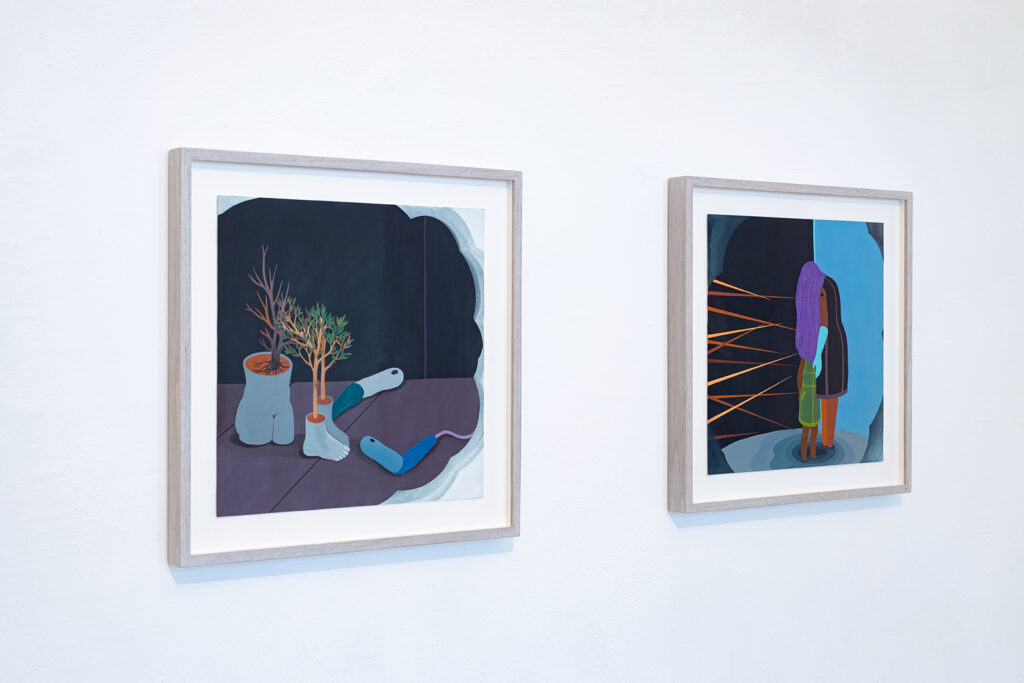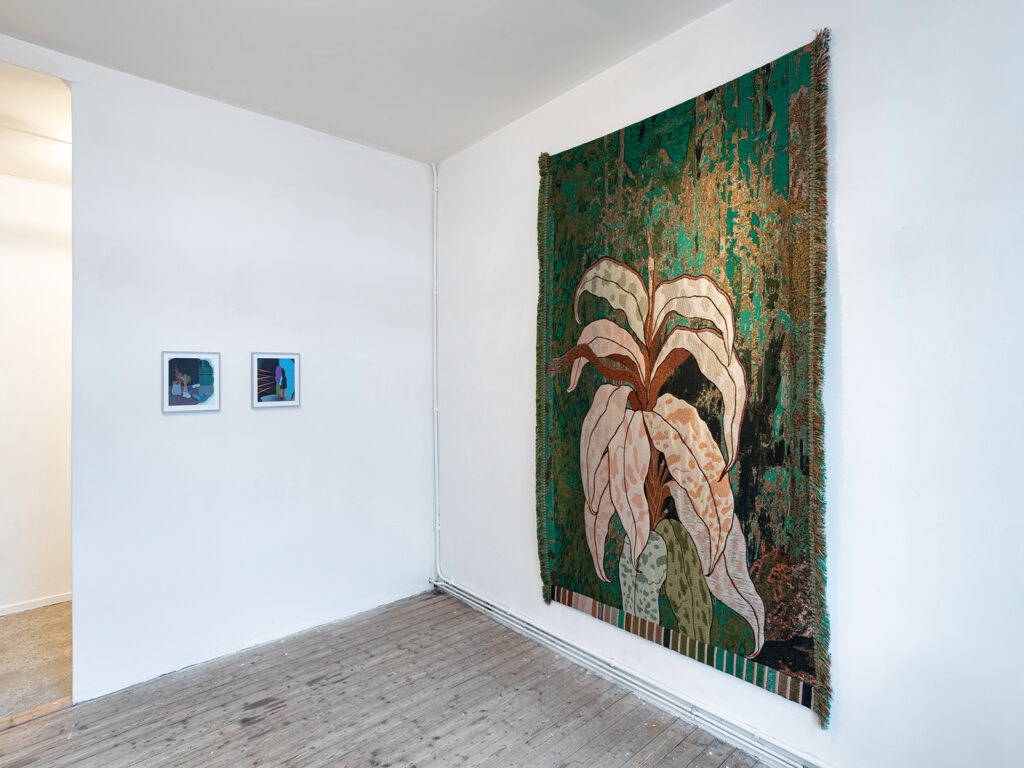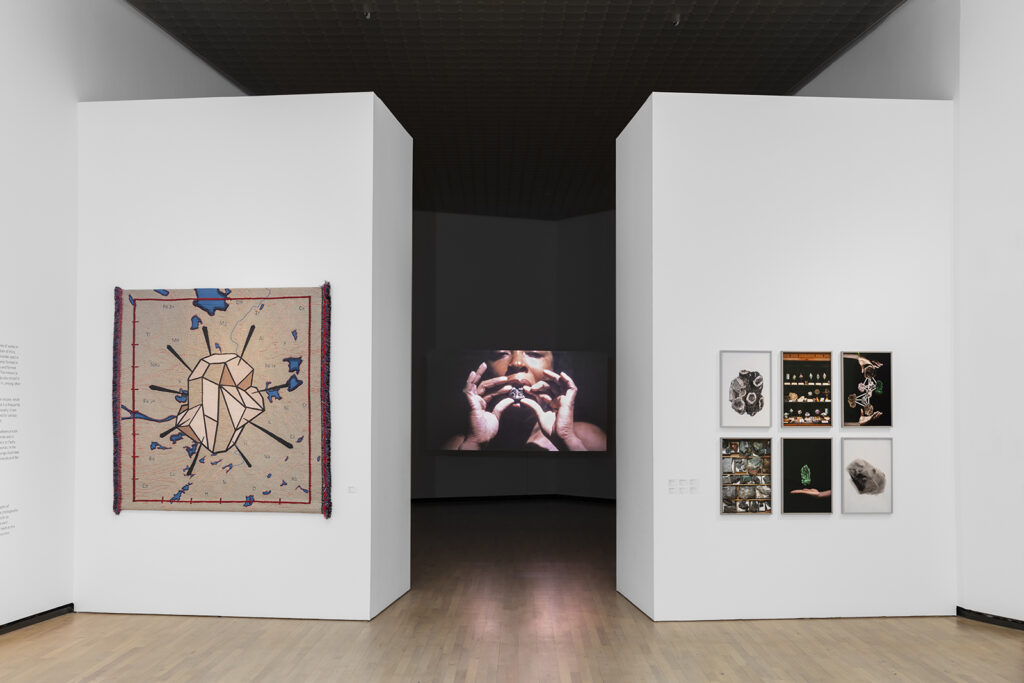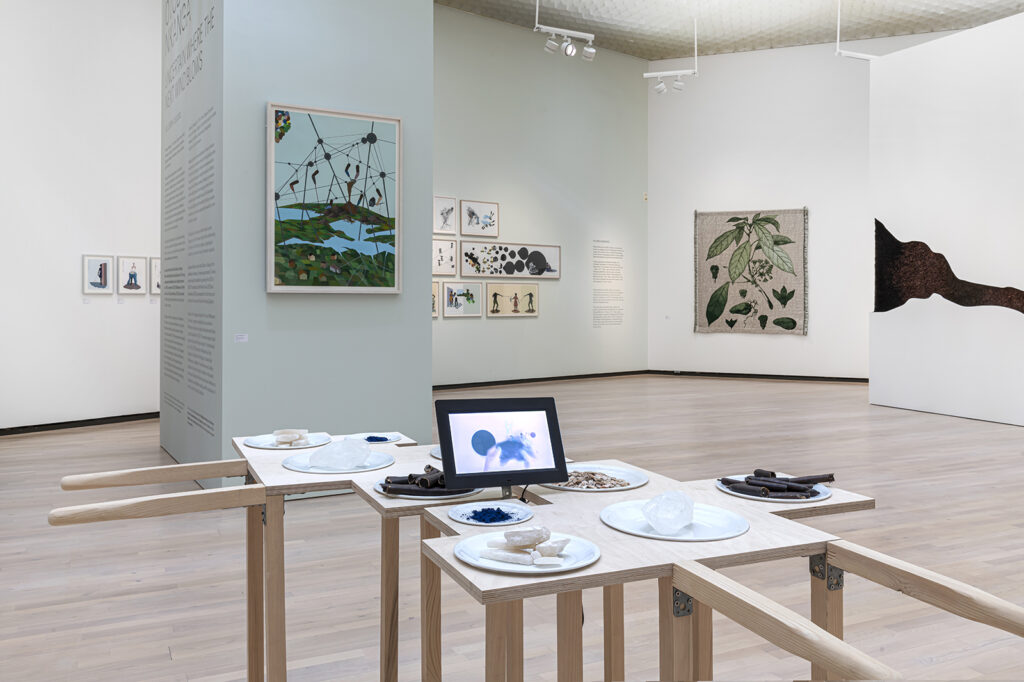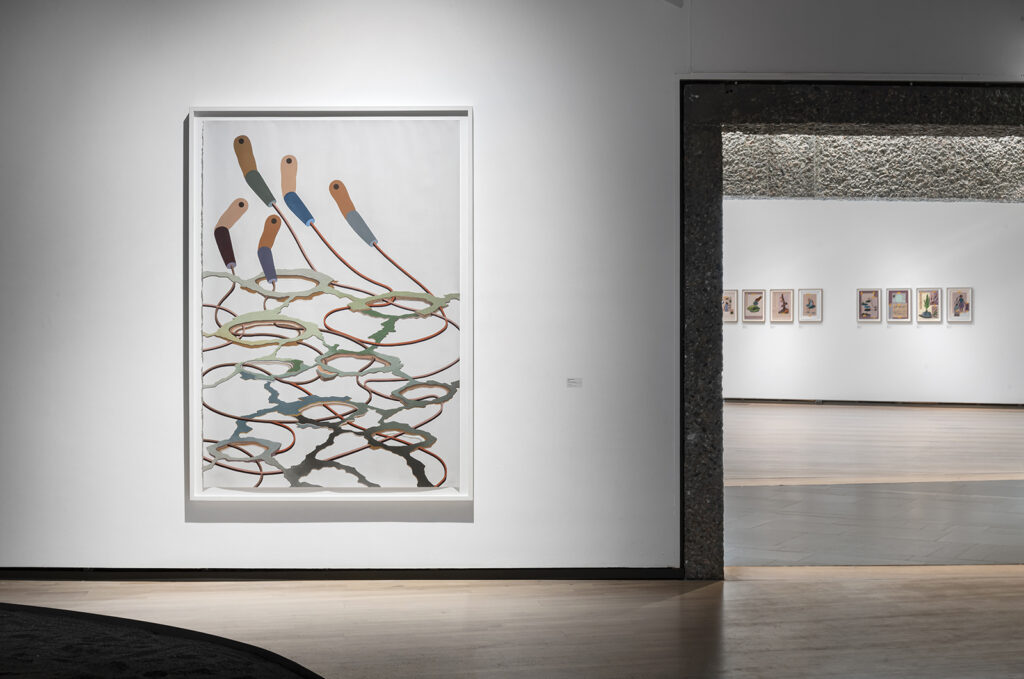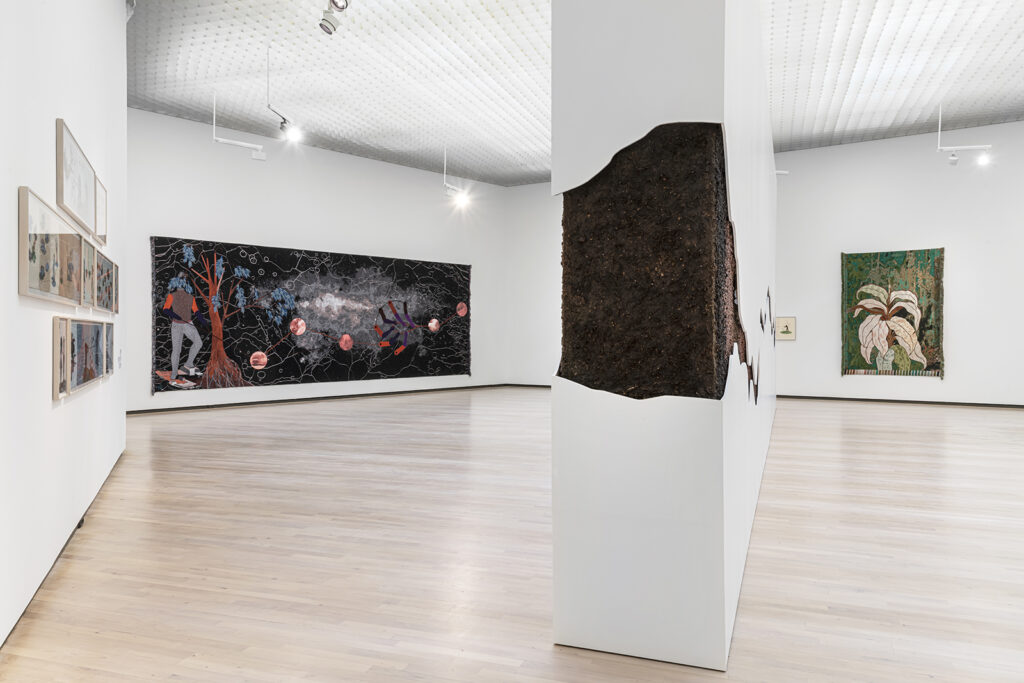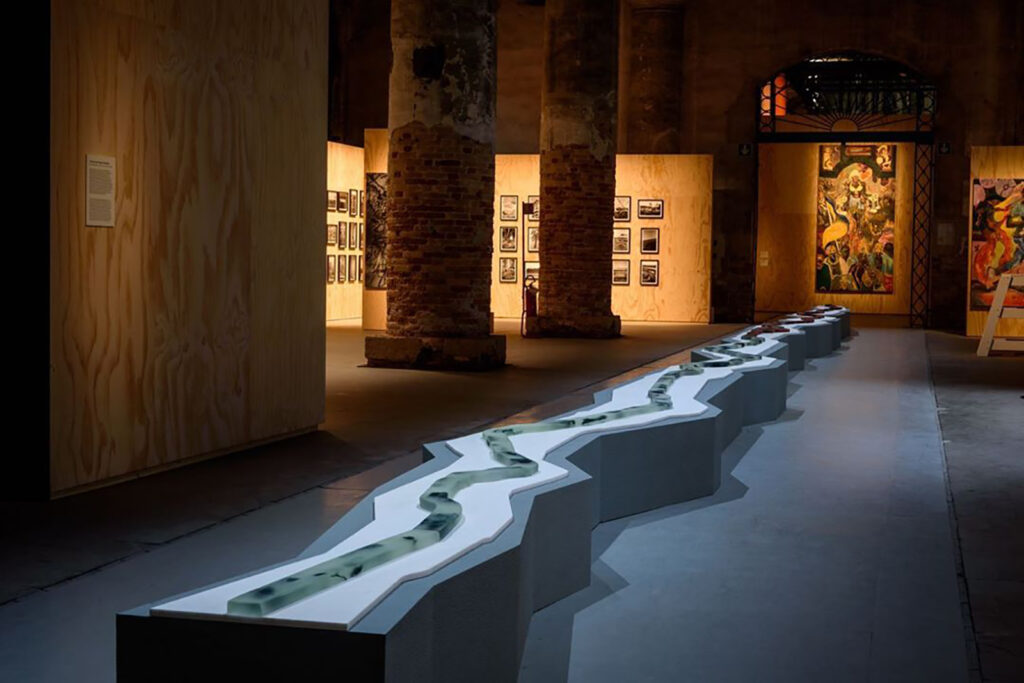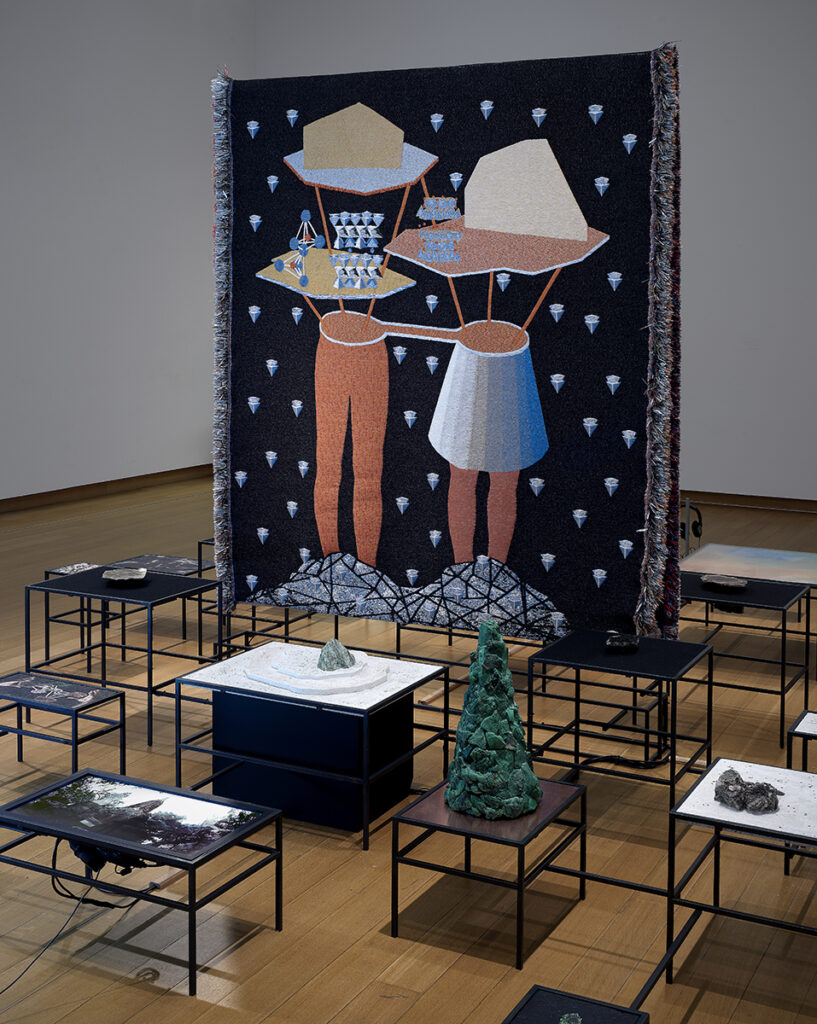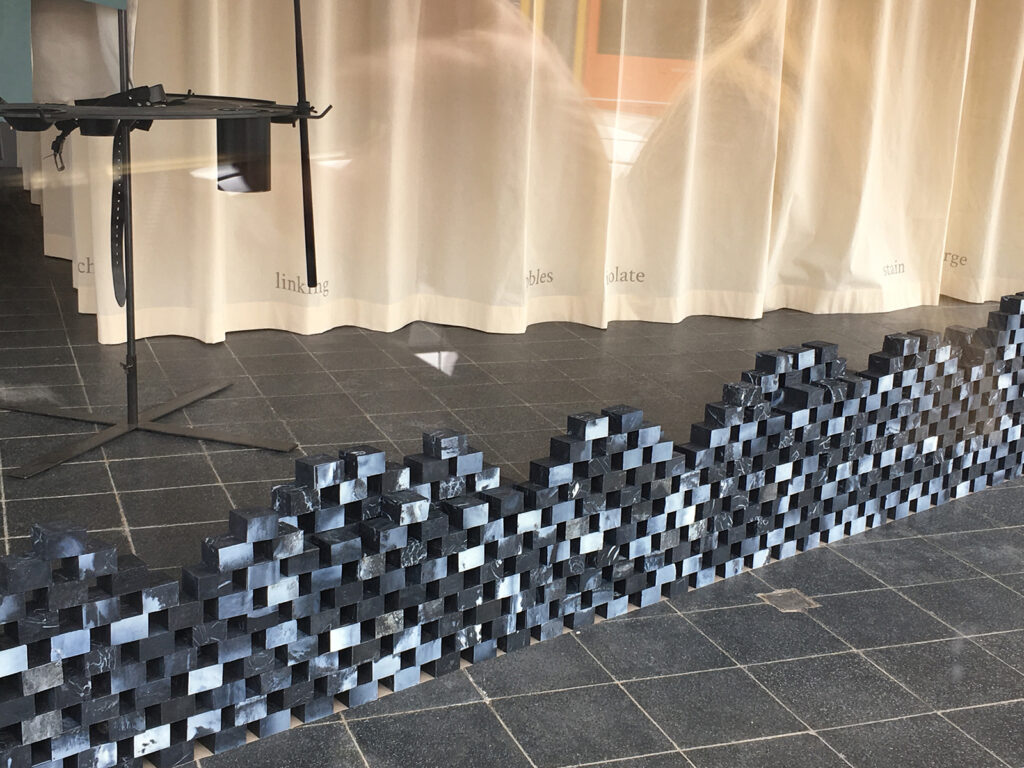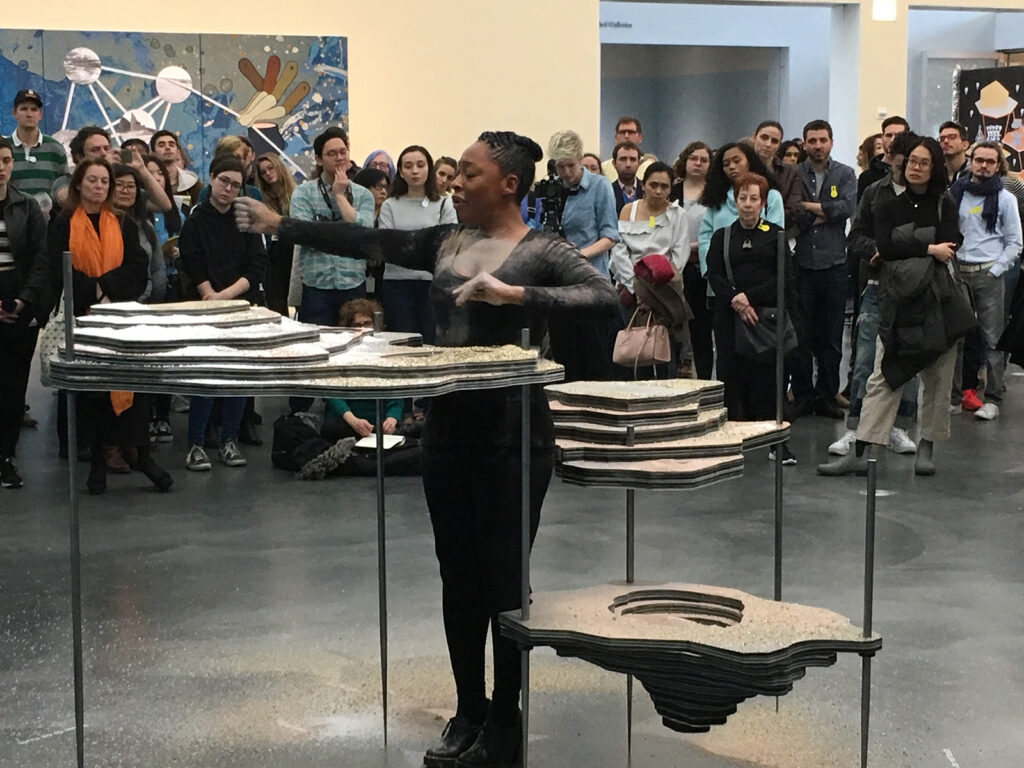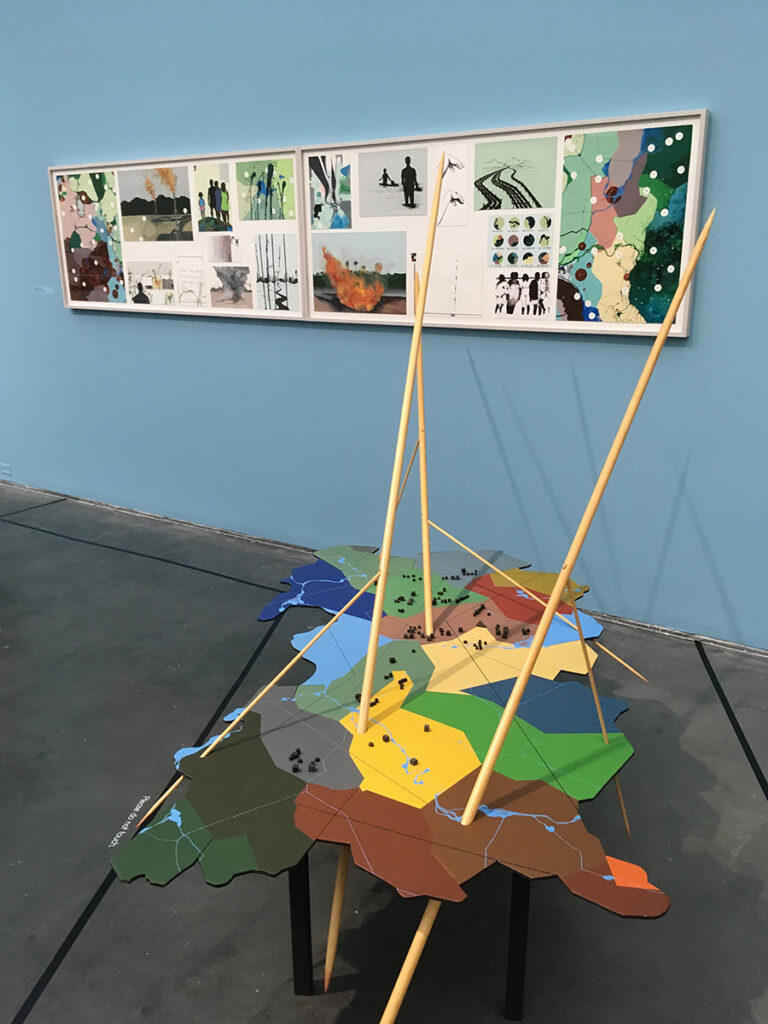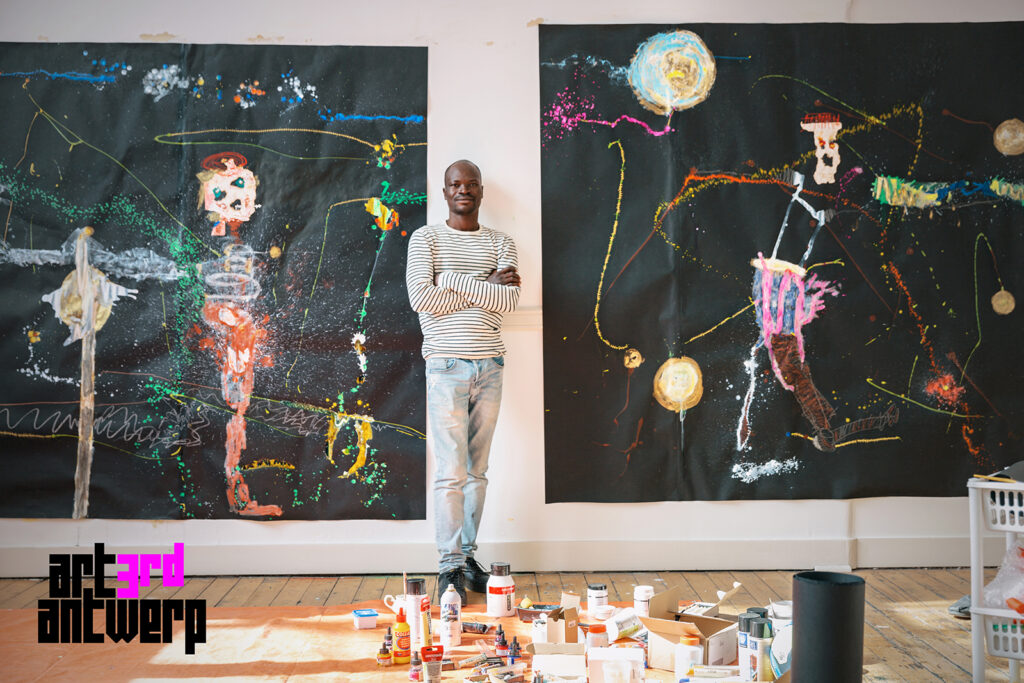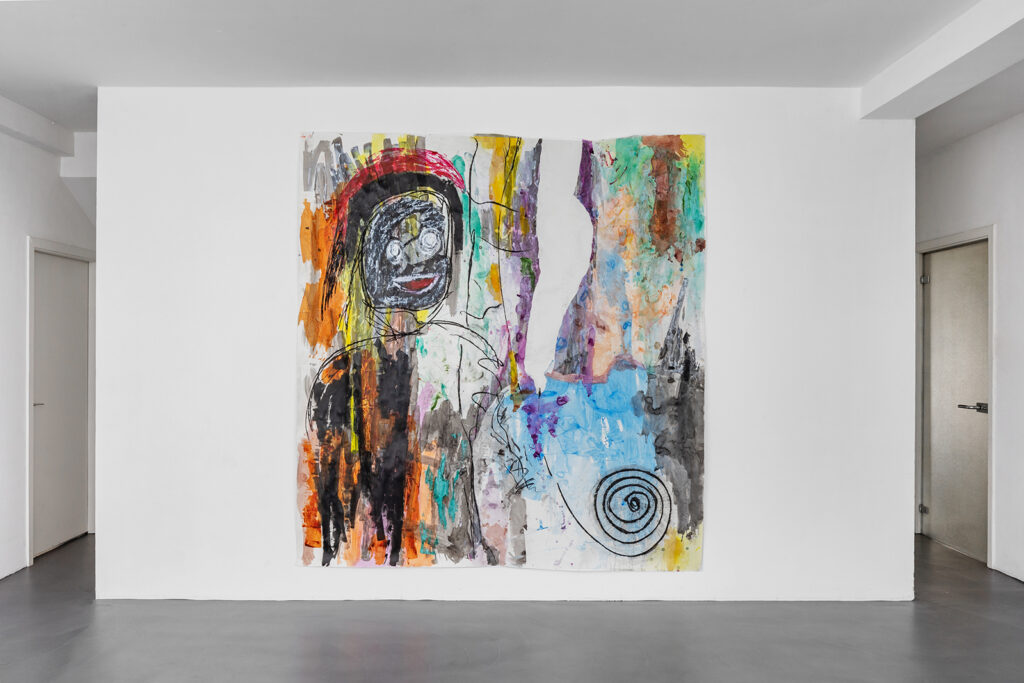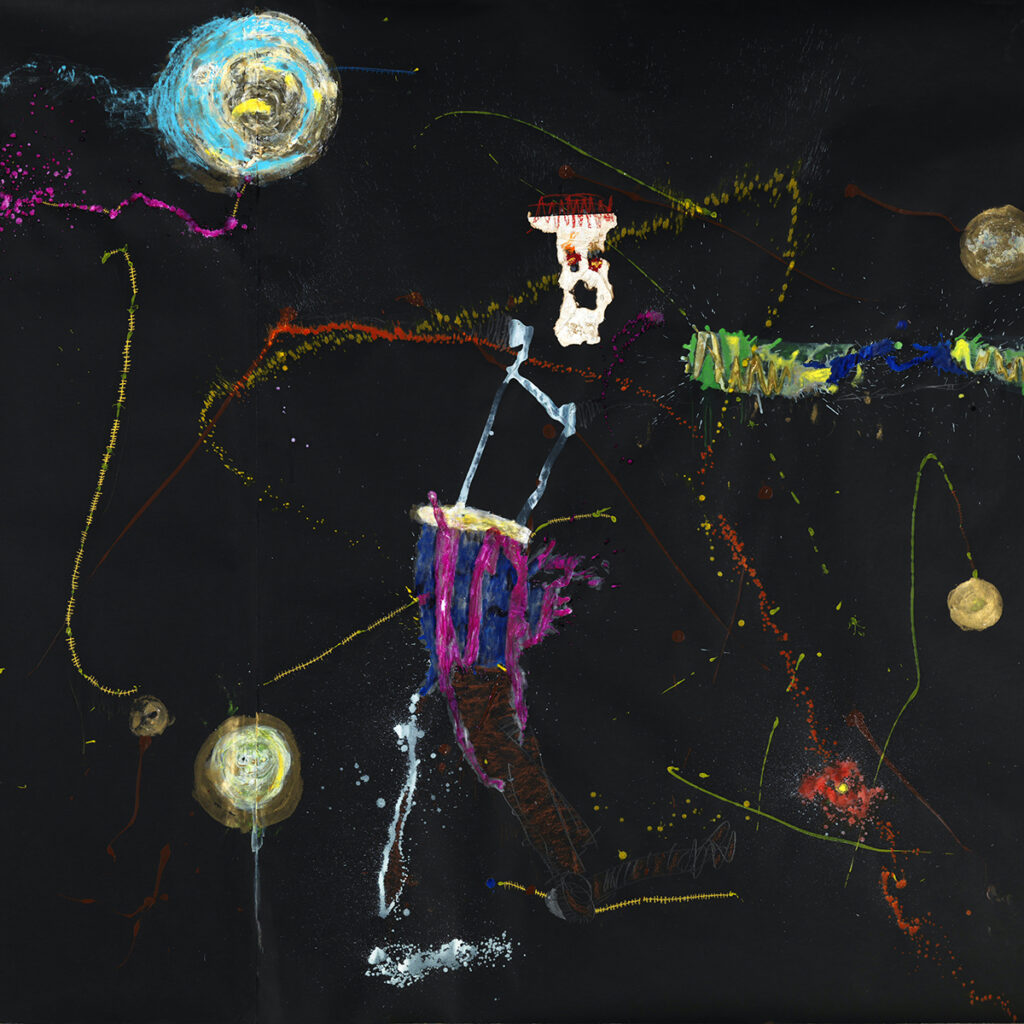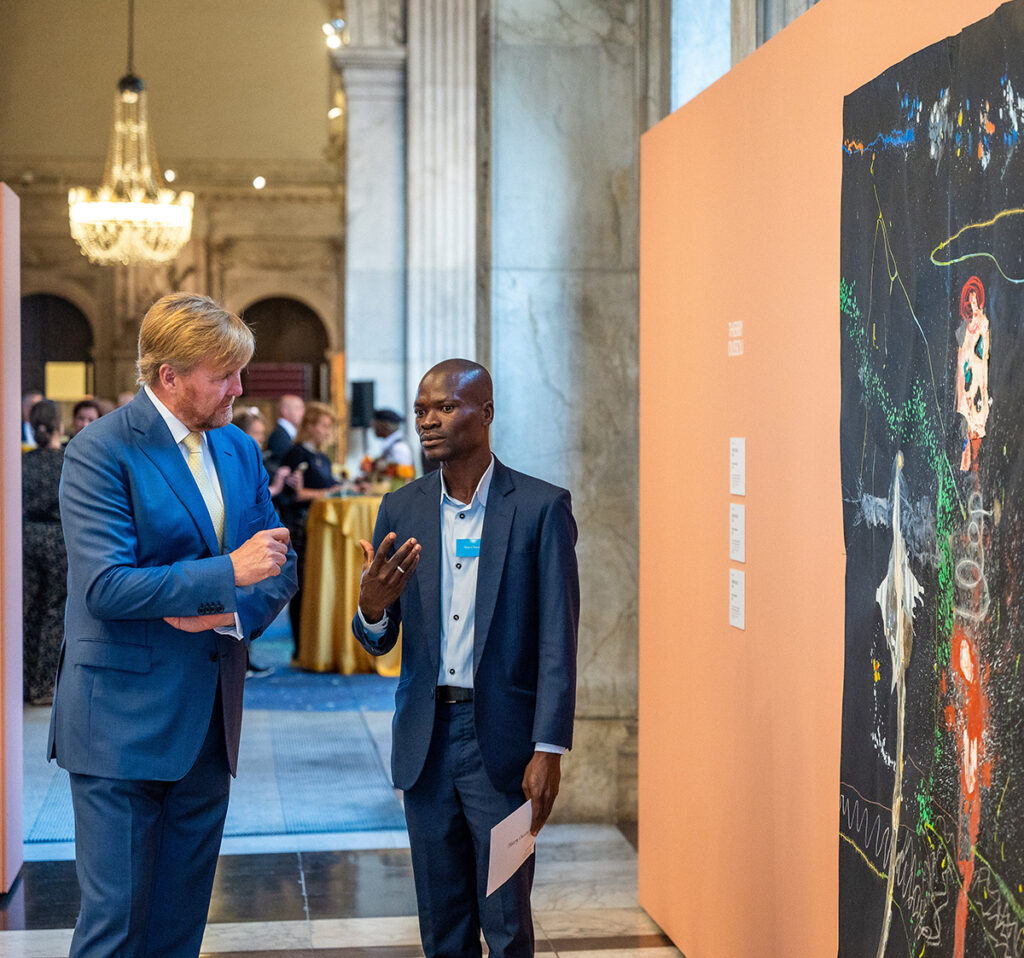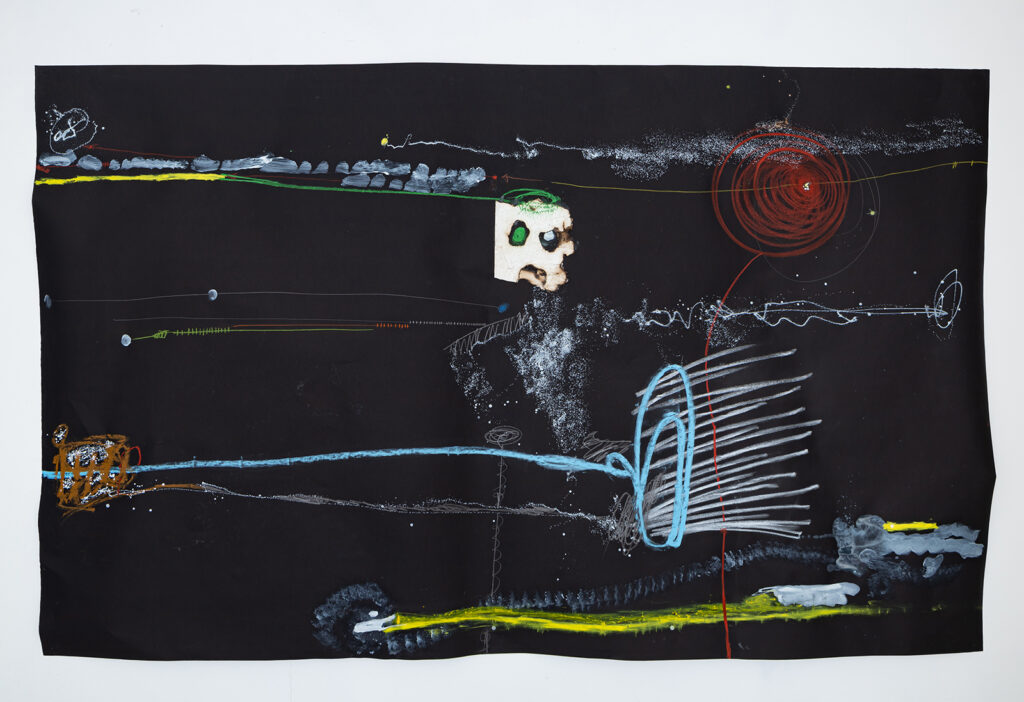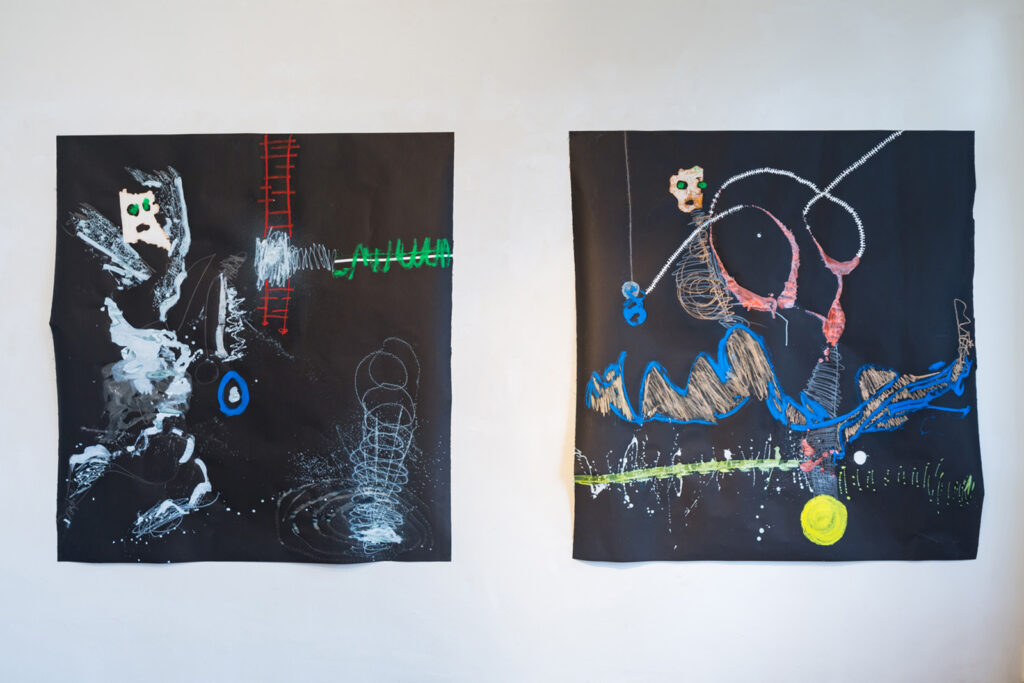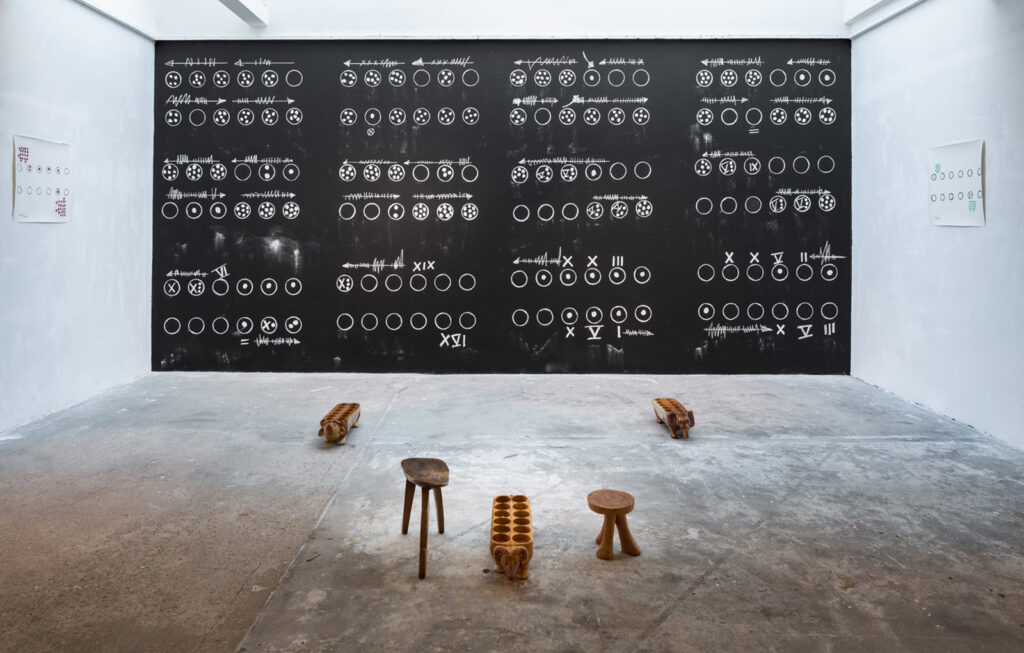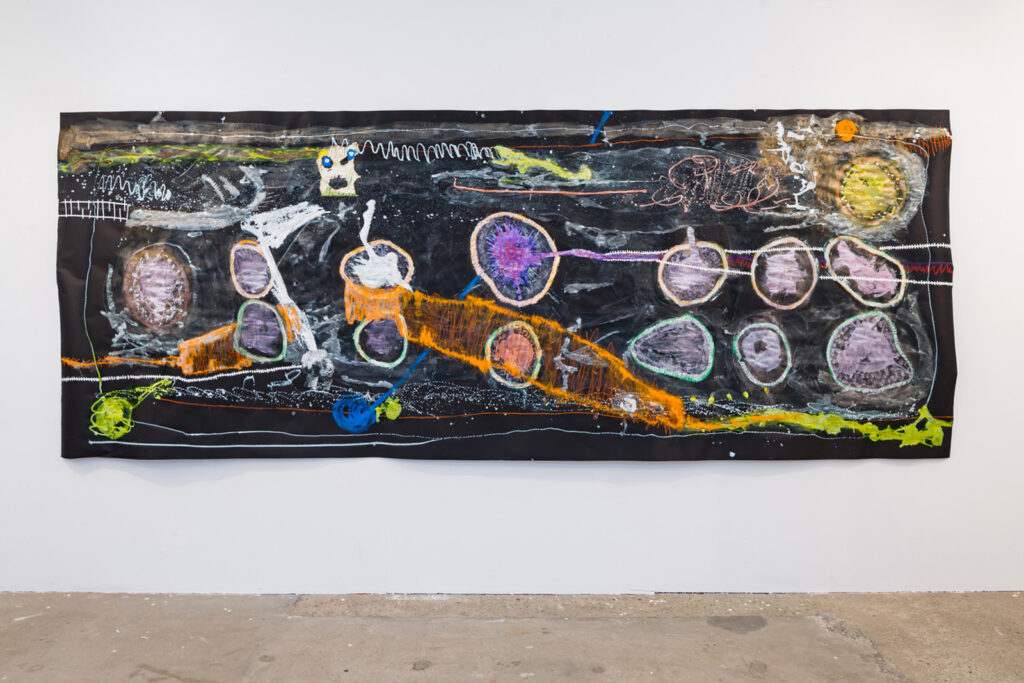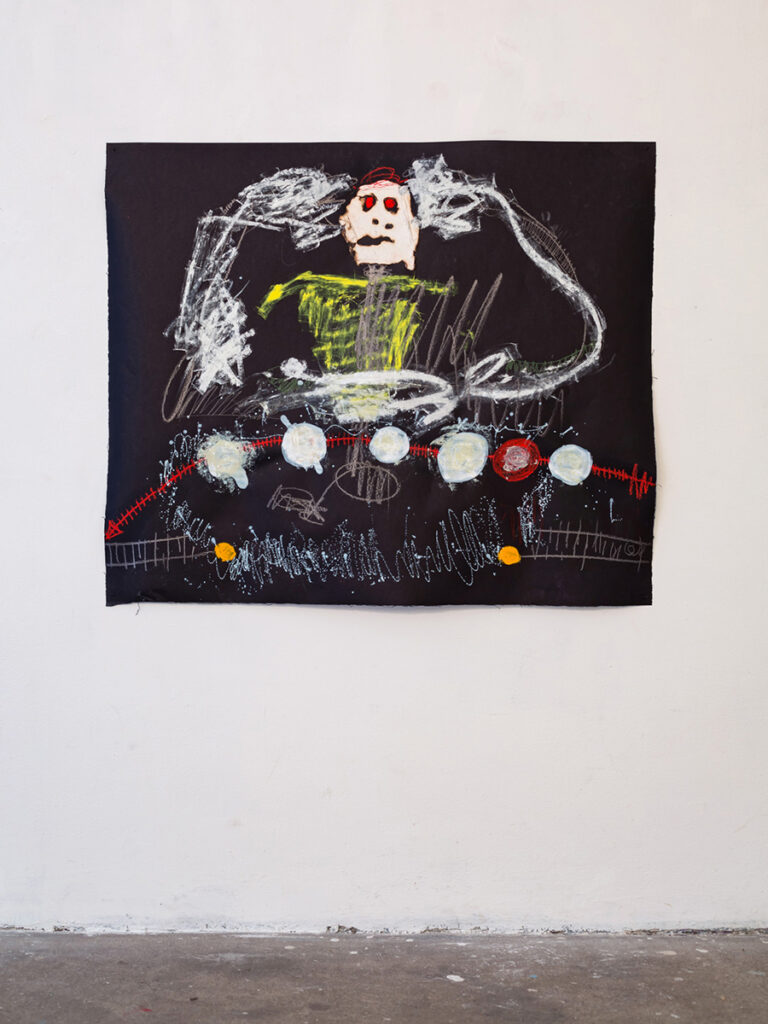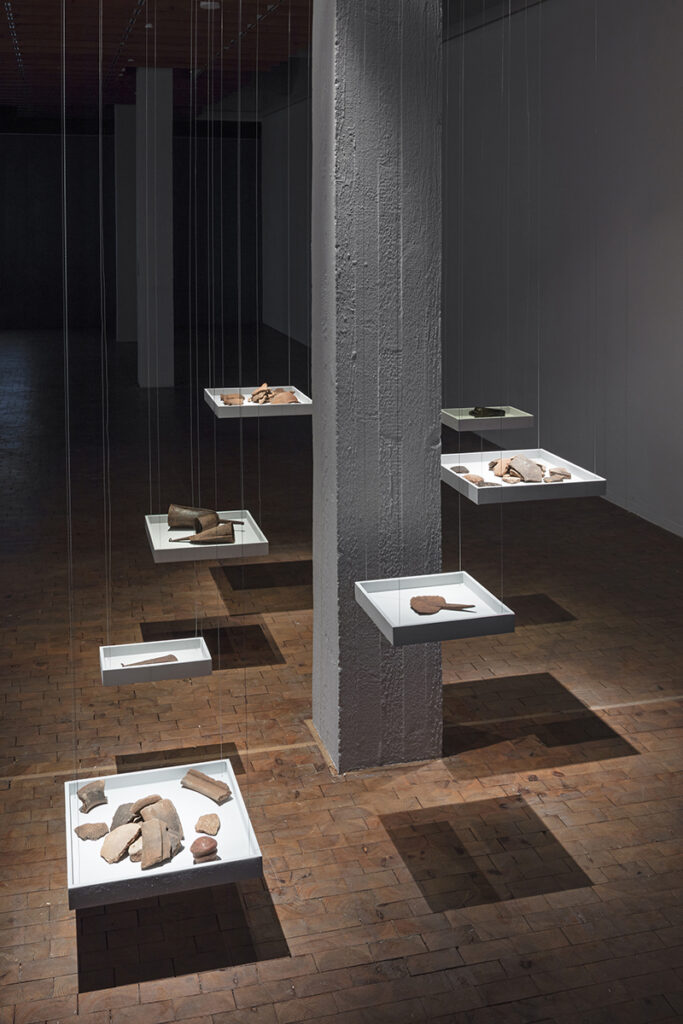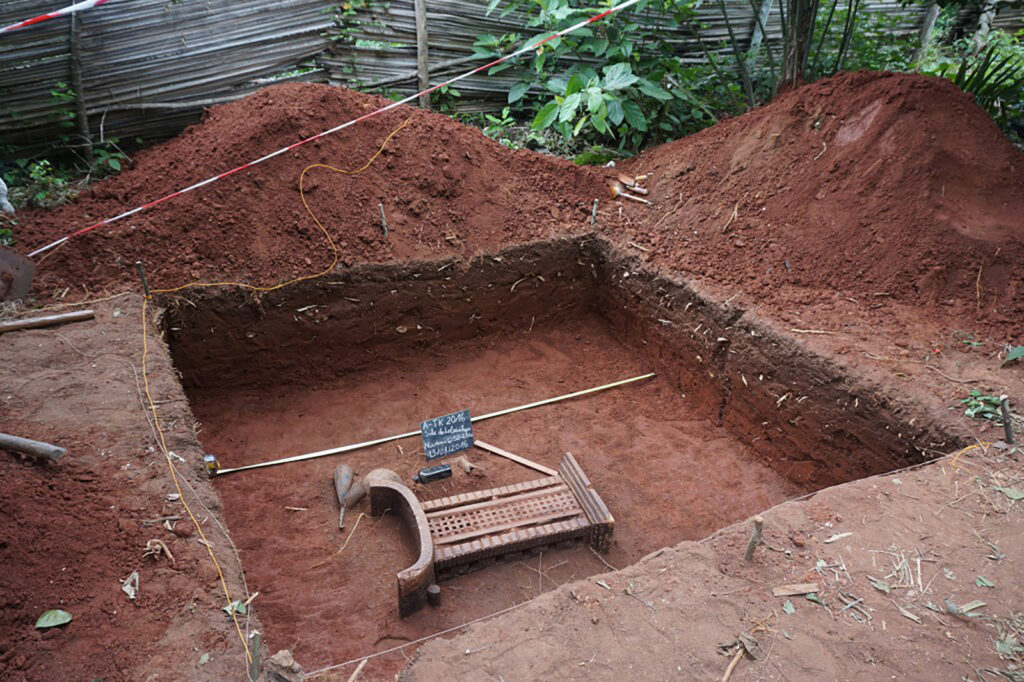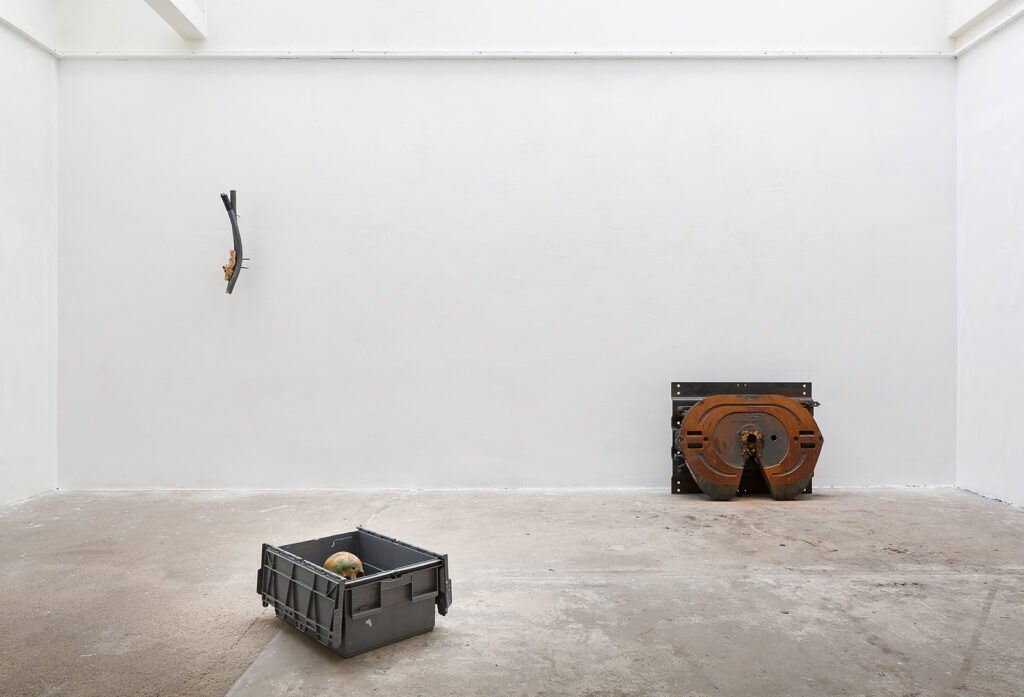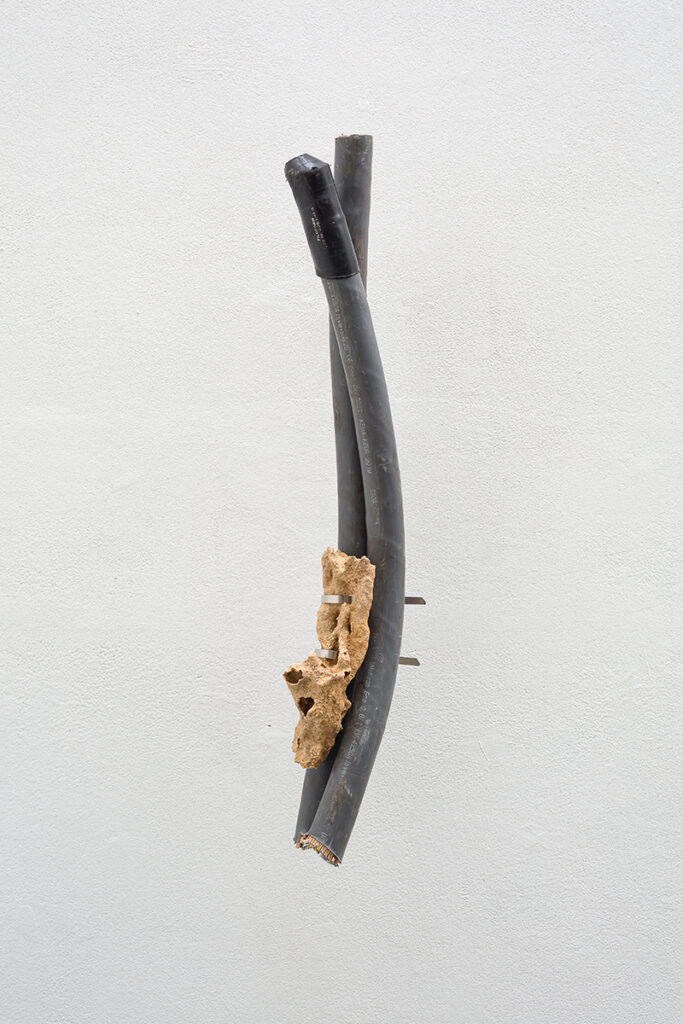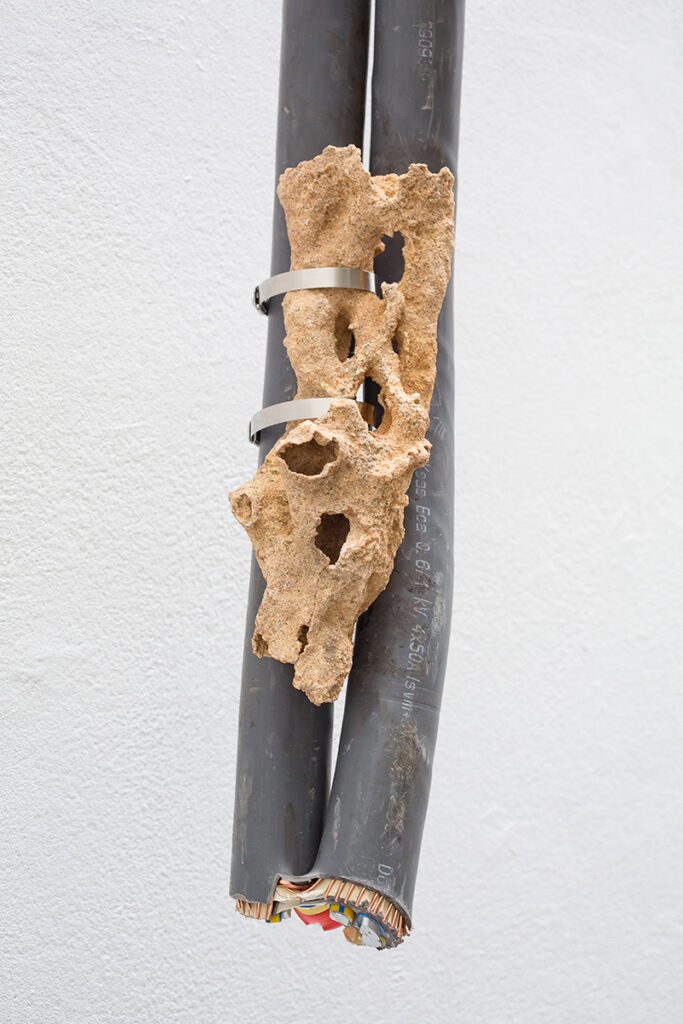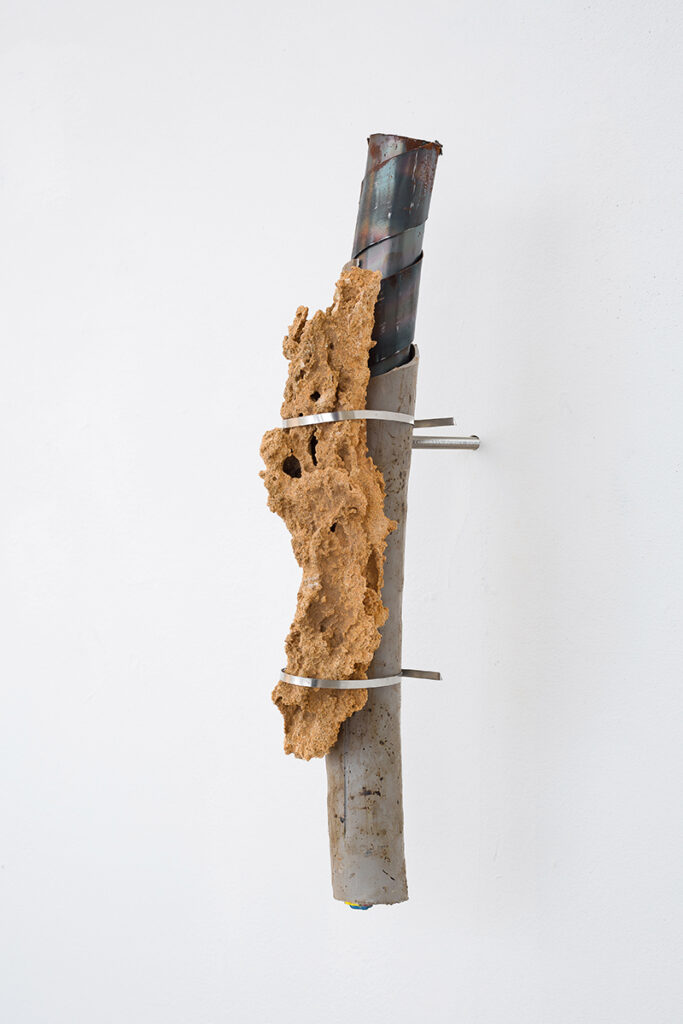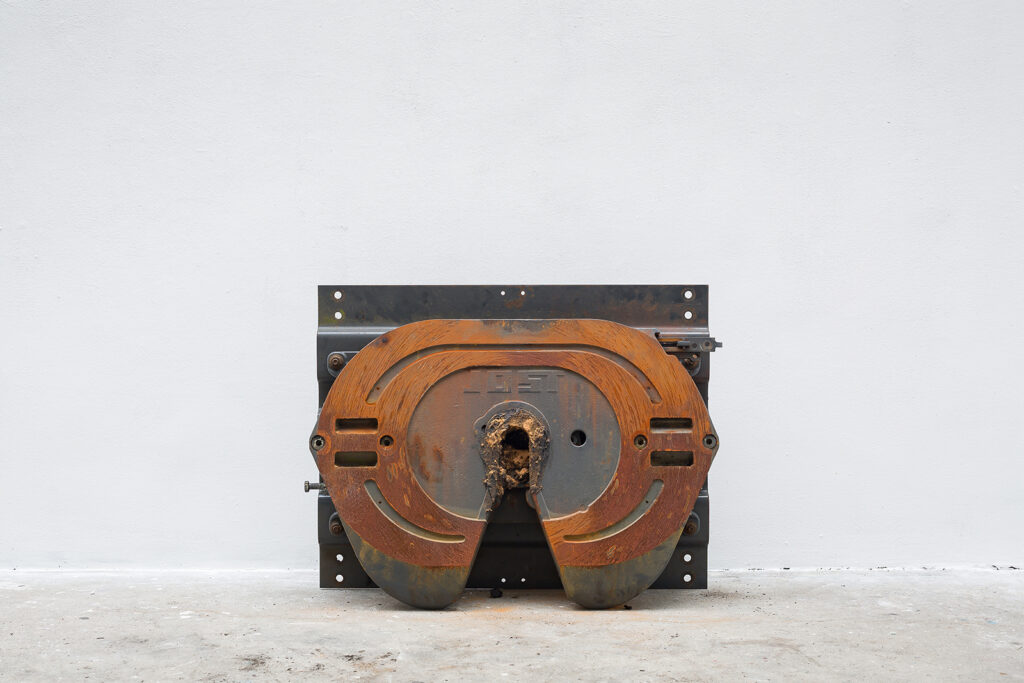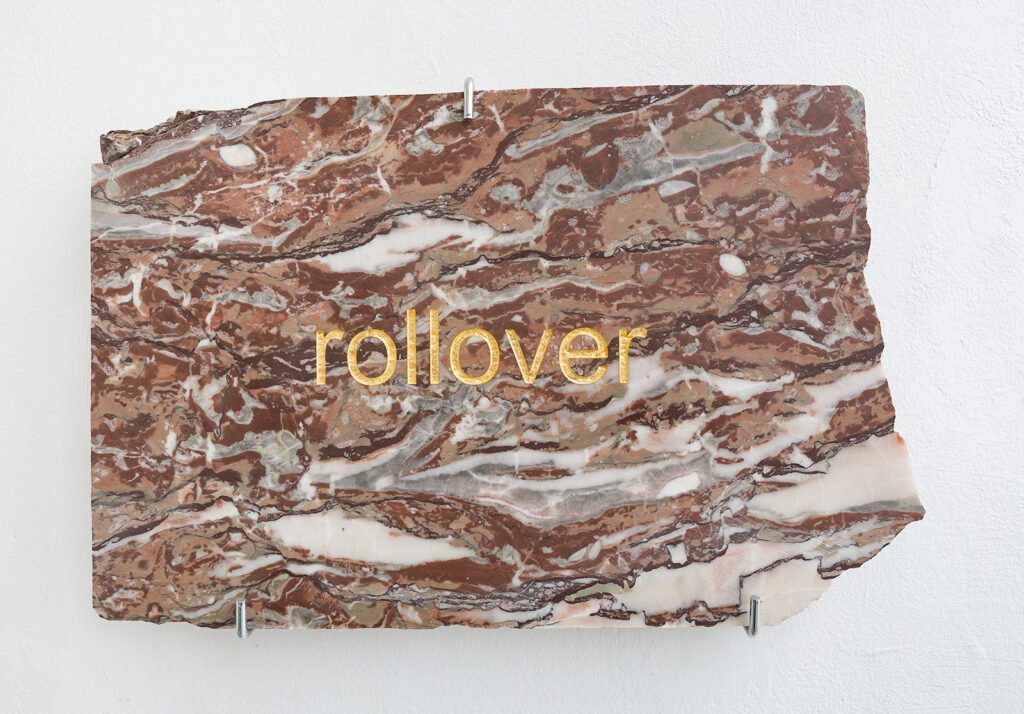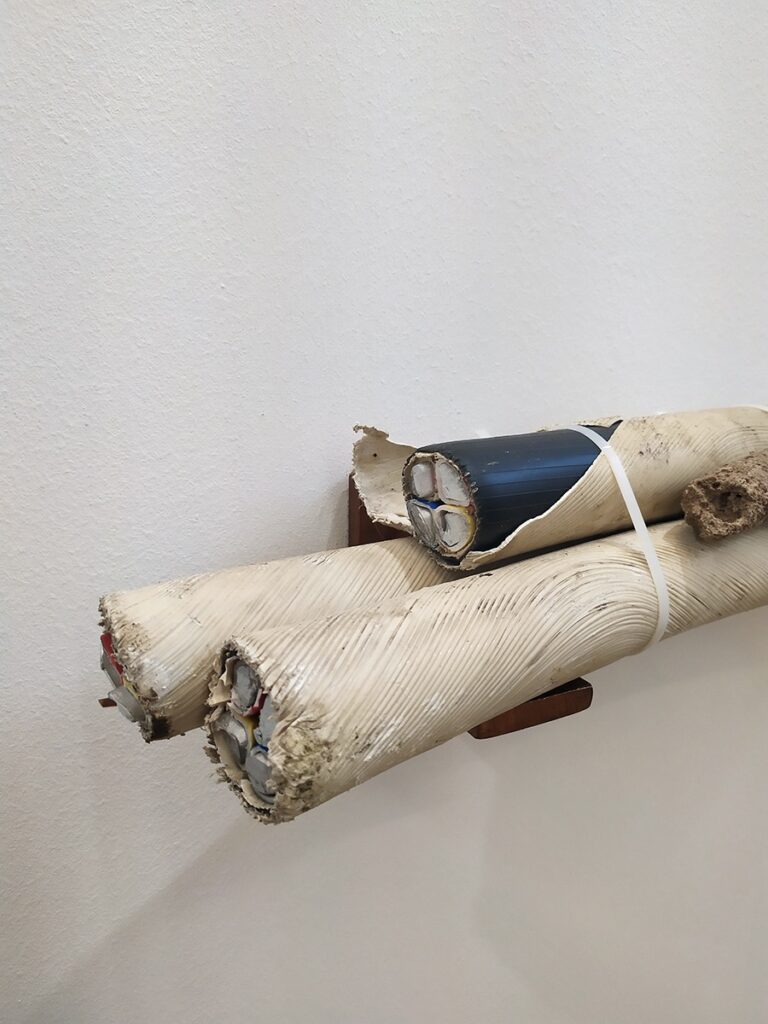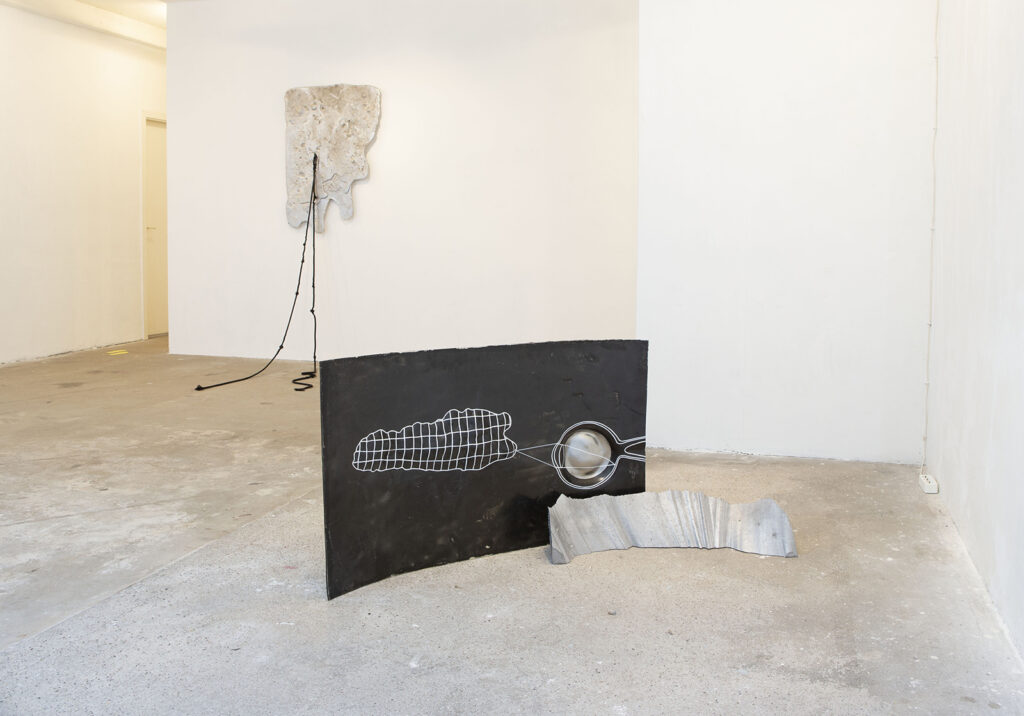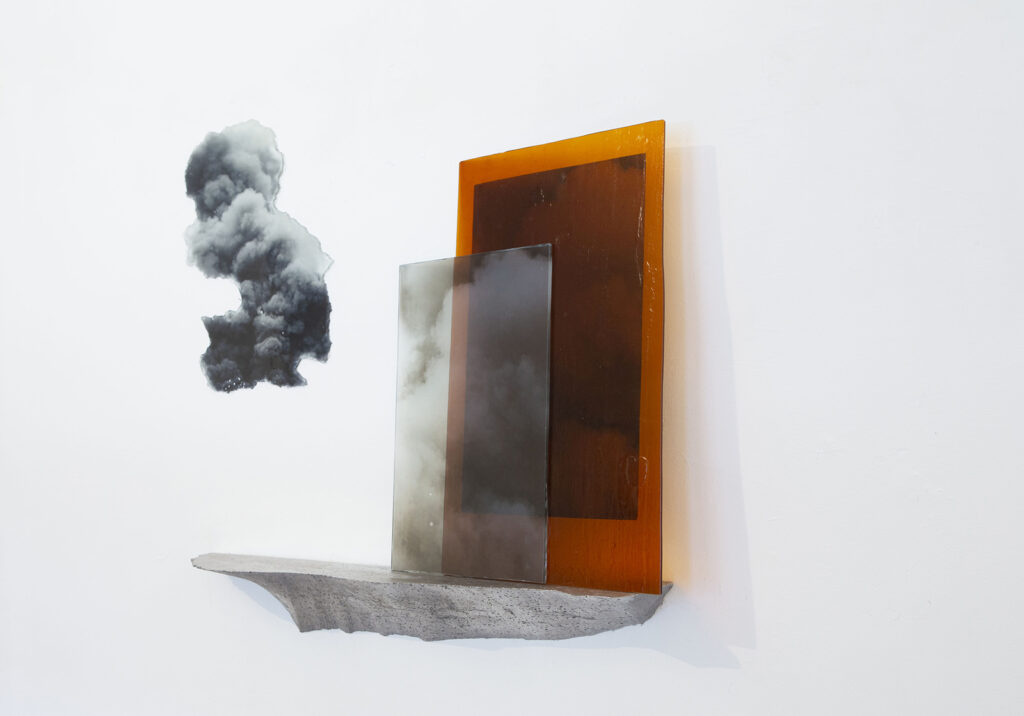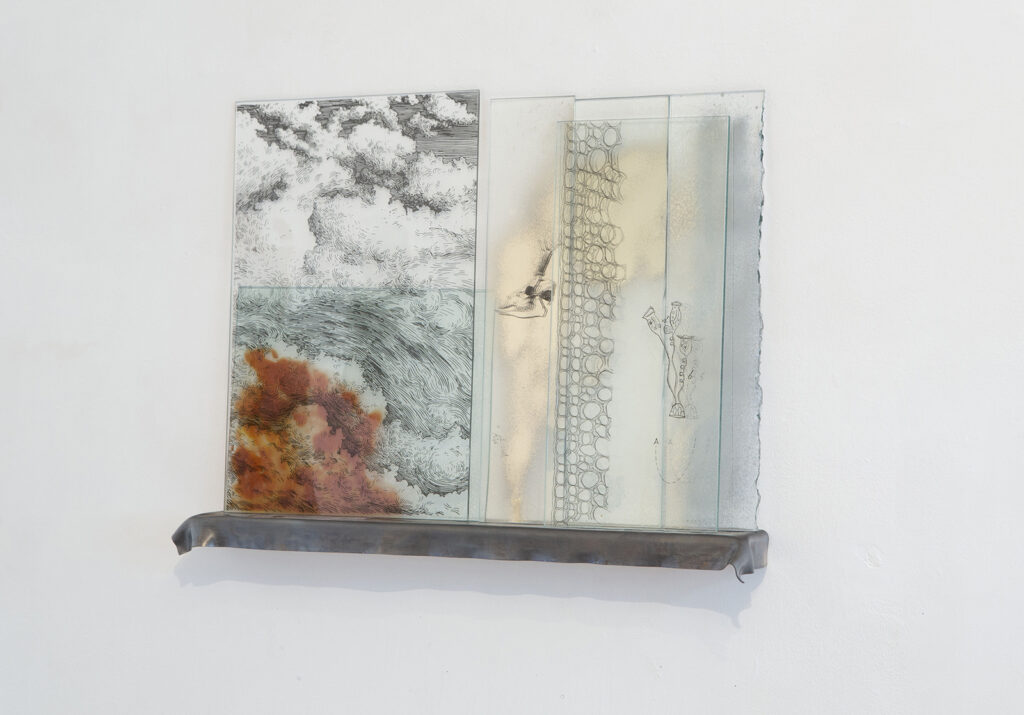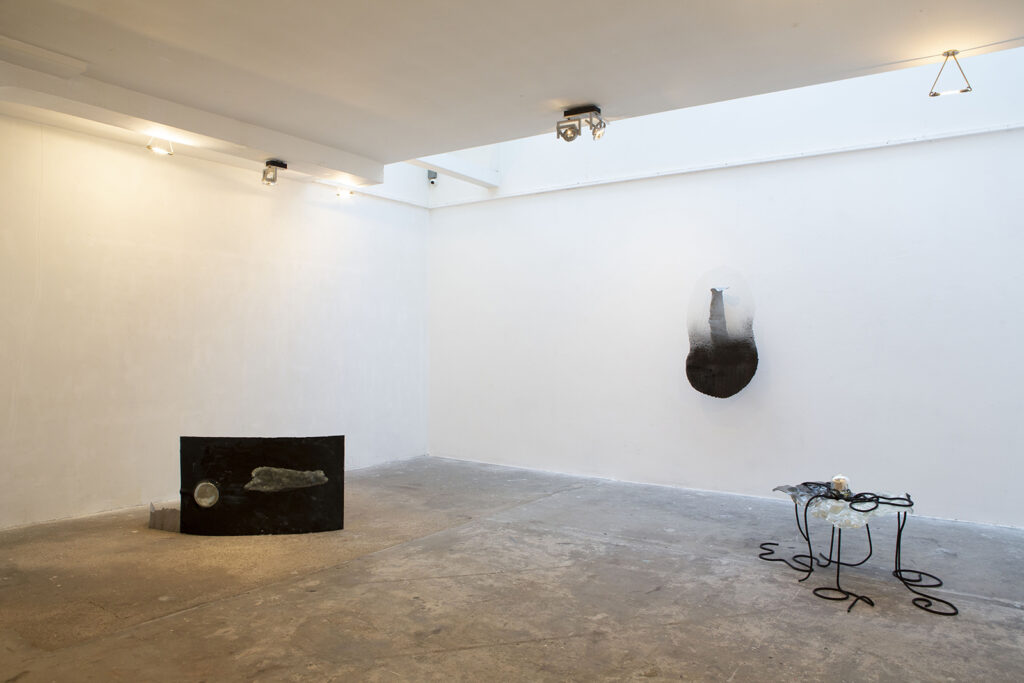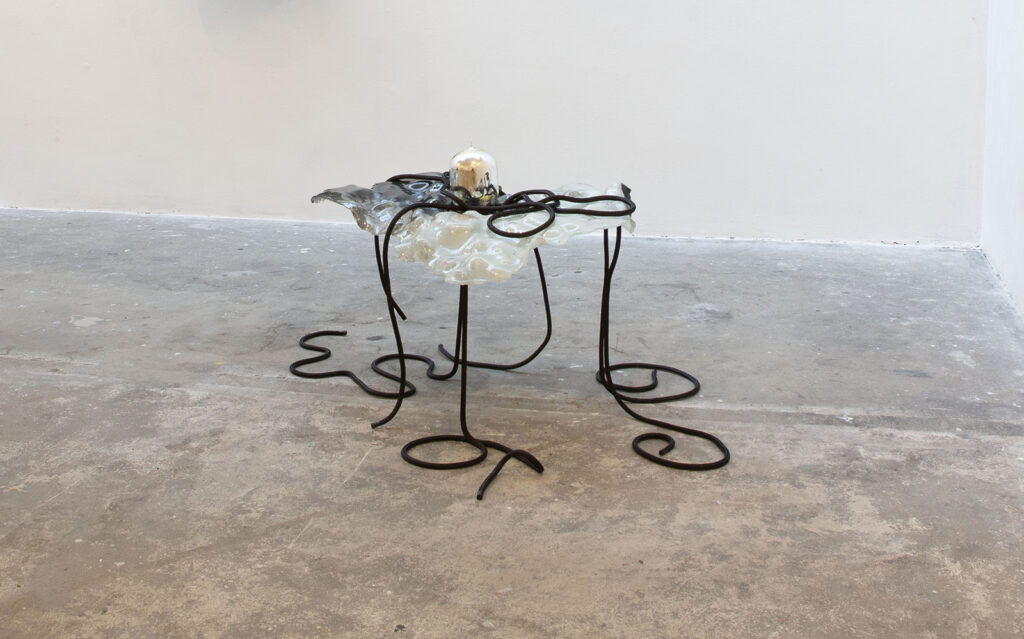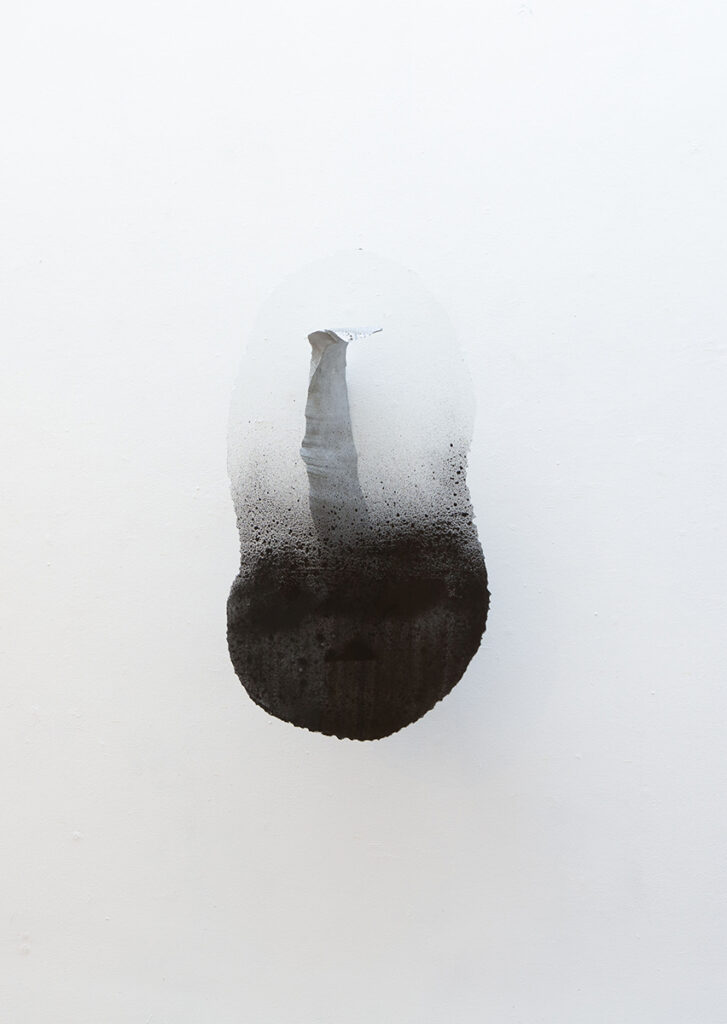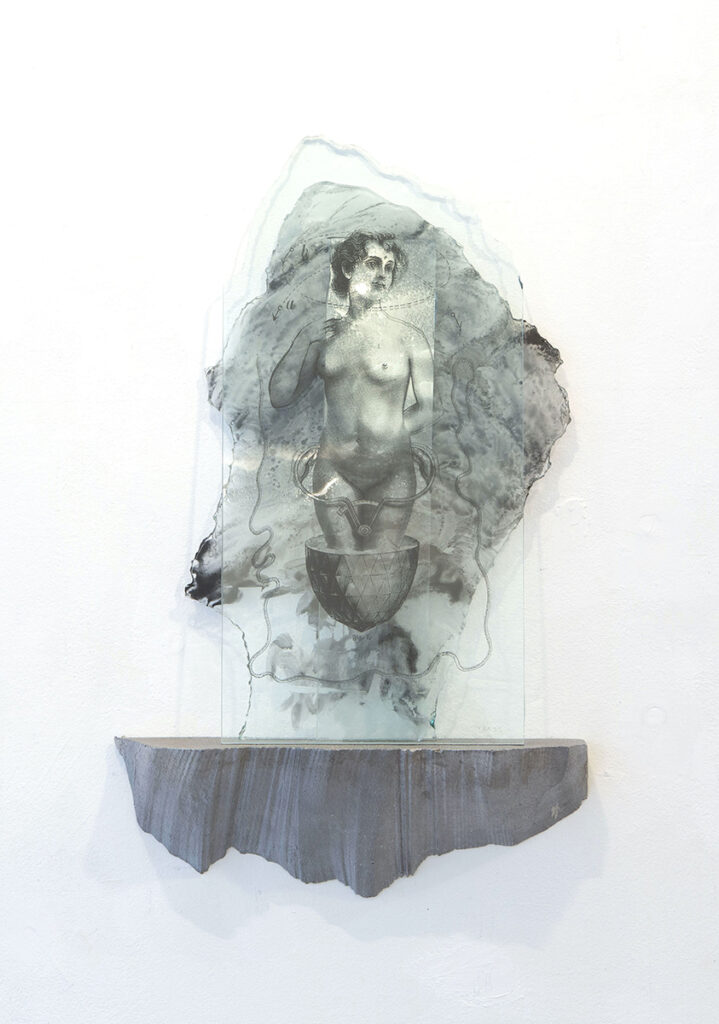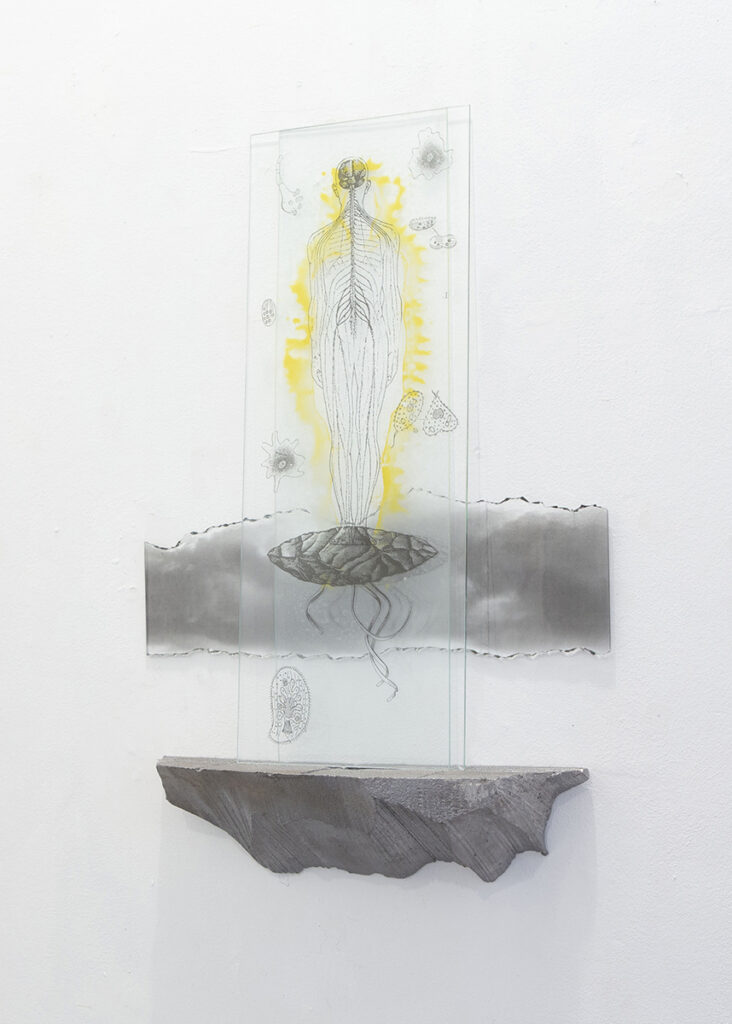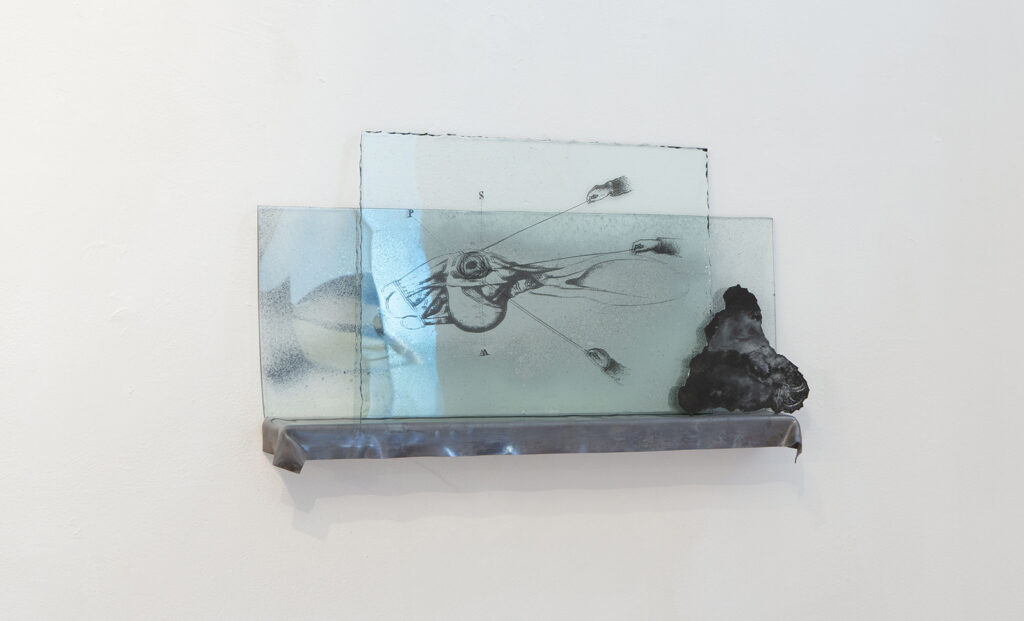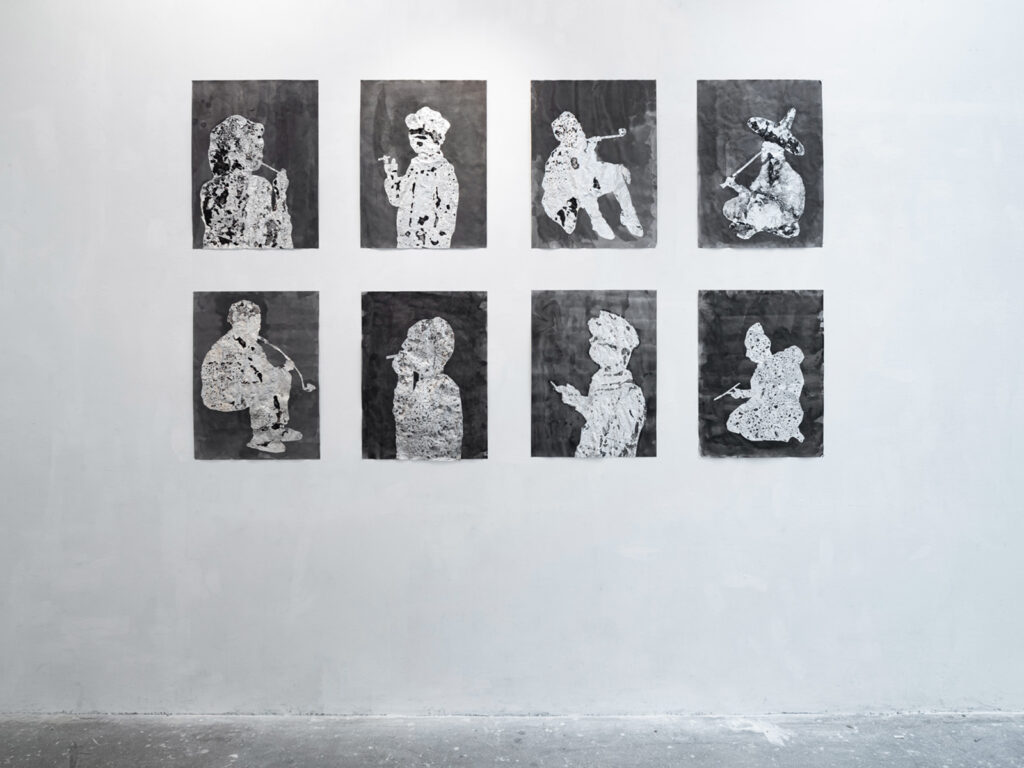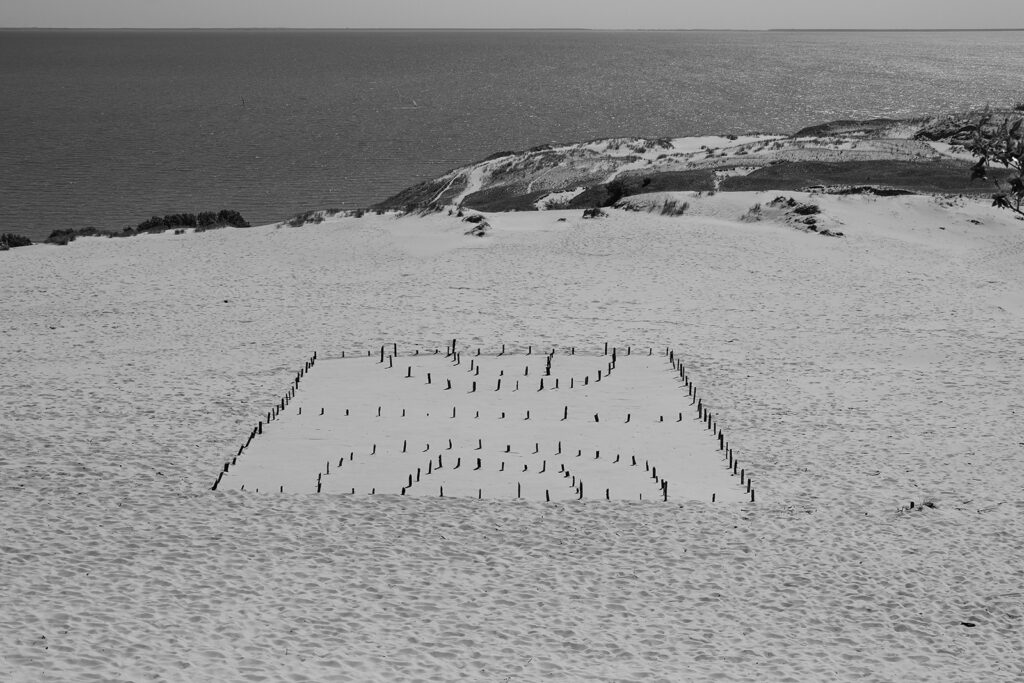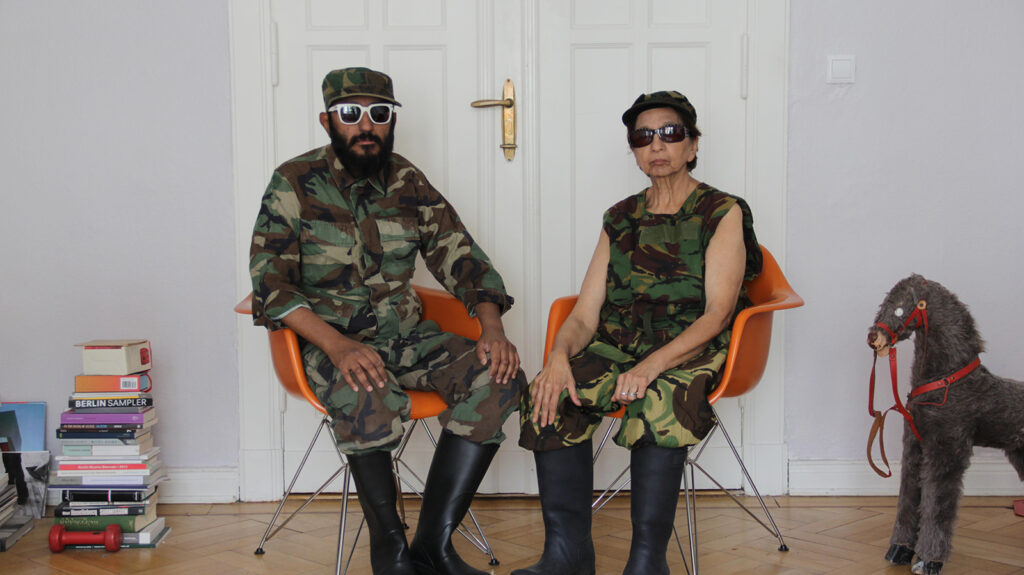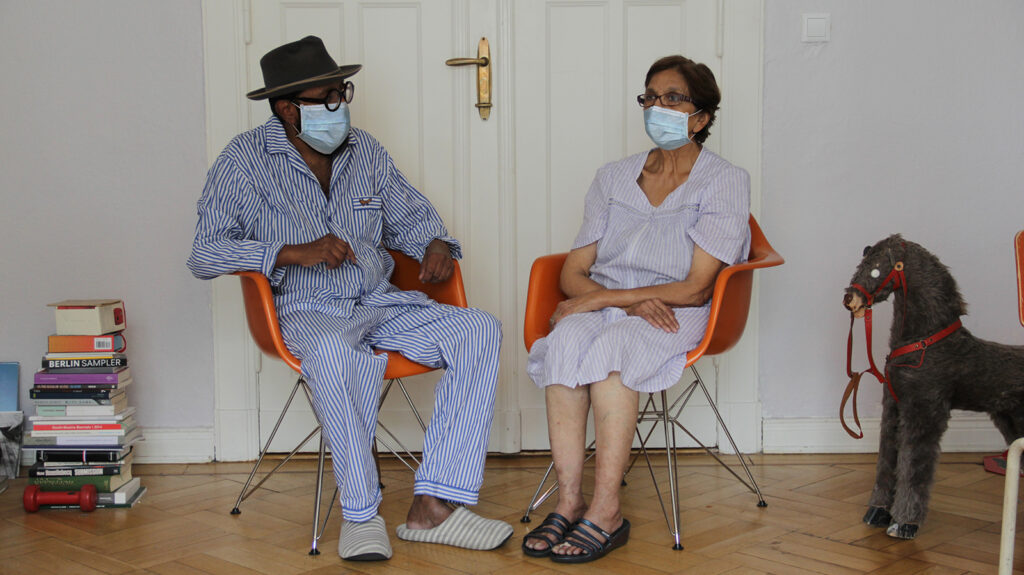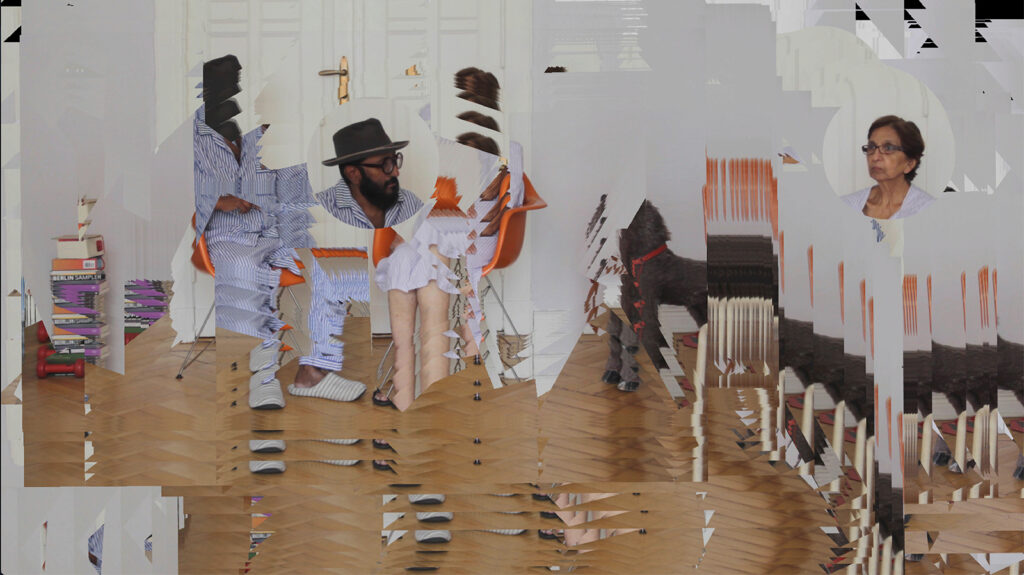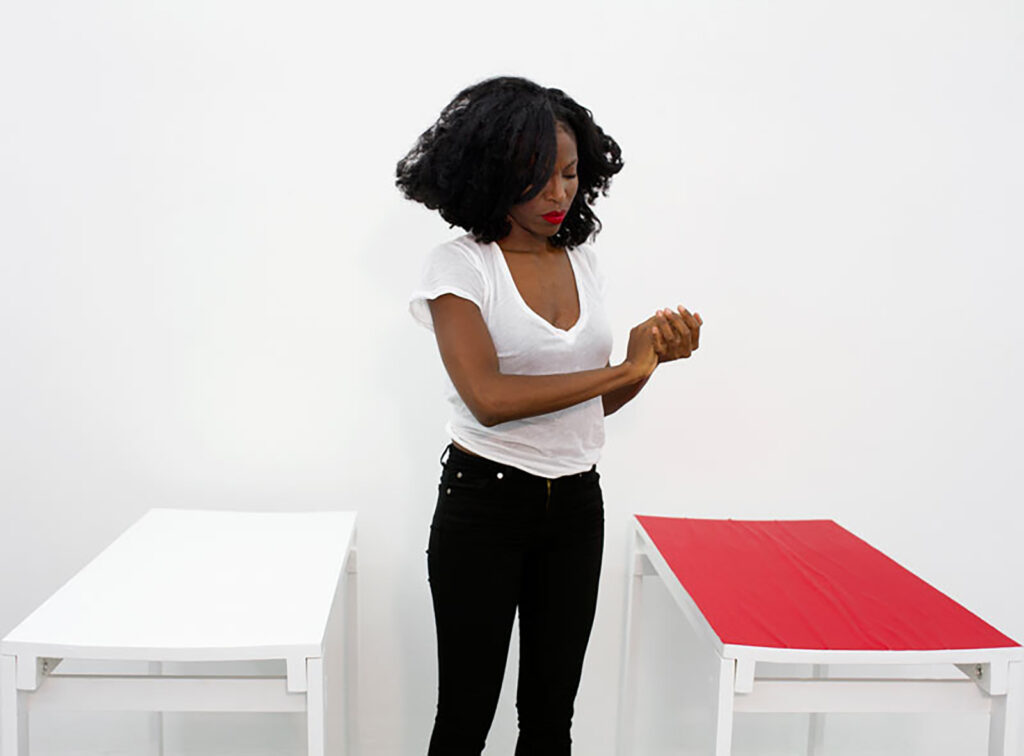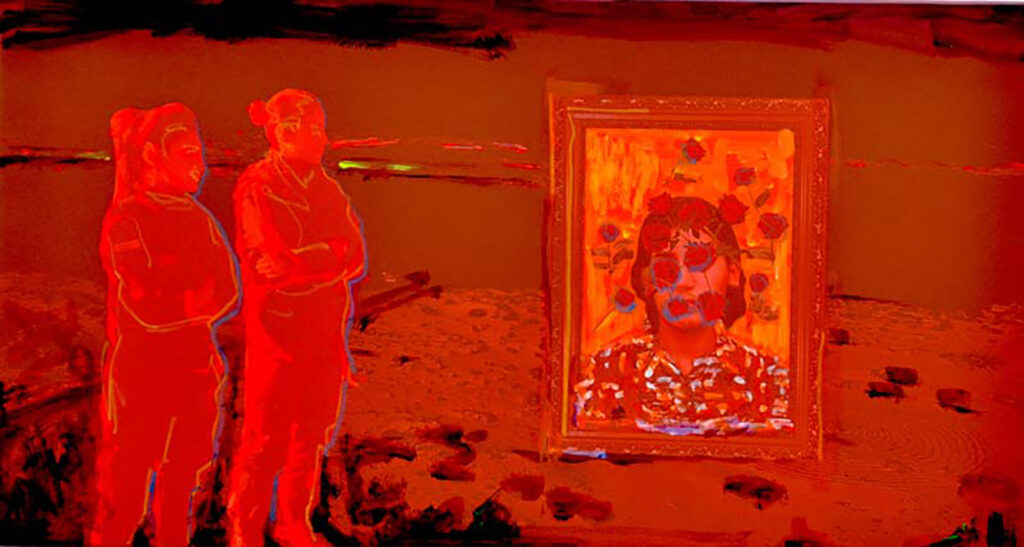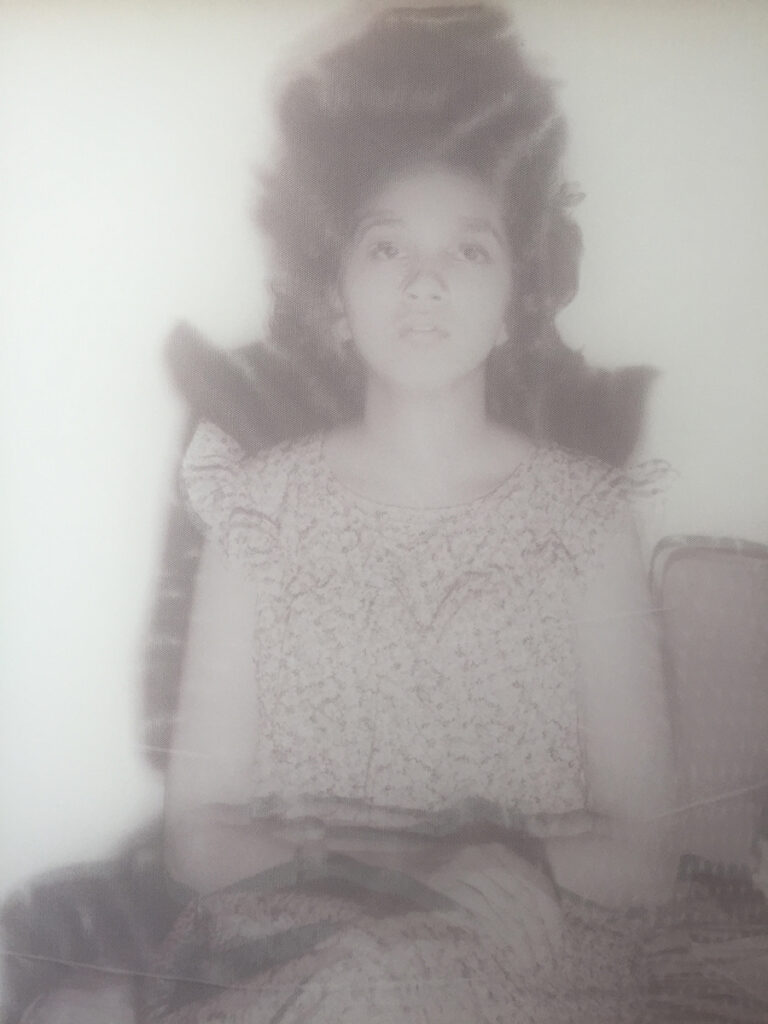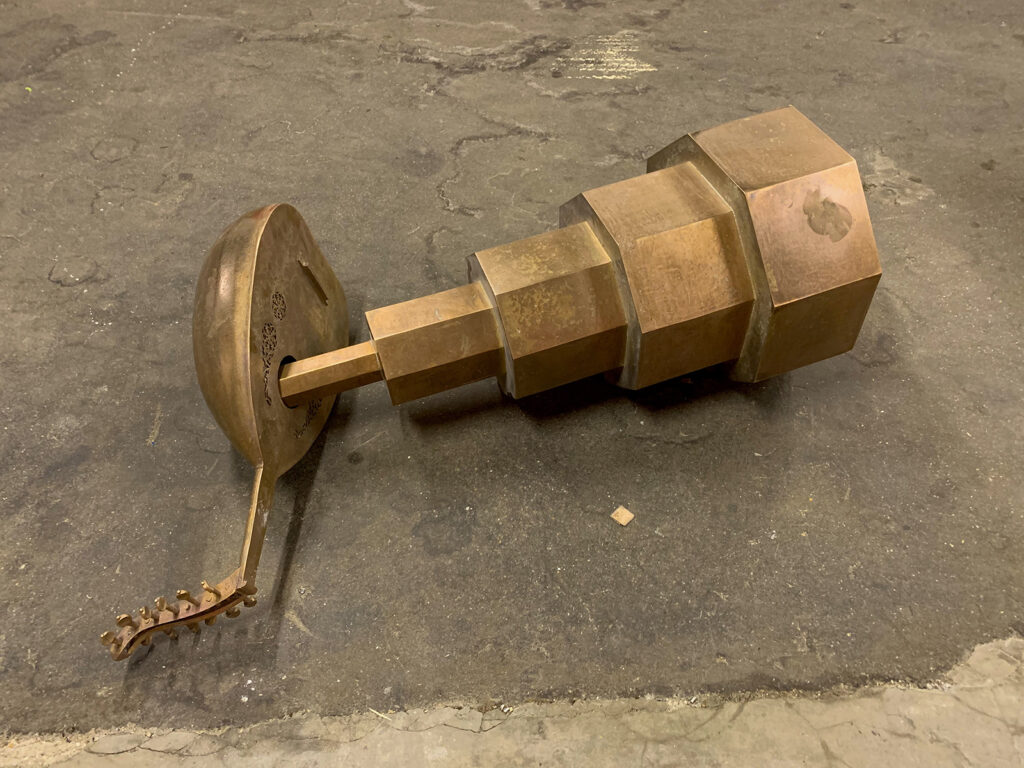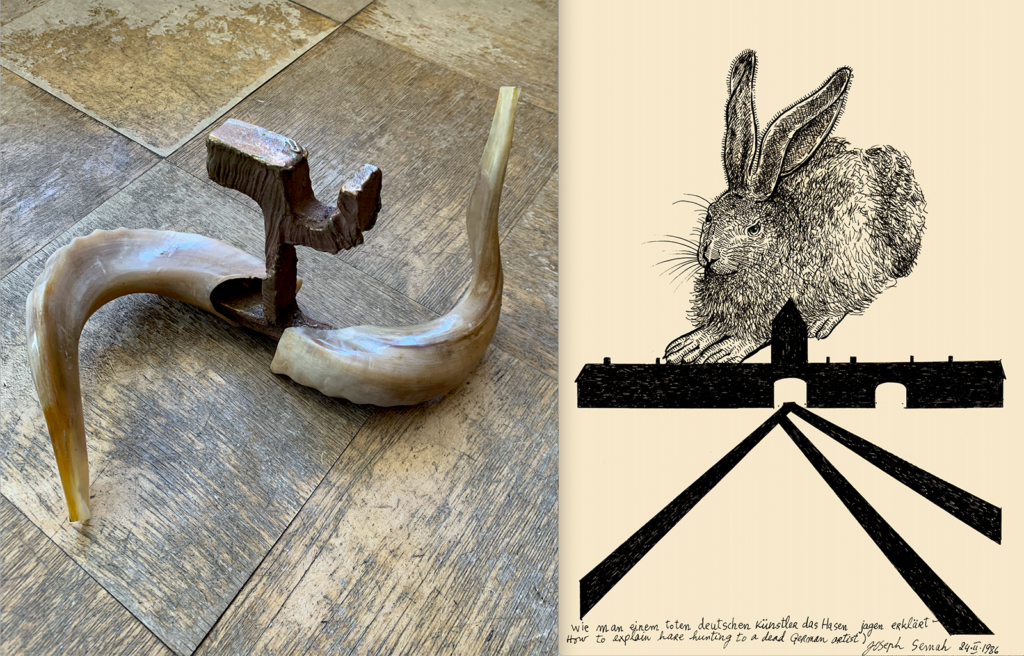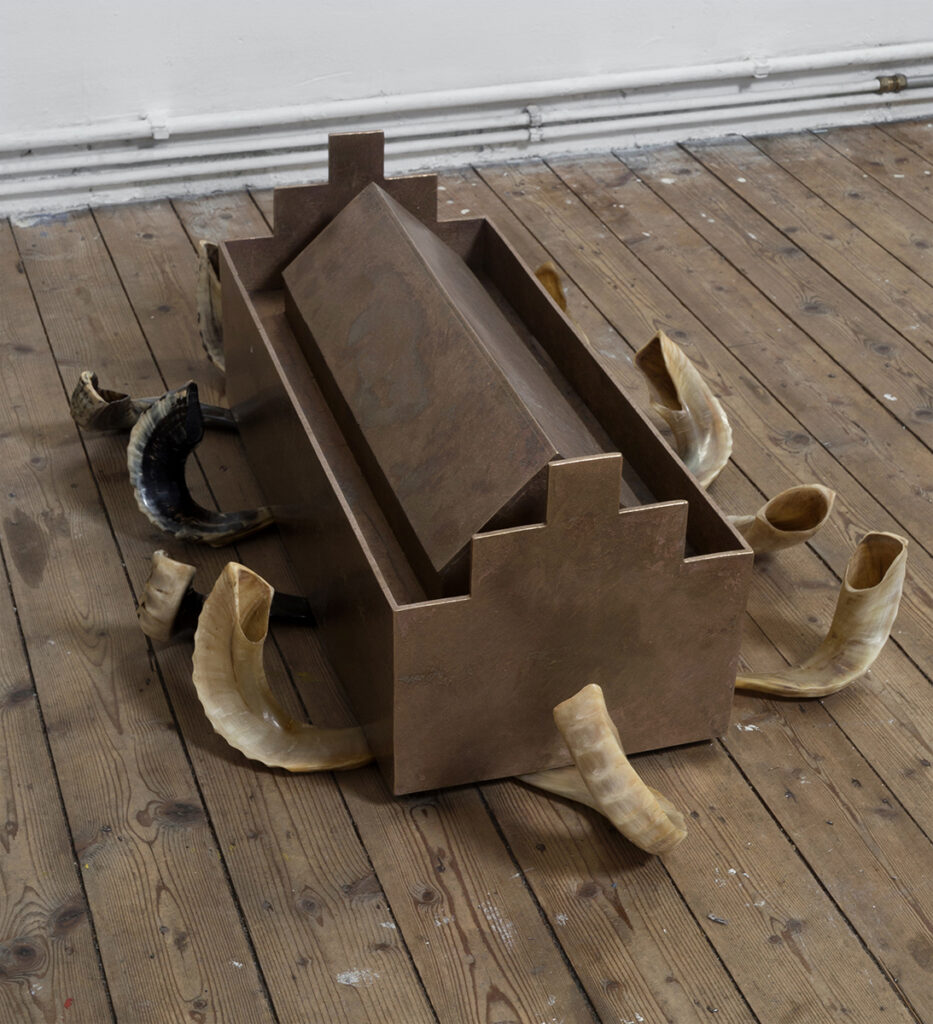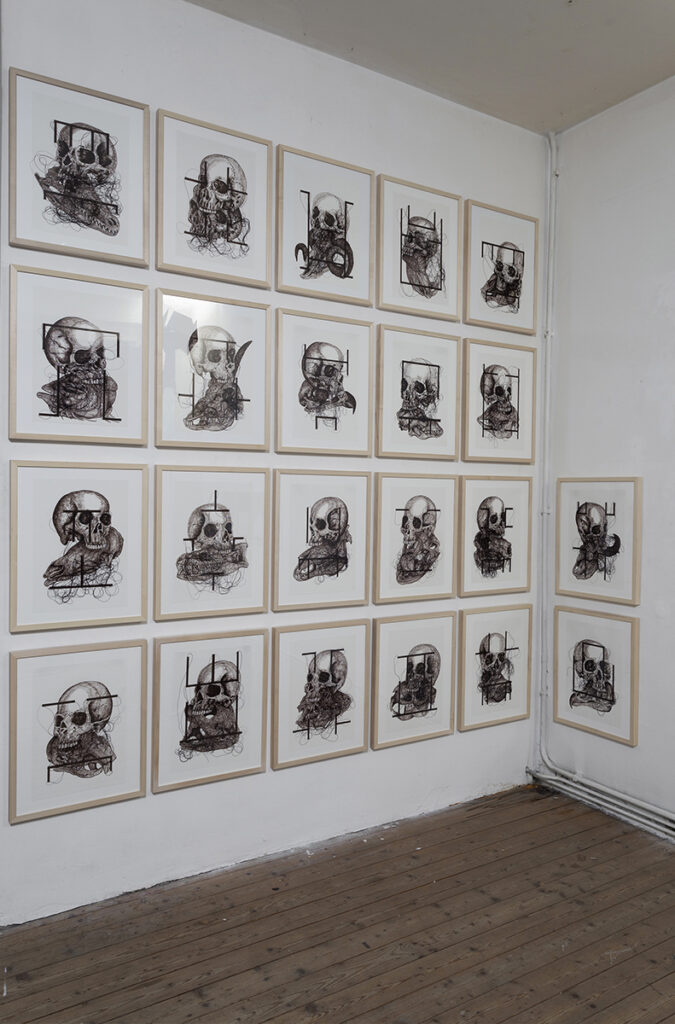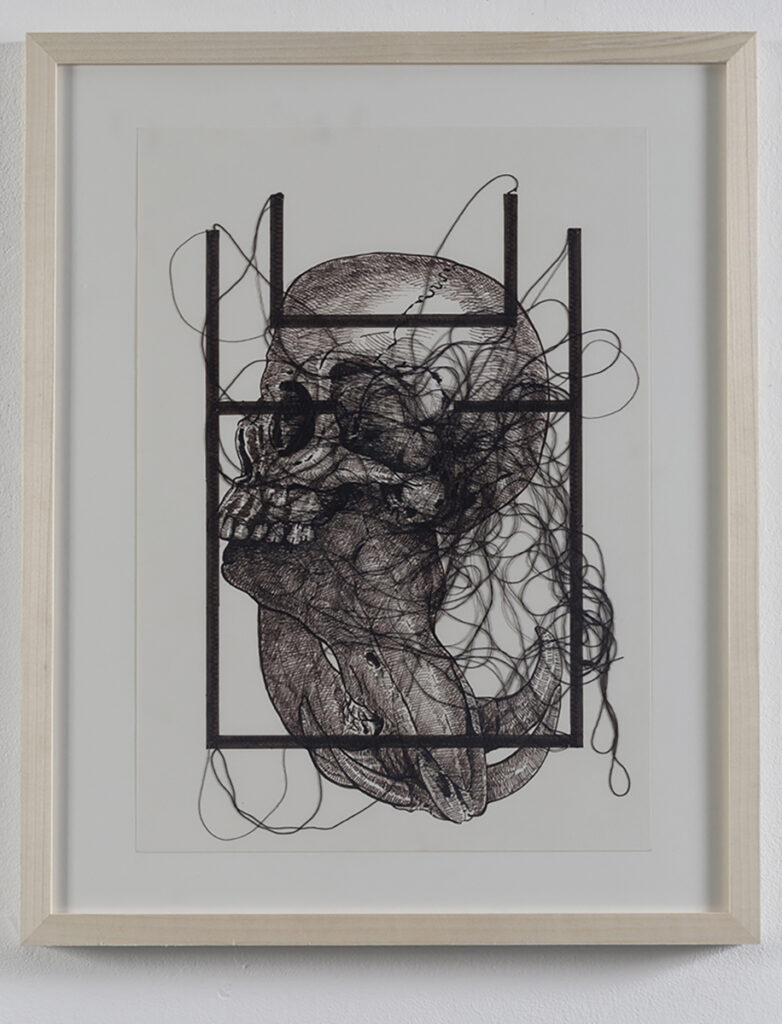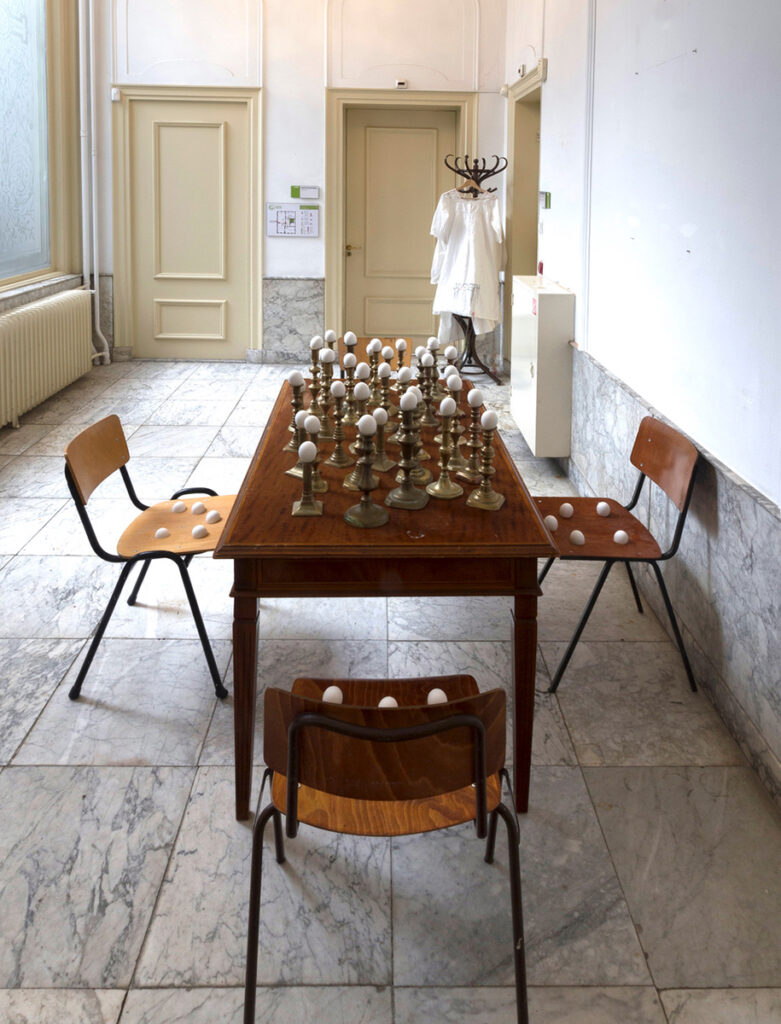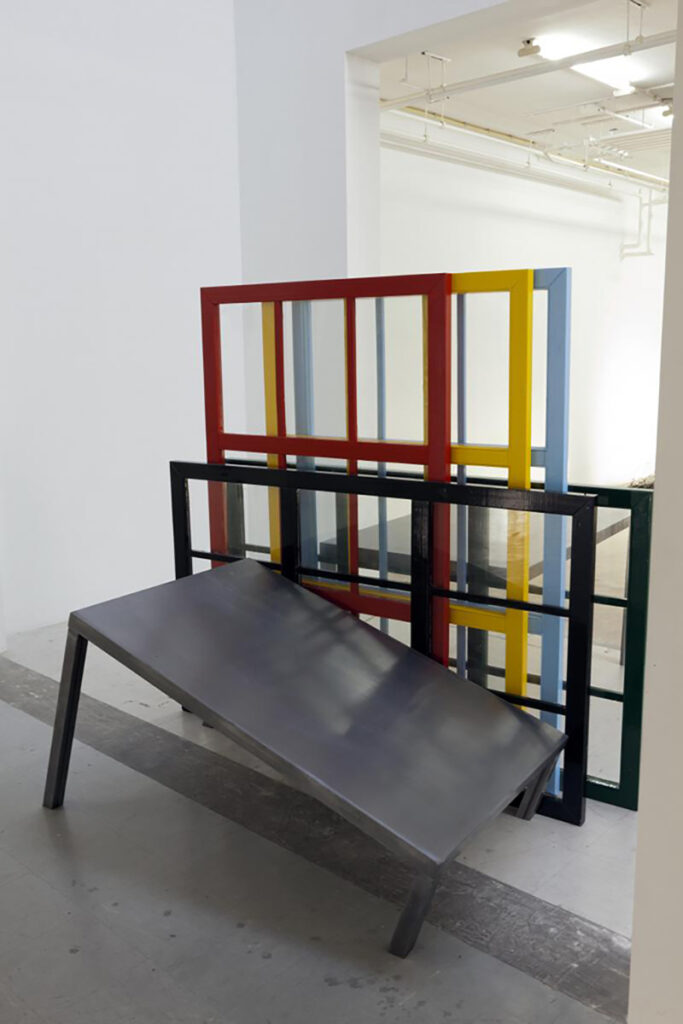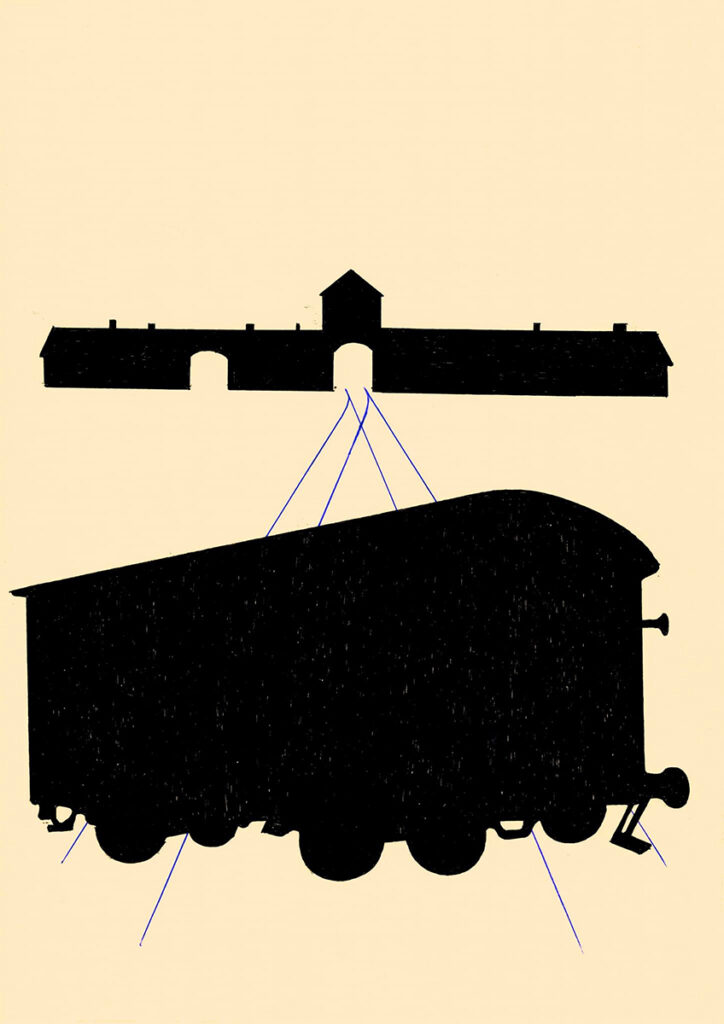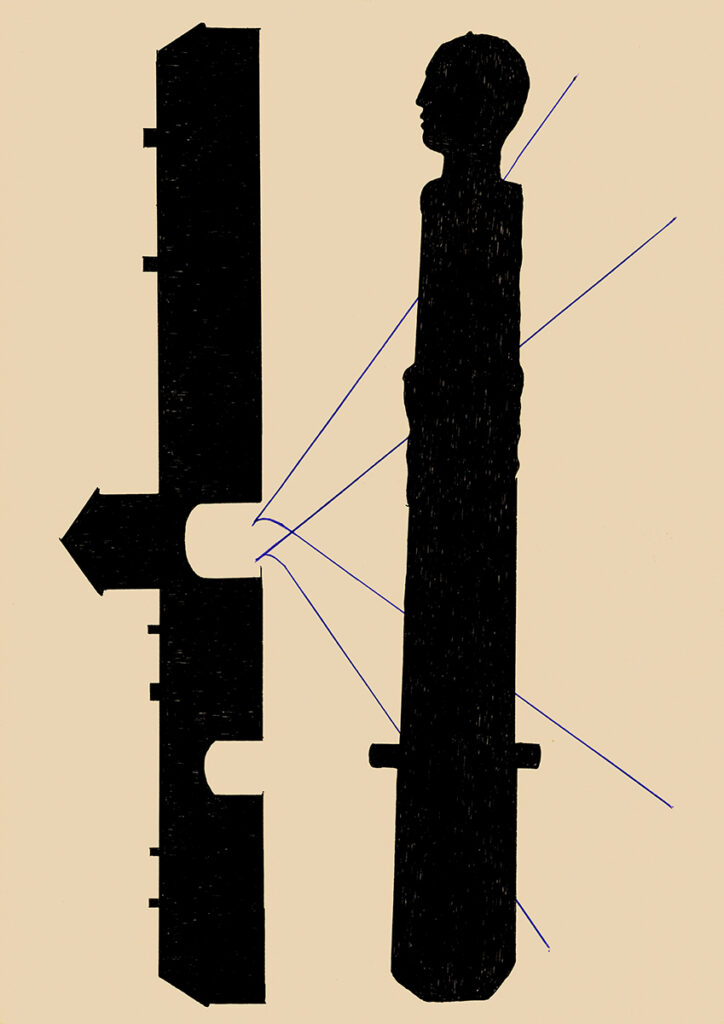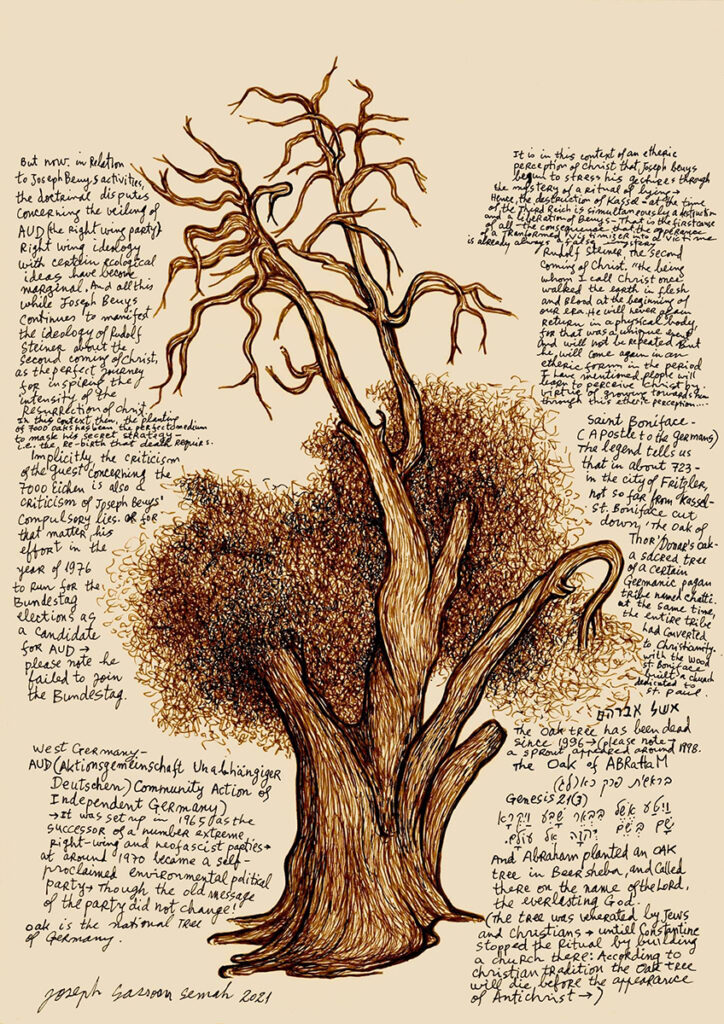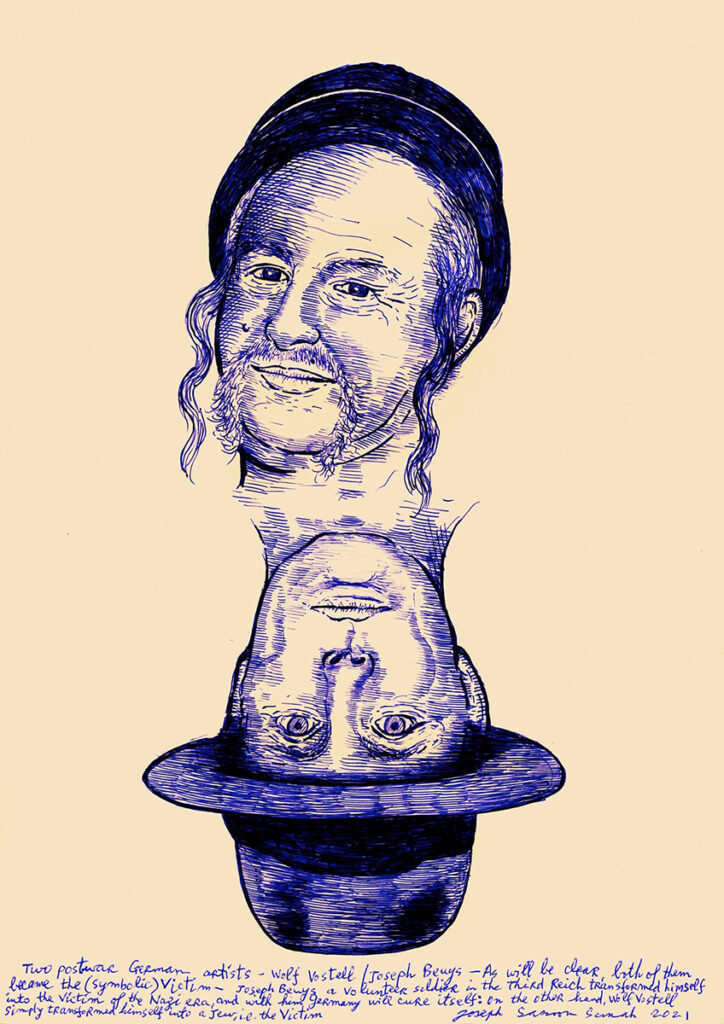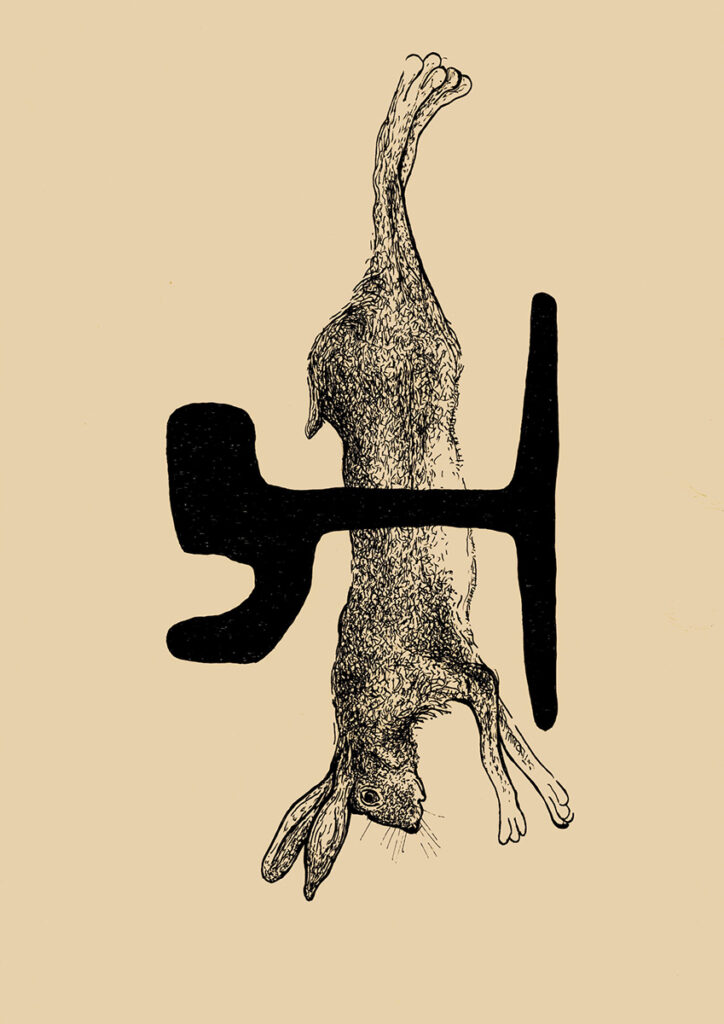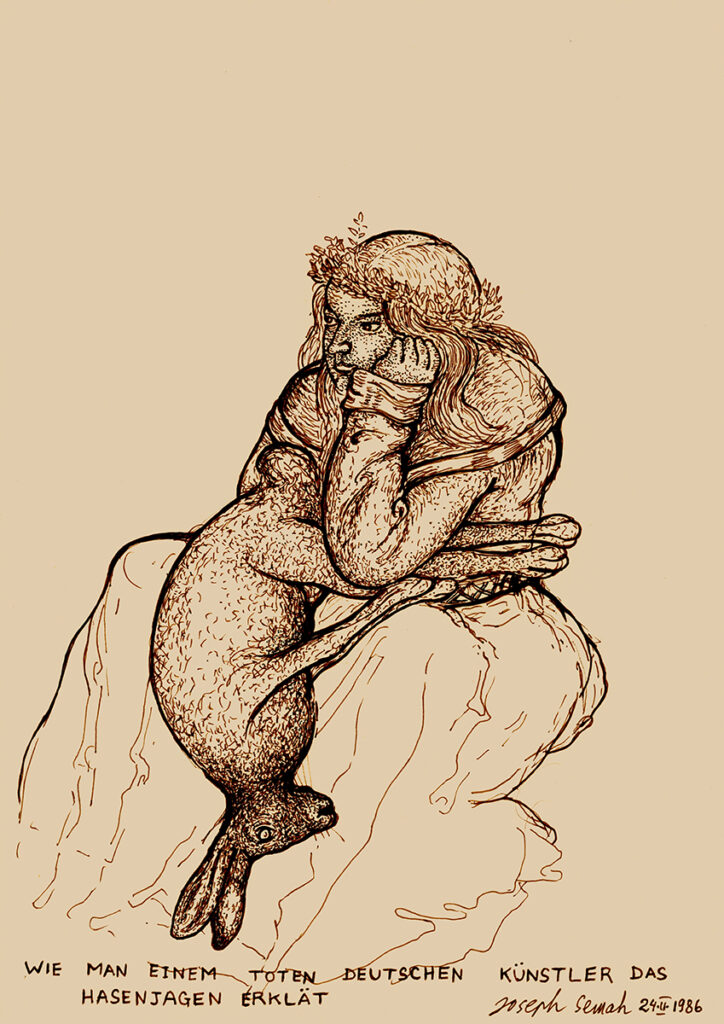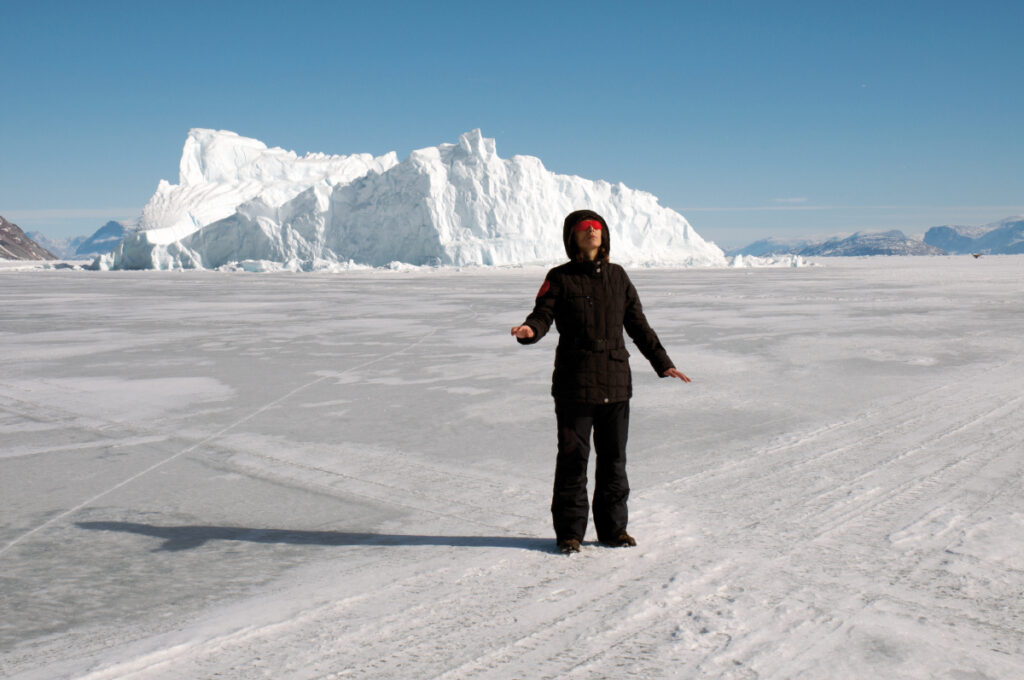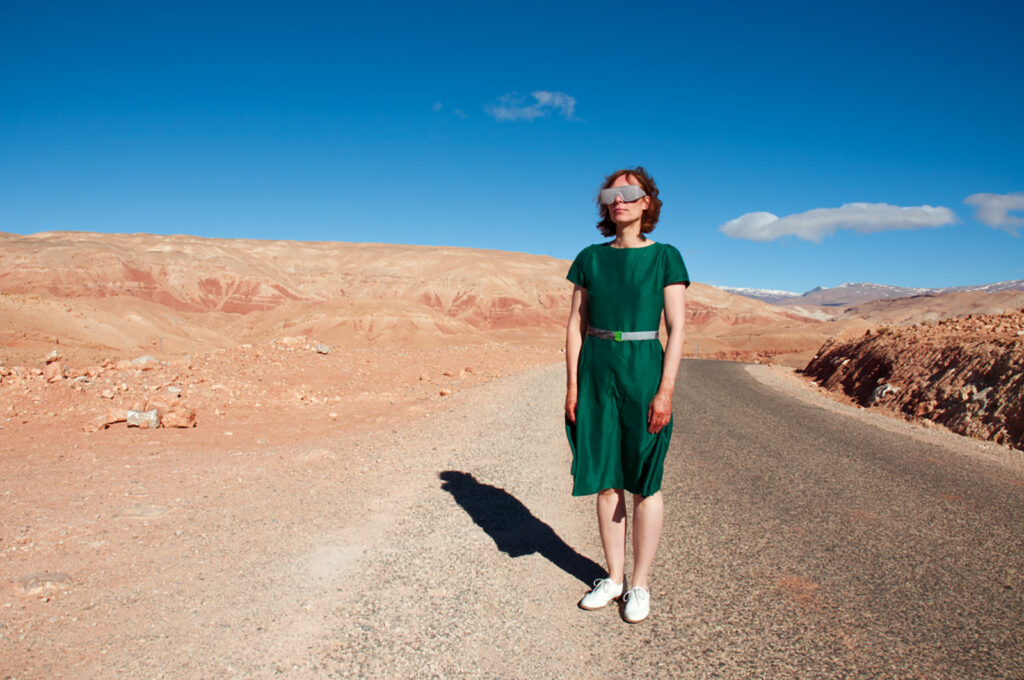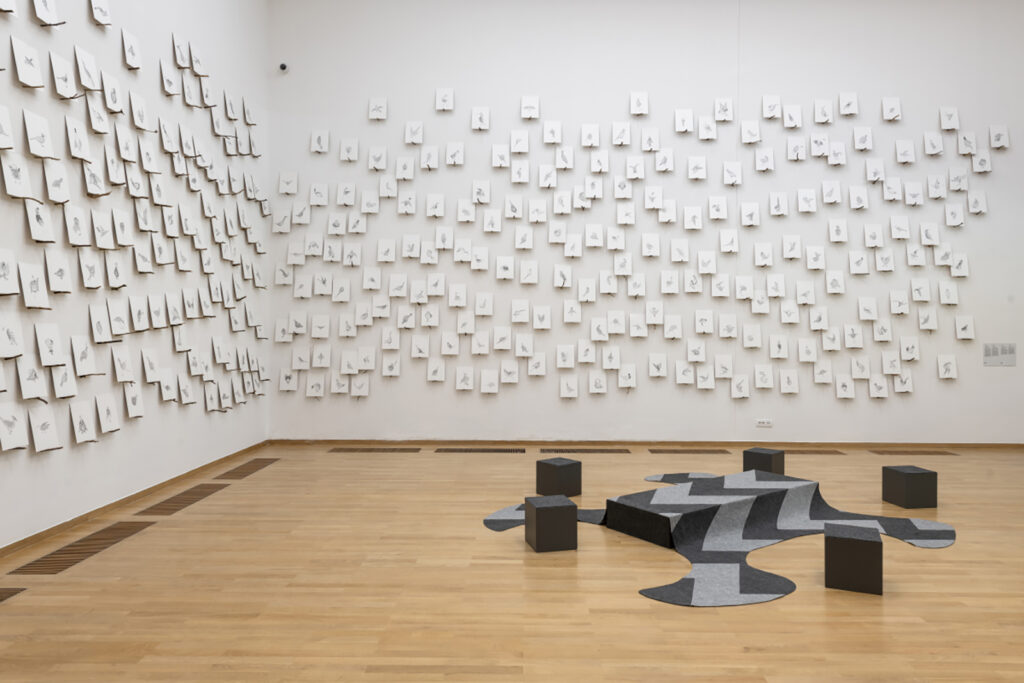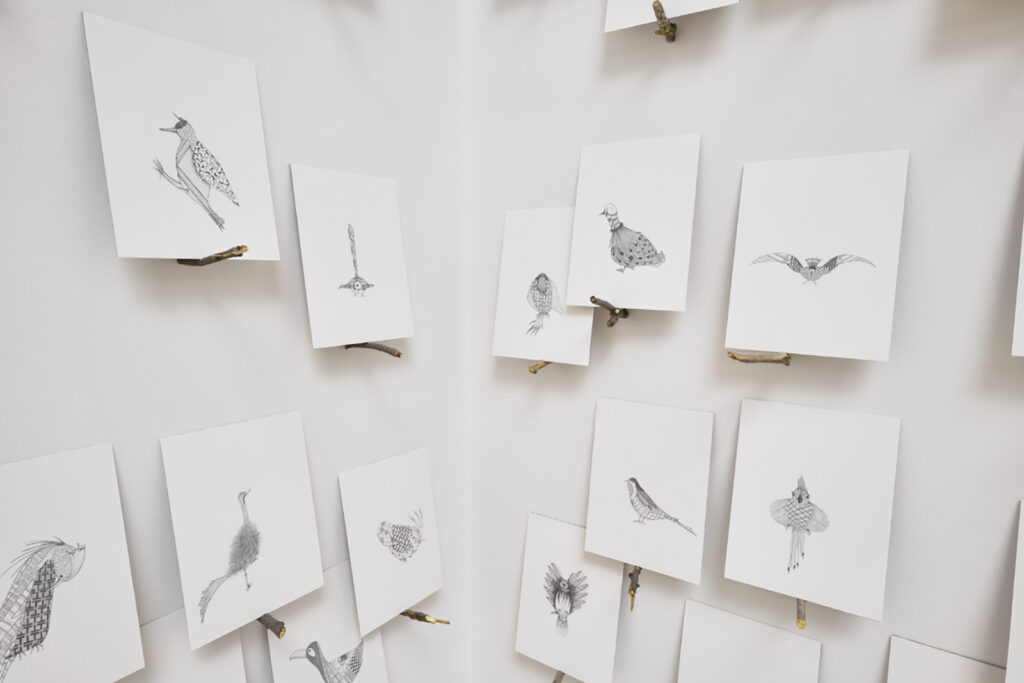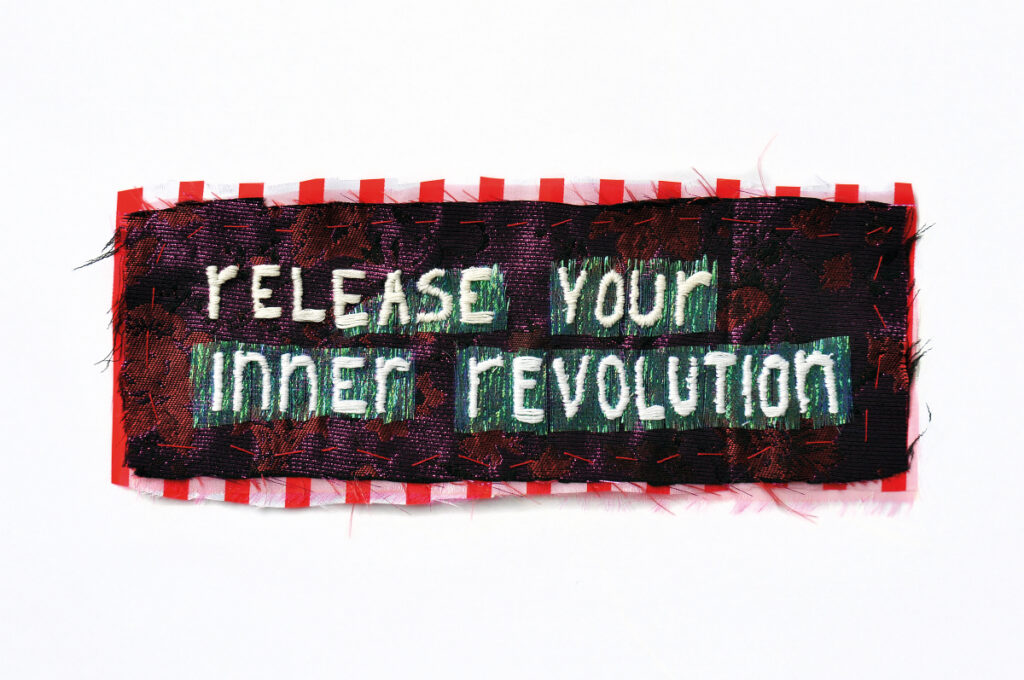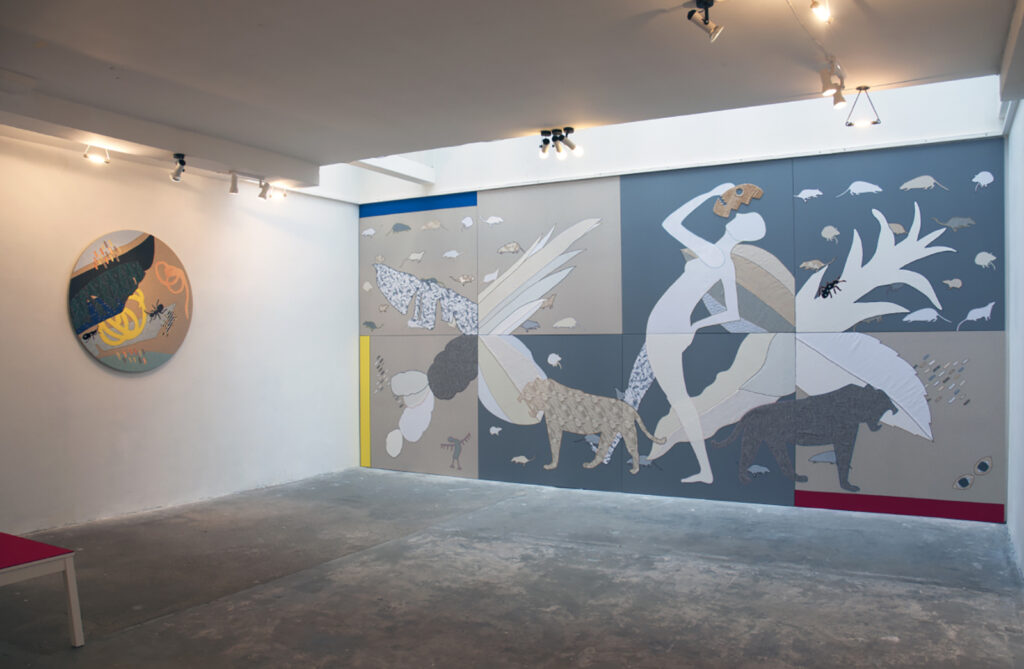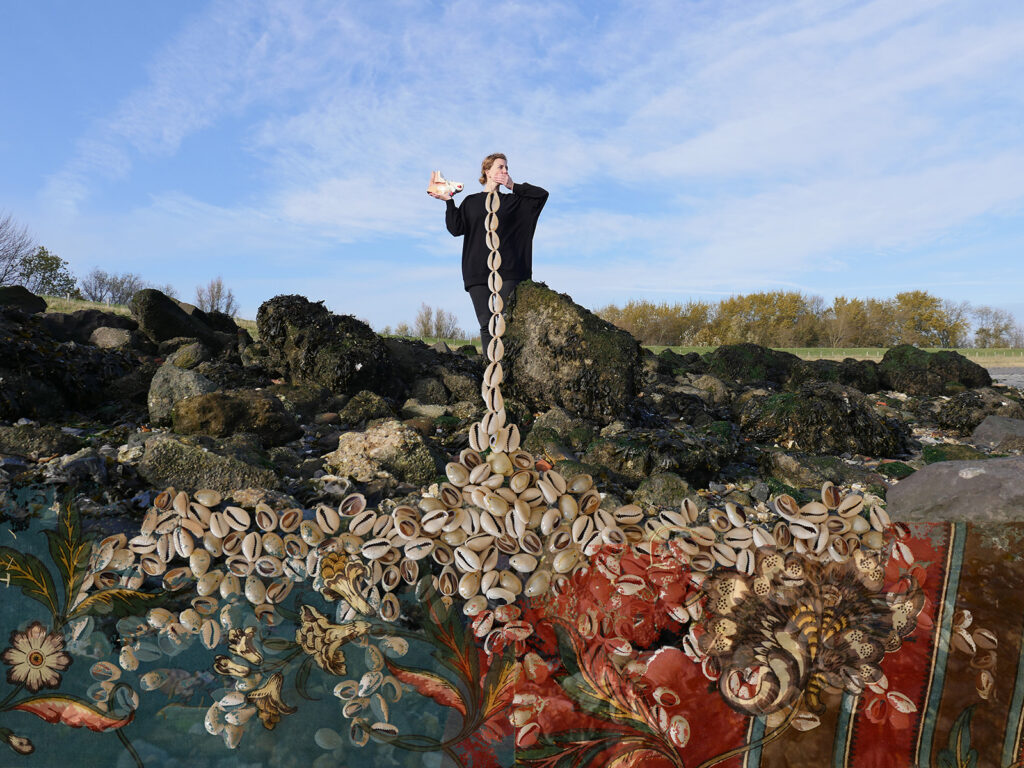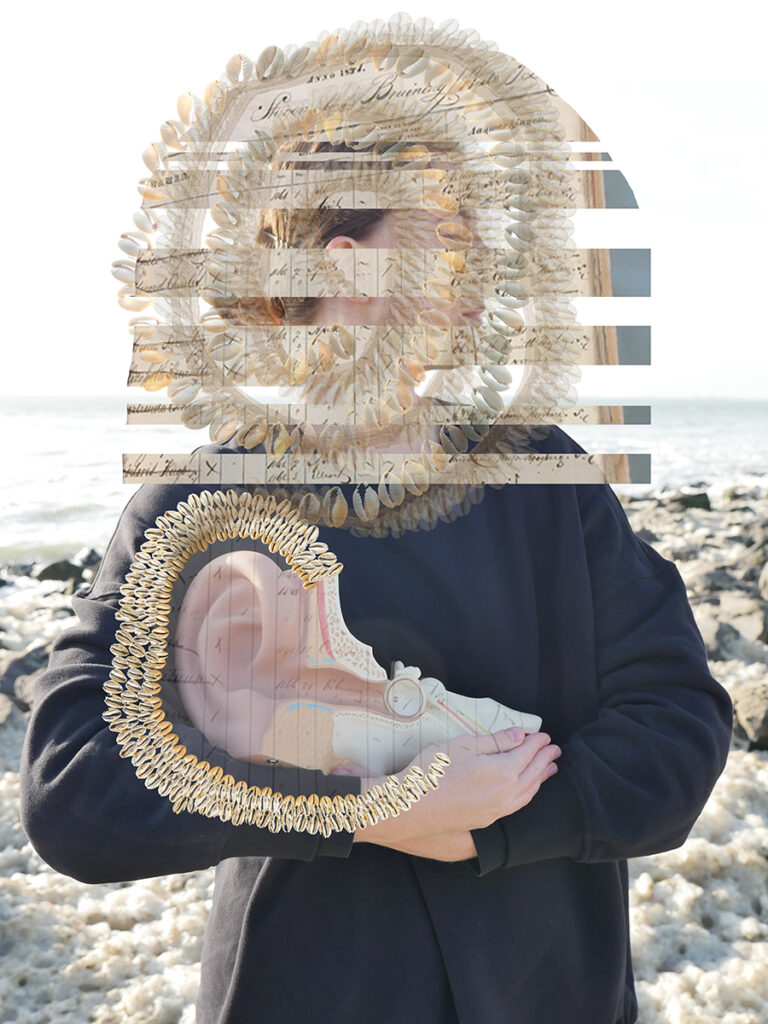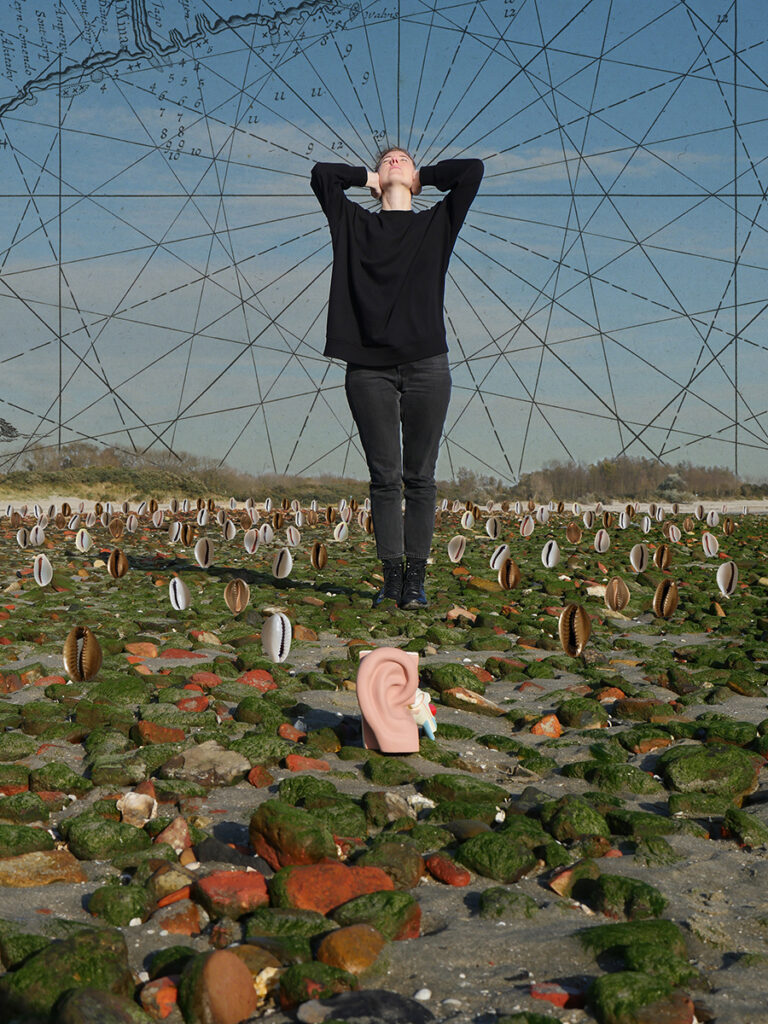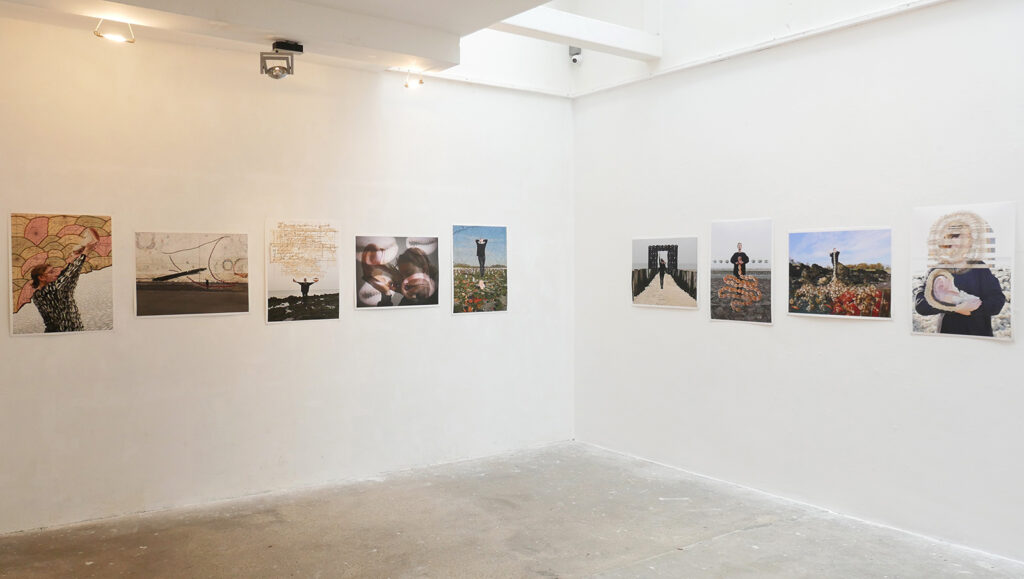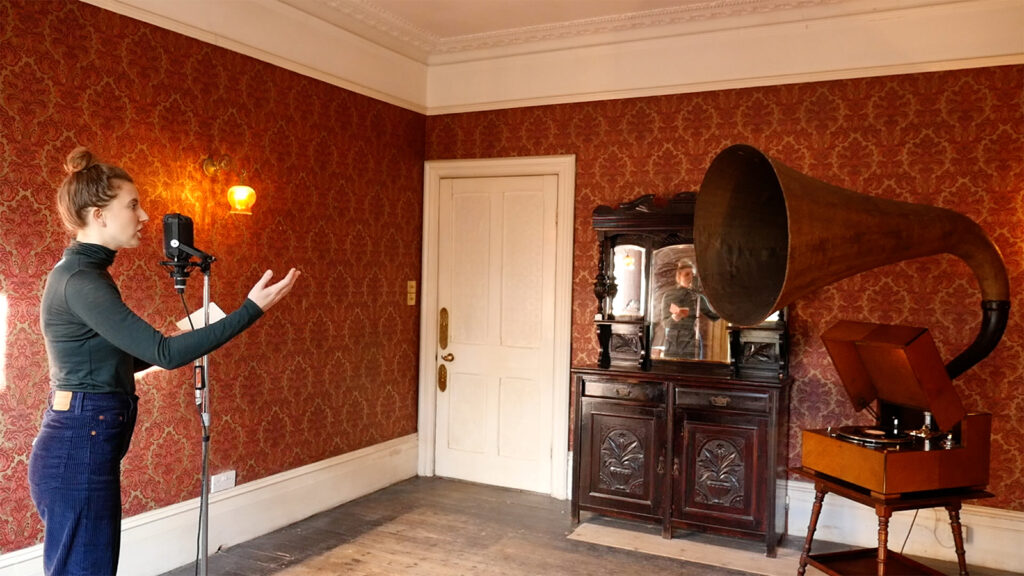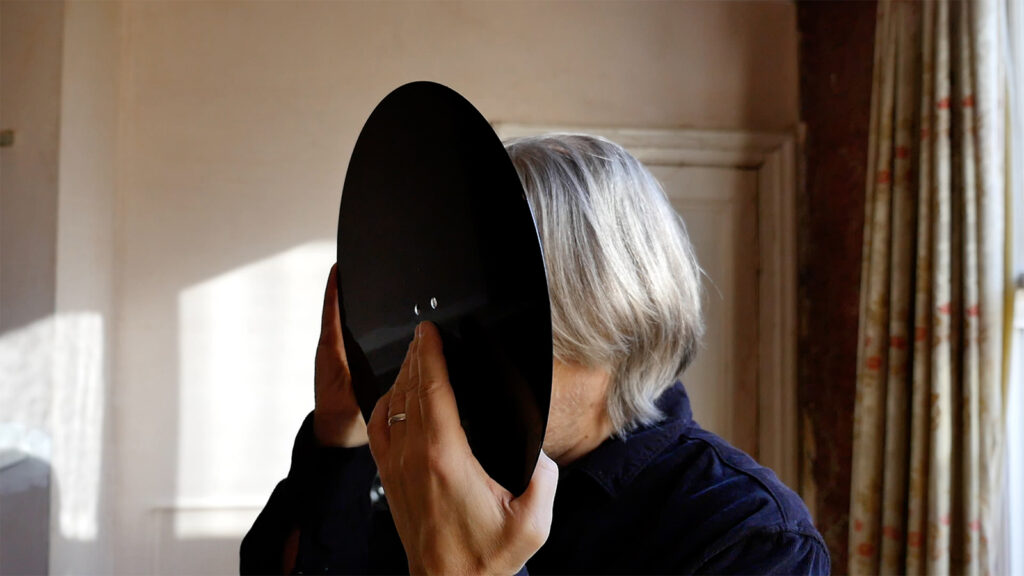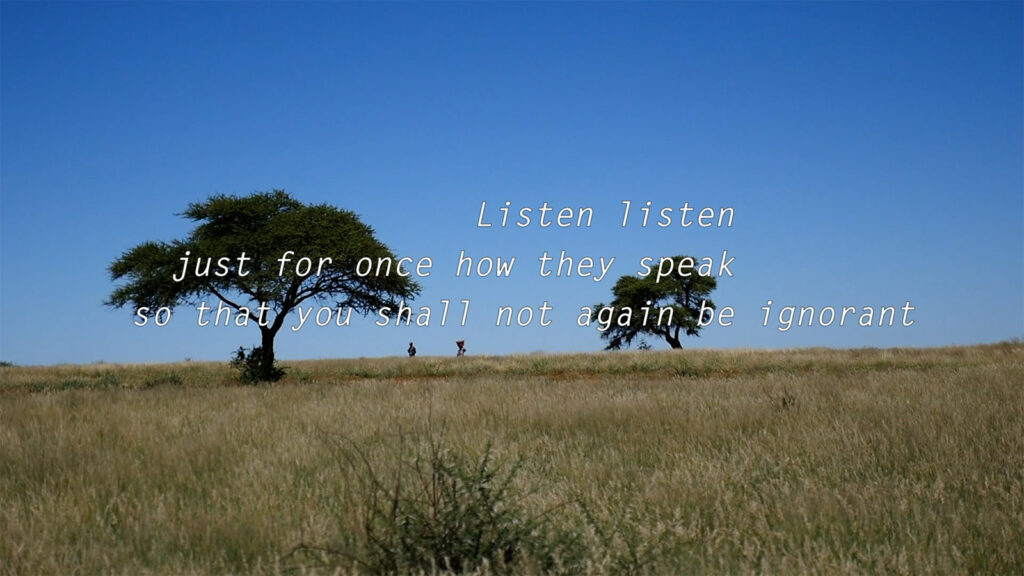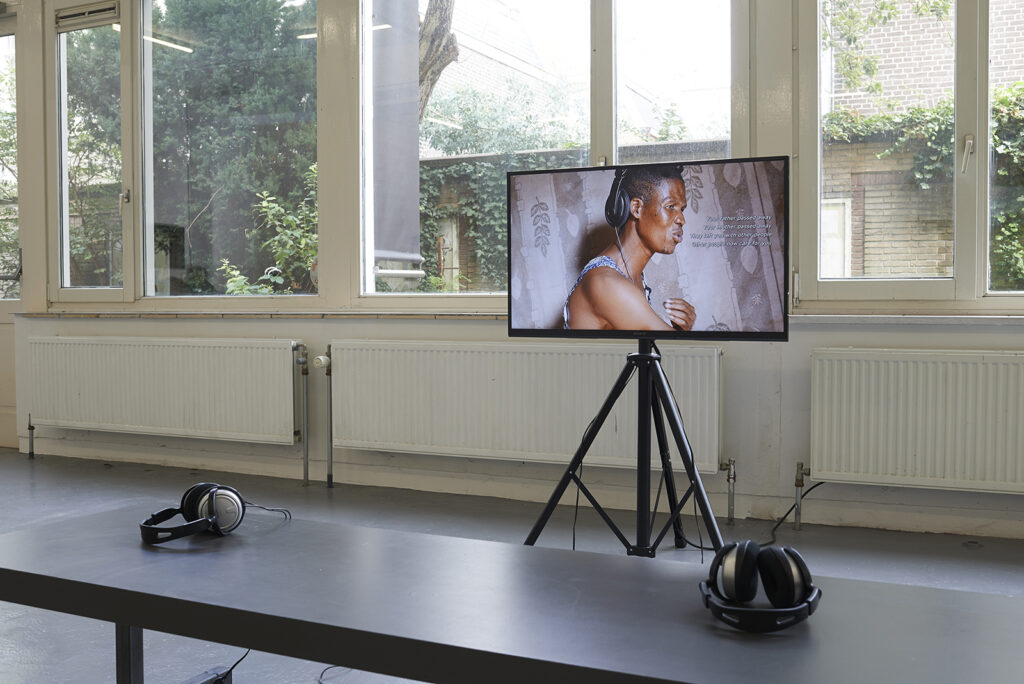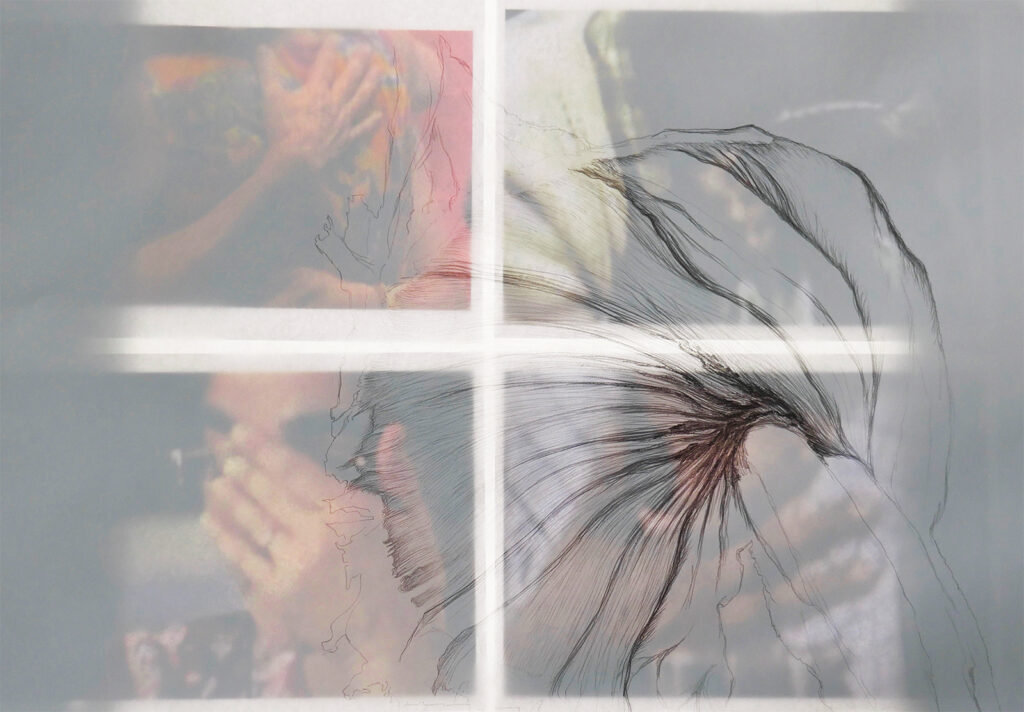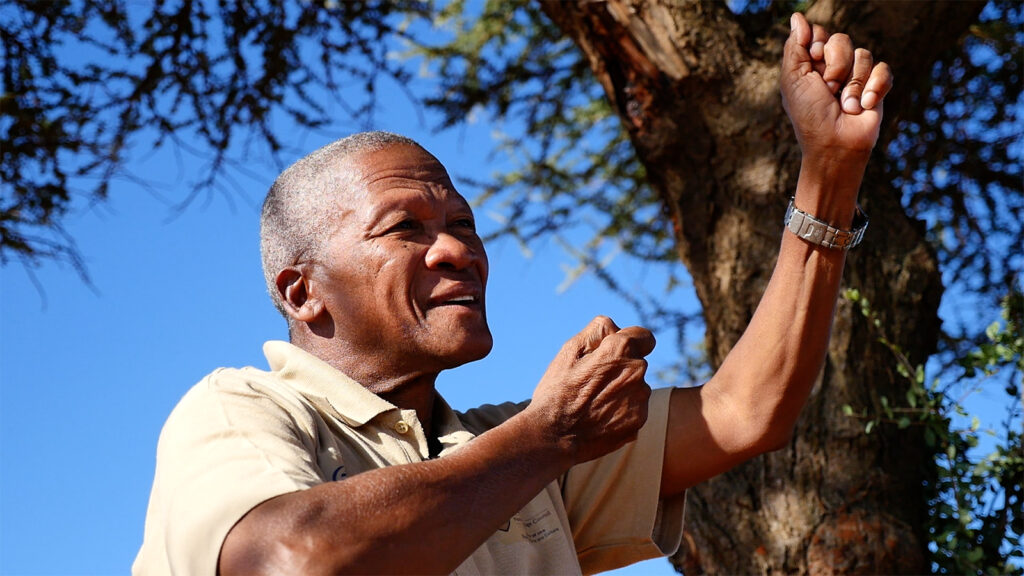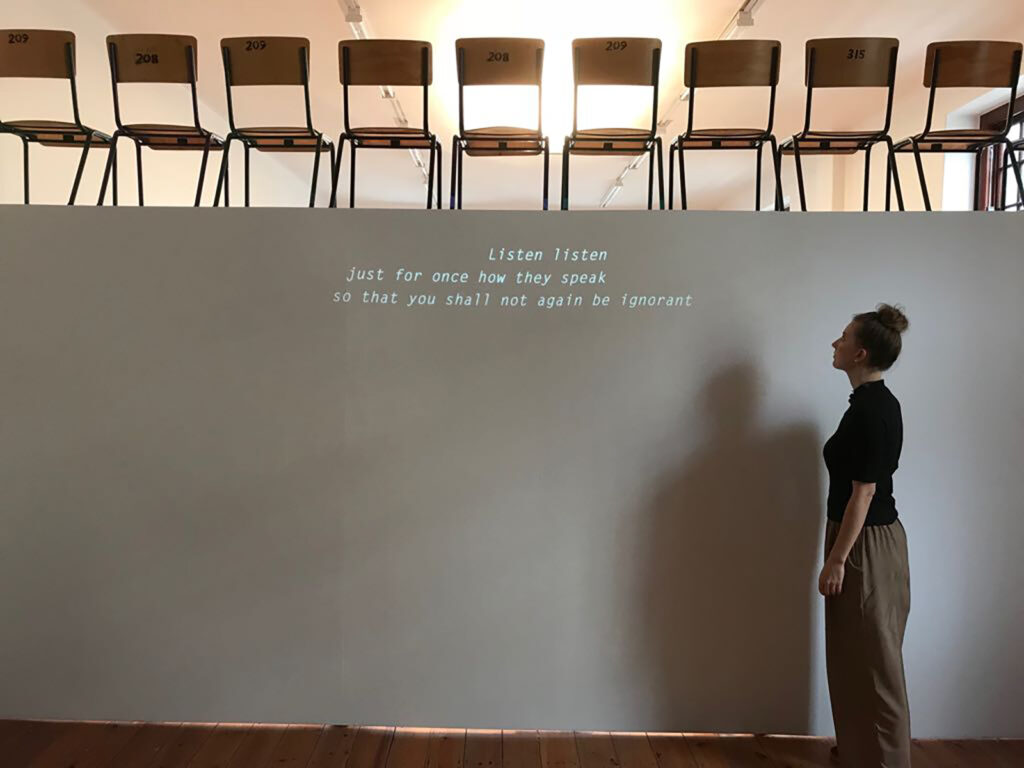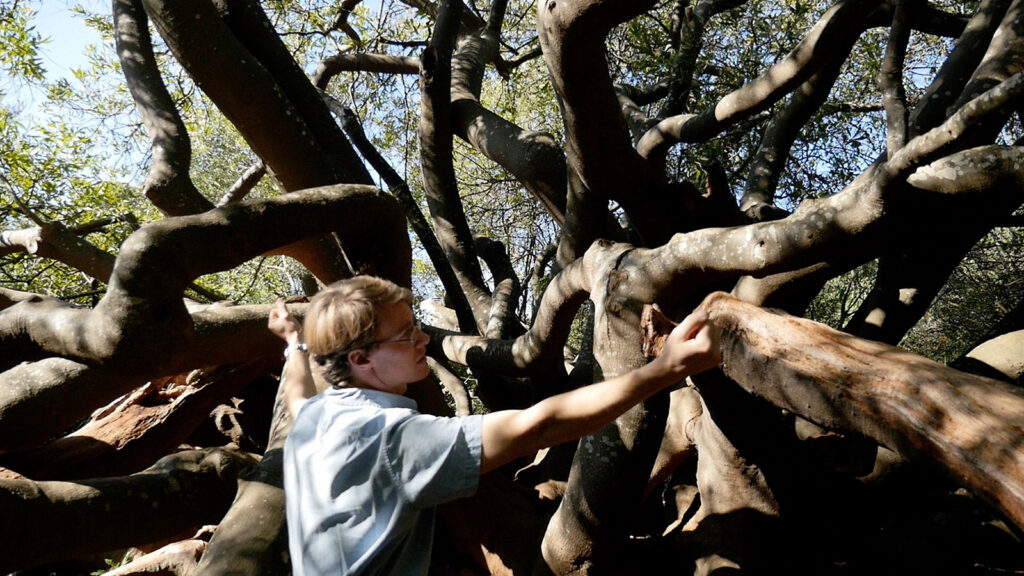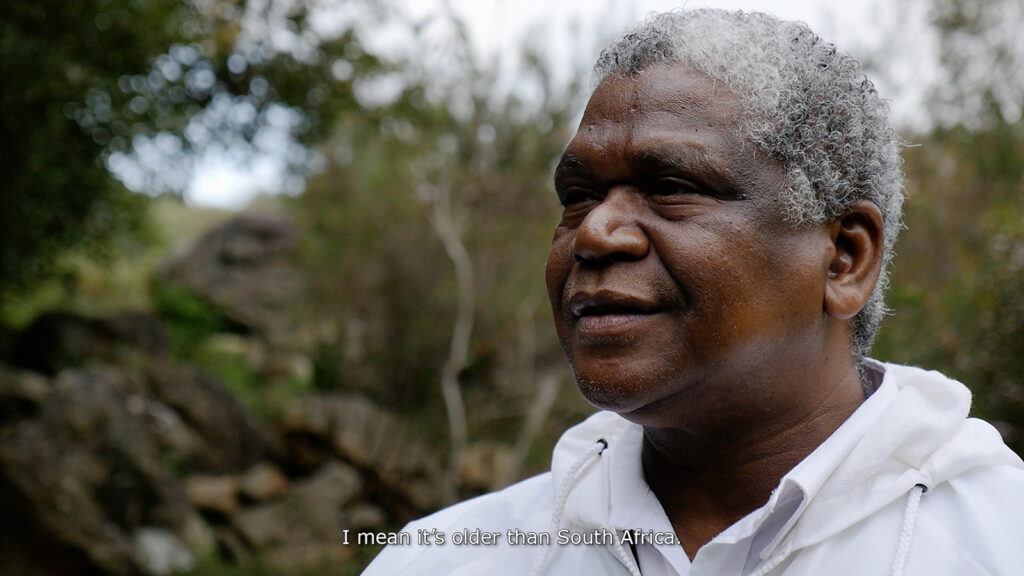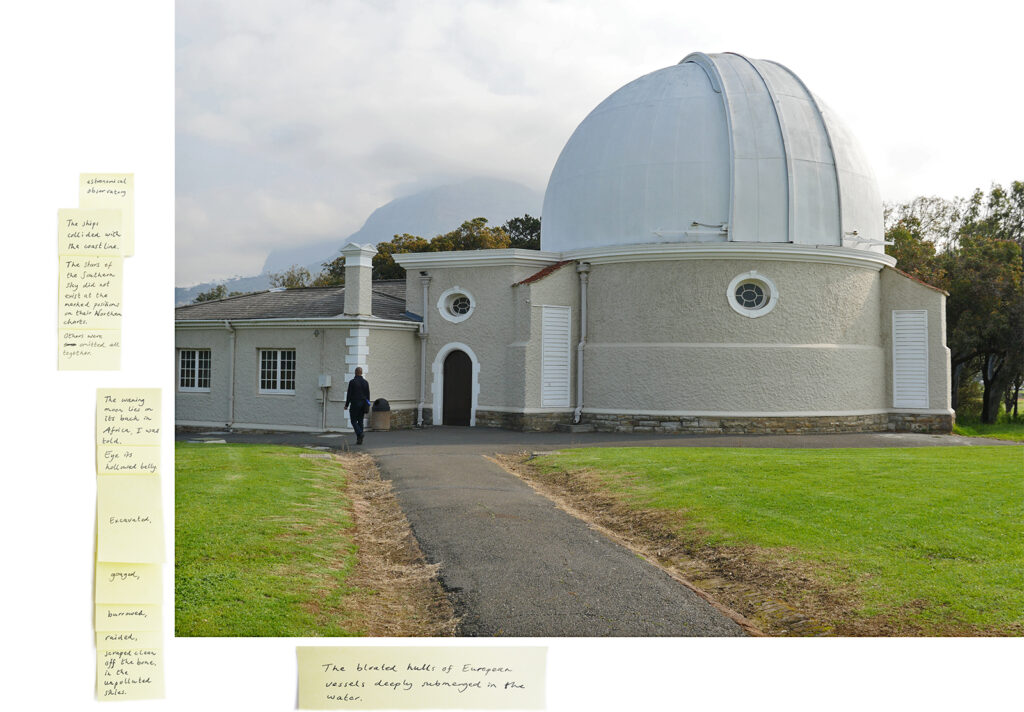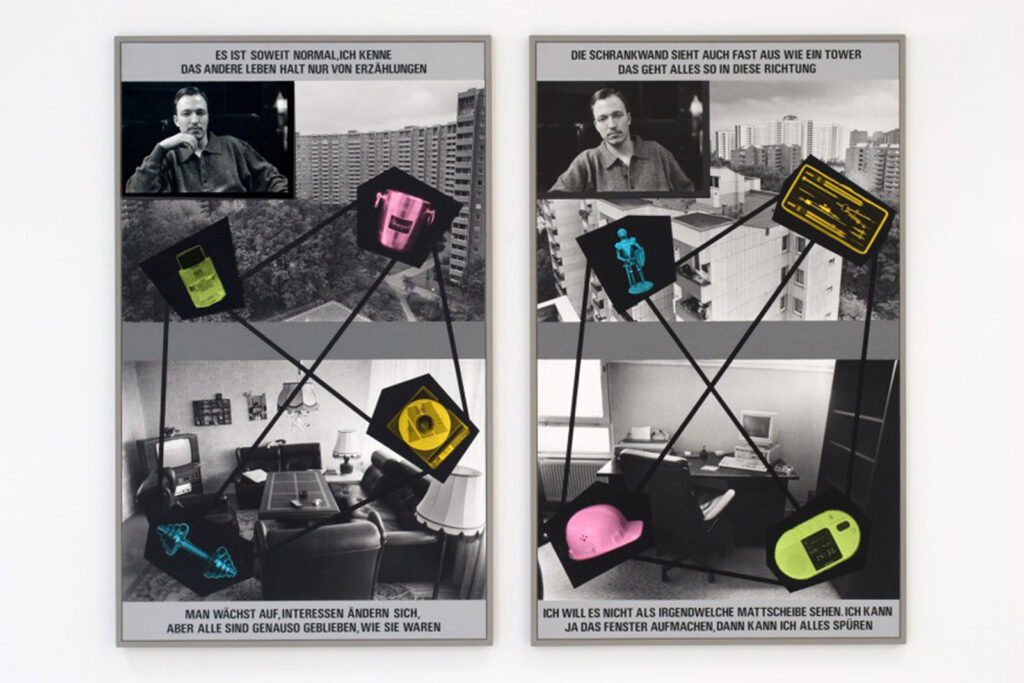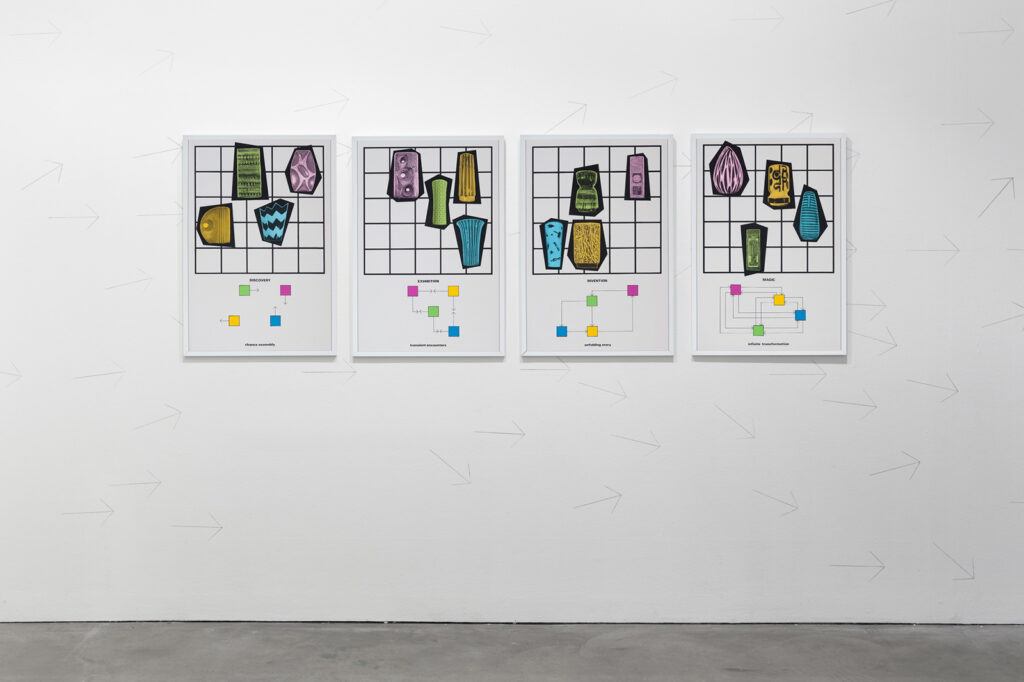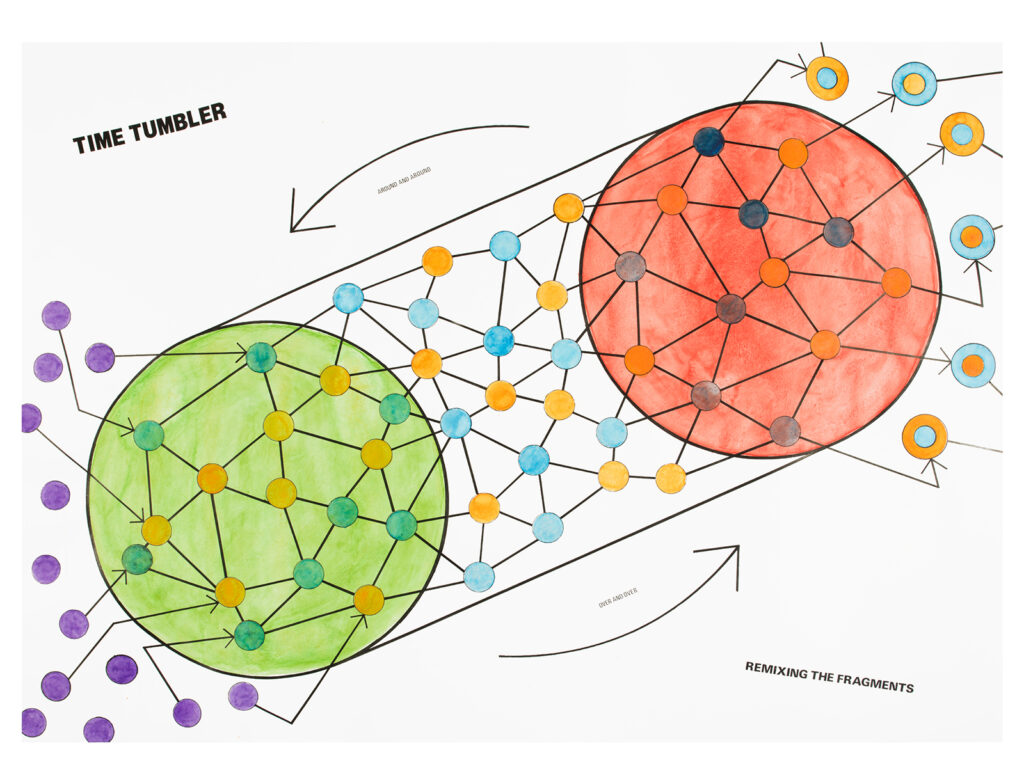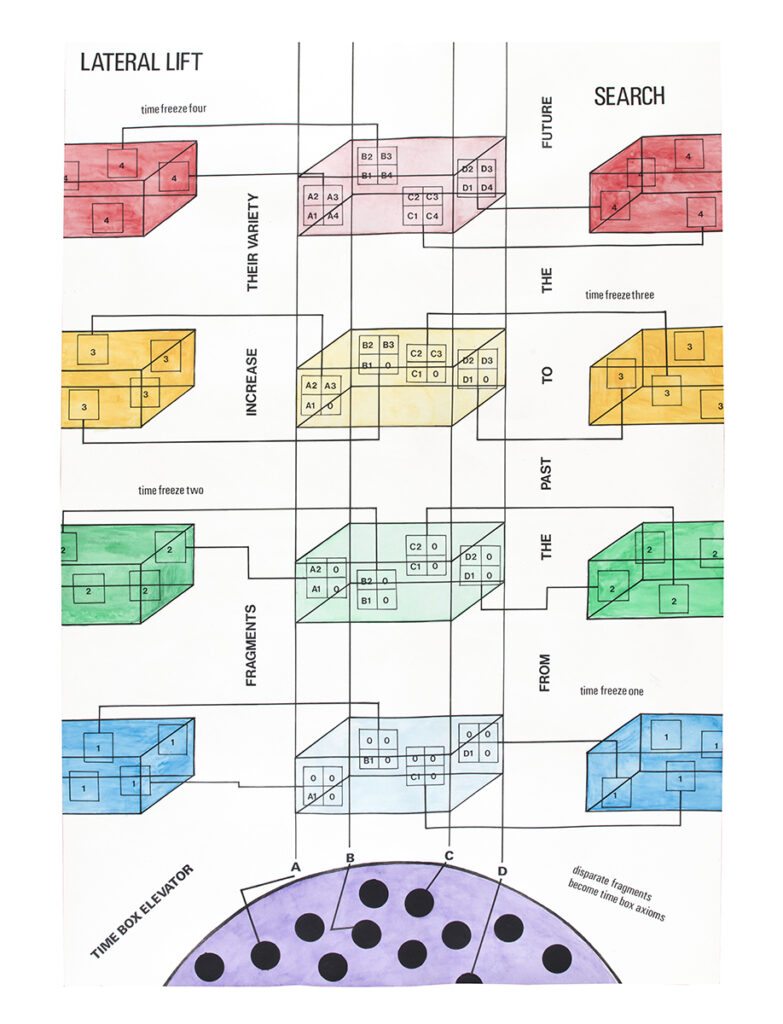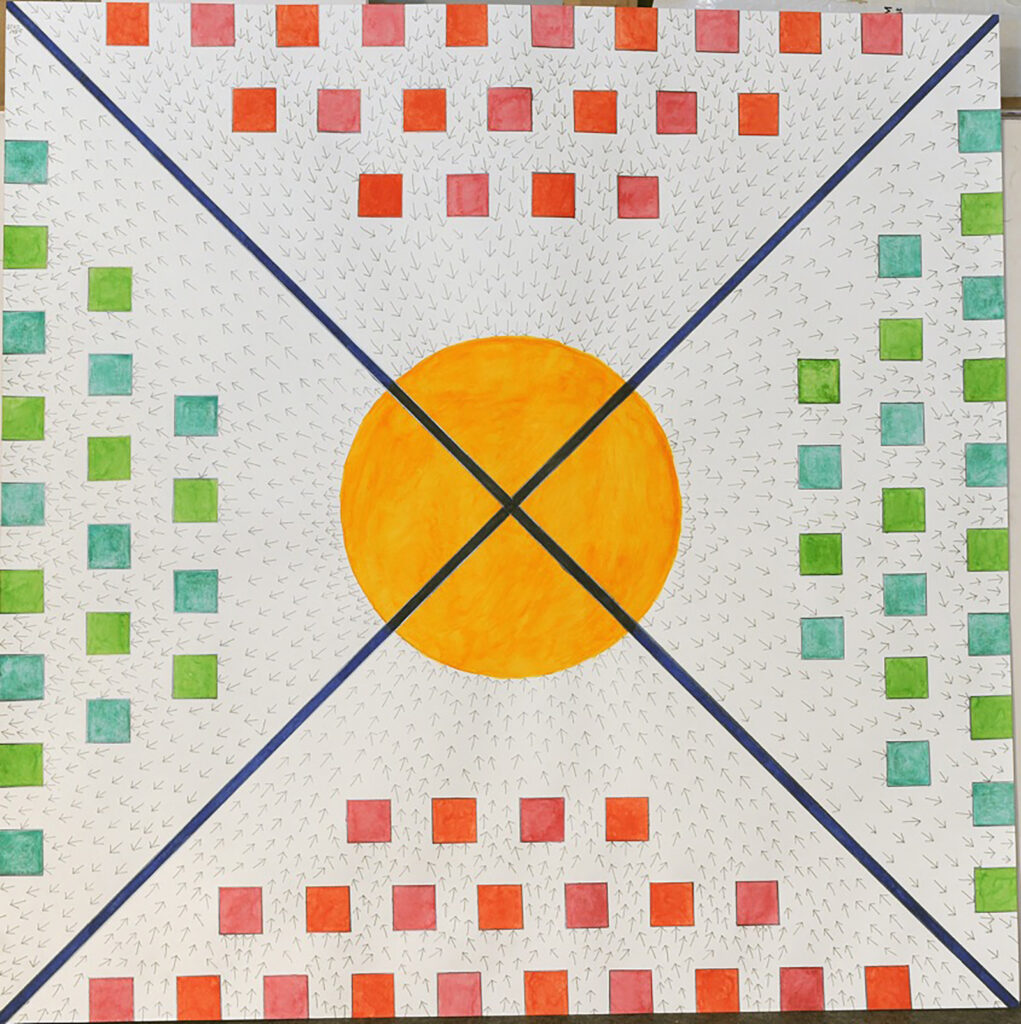- Georges AdéagboPracticeGeorges Adéagbo embraces the visitor who enters his space with a symphony of paintings, books, statues, found objects, magazine and dozens of newspaper clippings. In this ocean of documents that hint at their identical multiples existing somewhere else, Adéagbo’s handwritten texts stand out as a personal and precious original messages.( His handwriting in black pen is neat and obviously meant to be easily deciphered, almost as clear as in a first grade school book. Similar to illuminated manoscripts, he emphasizes the first capital letter of each sentence with additional turns)
While creating his daily installations in his Benin studio, in hotel rooms while on the road, or during exhibitions, Adéagbo spends most of his time writing new texts and integrating them immediately into his visual narration. In his text Adéagbo weaves philosophical reflections with episodes from his personal life, allowing Christian metaphors to appear without any claim of faith, as well as historical events, the relationship between art and nature, the role of the artist, the political present and description of encounters with protagonist from the art scene.
“Art and the force of art: I have to create, and create for creating, I am not the one to talk about the creation I made. To create for creating, it is up to others to see my creations realized, and talk about them…! A creation sees itself with life and a creation that does not have life, it’s not a creation!”
BioBorn in 1942 in Cotonou (Benin).
He lives and works in Cotonou and Hamburg.
After studying law in Abidjan (Ivory Coast) and Rouen (France), Adéagbo returned to Benin in the end of the 60s. By the time he was discovered in 1993 by a European curator by accident, he made daily complex installations in his yard without calling himself an artist. In 1994 he was invited to his first exhibition. From then on he implements his site-specific installations with a team of craftsmen in Benin. In 1999 he participated in the Venice Biennale and was the first artist from Africa to be given an award for his installation at the Campo Arsenale. Since at least 2002, when he presented an In-Situ-Installation as part of the Documenta 11, curated by Okwui Enwezor in Kassel, Adéagbo has become one of the most renowned artists of Africa.
His works can be found in other major collections, i.e. Philadelphia Museum of Art, Toyota City Museum and KIASMA Helsinki. The exhibitions are supported and co-curated by Stephan Köhler (Cultural Forum South-North Hamburg-Cotonou). - Tiong AngPracticeThe work of Tiong Ang spans a wide array of media, from collective performance, experimental film, through video and installation to painting and the display of objects. His practice accross these forms centers around the social, emotional and existential consequences and negotiation of dislocation, disparate identities and diaspora. He addresses multiple gestures of human presence and representation, using social intervention and juxta-position, chance and communality, mockery and disguise. He explores subjective positions in divided, ambivalent, and collective conditions, be it on ethical, ethnic, or sociopolitical grounds. Recurring themes are the impact of mass and digital media on individual perspective and collective memory, and the anxieties evoked by mobility and globalization.
Initially an object/painting based studio artist, from the mid-1990s Ang has expanded his production including experimental film, performative and relational enactments, interdisciplinary collaborations and curated projects. In a divergent practice, he examines authority and sustainability of images and narratives. The common thread in the work is the conflict between detached objectivity and engaged subjectivity; it demonstrates how universal media not only affect our perceptions of places and events but also denote our concept of reality. Elements of selfhood, cultural meaning and social absorption have emerged in a diversity of mediated images. Thus, human perception and behaviour converge in complexities of disparate truths. The persona of the artist, distorted by media based projections, is the ultimate body to explore the human experience.BioBorn in Surabaya, Indonesia in 1961.
Lives and works in Amsterdam.
From 1981 he attended the Gerrit Rietveld Academie (Amsterdam) and from 1988 until 1990 he was resident at the Rijksakademie van beeldende kunsten (Amsterdam). His work has been included in exhibitions in Belgium, China, The Netherlands, Germany, Finland, France, Italy, Spain, Japan, the UK, South Africa, Israel, Indonesia, Austria, South Korea, Australia, New Zealand, India, Burkina Faso, Taiwan and the United States. He participated in Manifesta 8, Murcia 2010, the 2004 and 2008 Shanghai Biennale, the 2001 Venice Biennale, the 1995 Istanbul Biennale and the 1994 Havana Biennale. He is also core lecturer at the University of the Arts (HKU) in Utrecht for the Master's program in Fine Art.Recent ExhibitionsArchive 2024 Collaborative projects 2024 Tiong Ang CV Como Una Bola de Nieve 3#, La Casa Invisible, Málaga, 2022-23 - Group Show Tiong Ang & Company: The Second Hands, MNAC, National Museum of Contemporary Art Bucharest, 2022 Delinking and Relinking, Multisensory collection display, Van Abbemuseum, Eindhoven, 2022 - Group show All Eyes – We Are The Collection, Akzo Nobel Art Foundation, Amsterdam, 2021 - Group show Bridging Realities, Lumen Travo Gallery, Amsterdam, 2018 - Matea BakulaPracticeMatea Bakula (Sarajevo, 1990) is an emerging artist who is often fascinated by the nature and the potential of different materials. In her creating process Bakula is looking beyond the aesthetics of the material she is using. She almost works like a chemist or a physicist that is trying to find the answers of the material’s secrets. She does not only want to know the qualities or limitations of the materials that she is using; she also wants to find out the reasons behind them, like why certain material easily stretches or why another material spreads out in an oval or roundish way and is showing her version of the answers through her sculptures. Bakula’s fascination and respect for chemicals like polyurethane foam and methylethylketon is clearly visible and it seems that the works are the result of a collaboration in which Bakula took the role of a choreographer who by putting it to an extreme is able to find the profound character of the materials.
Through her body of work, Matea Bakula teaches us that matter is never fixed, its identity is fluid and influenced by the artist’s ability and curiosity to explore its infinite potential.BioBorn in 1990 in Sarajevo.
Lives and works in Utrecht, The Netherlands
Recent shows include: solo exhibition at Buitenplaats Doornburgh, Maarssen (upcoming, 2024), “Eartheaters”, Lustwarande (2023); “A Wheel A Rope A Stone A Wing”at Park, Tilburg (2023); Art Rotterdam 2021, “Collector's Item”, Centraal Museum, Utrecht (2021); “One eye and two takes on vulnerability” with Milena Naef, Lumen Travo Gallery Amsterdam (2020); “Reflections on Nature” group show, Lumen Travo Gallery, Amsterdam (2020); “Between grace and fury”, solo show, Kunstvereniging Diepenheim, Diepenheim (2018). Art Cologne (2018); Prospects and concepts, Art Rotterdam (2018); "The chemistry between dr. Frank and me", Lumen Travo gallery (2017); “Work Title Festival”, Les Brigittines, Brussels (2016); “Let us meet and let us meet again”, Casco, Utrecht (2016); “Work Title Situation #3”, Work Space Brussels, Brussels; “I wish I never kissed that frog”, Jeanine Hofland, Amsterdam (both in 2015); Matea Bakula, GAVU, Cheb, (Solo), Started, Czech Centres, Prague (both in 2014); Start Point Prize, Arti et Amicitiae , Amsterdam which travelled to KASK, Ghent and Dox, Prague (2013-2014); Formal Attire, Kunstpodium T, Tilburg (2013), Best Of Graduates Exhibitions, Ron Mandos, Amsterdam (2013), among others.
In 2013 Bakula was the recipient of the Startpoint Prize: Best European Emerging Artist in Prague. Matea, as a young artists and emerging talent in the Dutch scene, was also part of the Mondriaan Fund’s Prospects & Concepts at Art Rotterdam 2019.WebsiteRecent ExhibitionsMatea Bakula CV Matea Bakula's Portfolio Eartheaters - Lustwarande (2023) Family Jewels - Horizonverticaal, Haarlem (2023) A WHEEL A STONE A ROPE A WING Duo-show with Ruta Butkute - Park, Tilburg (2023) Four Positions, group show - De Apotheek, Amsterdam (2021-22) Het Utrecht Archief (2020) One eye and two takes on vulnerability - Lumen Travo Gallery (2020) Reflections on Nature - Lumen Travo Gallery (2019) Between grace and fury - Kunstvereniging Diepenheim (2018) - Atousa BandehPracticeDriven by the fascination for demolished buildings and abandoned landscapes, Atousa Bandeh Ghiasabadi dwells upon the relationship between artificial and natural, raising poetic yet firm reflections over our present. Torn plastic bags caught in the bushes or construction sites with left pipes and tires and electricity poles witnessing what once was. Overwhelmingly deserted landscapes where the traces of human can be seen through all the industrial left overs.
Her drawings, videos and film works are stories delved in the ephemeral layers of her memories. She throws her images almost literally onto the paper -images of objects and portraits that conceal a profusion of symbolic associations. Personal memories tend to pop up not in a clear-cut way, but blurred, vague and deformed. Rather than representing a plain narrative, Her works represent visual poetry. Life, her life is caught in lyrical lines. Expressed in feathery layers of papers and moving images.
"Bandeh searches and establishes the psychic space in the social life under the reign of idealisms, trace them in the buildings of the past, in the barren forgotten landscapes. Bandeh sees subjectivity as a part of her humanity and accepts the what she sees as a mirror of the internal psychological world. She alerts us of the state in which if poetry won’t be employed and increased, we are left with a voiceless man, crying at his defeat against himself."
Sam SamieeBioAtousa Bandeh (1968, Iran) studied Visual Arts from 1992 to 1995 at the Minerva Art Academy in Groningen and received her MFA in 2002 at the Sandberg Institute in Amsterdam, graduating in video and film. Recent exhibitions include: solo show “Doubt” at Lumen Travo Gallery (2021); group exhibition at Drentse Museum, Assen (2020); group exhibition “Untitled (Spirit of Changing Times) at Lumen Travo Gallery Amsterdam (2020); Sculpture Biennial Tehran (2020); Invisible present tens III AG Gallery Tahran (2019); "History as a Poem" at Drents Museum (2018); “Dialogues” Manifesta office Amsterdam (2017); “Preplexity” Alloy Dazibao Montreal, Canada (2018).Website - Rachid Ben AliPracticeRachid Ben Ali (Morocco, 1978) is a Dutch-Moroccan surrealist painter known for his emotionally charged and dynamic works on paper. His work often radiates a sense of dreamy nostalgia, with fluid drips of paint running freely, evoking powerful scenes inspired by contemporary politics, society, and history.
Through expressive brushstrokes and layered textures, Ben Ali explores themes of identity, memory, and the human experience, inviting viewers into a world where the past and present merge in a vibrant, almost dreamlike visual languageBioWebsite- Guillaume Bijl
PracticeGuillaume Bijl transforms spaces: a museum room is turned into a carpet shop (Stedelijk Museum, 1985) or a rifle range, a gallery becomes a private house. These works are also a staging of a situation. At a certain moment, Bijl’s art was labeled ‘Shopping Art’, together with artists like Haim Steinbach and Jeff Koons. But Bijl’s work is certainly not uniquely dealing with the consumer society, making this label not very apt to categorize his work. His art is critical about developments in our society and these have a broader scope than the consumer’s world alone. In the nineties, for instance, he created installations in which he’s dealing with ‘cultural tourism’. He belongs to the forerunners who, in the 80-ies of the last century, have given a new impetus to the ready made. In general, Guillaume Bijl shows us the archeology of our ‘civilization’, that is: now.
ʻAlmost all my compositions are called ʻComposition Trouvéeʼ. This name came about at the installation of a composition in 1983, The term ʻComposition Trouvéeʼ alludes to the existing ʻObjet Trouvéeʼ- term, in the sense that each of these is a consciously compiled and recognizable composition – a previously existing, found one, ʻso to speakʼ. They are chunks of reality that vary from trivial consumption and interior fragments to pseudo-public manifestation décors. The Compositions are a logical consequence of the way in which I manipulate themes and materials in my larger installations.These Compositions, however, are devoid of all situational pretentions. I myself would describe the relationship in my oeuvre between the compositions and installations as follows: If I were to interpret my larger installations as ʻlarge tableauxʼ, my compositions would relate to them as sketches or small drawings. In general, I wish to regard tem as present-day, archeological still lifes.ʼBioBorn in 1946 in Antwerp, Belgium.
Lives and works in Antwerp.
Guillaume Bijl’s first exhibition was Dokumente at Olbricht in Kassel in 1982, and the most recent exhibition was at ART BASEL UNLIMITED in 2023 with Galerie Nagel Draxler and Meredith Rosen Gallery. Guillaume Bijl is mostly exhibited in Belgium, but also had exhibitions in Germany, Netherlands and elsewhere. Bijl has 33 solo shows and 213 group shows over the last 39 years (for more information, see biography). Bijl has also been in 18 art fairs and in 11 biennials. The most important show was 53rd International Art Exhibition Venice Biennale / Biennale di Venezia at La Biennale di Venezia in Venice in 2009. Other important shows were at Biennale of Sydney in Sydney, NSW and Documenta in Kassel. Guillaume Bijl has been exhibited with Jan Fabre and Marcel Broodthaers. Guillaume Bijl’s art is in 11 museum collections, at Museum voor Hedendaagse Kunst Antwerpen (MuHKA) in Antwerp and Universalmuseum Joanneum in Graz among others.WebsiteRecent ExhibitionsGuillaume Bijl CV ART BASEL UNLIMITED 2023 with Galerie Nagel Draxler and Meredith Rosen Gallery 4 Installations & Sorry's - Exposition D'Art Contemporain Halle Verrier/Meisenthal, France (2022) Compositions and Sorry's - solo show at Lumen Travo Gallery, 2022 Solo exhibition at Keteleer Gallery, Antwerp, Belgium, 2022 Multiples & Editions, Solo show at Royal Academy of Antwerp, 2021- Ade Darmawan
PracticeAde Darmawan’s own art explores his country, Indonesia, its history and, most importantly, its people. His installations are based on a study of the life cycle of everyday objects, collected from, both, home and industrial consumption. Embedded in these found objects and collages are narratives about national ideologies and aspirations, as well as parallels with similar capitalist ambitions. Ade often turns the spotlight on what he calls “minor histories”— events that in themselves may not possess historic relevance but, in the aggregate, make up a community’s past.
On the occasion of his most recent solo show at Lumen Travo Gallery (“Doing business with the Dutch”, 2018) Darmawan has been looking into how a society comes to an agreement as a nation and works together to sell itself as human capital, by consciously constructing a national identity and by presenting it as a value for economic trade. The act of this structured trade created trends and produced certain objects and stories, that are often re-intrepreted and misintrepreted. The installation presented in the show is inspired by books and images -strictly produced by the Dutch about Indonesia from the 1800-1900 and by the contemporary trading culture in the Netherlands- and presented as a design of a domestic interior.BioAde Darmawan lives and works in Jakarta as an artist, curator, and co-director of GUDSKUL Jakarta.
He studied at Indonesia Art Institute (I.S.I), in Graphic Art Department.
In 1998 he stayed in Amsterdam, Netherlands, for a two years residency at the Rijksakademie Van Beeldende Kunsten. In 2016 he was one of the participating artists of Gwangju Biennial and Singapore Biennale. From 2006-2009 he was a member of Jakarta Arts Council, in 2009 he became the artistic director of Jakarta Biennale, and from 2013-2017 he is the executive director of Jakarta Biennale.
Since 2000, he is the co-founder of the Jakarta-based initiative ruangrupa, which focuses on visual arts and its relation with the social and cultural context especially in urban environment. ruangrupa as an artists’ collective platform have participated in Gwangju Biennale (2002), Istanbul Biennale (2005), Asia Pacic Triennial Brisbane (2012), Sao Paulo Biennal (2014) , Cosmopolis #1: Collective Intelligence in Centre Pompidou (2017) and in 2016 ruangrupa curated Sonsbeek International in the Netherlands.
The collective has been chosen to curate Documenta 15, which will happen in Kassel in 2022.Website- Yvonne Dröge Wendel
PracticeDröge Wendel is concerned with the relationship between people and objects, and the quest for challenging new ways of relating to things. Dröge Wendel sets up experimental encounters and aims to capture what it is that objects actually do.: "Things have character, feelings, we cherish them, we adore them, but exactly how they affect our lives, we don't really know."
This interest also comes reflected in her performances and projects. For example, in 1992 she married a cupboard from the Wendel company, which belonged to her mother, and went on a honeymoon with it. She has since called herself Dröge Wendel. Two years later, she went on a pilgrimage with her Renault, to have the car blessed by the Pope on St. Peter's Square. With the project she won the second prize of the Prix de Rome in the Visual Arts/Theatre category.
Projects such as Black Ball (2000) and Item Store (2008) are about the public's interaction with the objects that Dröge Wendel offers and the relationship that arises between people and things.BioYvonne Dröge was born in Germany to Dutch parents. She studied English at the Westfälische Wilhelms Universität Münster. She continued her education at the Gerrit Rietveld Academy (1987-1992). She was artist in residence at the Rijksakademie van Beeldende Kunsten in Amsterdam (1993-1994) and later at the Delfina Studios London (2002-2003). In 2009 she became a senior lecturer at the Rietveld Academy.
Dröge Wendel conducts PhD research at the University of Twente into the relational and performative possibilities of things, with Prof. Peter-Paul Verbeek as supervisor.
In 2016, the Dr. AH. Heineken Prize for art awarded to her, the jury called her work original, inventive and vital.Website- Ani Eloyan
PracticeImage or the creation of the image is something that interests Ani as a phenomenon. She can never create the 'image' as we know it, but, instead, an explanation of the meaning of the ' image'. The cartoon language confronts and questions the issues of humour, class, aesthetics and social acceptability, this capacity of the cartoon language gives us permission to laugh about things we should not be laughing about. Her works extend the notion of how humour can tell us something about our understanding of that nature but as well the limit of our understanding. The cartoon language caresses the knowledge of how one can be so accurate and factless at the same time, the image as an artifact, as something made, on the other hand, the image of the world as 'drama', in which all the things are "acted" just like the cartoon language operates. As a myth of the basic image we have of ourselves; the soul, ego and mind. The artist tests what this manipulation means and how she can push this perception even further.BioBorn in Armenia (Yerevan) in 1988.
Lives and works in Amsterdam.
From 2006 Eloyan attended the Gerrit Rietveld Academy in Amsterdam. In 2010 she won the prize for the Fine Arts Department pf the academy.
Recent exhibitions include: group show “Flowers, candles and crucifixes” at Lumen Travo Gallery, Amsterdam (2019), solo show at Francis Boeske Projects, Amsterdam (2017); show with Rini Hurkmans at Lumen Travo Gallery (2015).
Her work is part of a number of collections including the Gemeentemuseum The Hague and AKZO Nobel The Netherlands.Recent Exhibitions- Meschac Gaba
PracticeMeschac Gaba is a Beninese conceptual artist based in Rotterdam and Cotonou.
He explores themes of globalization, consumerism, and the Western museum through acts of artistic appropriation and a provocative approach. His installations of everyday objects whimsically juxtapose African and Western cultural identities and commerce.
Gaba pinpoints manufactured cultural hybridization, as one of the signs of capitalism run macroeconomics. Therefore, Gaba’s artworks correlate cultural forms to economics’ standard exchange items, i.e. money, industry – manufacture, trade, labour work; manifesting with irony and charm these trade-offs (between exchange of goods and human values) through the notions of cultural alteration, creolization of cultures. Behind though, his works express a sensitive support for human life, richness and local creation.
He is best known for The Museum of Contemporary African Art 1997–2002, an autobiographical 12-room installation acquired and displayed by the Tate Modern in 2013.BioGaba was born in 1961 in Cotonou, Benin. He studied at the Rijksakademie voor Beeldende Kunsten in Amsterdam in 1996-97.
Meschac Gaba has been exhibiting throughout international platforms and exhibitions, such as the Witte de With in Rotterdam, the Sao Paulo Biennale, the Center Pompidou and the Venice Biennale. Some of his recent shows include “The Restless Earth” at Fondazione Nicola Trussardi (Milan), “Museum of Contemporary African Art” at Tate Switch House (London), Value, Staatlichen Kunsthalle Baden-Baden (Germany) and Kunsthaus Zurich (Switzerland).
Gaba's survey exhibition Museum for Contemporary African Art & More showed at the Museum de Paviljoens in Almere, the Netherlands; the Kunsthalle Fridericianum in Kassel, Germany; and the Centro Atlántico de Arte Moderno in Las Palmas, Canary Islands, in 2009/10.
Notable group shows include The House of Opportunity, S.M.A.K, Ghent, Belgium (2020); Risk, A4 Arts Foundation, Cape Town, South Africa (2019); The Warmth of Other Suns: Stories of Global Displacement, Phillips Collection, Washington DC, USA (2019); Leaving the Echo Chamber, the 14th Sharjah Biennale (2019); African Metropolis. An Imaginary City at MAXXI, Rome (2018); Enchanted Bodies / Fetish for Freedom at Galleria d'Arte Moderna e Contemporanea, Bergamo (2018); The Red Hour, 13th Dakar Biennale (2018); More for Less at A4 Arts Foundation, Cape Town (2018).Recent ExhibitionsMeschac Gaba CV Citoyen du Monde, Stevenson, Cape Town, 2021 Money, money, money, Stevenson, Cape Town, 2021 The Return of the Real, Tanya Bonakdar Gallery, New York, 2020 Songs in the Dark, Tanya Bonakdar Gallery, New York, 2020 Man in Money, In Situ Fabienne Leclerc, Paris, 2017 Bank or economy, Stevenson, Cape Town, 2016- Dianne Hagen
PracticeDianne Hagen’s works have no titles. They are rightly named after the materials or parts they are composed of, because these works are not sculptures nor objects manufactured from raw material or made with a purpose or a function that would give them unity or clarity. They do not get round to the unity of a name and the clarity of language. Since they have no name, they can not fit in a whole either: the works do not look for contact with their “environment” or the world, nor with each other. The works cannot be “installed”.
Hagen’s works are compositions which, since they give no evidence of an underlying geometry and do not visualize a concept, appear to be amorphous and fragile and not justified.
From ‘Groene Pasen’ by Bart Verschaffel
The recent series “ Aux Bain Marie” (2020) shows the evolution of Hagen’s style: through means of perspective, hidden and unfolding and through diligent, almost meditative, painterly labor, Hagen wants to blur the boundaries between abstract and figurative, in order to disrupt, to assume, to feel, to imagine. In these works, the use of realism is provocative: a sunset, a streaming river, a flower, are here depicted though the lens of false romanticism. The suggestiveness is a tool for conflicting interpretations and for highlighting the inherent freedom of ambivalent scenarios that can resist single interpretations. The sum of partly recognisable elements plays with emotions of longing, desire, judgment, power, love and condemnation. The viewer doesn’t get round to one reading or statement. There is no puzzle to be solved or descriptive, didactic or moralists’ lessons to be taken from it. It only involves the person who looks at it.BioDianne Hagen (1964,The Netherlands) studied at the Rietveld Akademie and followed the two-year residency at the Rijksakademie in Amsterdam.
Her work is in the collection of Stedelijk museum Schiedam, the Rijksakademie and in private collections in Holland, Canada, America, Belgium, France and India. She had solo and groups exhibitions in among others: Stedelijk museum Schiedam, STUK museum Leuven, Belgium, CRAA Centro Ricerca Arte Attuale, Verbania, Italy, museum De Appel, Amsterdam, Museum Dhondt-Dhaenens, Belgium and Kunstinstituut Melly (formerly known as Witte de With), Rotterdam.
Her work was shown at Art Basel, Art fair Chicago and Brussel art fair.
Together with late Sanjeev Sinha she co-organised/curated the international Art & World peace project at Bodhgaya, India.Website- Ni Haifeng
PracticeNi Haifeng’s practice stems from an interest in cultural systems of return, exchange, language and production. Through mediums of photography, video and installations, Ni explores the simultaneous creation and obliteration of meaning while drawing attention to the cyclical movements of people, products and goods that are often reflective of patterns of colonialism and globalization.
The concept of uselessness, seen in the desire to offset ‘the production of the useful’ that is central to the operative conditions of consumerism and the ‘dominant economic order’, plays a key role within Ni’s practice, lending his works a distinct political and social dimension
“As a critical and engaged conceptual artist who does not neglect the visual appearance of his work, Ni Haifeng has a prominent place within contemporary art. In his poetic, multifaceted work he is able to couple a radical conceptualism to a certain Baroqueness and drama in the visual language.
Any lurking threat of ponderousness in his emotionally charged choice of subject matter is knocked on the head by a light Dadaist irony that is never too far away from his work. By simple interventions in fixed patterns of looking and expectations, he continually enables the viewer to see the world with fresh and amazed eyes. The creation of such confusion and subversion is possibly his most important artistic premise. By making the ambiguity of things manifest, he demonstrates that reality always lends itself to more than one interpretation.”
Roel ArkesteijnBioNi Haifeng was born in 1964 in Zhoushan, China. In 1986, he graduated from Zhejiang Academy of Fine Arts, now the China Academy of Art. He currently lives and works between Amsterdam and Beijing.
Before immigrating to Europe in the 1990’s, Ni Haifeng graduated from the Zhejiang Academy of Fine Arts (now the China Academy of Art) in Hangzhou in 1986, Ni joined Red 70%, Black 25% and White 5% - a group of artists working with conceptual art and nonsense text.
Recent shows include the solo exhibition “The Para-Textual” at In Situ- fabienne leclerc, Paris (2017); Manifesta Biennal, Amsterdam (2017); ART Basel Hong Kong (2016); solo show “Asynchronous, Parallel, Tautological et Cetera”, Pearl Lam Galleries Hong Kong, Hong Kong (2015).WebsiteRecent ExhibitionsNi Haifeng's CV Ni Haifeng's Portfolio In the Labirinth of Freedom - Lumen Travo Gallery (2023) Moving Stories, de rijkdom van de Limes, group show - Museum Het Valkhof Nijmegen, Netherlands (2022) Vrijdenkers: van Spinoza tot nu, group show - Amsterdam Museum (2021-22) The Para Textual - In Situ fabienne leclerc (Paris, 2017) BRIC à brac: The Jumble of Growth, group show - Today Art Museum (Beijing, 2016) Permanent Abstraction : Epiphanies of a Modern Form in Escaped Totalities, group exhibition - Red Brick Museum (Beijing, 2016) Renewed Past, group exhibition - Coda Museum (Apeldoorn, 2016) Asynchronous, Parallel, Tautological et Cetera - PearlLam Galleries (Hong Kong, 2015)- Rini Hurkmans
PracticeFrom the beginning of her career, Rini Hurkmans is concerned with topics such as absence, loss, disruption, alienation and the related concepts of safety, security, identity and compassion. This can be found in the recent solo exhibition she brought to Lumen Travo Gallery, titled “Pietà, a reconsideration of the Gesture” (2020). On such an occasion, Hurkmans begun a further research into the concept of loss in relation to ethics and politics and is developing new work based on her working period as Artist in Residence at the Royal Netherlands Institute in Rome in 2019. Her research into the press photo she bought in 1992, and which inspires her work ever since, of the moment Michelangelo's Pietà was attacked in 1972, serves as the starting point for the work in progress.
Life, art and politics are intertwined in a continuous dialogue and each specific period requires its own thoughts, strategies and forms. Hurkmans initiated the conceptual artwork Flag of Compassion in 2002 out of the desire to go beyond the framework of cultural consensus and consumption. Since 2008, she is an advisor to the Unda Foundation, the foundation that manages the artwork and also organizes a series of Making Waves events around themes related to Flag of Compassion. By engaging with the Flag, it is investigated how a work of art can activate ethical questions in society and how it can function both within the arts and in society. Hurkmans is the driving force behind the book Compassion. A Paradox in Art and Society (Valiz, 2017) in which Flag of Compassion is discussed as a case study.BioRini Hurkmans was born in Deurne in 1954, the Netherlands.
She studied at the Academy for Visual Art Education in Amersfoort from 1974 to 1977 and from 1977 to 1981 at the Academy for Art and Design, St. Joost in Breda. Her first museum solo exhibition is “Rini Hurkmans: Current Events” at the Stedelijk Museum Amsterdam in 1991, after which she lives in New York from 1992 to 1993 and participates in the international studio program of MoMA, P.S.1. Hurkmans is regularly visiting lecturer and artist in residence in the Netherlands and the USA, including New York, Boston and Minneapolis. Since 1990 Hurkmans is a teacher and mentor at the Gerrit Rietveld Academie in Amsterdam and she initiates several exhibitions and round table discussions with students and alumni. From 2010 to 2017 she participates in the research group of LAPS, Research Institute for Art and Public Space, Amsterdam. Her work is included in many outstanding public and private collections. In addition, she realizes important public commissions in the Netherlands and abroad, including a sculpture for the ‘Parque de la Memoria’ in Buenos Aires (presently under construction). Currently she lives in the Netherlands and France.WebsiteRecent Exhibitions- Kristiina Koskentola
PracticeIn her recent work Kristiina Koskentola explores modes of knowledge production, polyvocal subjectivity, and agency of multiple co-actors (human and nonhuman), often through “peripheral”, spiritual, or forgotten ecologies, different temporalities and geographies. Her research-based, multi-disciplinary practice spans across various media including video, installation, interactive performative (cooking) projects, publications, and lectures. Her work is in close connection to posthuman/post anthropocentric discourse. Transcultural and monistic perspectives, coexistence, and human relationships with our co-beings and surroundings are at the core of her practice. Often engaged in collaborations she asks how an artist can mediate and propose more inclusive relations, inclusivity and alternative perspectives among the complexities of entanglements, fragilities, and human failure unfolding between immediate, global, and cosmic processes.BioFinnish born Kristiina Koskentola earned her PhD in 2017 from the University of the Arts London, Chelsea College of Arts. Currently, she divides her time between Amsterdam, Helsinki, and Beijing, where she has overwintered for over a decade.
Koskentola has exhibited, conducted talks, screenings, lectures, and workshops in diverse venues and contexts including Three Shadows Photography Art Center in Beijing, Temporary Gallery, Cologne, Lumen Travo Gallery, Amsterdam, Zendai MoMA Shanghai, Skaftfel Centre for Visual Arts, Iceland, MACBA Barcelona, Gallery Hippolyte, Helsinki, Bio Art Society Helsinki, Sonic Acts Academy, University of Amsterdam, Goethe-Institut Beijing, Museum De Lakenhal/Scheltema, Leiden, Charlois Speciaal, Rotterdam, Huangbian Station, Times Museum Guangzhou, University of Amsterdam, 4th Baku Biennial of Conceptual Art in Azerbaijan, Central Academy Beijing, Finnish Academy of Art Helsinki, University of the Arts London, University of New Hampshire, Dutch Art Institute, University of Pittsburgh, Himalaya’ s Art Museum Shanghai, General Public Berlin, and Dushanbe Art Ground,Tajikistan.
In 2019 and 2020, she contributed to Frame Contemporary Art Finland’s Rehearsing Hospitalities program.
In 2021, she participated in Macao Biennial, curated by Qiu Zhijie.
Her works can be found in important collections at Kiasma Museum of Contemporary Art, Helsinki, and Kone Foundation, among others. Her work is presented by Lumen Travo Gallery and Lima Media Art, Amsterdam.Website- Monali Meher
PracticeMonali Meher's artistic and professional practice is deeply rooted in performance and site-specific installations. In her 1998 performance, "Reflect: A Personal Window Display," she emphasized the impermanence of nature and the fluid boundary between life and art. Meher transforms materials to engage viewers and spaces, exploring themes of identity, memory, and transformation. Her work blends personal and collective memories, longing, belonging, and the familiar with the unfamiliar, creating immersive experiences that challenge perceptions of time and space.
Over 25 years, Meher has employed her body, voice, and various props in performances that often involve audience participation, depicting cycles of destruction and renewal. Her installations incorporate natural, ephemeral materials that highlight the transient nature of existence. In her recent works, such as the "Quarantine-series" and "Unknown Landscape," she reflects on themes of migration, loss, and transformation, using mixed media, glass, and natural elements to create dynamic, evolving assemblages.
Meher's backward walking performances, like "In Search of a Lost Monastery," combine ritualistic movements with environmental observations, fostering a meditative connection with her audience. Her art consistently explores the intersections of personal and global narratives, materiality, and the passage of time.BioPune, India, 1969
Lives and works in Ghent, Belgium.
In 2000 Meher was a resident at the Rijksakademie in Amsterdam. She has partecipated in several international exhibitions in Glasgow, Dubai, Venice and Istanbul.
Recent shows include "Upcycling" at Sinop biennale, Turkey (2022); "Hidden Structures" Anderlecht, Belgium (2021); "Living, Forgiving, Remembering", Kunsthall 3 14, Bergen, Norway (2021); "Ben Cobra", Cobra Museum, The Netherlands(2020);
"Falling Star" CJK, Mariakerke, Ghent, Belgium (2019); “Roots and Threads, Borders and Pieces” at Lumen Travo Gallery (2017).
In 2013 Meher received the Golden Chimera Award for innovation and creativity.WebsiteRecent ExhibitionsMonali Meher CV Monali Meher's Portfolio Silent Land, group show at Lumen Travo Gallery (2022) The Beginning of a New Beginning, solo show at Lumen Travo Gallery (2022) Arctic Action VI, International performance art festival, Norway (2021) Living Forgiving Remembering, De Kerk, Museum Arnhem (2020) Ben Cobra, group show - Cobra Museum, Amstelveen (2020) Roots and Threads, Borders and Pieces at Lumen Travo (2017)- Milena Naef
PracticeMilena Naef is fascinated by the thought that our bodies stand in a constant ‘choreography’ with their environment. Due to the inevitable presence of our bodies, she believes that we define ourselves through the constant interaction we are forced to have with our surroundings. Our own creations have allowed us to appropriate, to cultivate and to reflect upon the spaces we inhabit. The ability to shape and to manipulate materials impacts ourselves through the physical exploration in itself. Milena considers this interactive exploration as a reflection on ourselves as a material. Her working method is to treat the body as a material in order to blur the line between subject and object. This approach has allowed her to not only question the duality between subject and object but also to question the assumed duality between body and mind. In order to find a new relation between the mental and the physical she translates characteristics of a subjective experience into a material. It is in her interest to question and to change experiences by visualising them through an artistic shape in order to create a broader understanding of her cultivated space. Outcomes of her work are objects or sculptures which often stand in relation to the body and ask for a performative interaction.BioMilena Naef (Engen, 1990) studied at Gerrit Rietveld Academy, Amsterdam, The Netherlands.
Recent exhibitions include: 'One eye and two takes on vulnerability' with Matea Bakula at Lumen Travo Gallery, Amsterdam (2020); Art Rotterdam with Lumen Travo Gallery and Mondriaan Fonds (2020); “Sculpting the Body” at Project Space, Hannover, Germany (2018); “Prosecute my Posture” at Garage Rotterdam, Rotterdam (2018).
Naef is the recipient of the Frans de Wit Prijs (2019) and in 2016 of, both, the 7e Sybren Hellinga Kunstprijs and the GRA Award Autonomous Art.WebsiteRecent Exhibitions- Otobong Nkanga
PracticeOtobong Nkanga’s multi-disciplinary practice spans tapestry, drawing, photography, installation, video and performance.
Her visual investigation addresses the politics of land and its relationship to the body, as well as the complex and fraught histories of land acquisition and ownership by connecting threads that reveal the entanglements of bodies, land and natural resources. Nkanga is concerned with raw material production and how mining and other forms of extraction leave irreversible traces in the landscape.
Full of literary, religious, and geological references, her work sheds light on how production affects both humans and nature, but also how dependent the world is on this circulation of goods. In Nkanga, the theme is often given a poetic setting, where the titles are central to the understanding of the works.BioBorn in 1974, Kano, Nigeria .
Lives and works in Antwerp, Belgium.
Otobong Nkanga’s most recent solo exhibitions include an upcoming solo show at Castello di Rivoli, Turin Italy (2021), “Lingering on the Rim” at Lumen Travo Gallery; “When Looking Across the Sea, Do You Dream?” at Villa Arson, Nice (2021); “Uncertain Where the Next Wind Blows” at Henie Onstad Kunstsenter, Høvikodden, Norway (2020-2021); “There's No Such Thing as Solid Ground” at Martin-Gropius-Bau, Berlin (2020); “From Where I Stand” at Middlesbrough Institute of Modern Art (MIMA), Middlesbrough (2020-2021); “Acts at the Crossroads” at Zeitz MOCAA, Cape Town (2019); “From Where I Stand”, Tate St. Ives, St. Ives (2019); “A Lapse, a Stain, a Fall” at Ar/geKunst, Bolzano (2018); “To Dig a Hole that Collapses Again” at Museum of Contemporary Art (MCA), Chicago (2018).
Otobong Nkanga is the 1st recipient of the Lise Wilhelmsen Art Award (Norway, 2019), and was awarded the Peter Weiss Award (Bochum, 2019), the Special Mention Award of the 58th International Art Exhibition of La Biennale di Venezia (Venice, 2019), the 2019 Sharjah Biennial Award (Sharjah, 2019), the Flemish Cultural Award for Visual Arts - Ultima (Brussels, 2019), the Belgian Art Prize (Brussels, 2017) and the 8th Yanghyun Art Prize (Seoul, 2015).WebsiteRecent ExhibitionsPortfolio CV Otobong Nkanga's Portfolio Matter as Actor - Lisson Gallery (London, 2023) Troubles wandering (to eternity) - Kasteel Wijlre, NL (2022-23) Otobong Nkanga: Gently Basking in Debris - Frist Art Museum, Nashville, US (2023) Territories of Waste, group show - Museum Tinguely, Basel, Switzerland (2022-23) Tomorrow is a Different Day, group show - Stedelijk Museum, Amsterdam (2021-22) Is it possible to be a revolutionary and like flowers? Group show - Nest, Den Haag / Centraal Museum, Utrecht (2021) Solo show at Kunsthaus Bregenz - Austria (2021) KUB in Venice: Otobong Nkanga | Anna Boghiguian Scuola di San Pasquale Venezia, Italy (2022) Of Cords Curling around Mountains - Castello di Rivoli IT (2021) Underneath the Shade We Lay Grounded, solo show Sint-Janshospitaal Bruges, Belgium (2022) Moving Stories, de rijkdom van de Limes, group show - Museum Het Valkhof Nijmegen, Netherlands (2022) Busan Biennale 2022 - We, on the Rising Wave - Museum of Contemporary Art, Busan, South-Korea (2022) Lingering on the Rim - Lumen Travo Gallery (2021) Into Nature, group show - Assen, Drents Museum, The Netherlands (2021) When Looking Across the Sea, Do You Dream ? - Villa Arson (2021) There's No Such Thing as Solid Ground - Gropius-Bau (2020) From Where I Stand - Tate St. Ives (2019) To Dig a Hole that Collapses Again - Museum of Contemporary Art Chicago (2018)- Thierry Oussou
PracticeThierry Oussou paints almost exclusively on paper and favours large-scale formats. The works showcase his distinctively gestural style with drips, scratches, splatters and calligraphic marks. Distorted figures, faces, objects and symbols float freely against the dark background of the paper.
In his artistic practice, Thierry Oussou deals with questions about authenticity, history, heritage and visibility. Through his distinctively gestural style made of scratches, drips, splatters and distorted figures placed on the ever-present black background, Oussou brings reflection to this moment, crafting probing yet poetic commentaries on the threads that link the past and the future.
In his recent practice, Oussou shows great interest in professions that are marginalised and overlooked. From cotton workers to public transport drivers, his visual investigation aims to emphasise, or rather turn visible the different terms of labour that exist, and how they affect the society we live in.BioBorn in 1988 in Allada, Benin.
Lives and works in Amsterdam, Netherlands.
In 2015-16 Oussou was resident at the Rijksakademie van beeldende Kunsten, Amsterdam, Netherlands. He is the recipient of the 2023 Royal Award for Modern Painting as well as the Golden Lion for Best National Participation 18th International Venice Architecture Biennale 2023 with Brazil. In 2018 he was awarded with the Tollman Award. Recent exhibitions include: "Makers on Materials" at Textile Museum, Tilburg, NL (2024); solo show at Kasteel Wijlre Estate Museum, Wijlre (upcoming, 2024); "Impossible is Nothing" Centraal Museum, Utrecht (2023); British Textile Biennal, Blackburn (2023); Ljubljana 35 Biennale (2023); Riga Festival Survival-Kit Riga (2023); Aichi Triennale, Japan (2022).Recent ExhibitionsPortfolio CV 2023 Royal Art Award for Modern Painting Makers on Materials, Textielmuseum Tilburg (2024) Impossible is Nothing, Centraal Museum Utrecht (2024) British Textile Biennial - Pennine, Lancashire, UK (2023) Still Alive - Aichi Triennale Tokoname, Japan (2022) Equilibrium Wind, Lumen Travo Gallery (2022) Political Strategy, Lumen Travo Gallery (2018)- Daniel de Paula
PracticeBrazilian artist and researcher Daniel de Paula presents a series of objects and works that give continuation to his ongoing investigations towards infrastructure and the production of geographical space understood as the reproduction of violent practices that are fundamental to capitalist production. Through a variety of sculptural and conceptual strategies the artist proposes, not only a critical reflection of the physical structures that surround us, but also of the agency and invisible phenomena they conceal.
The recent propositions by Daniel de Paula seek to activate and exhaust a multitude of agents and relations in a given spatial context. His work seems invested with vitality, a silent forcefulness derived from qualities subtracted off the very own behavior and history of ordinary objects, places, and actions in an urban landscape. The operations employed by the artist suggest an indivisible bond between the objects presented and the actions that give them existence, presence, and significance. Through strategies such as amplified negotiations with and within city structures, displacement of quotidian objects, appropriation of public infrastructure, and interaction with constitutive agents of the exhibition space and its surrounding landscape, his pieces, installations, and interventions attempt to disarticulate, reconstruct and resignify rigid and conditioned spatial and conceptual systems and configurations. His recent maneuvers have intersected the disciplines of art, architecture, and geography by means of juxtaposing of objects and actions in both public and private spheres.BioBorn in 1987 in Boston, USA.
Lives and works between São Paulo and Amsterdam
Daniel de Paula graduated in 2012 from FAAP with a BFA in Visual Arts, São Paulo. In 2017 began a masters in Human Geography, USP, University of São Paulo, (interrupted), São Paulo, and in 2018 came to the Netherlands for a post-academic residency at the Jan van Eyck Academie in Maastricht. He currently lives and works between São Paulo and Amsterdam. Recent solo exhibitions include, Francesca_Minini, Milan (2019); Kunsthalle Gent, Gent (2019); Galeria Jaqueline Martins, São Paulo (2017); Galeria Leme, São Paulo (2015); White Cube Gallery, São Paulo (2014) and Centro Cultural São Paulo, São Paulo (2011). His works have also been included in relevant institutional group exhibitions such as: Il coltello nella carne, curated by Jacopo Crivelli Visconti, Padiglione d’Arte Contemporanea, Milan (2018); Avenida Paulista, curated by Adriano Pedrosa and Tomás Toledo, MASP, São Paulo (2017); Metrópole: Experiência Paulistana, curated by Tadeu Chiarelli, Estação Pinacoteca, São Paulo (2017); Nós entre os Extremos, curated by Paulo Miyada, Instituto Tomie Ohtake, São Paulo (2015), and Da próxima vez eu fazia tudo diferente, curated by Diego Matos, PIVÔ, São Paulo (2012).
Daniel de Paula was awarded the following scholarships: Independent Programme of the São Paulo School (2014), Cité Internationale des Arts, Paris (2013) and Casa Tomada, São Paulo (2012). He won the acquisition award at the Programa de Exposições do Centro Cultural São Paulo (2011), awarded at the exhibition EDP at the Artes at Institute Tomie Ohtake curated by Agnaldo Farias, São Paulo (2010).
Artist website: http://www.danieldepaula.orgRecent Exhibitions- Jens Pfeifer
PracticeJens Pfeifer is a visual artist whose practise focuses on sculptures, drawings and site-specific works. Being brought up in a forest, animals and the forest itself form a familiar and ever returning image in Pfeifer’s work. Collecting pictures from nature, like anthropologists do, his art contrasts yet with this scientific approach to elaborate a direct, timeless and unstructured dialogue with the viewer. The artist returns to the origins of language, myth, by playing on human instinctive emotions. His ink drawings, sculptures and cut-outs reject therefore what is connected to civilization to explore the ‘un-cultural’, what escapes from and is not domesticated by human.
The fantastic creatures populating the drawings, metal reliefs, glass and resin sculptures of Jens Pfeifer live in the ill-defined area where nature and culture meet and inextricably intertwine.BioPfeifer (1963, Canary Islands) studied at Royal College of Art in the UK and the Gerrit Rietveld Academie in the Netherlands. His work was exhibited internationally at venues such as Gemeentemuseum Den Haag in the Netherlands, CCCB in Spain, CEAC in China and Art Forum Berlin. His work is held in various private and public collections, among which that of Museum Boijmans Van Beuningen in the Netherlands.
Pfeifer received grants from the Fonds bkvb, Amsterdam, the Foundation Stokroos, Utrecht and the Pollock-Krasner-Foundation, New York. His work is represented in numerous collections. As an adviser and teacher he was connected to various academies, amongst which: the Sandberg Institute Amsterdam, Gerrit Rietveld Academie Amsterdam, Hochschule fuer Kunst und Design Halle and the AKI Enschede.Website- Ibrahim Quraishi
PracticeQuraishi is a visual artist whose work includes different mediums; photography, photography, painting, video, film and performance installation.
In his artistic practice he explores the human body by addressing all the blurred borders between the physical body, the observed reality and the unconsciousness. Deeply influenced by cultural fluctuations surrounding his family combined with the current realities of working and living both in the Middle East and the West, he presents the series “Family portraits”, where he explores both the presence and the absence of himself and his close family in the greater Middle East with fact mingling with fiction, identity becoming a series of hypothetical statements.BioIbrahim Quraishi was born in Nairobi, Kenya in 1973.
Defined by a nomadic existence, but currently based in Amsterdam, Quraishi divides his time in multiple cities while escaping the conventional rules of engagement in researching, teaching and creating works for spaces and institutions like Parliament of Bodies at Documenta 14 (Kassel), Museo National de Arte (Mexico City), X Baltic Triennial (Vilnuis), National Museum of Singapore, 4th Baku Biennale, Japan Foundation Tokyo, KunsthalleWien Vienna, Africa Centre (Cape Town) and Art Dubai among others.WebsiteRecent ExhibitionsIbrahim Quraishi's CV “We You, US / Polish Export“ PRPGND: Foundation Propaganda Warsaw "Camels are whispering” CTM -Festival for Adventurous Music and Art, Berlin (2022) "Radius 1" at Mediations Biennale Polska in Poznań (2020) "Clapping with stones: Art & acts of resistance" Rubin Museum of Arts in New York (2019)- Joseph Sasson Semah
PracticeSemah's work is best described as a profound and wide-ranging exploration of the links between language and a man made images. A scholar of many classical texts, he creates his own conceptual and pictorial world as part of his quest, placing human beings at the centre of this world. Semah seeks to understand people in the present day, in relation to communities with their own culture and history. His works stands in a long tradition of liberal humanistic thinking reaching from Baruch de Spinoza to the Frankfurter Schule.
In Semah's own words: 'I still read each and every art work on display through the tradition/history of the Hebrew language. In this context, one can say that each art work of mine is nothing but a footnote to my research, to my desire to understand what contemporary art actually means, what is meant by tolerance, what the meaning of being in exile is and what it means to be a guest.'
On the occasion of his most recent solo exhibition - “On Friendship/(Collateral Damage) III – The Third GaLUT” (2019), he developed an aesthetic and poetic research into the cities Baghdad, Jerusalem and Amsterdam. This itinerant show was conceived by artist Joseph Sassoon Semah and curated by Linda Bouws (Metropool International Art Projects), The manifestation took place mainly in 36 different public locations in Amsterdam, from September 7th-January 19th 2020.BioJoseph Semah (24.02.1948) was born in Baghdad, Iraq. From 1950 he grew up in Tel Aviv, Israel. After finishing gymnasium, Semah studied at the University of Tel Aviv. At the same time he was developing his artistic venue.
Joseph Semah's grandfather, Hacham/Rabbi Sassoon Kadoori was the president of the Jewish community in Baghdad, who preached tolerance between the various religious denominations.
As a Babylonian Jew who emigrated to the West (Amsterdam), he is part of GaLUT (Exile), an endless cycle of diaspora and return. You long for your country of birth and search for a way to relate to your cultural heritage and traditions. Heritage reminds us of our history.WebsiteRecent ExhibitionsJoseph Sasson Semah's CV On Friendship / (Collateral Damage) IV - How to Explain Hare Hunting to a Dead German Artist, solo show Lumen Travo Gallery, Amsterdam (2022) On Friendship / (Collateral Damage) IV -How to Explain Hare Hunting to a Dead German Artist (2021) Over Vriendschap ... About Friendship ... Kunstmuseum Den Haag (2020-21) On Friendship/(Collateral Damage) III – The Third GaLUT: Baghdad, Jerusalem, Amsterdam, solo show Lumen Travo Gallery, Amsterdam (2022)- Mariëlle Videler
PracticeVisual artist Mariëlle Videler (NL, 1970) works across media, creating installations, drawings, objects, videos and performances. Based on the belief that all organisms have equal value, she creates a pathway through the textures of the world. She explores a new, intensive way of feeling, perceiving and acting. Identifying herself with a traveller who makes physical, but above all imaginary journeys. For the past ten years she has done intensive research into the knowledge, ideology and craft of indigenous cultures such as the Colombian Kogi and the Inuit of Greenland. Her work is a sensory search for consciousness and physicality.
The work and life of Mariëlle Videler is devoted to detachment and re-attachment, an obsessive and confrontational quest. She questions the impact of worldwide extractivism, of tourism, and of the wall of global capitalism. And she endeavours to strike a balance between worldwide social reflections on the one hand and her own local and cultural history on the other.
Even though she knows that existing systems are practically unbeatable; she wants to develop an alternative with her work. Art historian Tineke Reijnders comforts her with the words: ‘Art cannot change politics. What it can do is to melt frozen ways of thinking and mix them into a new cocktail.’BioVideler studied at the Academy for Visual Arts in Tilburg and her graduation project was chosen for an exhibition at the Institut Néerlandais in Paris. In 2003 she gained her Master from the Fine Arts Department of the Sandberg Institute in Amsterdam. In 2004 Videler founded platform Performance Lab and served as artistic director for eight years. Her work has been presented by artist initiatives, galleries, museums and festivals around the world. She has exhibited her work in China (Today Art Museum, Beijing), Turkey (Sinopale–International Sinop Biennial), Brazil (MASP, Galeria Vermelho, São Paulo) and Curaçao (Instituto Buena Bista). Mariëlle Videler is represented by the Lumen Travo gallery in Amsterdam and enjoys the support of the Mondrian Fund.
Recent solo exhibitions include: “Bird Bath” solo show at Lumen Travo (2020); ‘365 PLANTS” at Casco Art Institute, in collaboration with Hartwig Art Foundation (2021); group shows: “Works on paper and some Objects”, Lumen Travo Gallery (2018); “Overview Effect”, Museum of Contemporary Art, Begrade, Serbia (2021).Website- Judith Westerveld
PracticeIn her films, audio-visual installations, photo-collages and performance based work, Judith Westerveld researches the relation between the archive, the voice and the narrative, probing who is heard and seen, remembered and historicized in a postcolonial world. Language in spoken, written and embodied form, as well as memory, oral history and archival material are recurring elements that shape her work. Gathering a multiplicity of perspectives and interpretations that are historical and contemporary, public and private, her works intertwine the worlds of facts and stories. With her work she aims to address and reflect upon the multiple ways the colonial past continues to impact the present.BioJudith Westerveld (1985) grew up in South Africa and the Netherlands. She studied Fine Art at the Gerrit Rietveld Academie, followed by the Master Artistic Research at the University of Amsterdam.
Her films and videos are distributed by, and part of the collections of LIMA (Amsterdam) and ARGOS (Brussels). From 2019 until 2023 her practice is supported by the Artist Basic grant, Mondriaan Fund. In 2017-2018 she received the Artist Start grant from the Mondriaan Fund.
Recent exhibitions and film screenings include: Message from Mukalap, 25th Ji.Hlava, International Documentary Film Festival, Prague (2021); Message from Mukalap, 21st NEMAF, Seoul International ALT Cinema&Media Festival (2021); Message from Mukalap, 50th IFFR, International Film Festival Rotterdam (2021); Untitled (Spirit of Changing Times), Lumen Travo Gallery, Amsterdam (2020); That’s What She Said, Constitutional Hill, Johannesburg (2019); Far-off Nearby, Nieuw Dakota, Amsterdam (2019); Writing back to history, Mediakunst Festival Arnhem, Filmtheater FOCUS, Arnhem (2019); A few common phrases, 48th IFFR, International Film Festival Rotterdam (2019); The Remnant, Tromsø International Film Festival, Norway (2019); The Dream of a Common Language (solo), Lumen Travo Gallery, Amsterdam (2018); Mukalap, ICA Live Art Festival, Cape Town (2018); Language is the only homeland, Nest, The Hague (2018); Floraphilia. Plants as Archives, Akademie der Künste der Welt, Cologne (2018); The Last Reader, Annex M, Megaron’s Garden, Athens (2018); The Remnant, Encounters South African International Documentary Festival, Johannesburg & Cape Town (2017); The Remnant, Short Highlights Program IFFR, EYE Film Museum, GroningerForum, Natlab Eindhoven, Chassé Cinema Breda, Cinema Middelburg (2017), The Remnant, 46th IFFR, International Film Festival Rotterdam (2017); A Global Table, De Hallen/Frans Hals Museum, Haarlem (2017/2018); Re(as)sisting Narratives, Framer Framed, Amsterdam (2016).WebsiteRecent ExhibitionsJudith Westerveld's CV Untitled (Spirit of Changing Times), Lumen Travo Gallery, Amsterdam (2020) Far-off Nearby, Nieuw Dakota, Amsterdam (2019) The Dream of a Common Language (solo), Lumen Travo Gallery, Amsterdam (2018) Mukalap, ICA Live Art Festival, Cape Town (2018) Language is the only homeland, Nest, The Hague (2018) Floraphilia. Plants as Archives, Akademie der Künste der Welt, Cologne (2018) The Last Reader, Annex M, Megaron’s Garden, Athens (2018) A Global Table, De Hallen/Frans Hals Museum, Haarlem (2017/2018) Re(as)sisting Narratives, Framer Framed, Amsterdam (2016)- Stephen Willats
PracticeSince the early 1960s he has created works concerned with extending the territory in which art functions, while leading a critical examination of environments shaped by contemporary life. Willats is one of the forerunners of conceptual art in Europe, embracing interdisciplinary processes and theory from sociology, systems, analysis, cybernetics, computer technology, semiotics and philosophy, in the furtherance of the element of interactivity which continues to be one of the key drivers in his work.
For almost 60 years the work of Stephen Willats has featured the ‘modern building’ especially in connection with social housing, initially as optimistic sign posts to a future society that embraced modernistic values. Later on this changed to a more critical relationship when the problems surrounding people’s actual lives in these buildings became all too apparent. Indeed, the works from the 1970’s and 1980’s mainly centre of the representation of the individual in relation to buildings in which they live and see around them, accompanying these works is the Building Series, (1987 onwards) and here in pen and ink drawings the building is represented as an object or monumental totem. Recently Stephen Willats has explored the symbolism of the ‘tower block’ as an ‘object’ that reflect the reductive ‘object language’ of contemporary society, by presenting the ‘modern building’ as a mirage, a vision of the future which is locked into a process in time in which the individual projects themselves into being part of an object based contemporary reality.
This solo exhibition focuses on his smaller works bringing a variety of different forms of treatment together for the first time.BioStephen Willats (1943, London) is a British artist, who lives and works in London.
As an international figure in contemporary art, Willats has worked in the Netherlands since the 1970’s where his work is represented in several public collections, it has been exhibited in the Van Abbe Museum Eindhoven, De Gemeente Museum den Haag, Breda, Venlo etc. Most recently his work was seen in "Becoming Dutch" in the Van Abbe Museum. Recent solo shows include a significant retrospective that the Migros Museum in Zurich hosted in May 2019.WebsiteRecent ExhibitionsStephen Willats's CV Coded: Art Enters the Computer Age, 1952 – 1982, Group Show at LACMA, 2023 Stephen Willats: Social Resource Project for Tennis Clubs, Bonington Gallery, Nottingham Trent University, Nottingham, 2022 Rhythm and Geometry: Constructivist art in Britain since 1951, Group show at Sainsbury Centre for Visual Art, Norwich, UK, 2021 Atlas of Modernity Exercises, Group show at Muzeum Sztuki, Łódź, Poland Languages of Dissent, Migros Museum, Zürich, Switzerland, 2019 Modern Buildings - Works & Drawings, Galerie Lumen Travo, 2019 Control, Tate Liverpool, UK, 2018 Endless, Galerie Thomas Schulte, Berlin, Germany, 2018 - Guillaume Bijl















